ZyXEL Communications EMG2926Q10A Dual-Band Wireless AC/N Gigabit Ethernet Gateway User Manual Book
ZyXEL Communications Corporation Dual-Band Wireless AC/N Gigabit Ethernet Gateway Book
User Manual.pdf
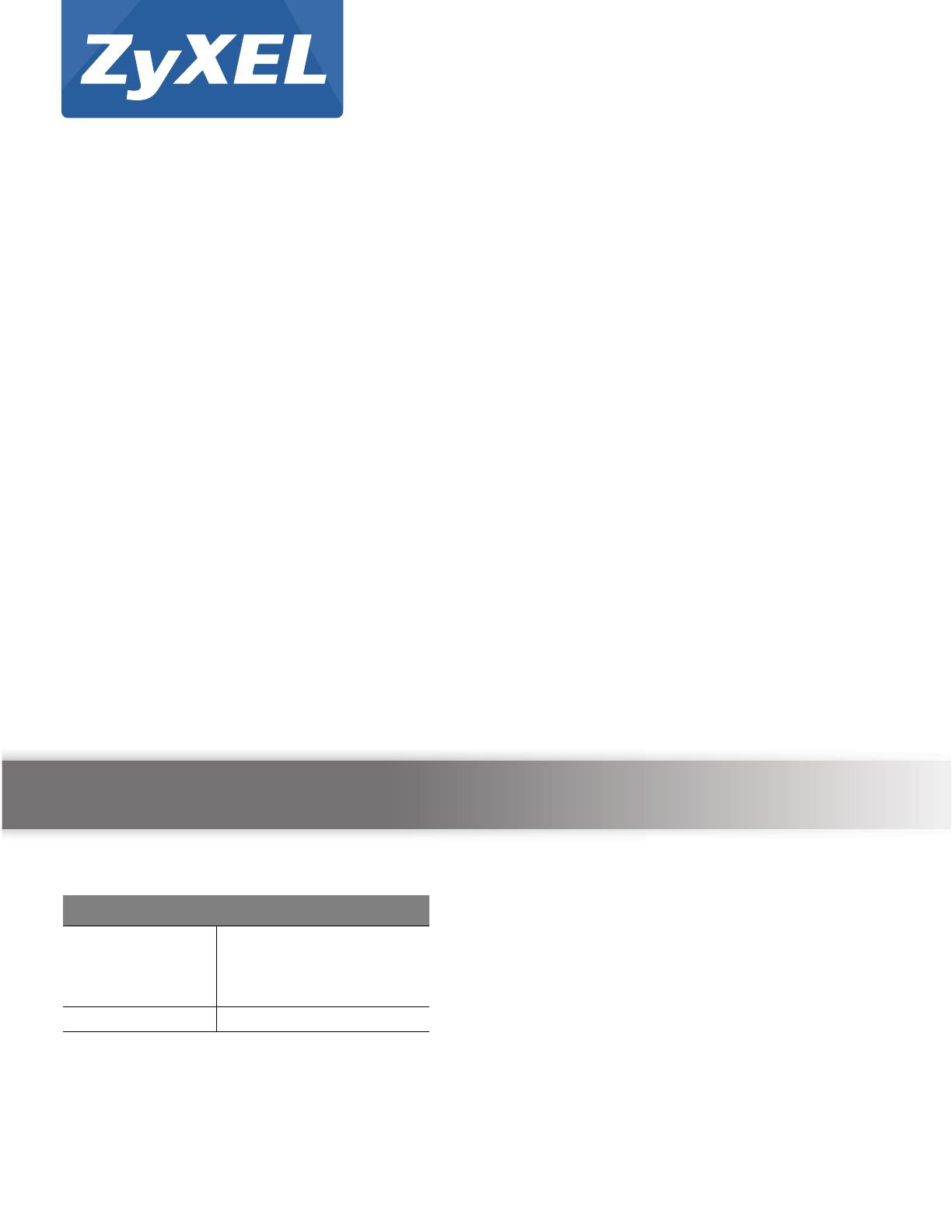
Quick Start Guide
www.zyxel.com
EMG2926-Q10A
Dual-Band Wireless AC/N Gigabit Ethernet Gateway
Version 1.00
Edition 1, 02/2014
Copyright © 2014 ZyXEL Communications Corporation
User’s Guide
Default Login Details
LAN IP Address http://192.168.0.1
(Router Mode)
http://192.168.0.2
(Access Point Mode)
User Name admin

EMG2926-Q10A User’s Guide
2
IMPORTANT!
READ CAREFULLY BEFORE USE.
KEEP THIS GUIDE FOR FUTURE REFERENCE.
Screenshots and graphics in this book may differ slightly from your product due to differences in
your product firmware or your computer operating system. Every effort has been made to ensure
that the information in this manual is accurate.
Related Documentation
•Quick Start Guide
The Quick Start Guide shows how to connect the EMG2926-Q10A. It contains information on
setting up your network and configuring for Internet access.

Contents Overview
EMG2926-Q10A User’s Guide
3
Contents Overview
User’s Guide .......................................................................................................................................11
Introduction .............................................................................................................................................12
Connection Wizard ..................................................................................................................................18
Introducing the Web Configurator ...........................................................................................................28
EMG2926-Q10A Modes ..........................................................................................................................31
Easy Mode ..............................................................................................................................................32
Router Mode ...........................................................................................................................................43
Access Point Mode .................................................................................................................................50
Tutorials ..................................................................................................................................................57
Technical Reference ..........................................................................................................................69
Monitor ....................................................................................................................................................70
WAN ........................................................................................................................................................75
Wireless LAN ..........................................................................................................................................86
LAN .......................................................................................................................................................109
DHCP Server ........................................................................................................................................113
NAT .......................................................................................................................................................118
DDNS ....................................................................................................................................................129
Static Route ...........................................................................................................................................131
Firewall ..................................................................................................................................................134
Content Filtering ....................................................................................................................................139
Parental Control ....................................................................................................................................142
IPv6 Firewall ..........................................................................................................................................146
StreamBoost Management ...................................................................................................................149
Remote Management ............................................................................................................................154
Universal Plug-and-Play (UPnP) ...........................................................................................................161
USB Media Sharing ...............................................................................................................................167
Port Configuration .................................................................................................................................177
Maintenance ..........................................................................................................................................179
Troubleshooting ....................................................................................................................................190

Table of Contents
EMG2926-Q10A User’s Guide
4
Table of Contents
Contents Overview ..............................................................................................................................3
Table of Contents .................................................................................................................................4
Part I: User’s Guide ......................................................................................... 11
Chapter 1
Introduction.........................................................................................................................................12
1.1 Overview ...........................................................................................................................................12
1.1.1 Dual-Band ................................................................................................................................13
1.2 Applications .......................................................................................................................................13
1.3 Ways to Manage the EMG2926-Q10A ..............................................................................................13
1.4 Good Habits for Managing the EMG2926-Q10A ...............................................................................14
1.5 Resetting the EMG2926-Q10A .........................................................................................................14
1.5.1 How to Use the RESET Button ................................................................................................14
1.6 The WPS Button ...............................................................................................................................14
1.7 LEDs .................................................................................................................................................15
1.8 Wall Mounting ...................................................................................................................................17
Chapter 2
Connection Wizard .............................................................................................................................18
2.1 Overview ...........................................................................................................................................18
2.2 Accessing the Wizard ........................................................................................................................18
2.3 Connect to Internet ............................................................................................................................19
2.3.1 Connection Type: IPoE ............................................................................................................20
2.3.2 Connection Type: PPPoE ........................................................................................................22
2.4 Router Password ...............................................................................................................................23
2.5 Wireless Security ..............................................................................................................................24
2.5.1 Wireless Security: No Security ................................................................................................24
2.5.2 Wireless Security: WPA2-PSK .................................................................................................25
Chapter 3
Introducing the Web Configurator ....................................................................................................28
3.1 Overview ...........................................................................................................................................28
3.2 Accessing the Web Configurator .......................................................................................................28
3.2.1 Login Screen ...........................................................................................................................28
3.2.2 Password Screen ....................................................................................................................29

Table of Contents
EMG2926-Q10A User’s Guide
5
Chapter 4
EMG2926-Q10A Modes.......................................................................................................................31
4.1 Overview ...........................................................................................................................................31
4.1.1 Web Configurator Modes .........................................................................................................31
4.1.2 Device Modes ..........................................................................................................................31
Chapter 5
Easy Mode...........................................................................................................................................32
5.1 Overview ...........................................................................................................................................32
5.2 What You Can Do .............................................................................................................................33
5.3 What You Need to Know ...................................................................................................................33
5.4 Navigation Panel ...............................................................................................................................34
5.5 Network Map .....................................................................................................................................34
5.6 Control Panel ....................................................................................................................................35
5.6.1 Power Saving ..........................................................................................................................35
5.6.2 Parental Control .......................................................................................................................36
5.6.3 Firewall ....................................................................................................................................37
5.6.4 Internet Setting ........................................................................................................................38
5.6.5 Wireless Security .....................................................................................................................40
5.6.6 WPS ........................................................................................................................................41
5.7 Status Screen in Easy Mode .............................................................................................................41
Chapter 6
Router Mode........................................................................................................................................43
6.1 Overview ...........................................................................................................................................43
6.2 Router Mode Status Screen ..............................................................................................................43
6.2.1 Navigation Panel .....................................................................................................................46
Chapter 7
Access Point Mode.............................................................................................................................50
7.1 Overview ...........................................................................................................................................50
7.2 What You Can Do .............................................................................................................................50
7.3 What You Need to Know ...................................................................................................................50
7.3.1 Setting your EMG2926-Q10A to AP Mode ..............................................................................51
7.3.2 Accessing the Web Configurator in Access Point Mode ..........................................................51
7.3.3 Configuring your WLAN and Maintenance Settings ................................................................52
7.4 AP Mode Status Screen ....................................................................................................................52
7.4.1 Navigation Panel .....................................................................................................................54
7.5 LAN Screen .......................................................................................................................................54
Chapter 8
Tutorials...............................................................................................................................................57
8.1 Overview ...........................................................................................................................................57

Table of Contents
EMG2926-Q10A User’s Guide
6
8.2 Set Up a Wireless Network with WPS ...............................................................................................57
8.2.1 Push Button Configuration (PBC) ............................................................................................57
8.2.2 PIN Configuration ....................................................................................................................58
8.3 Configure Wireless Security without WPS ........................................................................................59
8.3.1 Configure Your Notebook ........................................................................................................61
8.4 Using Multiple SSIDs on the EMG2926-Q10A ..................................................................................63
8.4.1 Configuring Security Settings of Multiple SSIDs ......................................................................64
Part II: Technical Reference............................................................................ 69
Chapter 9
Monitor.................................................................................................................................................70
9.1 Overview ...........................................................................................................................................70
9.2 What You Can Do .............................................................................................................................70
9.3 The Log Screen .................................................................................................................................70
9.3.1 View Log ..................................................................................................................................70
9.3.2 Log Setting ..............................................................................................................................71
9.4 DHCP Table ...................................................................................................................................71
9.5 Packet Statistics .............................................................................................................................72
9.6 WLAN Station Status .....................................................................................................................73
Chapter 10
WAN .....................................................................................................................................................75
10.1 Overview .........................................................................................................................................75
10.2 What You Can Do ...........................................................................................................................75
10.3 What You Need To Know ................................................................................................................75
10.3.1 Configuring Your Internet Connection ....................................................................................76
10.4 Internet Connection .........................................................................................................................78
10.4.1 IPoE Encapsulation ...............................................................................................................78
10.4.2 PPPoE Encapsulation ...........................................................................................................81
10.5 Advanced WAN Screen ..................................................................................................................84
Chapter 11
Wireless LAN.......................................................................................................................................86
11.1 Overview .........................................................................................................................................86
11.1.1 What You Can Do ..................................................................................................................87
11.1.2 What You Should Know .........................................................................................................87
11.2 General Wireless LAN Screen .......................................................................................................91
11.3 Wireless Security .............................................................................................................................93
11.3.1 No Security ............................................................................................................................93
11.3.2 WEP Encryption .....................................................................................................................94

Table of Contents
EMG2926-Q10A User’s Guide
7
11.3.3 WPA-PSK/WPA2-PSK ...........................................................................................................96
11.3.4 WPA/WPA2 ............................................................................................................................97
11.4 More AP Screen ..............................................................................................................................99
11.4.1 More AP Edit ........................................................................................................................100
11.5 MAC Filter Screen ........................................................................................................................102
11.6 Wireless LAN Advanced Screen ...................................................................................................104
11.7 Quality of Service (QoS) Screen ...................................................................................................105
11.8 WPS Screen ..................................................................................................................................105
11.9 WPS Station Screen ......................................................................................................................107
11.10 Scheduling Screen ......................................................................................................................107
Chapter 12
LAN ....................................................................................................................................................109
12.1 Overview .......................................................................................................................................109
12.2 What You Can Do .........................................................................................................................109
12.3 What You Need To Know ..............................................................................................................109
12.3.1 IP Alias ................................................................................................................................ 110
12.4 LAN IP Screen .............................................................................................................................. 110
12.5 IP Alias Screen .............................................................................................................................. 111
12.6 IPv6 LAN Screen ...........................................................................................................................112
Chapter 13
DHCP Server .....................................................................................................................................113
13.1 Overview ....................................................................................................................................... 113
13.1.1 What You Can Do ................................................................................................................113
13.1.2 What You Need To Know .....................................................................................................113
13.2 DHCP Server General Screen ......................................................................................................114
13.3 DHCP Server Advanced Screen ................................................................................................114
13.4 DHCP Client List Screen ............................................................................................................... 116
Chapter 14
NAT.....................................................................................................................................................118
14.1 Overview .................................................................................................................................... 118
14.1.1 What You Can Do ................................................................................................................118
14.1.2 What You Need To Know .....................................................................................................119
14.2 NAT General Screen .....................................................................................................................120
14.3 Port Forwarding Screen ...............................................................................................................121
14.3.1 Port Forwarding Edit Screen ..............................................................................................123
14.4 Port Trigger Screen .......................................................................................................................125
14.5 Technical Reference ......................................................................................................................126
14.5.1 NATPort Forwarding: Services and Port Numbers ..............................................................126
14.5.2 NAT Port Forwarding Example ............................................................................................126
14.5.3 Trigger Port Forwarding .......................................................................................................127

Table of Contents
EMG2926-Q10A User’s Guide
8
14.5.4 Trigger Port Forwarding Example ........................................................................................127
14.5.5 Two Points To Remember About Trigger Ports ...................................................................128
Chapter 15
DDNS..................................................................................................................................................129
15.1 Overview ......................................................................................................................................129
15.1.1 What You Need To Know .....................................................................................................129
15.2 General .......................................................................................................................................129
Chapter 16
Static Route.......................................................................................................................................131
16.1 Overview ....................................................................................................................................131
16.2 IP Static Route Screen .................................................................................................................131
16.2.1 Add/Edit Static Route ..........................................................................................................132
Chapter 17
Firewall ..............................................................................................................................................134
17.1 Overview .....................................................................................................................................134
17.1.1 What You Can Do ................................................................................................................134
17.1.2 What You Need To Know .....................................................................................................134
17.2 General Screen ............................................................................................................................136
17.3 Services Screen ............................................................................................................................136
Chapter 18
Content Filtering...............................................................................................................................139
18.1 Overview .......................................................................................................................................139
18.1.1 What You Need To Know .....................................................................................................139
18.2 Content Filter .................................................................................................................................139
18.3 Technical Reference ......................................................................................................................141
18.3.1 Customizing Keyword Blocking URL Checking ...................................................................141
Chapter 19
Parental Control................................................................................................................................142
19.1 Overview .......................................................................................................................................142
19.2 The Parental Control Screen .........................................................................................................142
19.2.1 Add/Edit a Parental Control Rule .........................................................................................143
Chapter 20
IPv6 Firewall......................................................................................................................................146
20.1 Overview .......................................................................................................................................146
20.2 The IPv6 Firewall Screen .............................................................................................................146
Chapter 21
StreamBoost Management...............................................................................................................149

Table of Contents
EMG2926-Q10A User’s Guide
9
21.1 Overview ......................................................................................................................................149
21.2 What You Can Do .........................................................................................................................150
21.3 Network Screen ............................................................................................................................150
21.4 Banwidth Screen ...........................................................................................................................150
21.5 Priorities Screen ...........................................................................................................................152
21.6 Up Time Screen ...........................................................................................................................152
21.7 Downloads Screen .......................................................................................................................152
21.8 All Events Screen .........................................................................................................................153
Chapter 22
Remote Management........................................................................................................................154
22.1 Overview .......................................................................................................................................154
22.2 What You Can Do in this Chapter .................................................................................................154
22.3 What You Need to Know ...............................................................................................................154
22.3.1 Remote Management and NAT ...........................................................................................155
22.3.2 System Timeout ..................................................................................................................155
22.4 WWW Screen .............................................................................................................................155
22.5 Telnet Screen .............................................................................................................................156
22.6 SNMP ............................................................................................................................................156
22.7 Wake On LAN Screen ...................................................................................................................159
Chapter 23
Universal Plug-and-Play (UPnP)......................................................................................................161
23.1 Overview ......................................................................................................................................161
23.2 What You Need to Know ...............................................................................................................161
23.2.1 NAT Traversal ......................................................................................................................161
23.2.2 Cautions with UPnP .............................................................................................................161
23.3 UPnP Screen ...............................................................................................................................162
23.4 Technical Reference ......................................................................................................................162
23.4.1 Using UPnP in Windows XP Example .................................................................................162
23.4.2 Web Configurator Easy Access ...........................................................................................164
Chapter 24
USB Media Sharing...........................................................................................................................167
24.1 Overview .......................................................................................................................................167
24.2 What You Can Do .........................................................................................................................168
24.3 What You Need To Know ..............................................................................................................168
24.4 Before You Begin ..........................................................................................................................169
24.5 DLNA Screen ................................................................................................................................170
24.6 SAMBA Screen .............................................................................................................................171
24.7 FTP Screen ...................................................................................................................................172
24.8 Example of Accessing Your Shared Files From a Computer ........................................................173
24.8.1 Use Windows Explorer to Share Files .................................................................................173

Table of Contents
EMG2926-Q10A User’s Guide
10
24.8.2 Use FTP to Share Files .......................................................................................................175
Chapter 25
Port Configuration............................................................................................................................177
25.1 Overview .......................................................................................................................................177
25.2 Port Configuration Screen .............................................................................................................177
Chapter 26
Maintenance......................................................................................................................................179
26.1 Overview .......................................................................................................................................179
26.2 What You Can Do .........................................................................................................................179
26.3 General Screen .............................................................................................................................179
26.4 Account Screen .............................................................................................................................180
26.4.1 Edit a Users Account ...........................................................................................................180
26.5 Time Setting Screen ......................................................................................................................181
26.6 Firmware Upgrade Screen ............................................................................................................183
26.7 Configuration Backup/Restore Screen ..........................................................................................185
26.8 Restart Screen ..............................................................................................................................186
26.9 Language Screen ..........................................................................................................................186
26.10 System Operation Mode Overview .............................................................................................187
26.11 Sys OP Mode Screen ..................................................................................................................188
Chapter 27
Troubleshooting................................................................................................................................190
27.1 Overview .......................................................................................................................................190
27.2 Power, Hardware Connections, and LEDs ....................................................................................190
27.3 EMG2926-Q10A Access and Login ..............................................................................................191
27.4 Internet Access .............................................................................................................................192
27.5 Resetting the EMG2926-Q10A to Its Factory Defaults .................................................................194
27.6 Wireless Connections ...................................................................................................................194
27.7 USB Device Problems ...................................................................................................................196
27.8 ZyXEL Share Center Utility Problems ...........................................................................................196
Appendix A Legal Information..........................................................................................................198
Index ..................................................................................................................................................203

11
PART I
User’s Guide
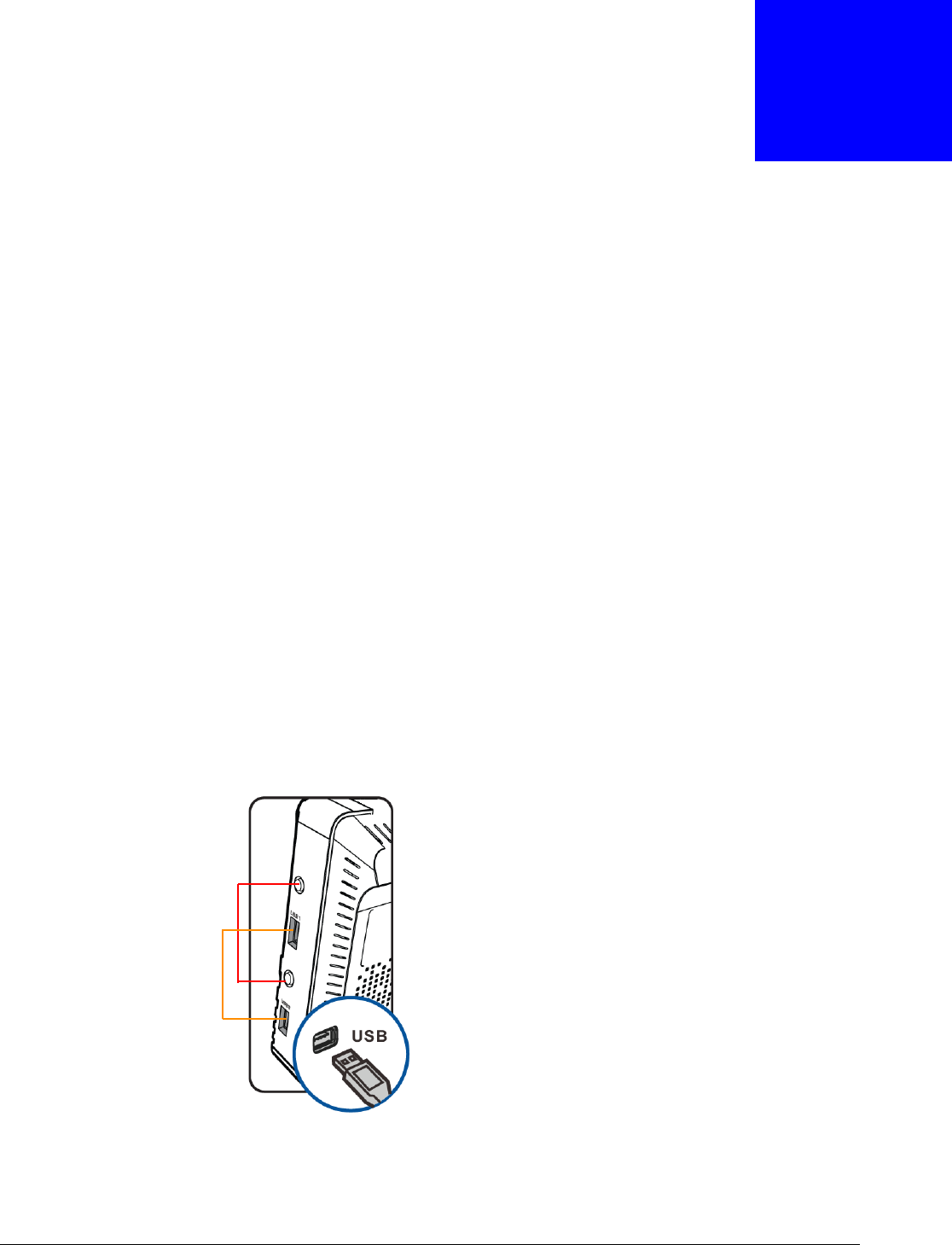
EMG2926-Q10A User’s Guide
12
CHAPTER 1
Introduction
1.1 Overview
This chapter introduces the main features and applications of the EMG2926-Q10A.
The EMG2926-Q10A extends the range of your existing wired network without additional wiring,
providing easy network access to mobile users. You can set up a wireless network with other IEEE
802.11a/ac/b/g/n compatible devices.
A range of services such as a firewall and content filtering are also available for secure Internet
computing. The EMG2926-Q10A also supports the new StreamBoost technology, which is smart
Quality of Service (QoS), to redistribute traffic over the EMG2926-Q10A for the best possible
performance in a home network.
There are two USB 2.0 ports on the side panel of your EMG2926-Q10A. You can connect USB
(version 2.0 or lower) memory sticks, USB hard drives, or USB devices for file sharing. The
EMG2926-Q10A automatically detects the USB devices.
Two USB eject buttons are located above the USB ports. Push the eject button of the corresponding
USB port for 2 seconds. Make sure the USB LED is off before removing your USB device. This will
remove your USB device safely, preventing file or data loss if it is being transmitted through the
USB device.
Figure 1 USB Ports and Eject Buttons
Note: For the USB function, it is strongly recommended to use version 2.0 or lower USB
storage devices (such as memory sticks, USB hard drives) and/or USB devices
(such as USB printers). Other USB products are not guaranteed to function
properly with the EMG2926-Q10A.
Eject buttons
USB ports
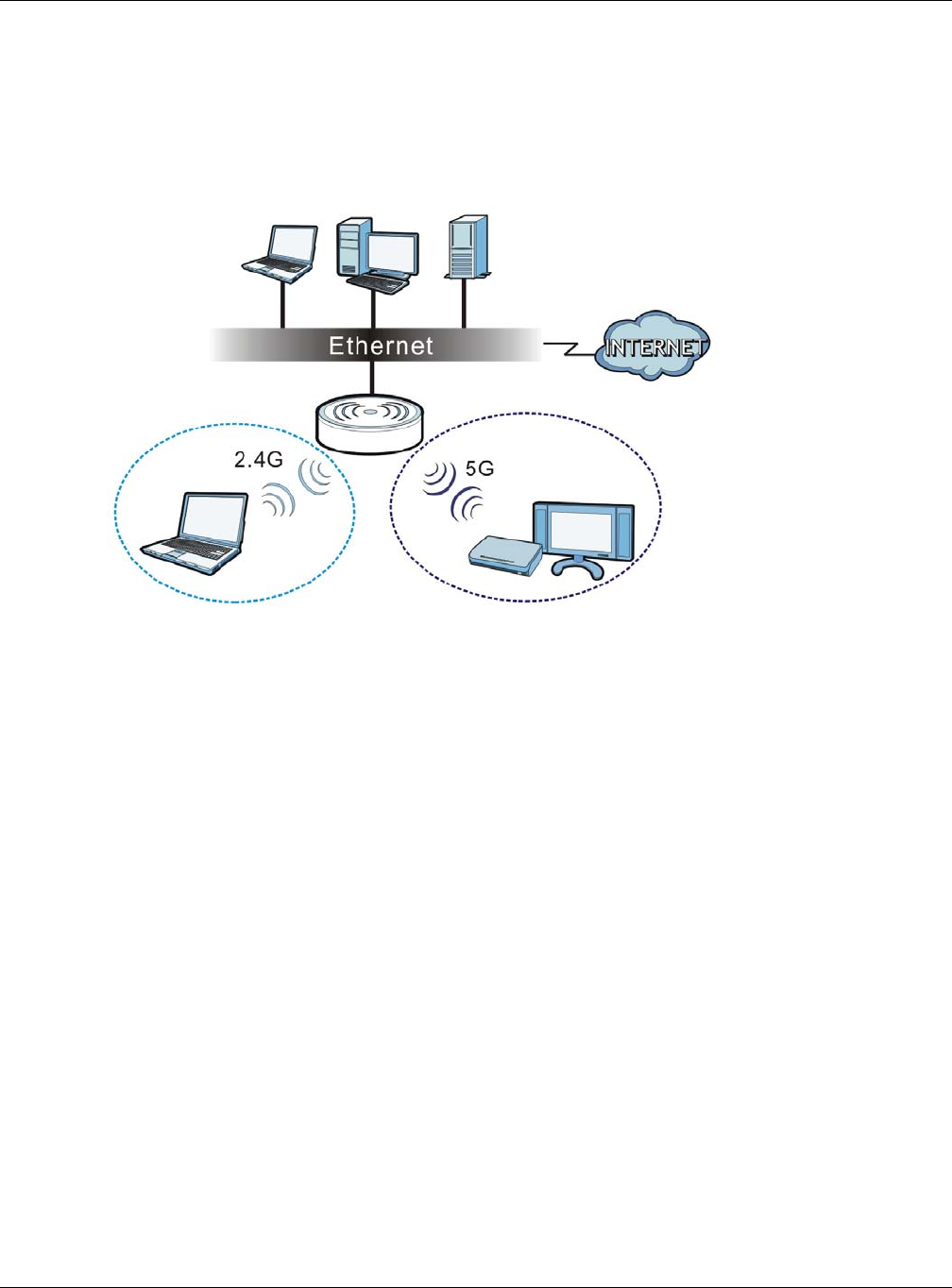
Chapter 1 Introduction
EMG2926-Q10A User’s Guide
13
1.1.1 Dual-Band
The EMG2926-Q10A is a dual-band AP and able to function both 2.4G and 5G networks at the same
time. You could use the 2.4 GHz band for regular Internet surfing and downloading while using the
5 GHz band for time sensitive traffic like high-definition video, music, and gaming.
Figure 2 Dual-Band Application
1.2 Applications
Your can have the following networks using the EMG2926-Q10A:
•Wired. You can connect network devices via the Ethernet ports of the EMG2926-Q10A so that
they can communicate with each other and access the Internet.
•Wireless. Wireless clients can connect to the EMG2926-Q10A to access network resources. You
can use WPS (Wi-Fi Protected Setup) to create an instant network connection with another WPS-
compatible device.
•WAN. Connect to a broadband modem/router for Internet access.
1.3 Ways to Manage the EMG2926-Q10A
Use any of the following methods to manage the EMG2926-Q10A.
• WPS (Wi-Fi Protected Setup). You can use the WPS button or the WPS section of the Web
Configurator to set up a wireless network with your ZyXEL Device.
• Web Configurator. This is recommended for everyday management of the EMG2926-Q10A using
a (supported) web browser.

Chapter 1 Introduction
EMG2926-Q10A User’s Guide
14
1.4 Good Habits for Managing the EMG2926-Q10A
Do the following things regularly to make the EMG2926-Q10A more secure and to manage the
EMG2926-Q10A more effectively.
• Change the password. Use a password that’s not easy to guess and that consists of different
types of characters, such as numbers and letters.
• Write down the password and put it in a safe place.
• Back up the configuration (and make sure you know how to restore it). Restoring an earlier
working configuration may be useful if the device becomes unstable or even crashes. If you
forget your password, you will have to reset the EMG2926-Q10A to its factory default settings. If
you backed up an earlier configuration file, you would not have to totally re-configure the
EMG2926-Q10A. You could simply restore your last configuration.
1.5 Resetting the EMG2926-Q10A
If you forget your password or IP address, or you cannot access the Web Configurator, you will need
to use the RESET button at the back of the EMG2926-Q10A to reload the factory-default
configuration file. This means that you will lose all configurations that you had previously saved, the
user name will be reset to “admin” and the IP address will be reset to “192.168.0.1”.
1.5.1 How to Use the RESET Button
1Make sure the power LED is on.
2Press the RESET button for one to four seconds to restart/reboot the EMG2926-Q10A.
3Press the RESET button for longer than five seconds to set the EMG2926-Q10A back to its factory-
default configurations.
1.6 The WPS Button
Your EMG2926-Q10A supports Wi-Fi Protected Setup (WPS), which is an easy way to set up a
secure wireless network. WPS is an industry standard specification, defined by the Wi-Fi Alliance.
WPS allows you to quickly set up a wireless network with strong security, without having to
configure security settings manually. Each WPS connection works between two devices. Both
devices must support WPS (check each device’s documentation to make sure).
Depending on the devices you have, you can either press a button (on the device itself, or in its
configuration utility) or enter a PIN (a unique Personal Identification Number that allows one device
to authenticate the other) in each of the two devices. When WPS is activated on a device, it has two
minutes to find another device that also has WPS activated. Then, the two devices connect and set
up a secure network by themselves.
You can use the WPS button ( ) on the front panel of the EMG2926-Q10A to activate WPS in
order to quickly set up a wireless network with strong security.
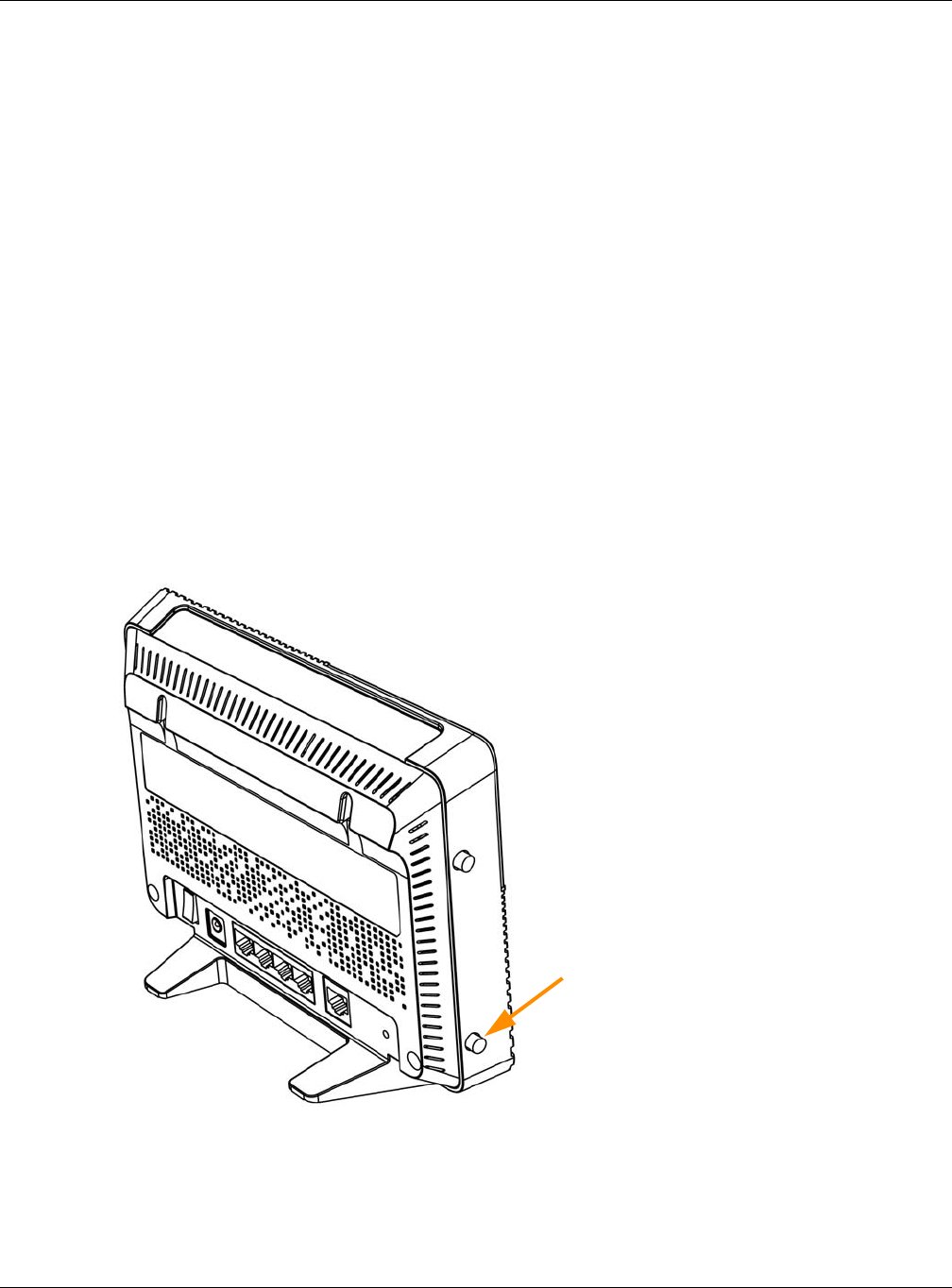
Chapter 1 Introduction
EMG2926-Q10A User’s Guide
15
1Make sure the power LED is on (not blinking).
2Press the WPS button for more than three seconds and release it. Press the WPS button on another
WPS-enabled device within range of the EMG2926-Q10A.
Note: You must activate WPS in the EMG2926-Q10A and in another wireless device within
two minutes of each other.
For more information on using WPS, see Section 8.2 on page 57.
1.7 LEDs
Look at the LED lights on the front panel to determine the status of the EMG2926-Q10A. Use the
LED button at the side panel of the device to turn the LED lights on or off. If you have already
pushed the LED button to the ON position but none of the LEDS are on, make sure the EMG2926-
Q10A is receiving power and the power is turned on.
Note: The Power LED will be on even if you push the LED button to the OFF position.
This is for you to determine whether the EMG2926-Q10A is powered on.
Figure 3 LED Button
LED button
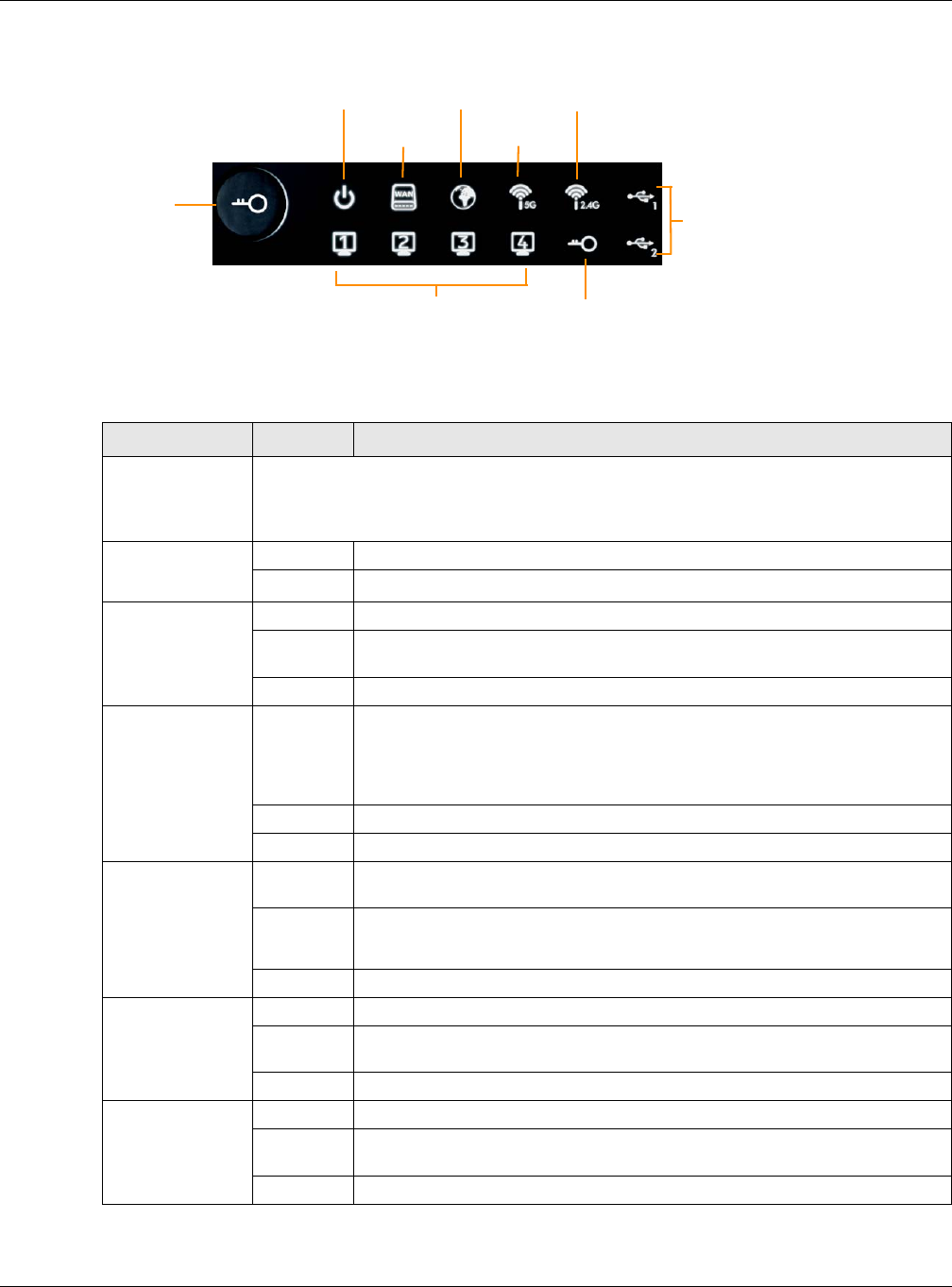
Chapter 1 Introduction
EMG2926-Q10A User’s Guide
16
Figure 4 Front Panel
The following table describes the LEDs and the WPS button.
Table 1 Front panel LEDs and WPS button
LED STATUS DESCRIPTION
WPS Button Press this button for 1 second to set up a wireless connection via WiFi Protected Setup
with another WPS-enabled client. You must press the WPS button on the client side within
120 seconds for a successful connection. See Section 1.6 on page 14 and Chapter 9 on
page 57 for more information on WPS.
Power On The EMG2926-Q10A is receiving power and functioning properly.
Off The EMG2926-Q10A is not receiving power.
WAN On The EMG2926-Q10A’s WAN connection is ready.
Blinking The EMG2926-Q10A is sending/receiving data through the WAN with a
1000Mbps transmission rate.
Off The WAN connection is not ready, or has failed.
Internet On The EMG2926-Q10A has an IP connection but no traffic.
Your device has a WAN IP address (either static or assigned by a DHCP
server), PPP negotiation was successfully completed (if used) and the
connection is up.
Blinking The EMG2926-Q10A is sending or receiving IP traffic.
Off The EMG2926-Q10A does not have an IP connection.
WLAN 2.4/5G On The EMG2926-Q10A is ready, but is not sending/receiving data through the
5G wireless LAN.
Blinking The EMG2926-Q10A is sending/receiving data through the 5G wireless LAN.
The EMG2926-Q10A is negotiating a WPS connection with a wireless client.
Off The wireless LAN is not ready or has failed.
LAN 1-4 On The EMG2926-Q10A’s LAN connection is ready.
Blinking The EMG2926-Q10A is sending/receiving data through the LAN with a
1000Mbps transmission rate.
Off The LAN connection is not ready, or has failed.
USB 1-2 On The EMG2926-Q10A has a USB device installed.
Blinking The EMG2926-Q10A is transmitting and/or receiving data from routers
through an installed USB device.
Off There is no USB device connected to the EMG2926-Q10A.
Power
LAN 1-4
WAN
WPS
USB 1-2
WPS
Button
Internet
WLAN 5G
WLAN 2.4G
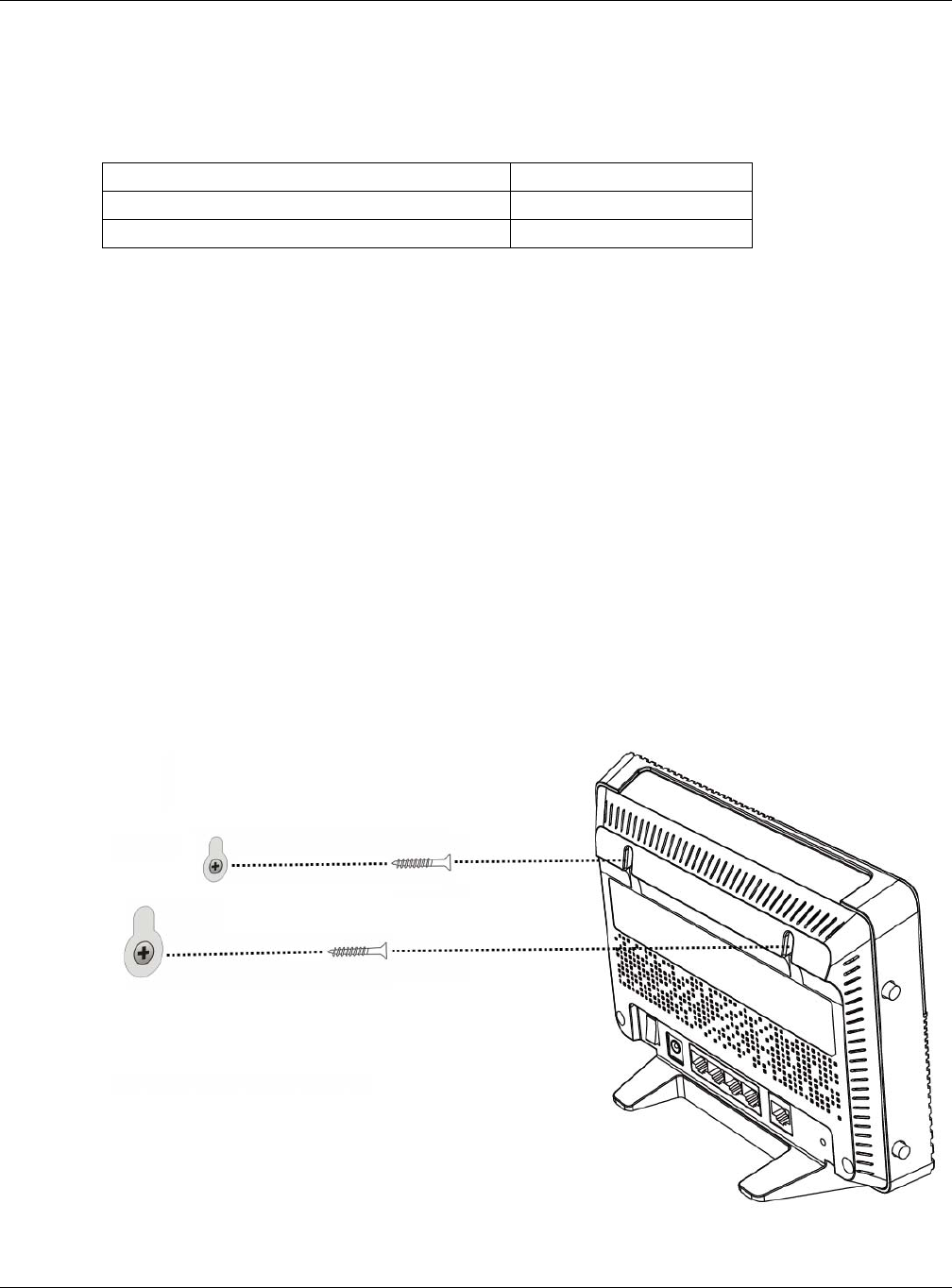
Chapter 1 Introduction
EMG2926-Q10A User’s Guide
17
1.8 Wall Mounting
You may need screw anchors if mounting on a concrete or brick wall.
1Select a position free of obstructions on a wall strong enough to hold the weight of the device.
2Mark two holes on the wall at the appropriate distance apart for the screws.
Be careful to avoid damaging pipes or cables located inside the wall
when drilling holes for the screws.
3If using screw anchors, drill two holes for the screw anchors into the wall. Push the anchors into the
full depth of the holes, then insert the screws into the anchors. Do not insert the screws all the way
in - leave a small gap of about 0.5 cm.
If not using screw anchors, use a screwdriver to insert the screws into the wall. Do not insert the
screws all the way in - leave a gap of about 0.5 cm.
4Make sure the screws are fastened well enough to hold the weight of the EMG2926-Q10A with the
connection cables.
5Align the holes on the back of the EMG2926-Q10A with the screws on the wall. Hang the EMG2926-
Q10A on the screws.
Figure 5 Wall Mounting Example
Table 2 Wall Mounting Information
Distance between holes 12.7 cm
M4 Screws Two
Screw anchors (optional) Two

EMG2926-Q10A User’s Guide
18
CHAPTER 2
Connection Wizard
2.1 Overview
This chapter provides information on the wizard setup screens in the Web Configurator.
The Web Configurator’s wizard setup helps you configure your device to access the Internet. Refer
to your ISP for your Internet account information. Leave a field blank if you don’t have that
information.
2.2 Accessing the Wizard
Launch your web browser and type "http://192.168.0.1" as the website address. Type "admin"
(default) as the user name and leave the password field blank. Click Login.
Note: The Wizard appears when the EMG2926-Q10A is accessed for the first time or
when you reset the EMG2926-Q10A to its default factory settings.
If you have already configured the wizard screens and want to open it again, click
the eaZy123 icon on the network map screen in Easy Mode.
The Web Configurator is set to Easy Mode by default after login. If you are in
Expert Mode, you can click the Easy Mode icon on the upper right corner of any
Web Configurator screen to go to Easy Mode.
The Wizard screen opens. Choose your Language and click Connect to Internet.
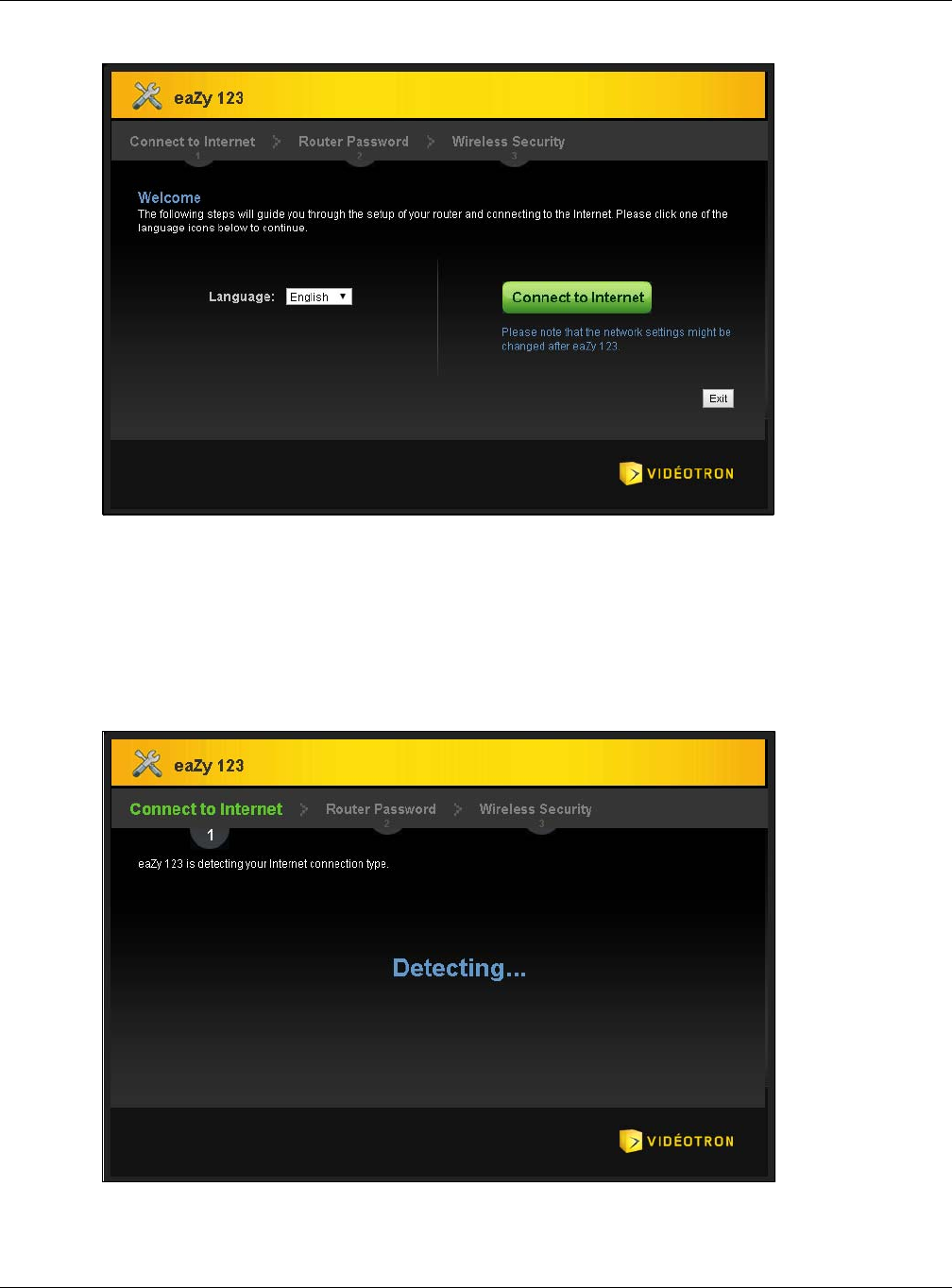
Chapter 2 Connection Wizard
EMG2926-Q10A User’s Guide
19
Figure 6 Welcome
2.3 Connect to Internet
The EMG2926-Q10A offers two Internet connection types. They are IPoE or PPPoE. The wizard
attempts to detect which WAN connection type you are using.
Figure 7 Detecting your Internet Connection Type
If the wizard does not detect a connection type, you must select one from the drop-down list box.
Check with your ISP to make sure you use the correct type.
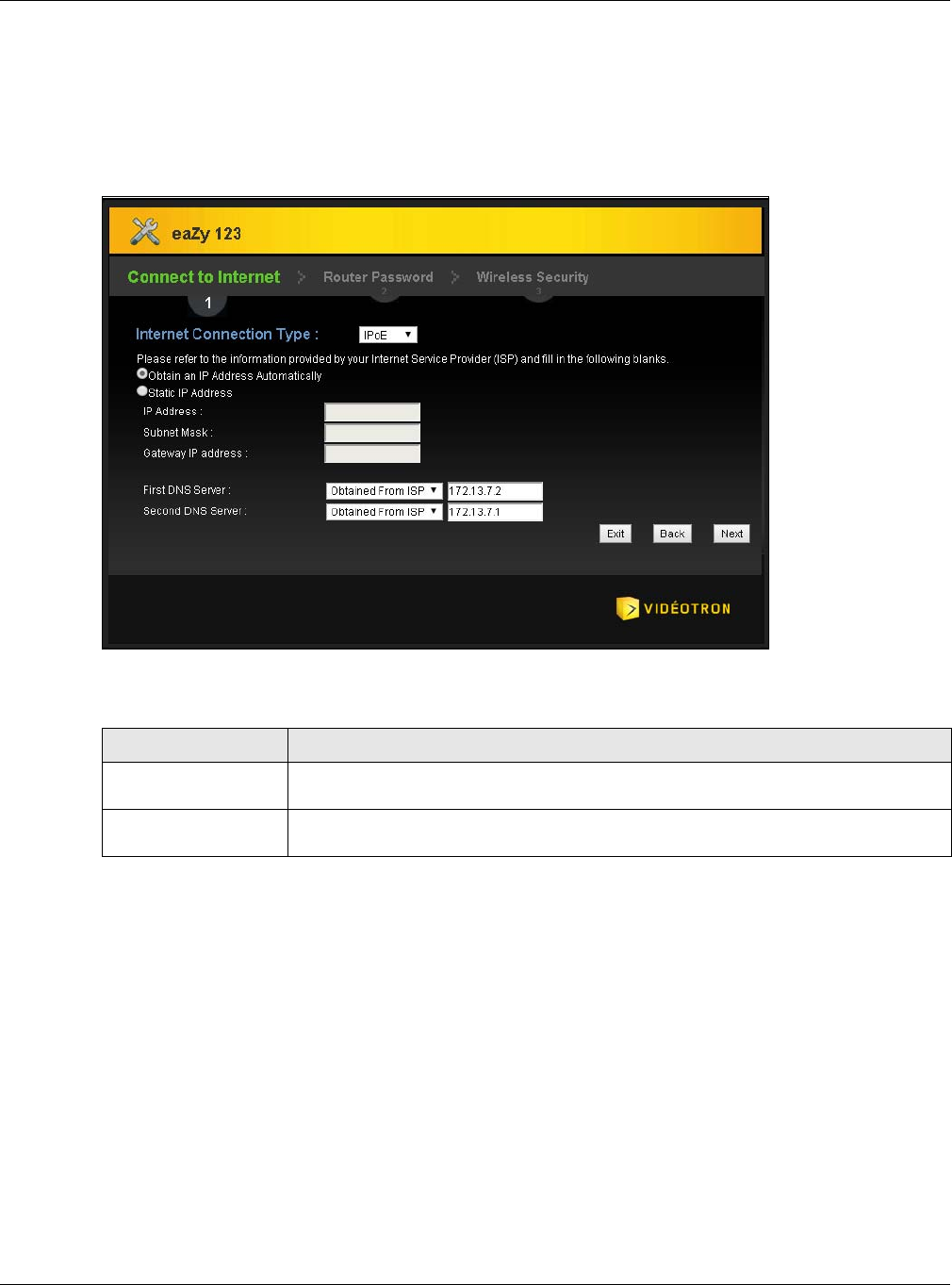
Chapter 2 Connection Wizard
EMG2926-Q10A User’s Guide
20
Note: If you get an error message, check your hardware connections. Make sure your
Internet connection is up and running.
The following screen depends on your Internet connection type. Enter the details provided by your
Internet Service Provider (ISP) in the fields (if any).
Figure 8 Internet Connection Type
Your EMG2926-Q10A detects the following Internet Connection type.
2.3.1 Connection Type: IPoE
Choose IPoE as the Internet Connection Type when the WAN port is used as a regular Ethernet.
Click Next.
Table 3 Internet Connection Type
CONNECTION TYPE DESCRIPTION
IPoE Select the IPoE (IP over Ethernet) option when the WAN port is used as a regular
Ethernet.
PPPoE Select the PPPoE (Point-to-Point Protocol over Ethernet) option for a dial-up
connection.
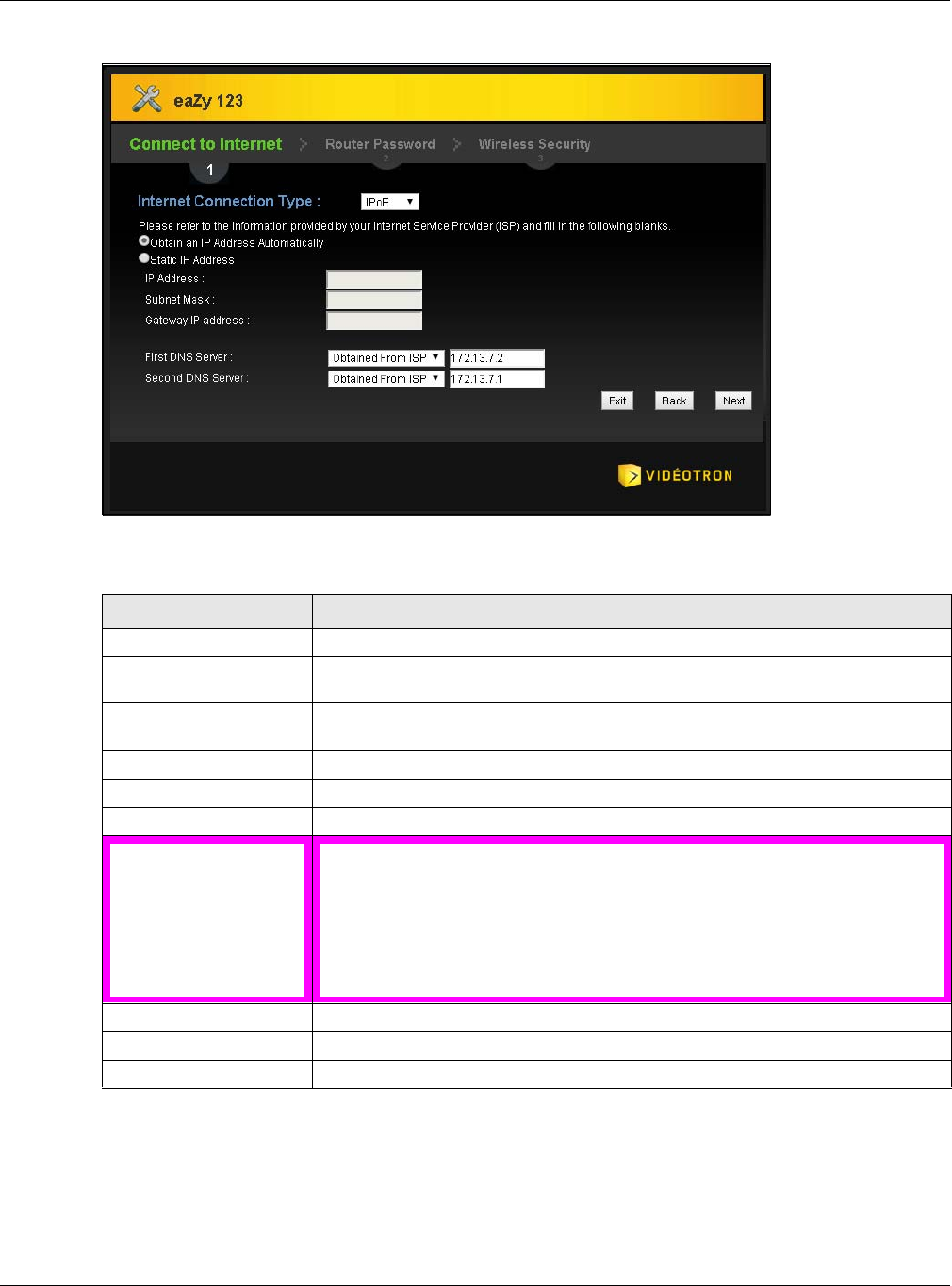
Chapter 2 Connection Wizard
EMG2926-Q10A User’s Guide
21
Figure 9 Internet Connection Type: IPoE
The following table describes the labels in this screen.
Note: If you get an error screen after clicking Next, you might have selected the wrong
Internet Connection type. Click Back, make sure your Internet connection is
working and select the right Connection Type. Contact your ISP if you are not sure
of your Internet Connection type.
Table 4 Internet Connection Type: IPoE
LABEL DESCRIPTION
Internet Connection Type Select the IPoE option.
Obtain an IP Address
Automatically
Select this radio button if your ISP did not assign you a fixed IP address.
Static IP Address Select this radio button if your ISP assigned an IP address for your Internet
connection.
IP Address Enter the IP address provided by your ISP.
Subnet Mask Enter the IP subnet mask in this field.
Gateway IP Address Enter the gateway IP address in this field.
First DNS Server
Second DNS Server
Select Obtained From ISP if your ISP dynamically assigns DNS server
information (and the EMG2926-Q10A's WAN IP address). The field to the right
displays the (read-only) DNS server IP address that the ISP assigns.
Select User-Defined if you have the IP address of a DNS server. Enter the DNS
server's IP address in the field to the right.
Select None if you do not want to configure DNS servers. If you do not configure
a DNS server, you must know the IP address of a computer in order to access it.
Exit Click this to close the wizard screen without saving.
Back Click this to return to the previous screen.
Next Click this to continue.
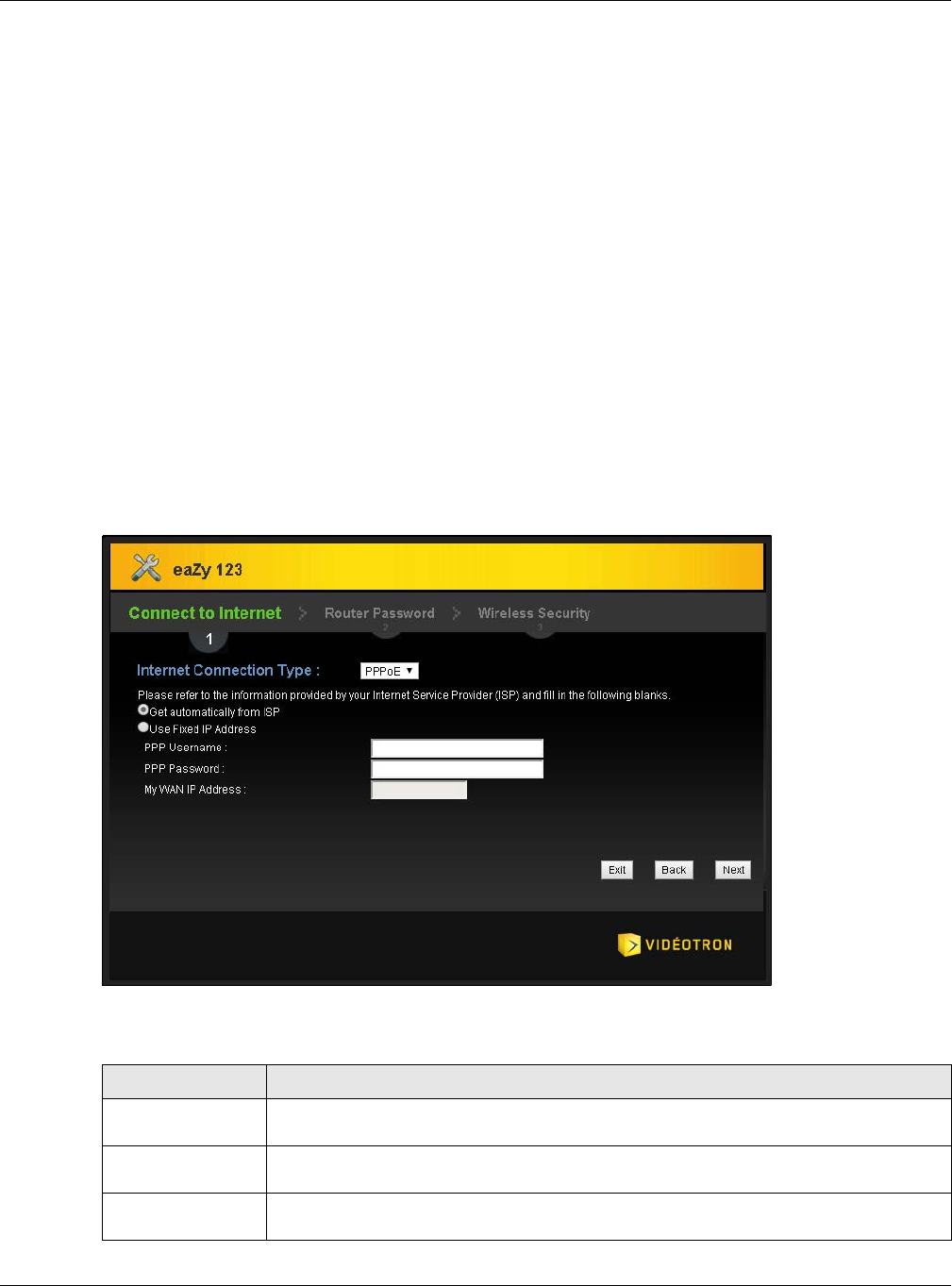
Chapter 2 Connection Wizard
EMG2926-Q10A User’s Guide
22
2.3.2 Connection Type: PPPoE
Point-to-Point Protocol over Ethernet (PPPoE) functions as a dial-up connection. PPPoE is an IETF
(Internet Engineering Task Force) standard specifying how a host personal computer interacts with
a broadband modem (for example DSL, cable, wireless, etc.) to achieve access to high-speed data
networks.
For the service provider, PPPoE offers an access and authentication method that works with existing
access control systems (for instance, RADIUS).
One of the benefits of PPPoE is the ability to let end users access one of multiple network services,
a function known as dynamic service selection. This enables the service provider to easily create
and offer new IP services for specific users.
Operationally, PPPoE saves significant effort for both the subscriber and the ISP/carrier, as it
requires no specific configuration of the broadband modem at the subscriber's site.
By implementing PPPoE directly on the EMG2926-Q10A (rather than individual computers), the
computers on the LAN do not need PPPoE software installed, since the EMG2926-Q10A does that
part of the task. Furthermore, with NAT, all of the LAN's computers will have Internet access.
Figure 10 Internet Connection Type: PPPoE
The following table describes the labels in this screen.
Table 5 Internet Connection Type: PPPoE
LABEL DESCRIPTION
Internet
Connection Type
Select the PPPoE option for a dial-up connection.
Get automatically
from ISP
Select this radio button if your ISP did not assign you a fixed IP address.
Use Fixed IP
Address
Select this radio button, provided by your ISP to give the EMG2926-Q10A a fixed,
unique IP address.
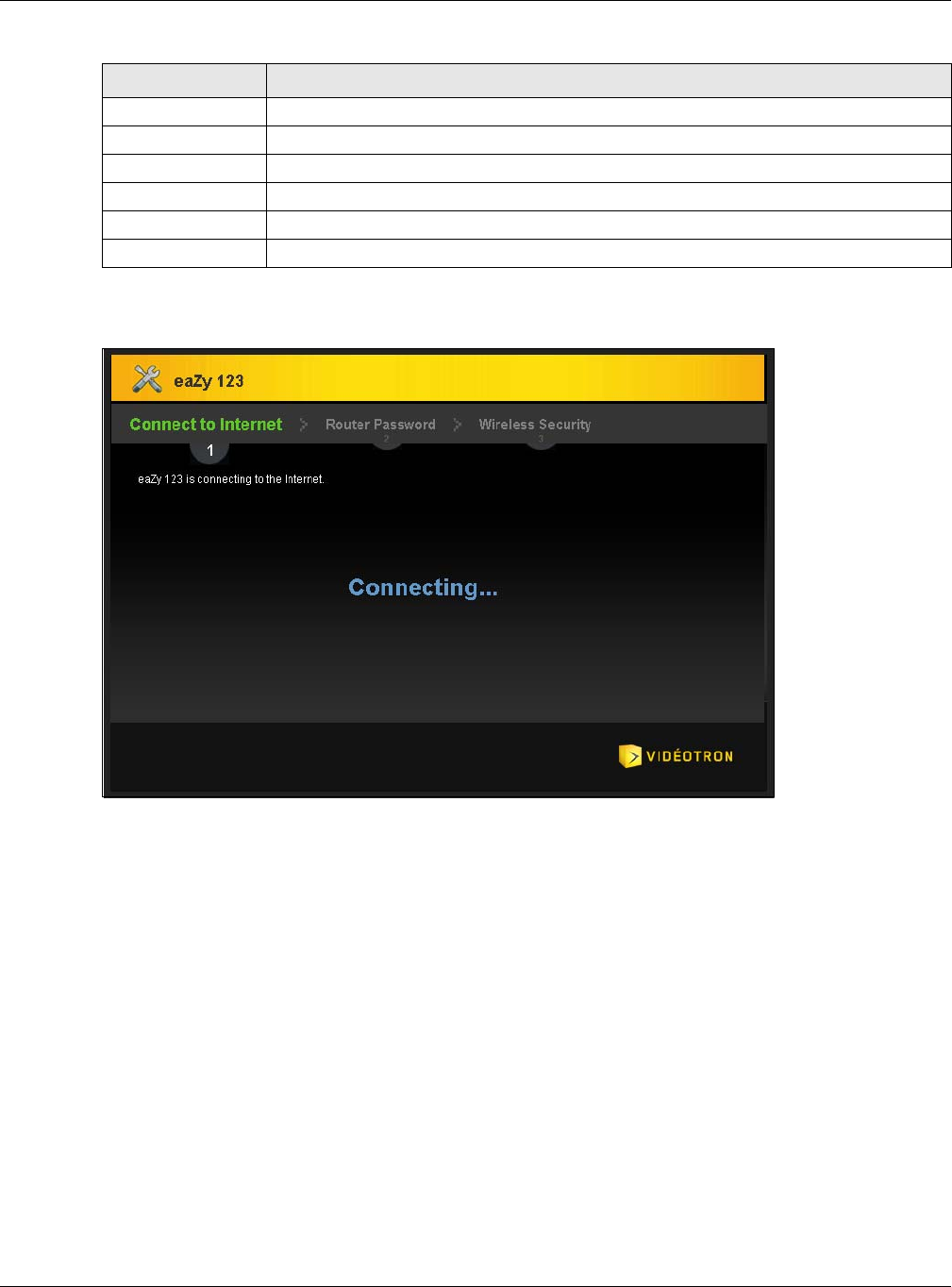
Chapter 2 Connection Wizard
EMG2926-Q10A User’s Guide
23
The EMG2926-Q10A connects to the Internet.
Figure 11 Connecting to the Internet
Note: If the Wizard successfully connects to the Internet, it proceeds to the next step. If
you get an error message, go back to the previous screen and make sure you have
entered the correct information provided by your ISP.
2.4 Router Password
Change the login password in the following screen. Enter the new password and retype it to
confirm. Click Next to proceed with the Wireless Security screen.
PPP Username Type the user name given to you by your ISP.
PPP Password Type the password associated with the user name above.
My WAN IP Address Type the name of your service provider.
Exit Click this to close the wizard screen without saving.
Back Click this to return to the previous screen.
Next Click this to continue.
Table 5 Internet Connection Type: PPPoE (continued)
LABEL DESCRIPTION
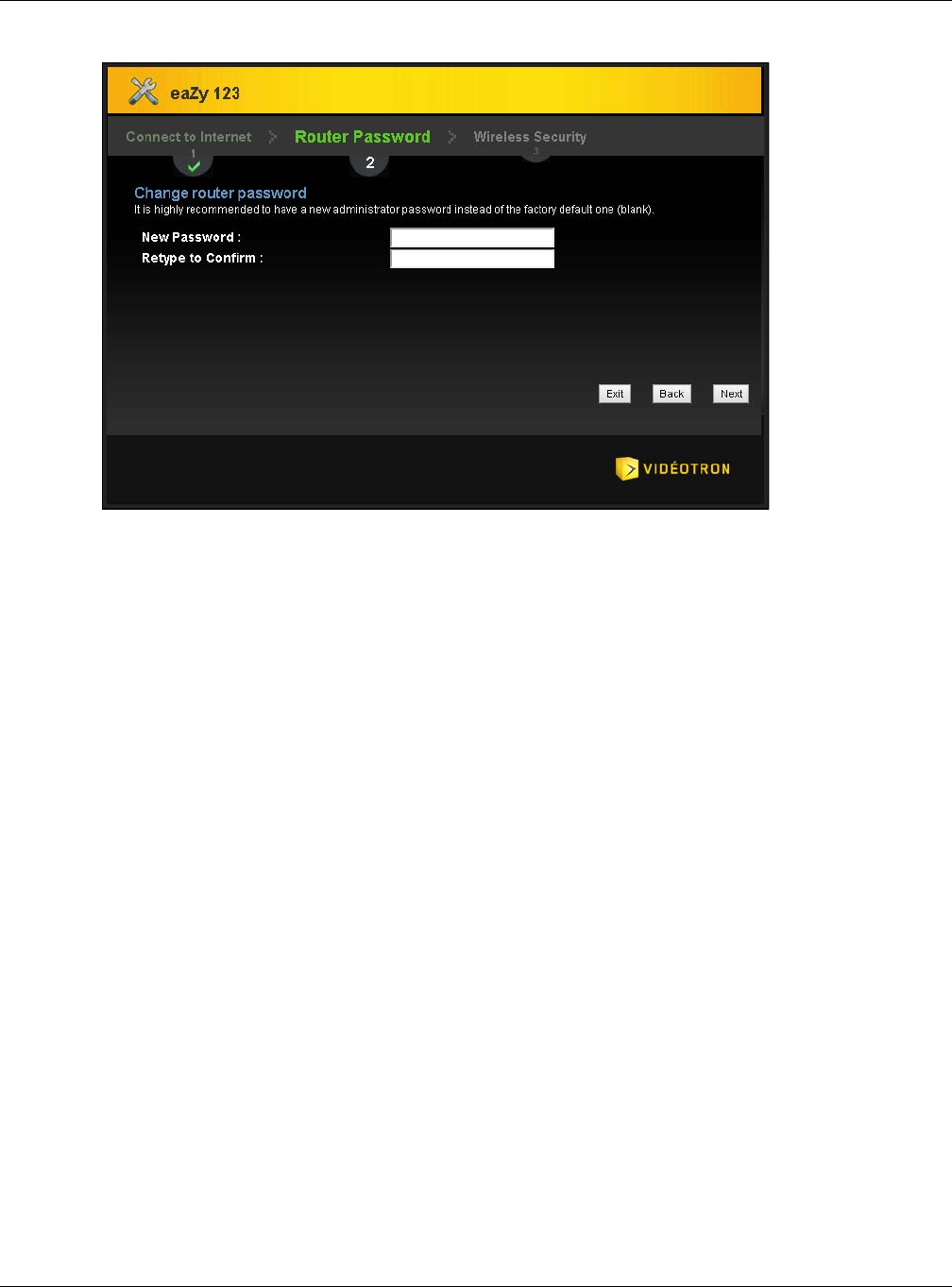
Chapter 2 Connection Wizard
EMG2926-Q10A User’s Guide
24
Figure 12 Router Password
2.5 Wireless Security
Configure Wireless Settings. Configure the wireless network settings on your EMG2926-Q10A in the
following screen. The fields that show up depend on the kind of security you select.
2.5.1 Wireless Security: No Security
Choose No Security in the Wireless Security screen to let wireless devices within range access
your wireless network.
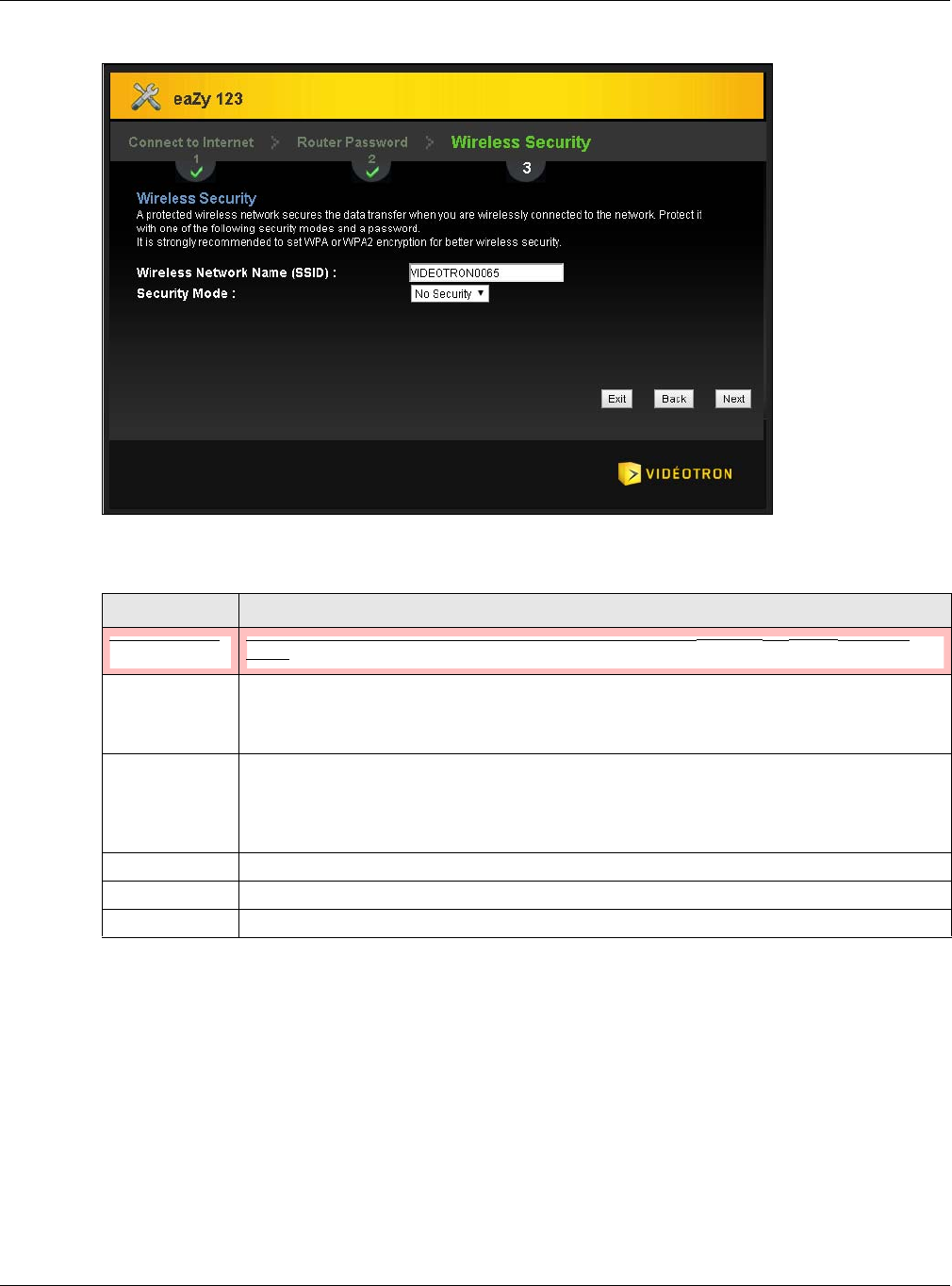
Chapter 2 Connection Wizard
EMG2926-Q10A User’s Guide
25
Figure 13 Wireless Security: No Security
The following table describes the labels in this screen.
2.5.2 Wireless Security: WPA2-PSK
Choose WPA2-PSK security in the Wireless Security screen to set up a password for your wireless
network.
Table 6 Wireless Security: No Security
LABEL DESCRIPTION
Wireless Radio Choose whether you want to apply the wireless security to 2.4G Hz or 5G Hz wireless
radio.
Wireless
Network Name
(SSID)
Enter a descriptive name (up to 32 printable 7-bit ASCII characters) for the wireless LAN.
If you change this field on the EMG2926-Q10A, make sure all wireless stations use the same
SSID in order to access the network.
Security Mode Select a security level from the drop-down list box.
Choose No Security to have no wireless LAN security configured. If you do not enable any
wireless security on your EMG2926-Q10A, your network is accessible to any wireless
networking device that is within range.
Exit Click this to close the wizard screen without saving.
Back Click this to return to the previous screen.
Next Click this to continue.
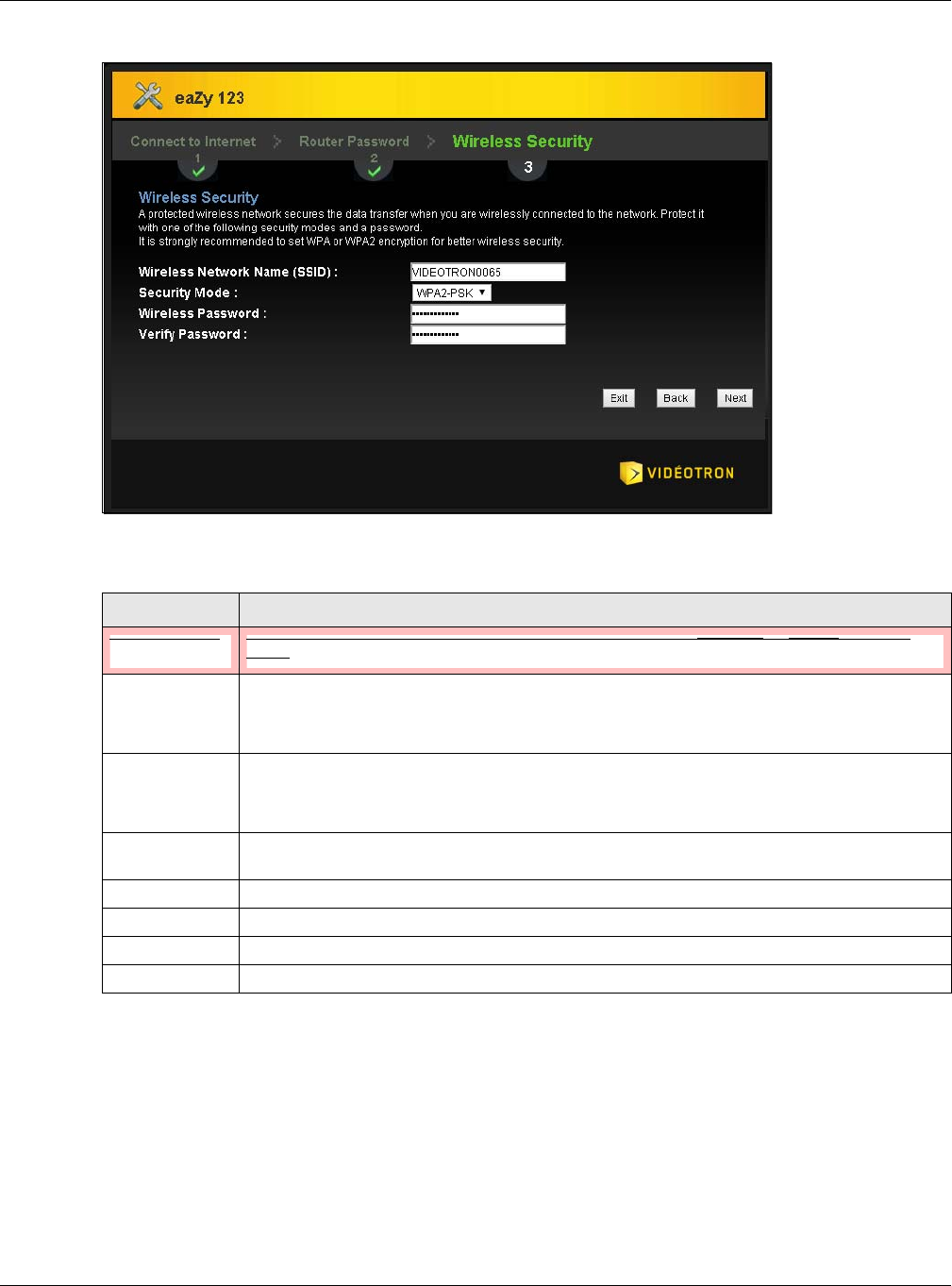
Chapter 2 Connection Wizard
EMG2926-Q10A User’s Guide
26
Figure 14 Wireless Security: WPA2-PSK
The following table describes the labels in this screen.
Congratulations! Open a web browser, such as Internet Explorer, to visit your favorite website.
Note: If you cannot access the Internet when your computer is connected to one of the
EMG2926-Q10A’s LAN ports, check your connections. Then turn the EMG2926-
Q10A off, wait for a few seconds then turn it back on. If that does not work, log in
to the web configurator again and check you have typed all information correctly.
See the User’s Guide for more suggestions.
Table 7 Wireless Security: WPA2-PSK
LABEL DESCRIPTION
Wireless Radio Choose whether you want to apply the wireless security to 2.4G Hz or 5G Hz wireless
radio.
Wireless
Network Name
(SSID)
Enter a descriptive name (up to 32 printable 7-bit ASCII characters) for the wireless LAN.
If you change this field on the EMG2926-Q10A, make sure all wireless stations use the
same SSID in order to access the network.
Security Mode Select a security level from the drop-down list box.
Choose WPA2-PSK security to configure a Pre-Shared Key. Choose this option only if your
wireless clients support WPA2-PSK.
Wireless
password
Type from 8 to 63 case-sensitive ASCII characters. You can set up the most secure wireless
connection by configuring WPA in the wireless LAN screens.
Verify Password Retype the password to confirm.
Exit Click this to close the wizard screen without saving.
Back Click this to return to the previous screen.
Next Click this to continue.
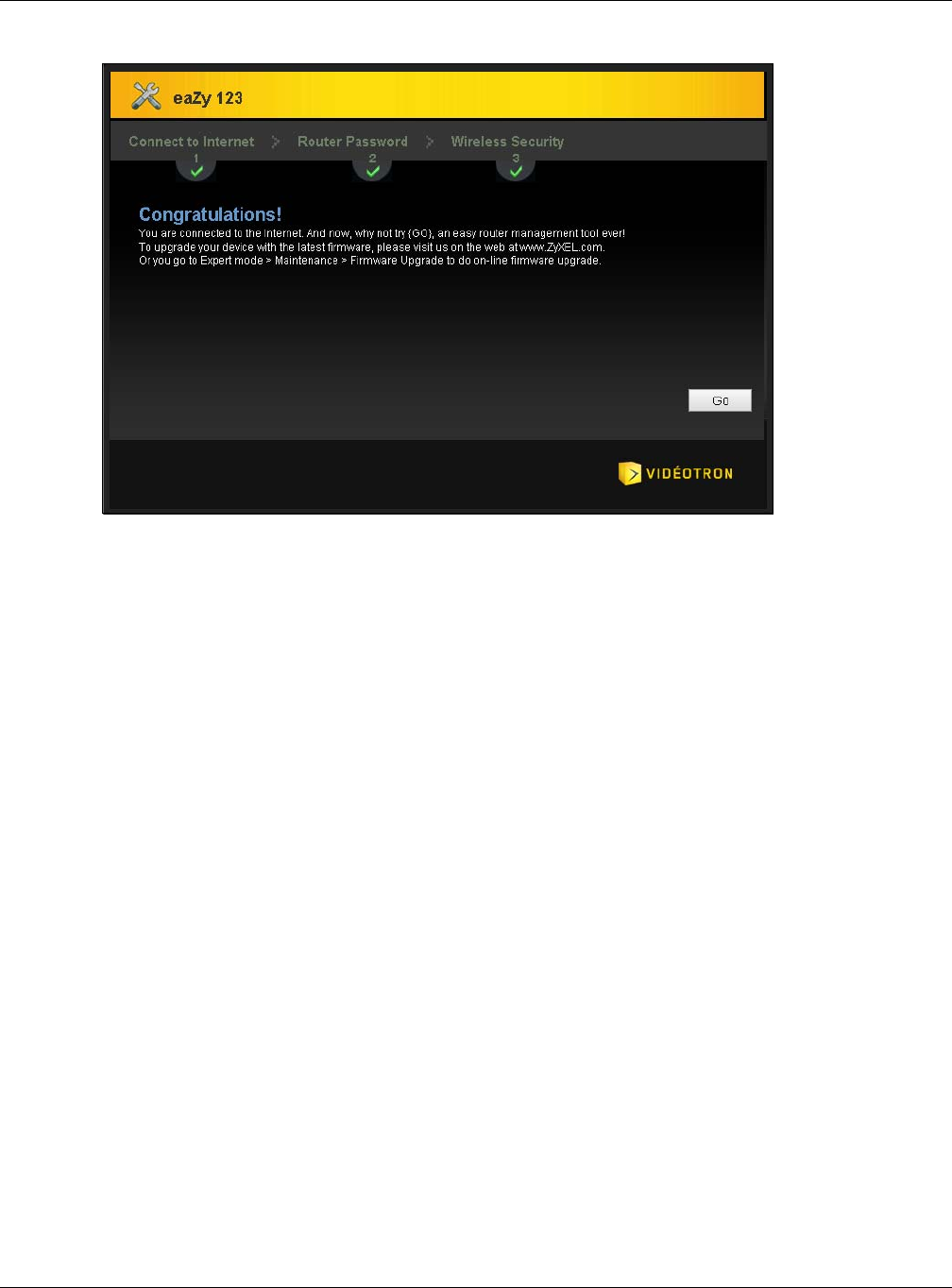
Chapter 2 Connection Wizard
EMG2926-Q10A User’s Guide
27
Figure 15 Congratulations
You can also click GO to open the Easy Mode Web Configurator of your EMG2926-Q10A.
You have successfully set up your EMG2926-Q10A to operate on your network and access the
Internet. You are now ready to connect wirelessly to your EMG2926-Q10A and access the Internet.

EMG2926-Q10A User’s Guide
28
CHAPTER 3
Introducing the Web Configurator
3.1 Overview
This chapter describes how to access the EMG2926-Q10A Web Configurator and provides an
overview of its screens.
The Web Configurator is an HTML-based management interface that allows easy setup and
management of the EMG2926-Q10A via Internet browser. Use Internet Explorer 9.0 and later
versions, Mozilla Firefox 21 and later versions, Safari 6.0 and later versions or Google Chrome 26.0
and later versions. The recommended screen resolution is 1024 by 768 pixels.
In order to use the Web Configurator you need to allow:
• Web browser pop-up windows from your device. Web pop-up blocking is enabled by default in
Windows XP SP (Service Pack) 2.
• JavaScript (enabled by default).
• Java permissions (enabled by default).
Refer to the Troubleshooting chapter (Chapter 27 on page 190) to see how to make sure these
functions are allowed in Internet Explorer.
3.2 Accessing the Web Configurator
1Make sure your EMG2926-Q10A hardware is properly connected and prepare your computer or
computer network to connect to the EMG2926-Q10A (refer to the Quick Start Guide).
2Launch your web browser.
3The EMG2926-Q10A is in router mode by default. Type "http://192.168.0.1" as the website
address.
If the EMG2926-Q10A is in access point, the IP address is 192.168.0.2. See Chapter 4 on page 31
for more information about the modes of the EMG2926-Q10A.
Your computer must be in the same subnet in order to access this website address.
3.2.1 Login Screen
Note: If this is the first time you are accessing the Web Configurator, you may be
redirected to the Wizard. Refer to Chapter 2 on page 18 for the Connection Wizard
screens.
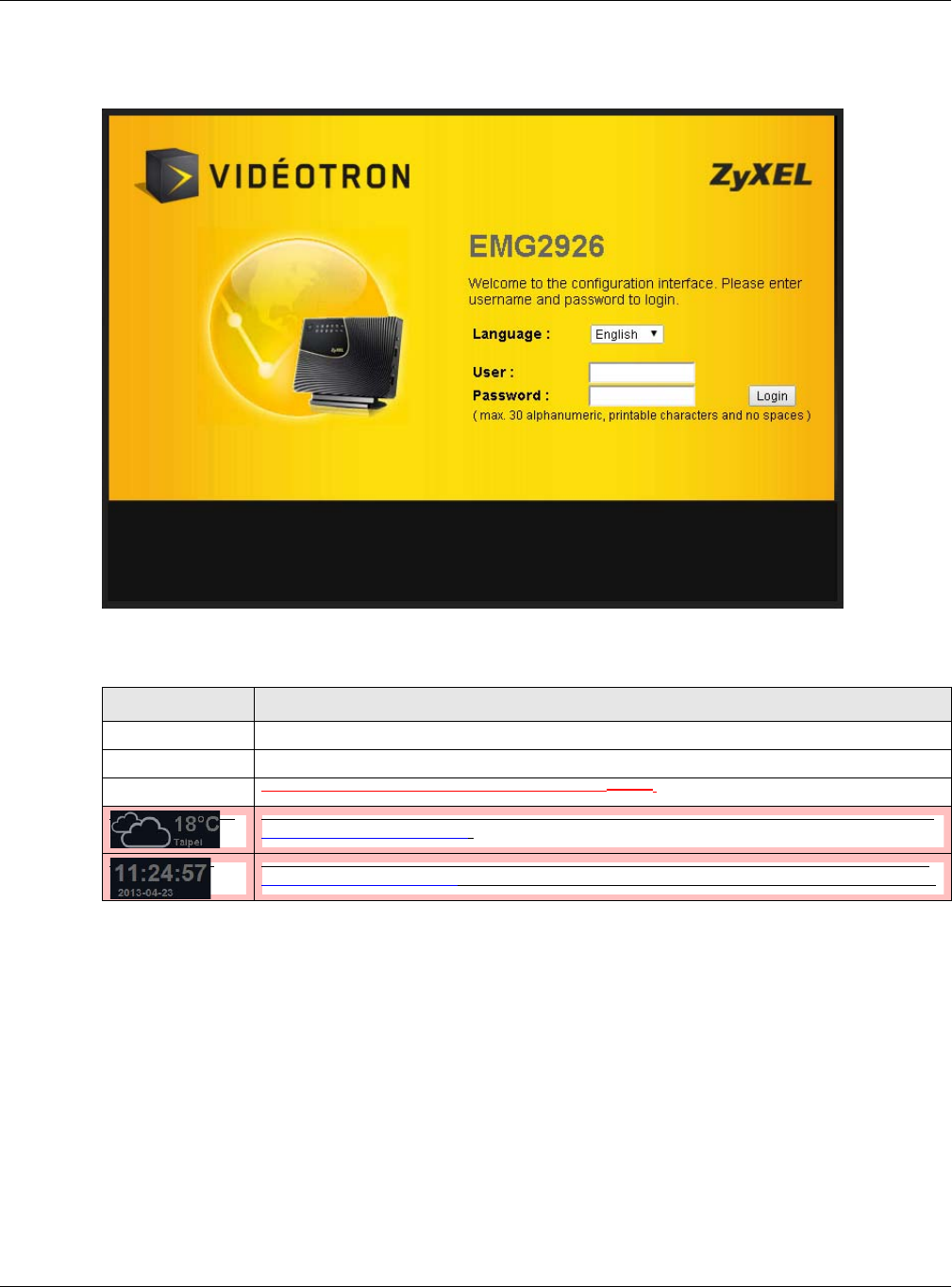
Chapter 3 Introducing the Web Configurator
EMG2926-Q10A User’s Guide
29
The Web Configurator initially displays the following login screen.
Figure 16 Login screen
The following table describes the labels in this screen.
3.2.2 Password Screen
You should see a screen asking you to change your password (highly recommended) as shown
next.
Table 8 Login screen
LABEL DESCRIPTION
Language Select the language you want to use to configure the Web Configurator.
User Type "admin" (default) as the user name. Click Login.
Password Type "1234" (default) as the password. Click Login. Leave this field blank.
This shows the current weather, either in celsius or fahrenheit, of the city you specify in
Section 3.2.2.1 on page 30.
This shows the time (hh:mm:ss) and date (yyyy:mm:dd) of the timezone you select in
Section 26.5 on page 181. The time is in 24-hour format, for example 15:00 is 3:00 PM.
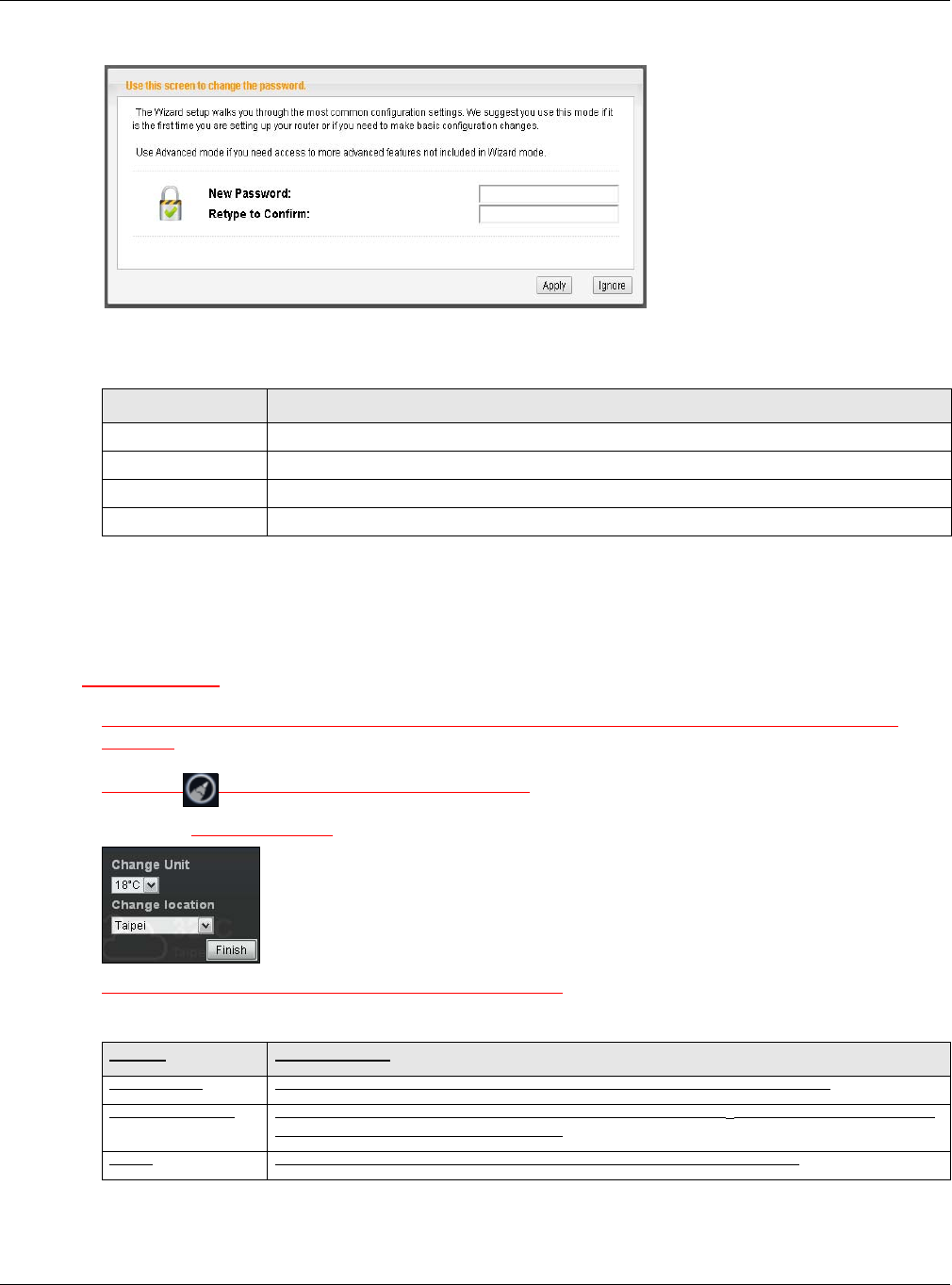
Chapter 3 Introducing the Web Configurator
EMG2926-Q10A User’s Guide
30
Figure 17 Change Password Screen
The following table describes the labels in this screen.
Note: The management session automatically times out when the time period set in the
Administrator Inactivity Timer field expires (default five minutes; go to Chapter
26 on page 179 to change this). Simply log back into the EMG2926-Q10A if this
happens.
3.2.2.1 Weather Edit
You can change the temperature unit and select the location for which you want to know the
weather.
Click the icon to change the Weather display.
Figure 18 Change Weather
The following table describes the labels in this screen.
Table 9 Change Password Screen
LABEL DESCRIPTION
New Password Type a new password.
Retype to Confirm Retype the password for confirmation.
Apply Click Apply to save your changes back to the EMG2926-Q10A.
Ignore Click Ignore if you do not want to change the password this time.
Table 10 Change Weather
LABEL DESCRIPTION
Change Unit Choose which temperature unit you want the EMG2926-Q10A to display.
Change Location Select the location for which you want to know the weather. If the city you want is not
listed, choose one that is closest to it.
Finish Click this to apply the settings and refresh the date and time display.

EMG2926-Q10A User’s Guide
31
CHAPTER 4
EMG2926-Q10A Modes
4.1 Overview
This chapter introduces the different modes available on your EMG2926-Q10A. First, the term
“mode” refers to two things in this User’s Guide.
•Web Configurator mode. This refers to the Web Configurator interface you want to use for
editing EMG2926-Q10A features.
•Device mode. This is the operating mode of your EMG2926-Q10A, or simply how the EMG2926-
Q10A is being used in the network.
4.1.1 Web Configurator Modes
This refers to the configuration interface of the Web Configurator, which has two modes:
•Easy Mode: The Web Configurator shows this mode by default. Refer to Chapter 5 on page 32
for more information on the screens in this mode. This interface may be sufficient for users who
just want to use the device.
•Expert Mode: Advanced users can change to this mode to customize all the functions of the
EMG2926-Q10A. Click Expert Mode after logging into the Web Configurator. The User’s Guide
Chapter 3 on page 28 through Chapter 26 on page 188 discusses the screens in this mode.
4.1.2 Device Modes
This refers to the operating mode of the EMG2926-Q10A, which can act as a:
•Router: This is the default device mode of the EMG2926-Q10A. Use this mode to connect the
local network to another network, like the Internet. Go to Section 6.2 on page 43 to view the
Status screen in this mode.
•Access Point: Use this mode if you want to extend your network by allowing network devices to
connect to the EMG2926-Q10A wirelessly. Go to Section 7.4 on page 52 to view the Status
screen in this mode.
For more information on these modes and to change the mode of your EMG2926-Q10A, refer to
Chapter 26 on page 188.
The menu for changing device modes is available in Expert Mode only.
Note: Choose your device mode carefully to avoid having to change it later.
When changing to another mode, the IP address of the EMG2926-Q10A changes. The running
applications and services of the network devices connected to the EMG2926-Q10A can be
interrupted.
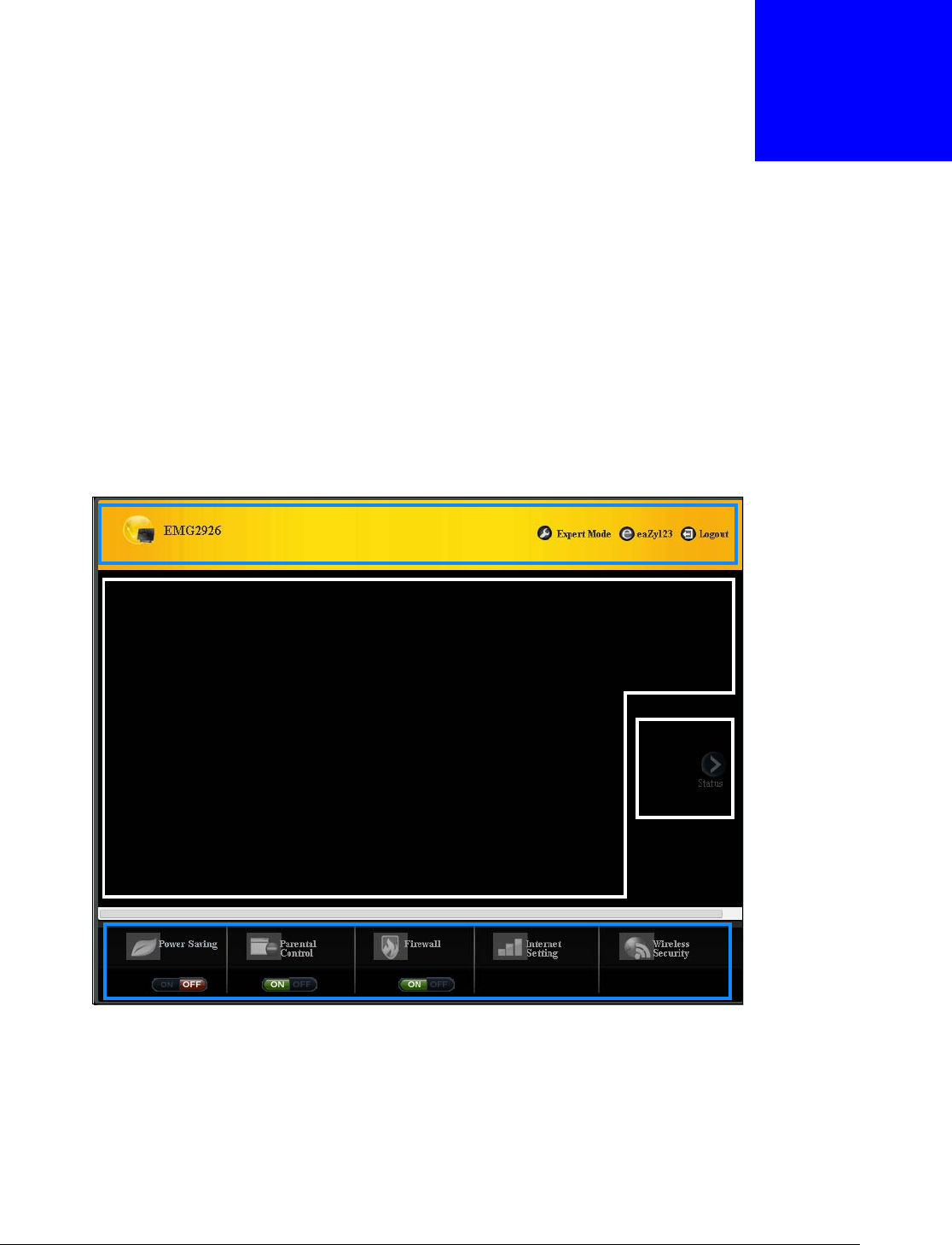
EMG2926-Q10A User’s Guide
32
CHAPTER 5
Easy Mode
5.1 Overview
The Web Configurator is set to Easy Mode by default. You can configure several key features of the
EMG2926-Q10A in this mode. This mode is useful to users who are not fully familiar with some
features that are usually intended for network administrators.
When you log in to the Web Configurator, the following screen opens.
Figure 19 Easy Mode: Network Map
Click Status to open the following screen.
Network Map
Control Panel
Go to
Status
Screen
Navigation Panel
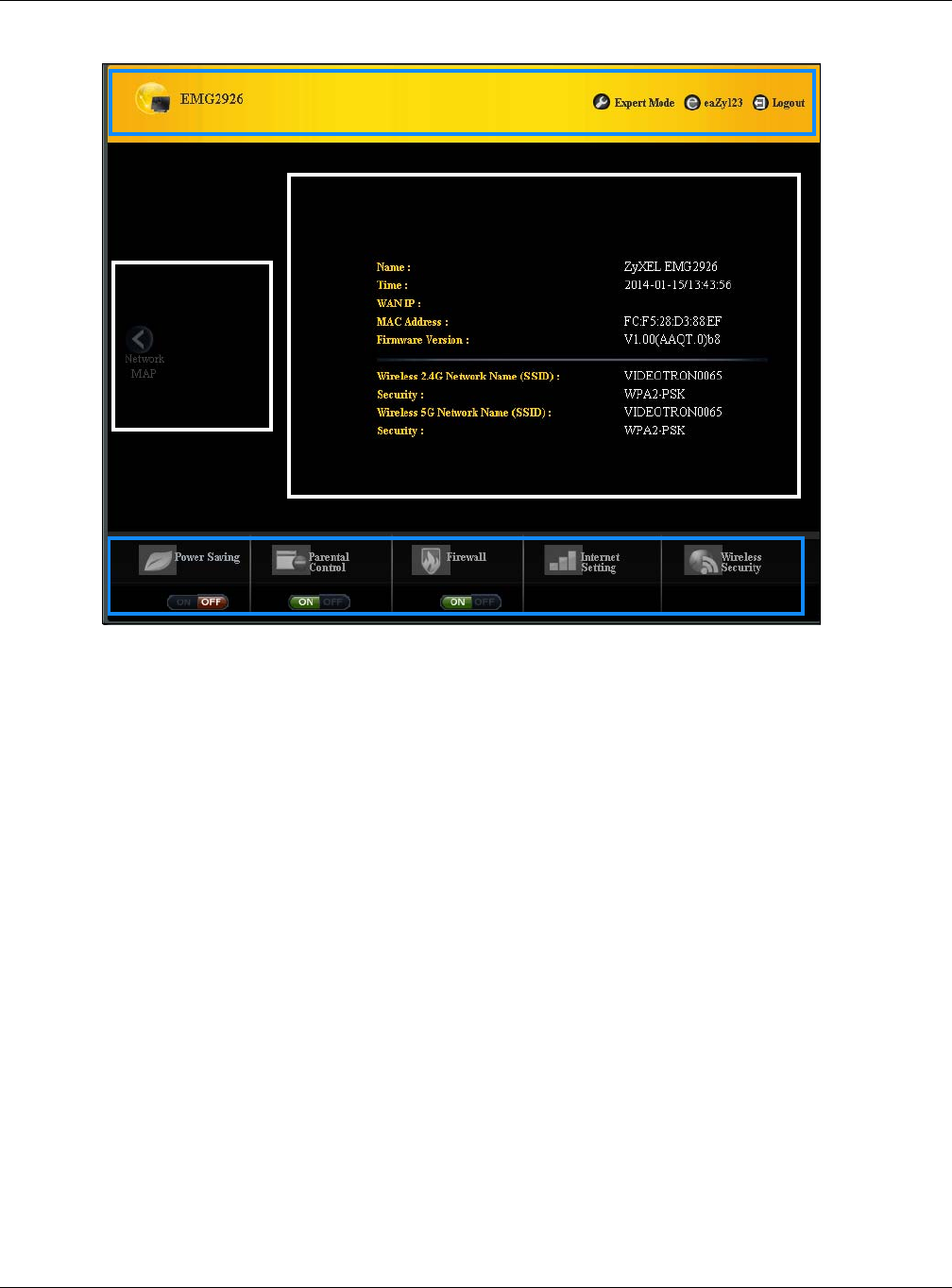
Chapter 5 Easy Mode
EMG2926-Q10A User’s Guide
33
Figure 20 Easy Mode: Status Screen
5.2 What You Can Do
You can do the following in this mode:
•Use the Navigation Panel to opt out of the Easy Mode (Section 5.4 on page 34).
•Use the Network Map screen to check whether your EMG2926-Q10A is connected to the
Internet or any networking devices and view the transmission speed between them when
StreamBoost is enabled. At the time of writing, the StreamBoost feature is turned off on the
EMG2926-Q10A.
•Use the Control Panel to configure and enable EMG2926-Q10A features, including wireless
scheduling, wireless security, parental control, firewall and so on (Section 5.6 on page 35).
•Use the Status Screen to view read-only information about the EMG2926-Q10A, including the
WAN IP, MAC address of the EMG2926-Q10A, the firmware version and wireless settigns (Section
5.7 on page 41).
5.3 What You Need to Know
Between the different device modes, the Control Panel (Section 5.6 on page 35) changes
depending on which features are applicable to the mode:
•Router Mode: All Control Panel features are available.
Control Panel
Status Screen
Go to
Network
Map
Screen
Navigation Panel
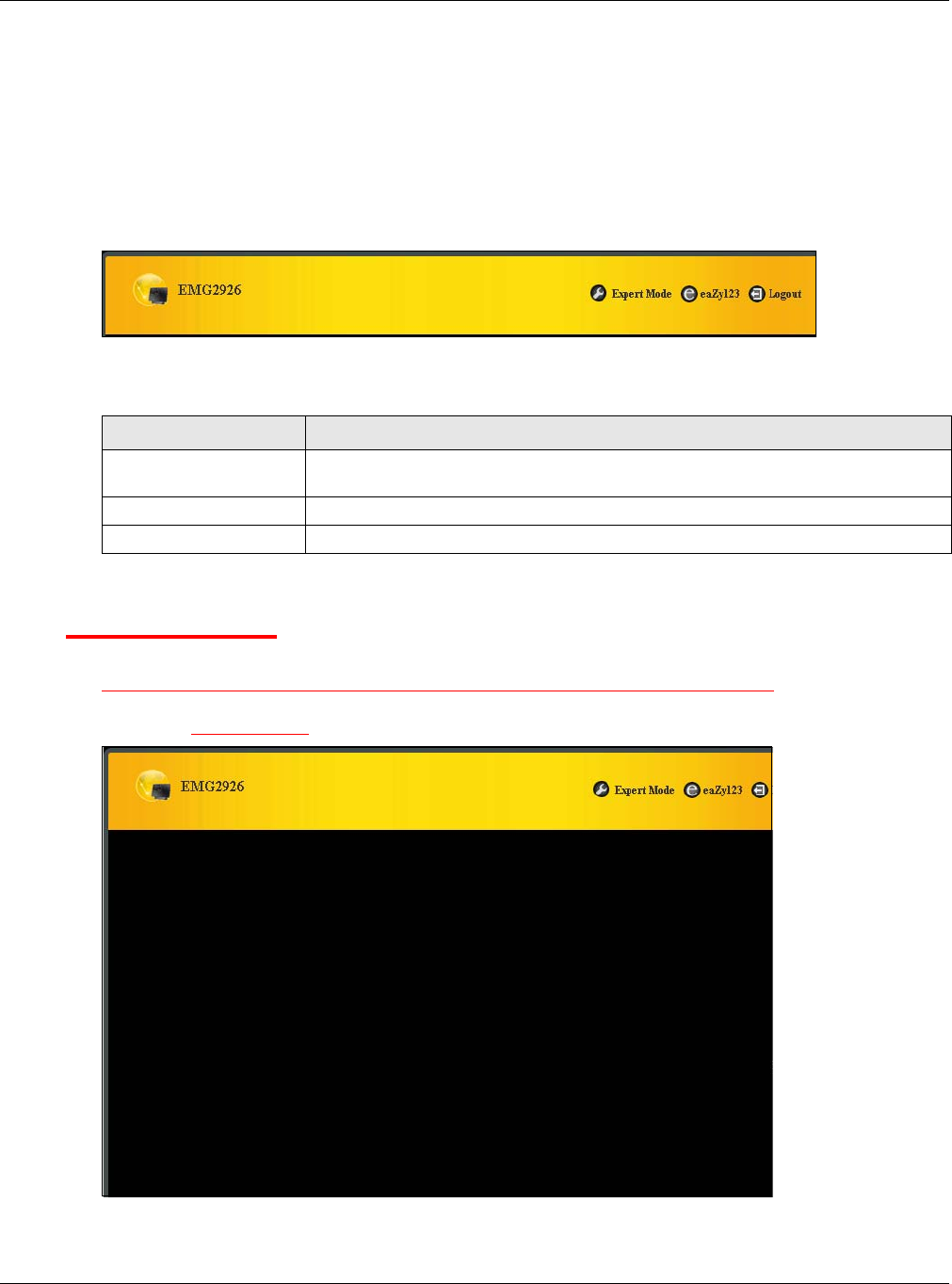
Chapter 5 Easy Mode
EMG2926-Q10A User’s Guide
34
•Access Point Mode: Only Power Saving and Wireless Security are available.
5.4 Navigation Panel
Use this navigation panel to opt out of the Easy Mode.
Figure 21 Control Panel
The following table describes the labels in this screen.
5.5 Network Map
When you log into the Web Configurator, the Network Map is shown as follows.
Figure 22 Network Map
Table 11 Control Panel
ITEM DESCRIPTION
Expert Mode Click this to change to Expert Mode and customize features of the EMG2926-
Q10A.
eaZy123 Click this icon to open the setup wizard.
Logout Click this to end the Web Configurator session and go to the Login page.
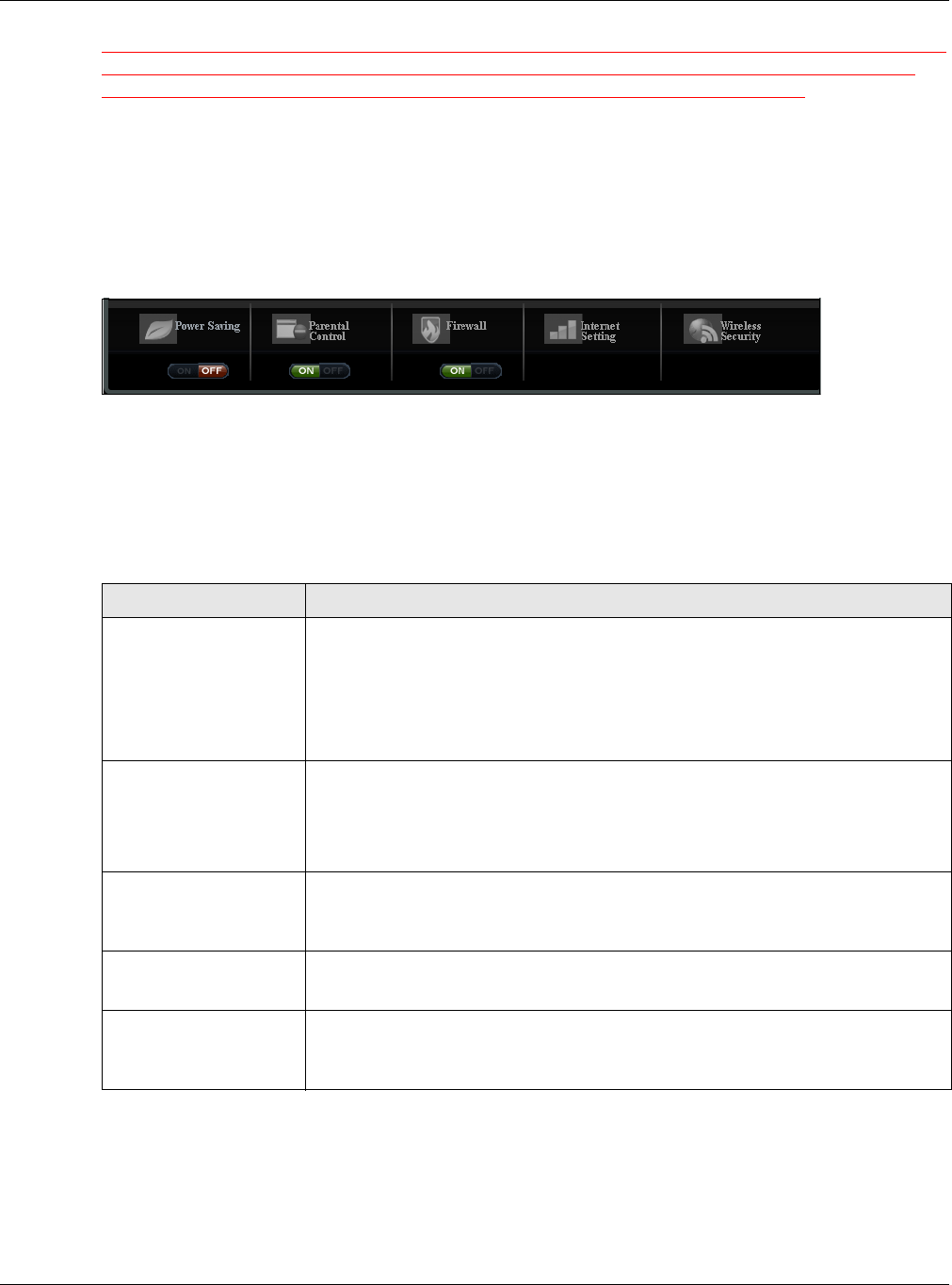
Chapter 5 Easy Mode
EMG2926-Q10A User’s Guide
35
You can view the upstream and downstream transmission speed between the EMG2926-Q10A and
the Internet and/or between the EMG2926-Q10A and the connected device(s) (represented by
icons indicating the kind of network device), including those connecting wirelessly.
5.6 Control Panel
The features configurable in Easy Mode are shown in the Control Panel.
Figure 23 Control Panel
Switch ON to enable the feature. Otherwise, switch OFF. If the feature is turned on, the green light
flashes. If it is turned off, the red light flashes.
Additionally, click the feature to open a screen where you can edit its settings.
The following table describes the labels in this screen.
5.6.1 Power Saving
Use this screen to set the day of the week and time of the day when your wireless LAN is turned on
and off. Wireless LAN scheduling is disabled by default.
Disabling the wireless capability lowers the energy consumption of the of the EMG2926-Q10A.
Table 12 Control Panel
ITEM DESCRIPTION
Power Saving Click this to schedule the wireless feature of the EMG2926-Q10A.
Disabling the wireless function helps lower the energy consumption of the
EMG2926-Q10A.
Switch ON to apply wireless scheduling. Otherwise, switch OFF.
Refer to Section 5.6.1 on page 35 to see this screen.
Parental Control Click this to restrict access to certain websites, based on keywords contained in
URLs, to which you do not want users in your network to open.
Switch ON to apply website filtering. Otherwise, switch OFF.
Refer to Section 5.6.2 on page 36 to see this screen.
Firewall Switch ON to ensure that your network is protected from Denial of Service (DoS)
attacks. Otherwise, switch OFF.
Refer to Section 5.6.3 on page 37 to see this screen.
Internet Setting Click this to configure the Internet connection settings.
Refer to Section 5.6.4 on page 38 to see this screen.
Wireless Security Click this to configure the wireless security, such as SSID, security mode and WPS
key on your EMG2926-Q10A.
Refer to Section 5.6.5 on page 40 to see this screen.
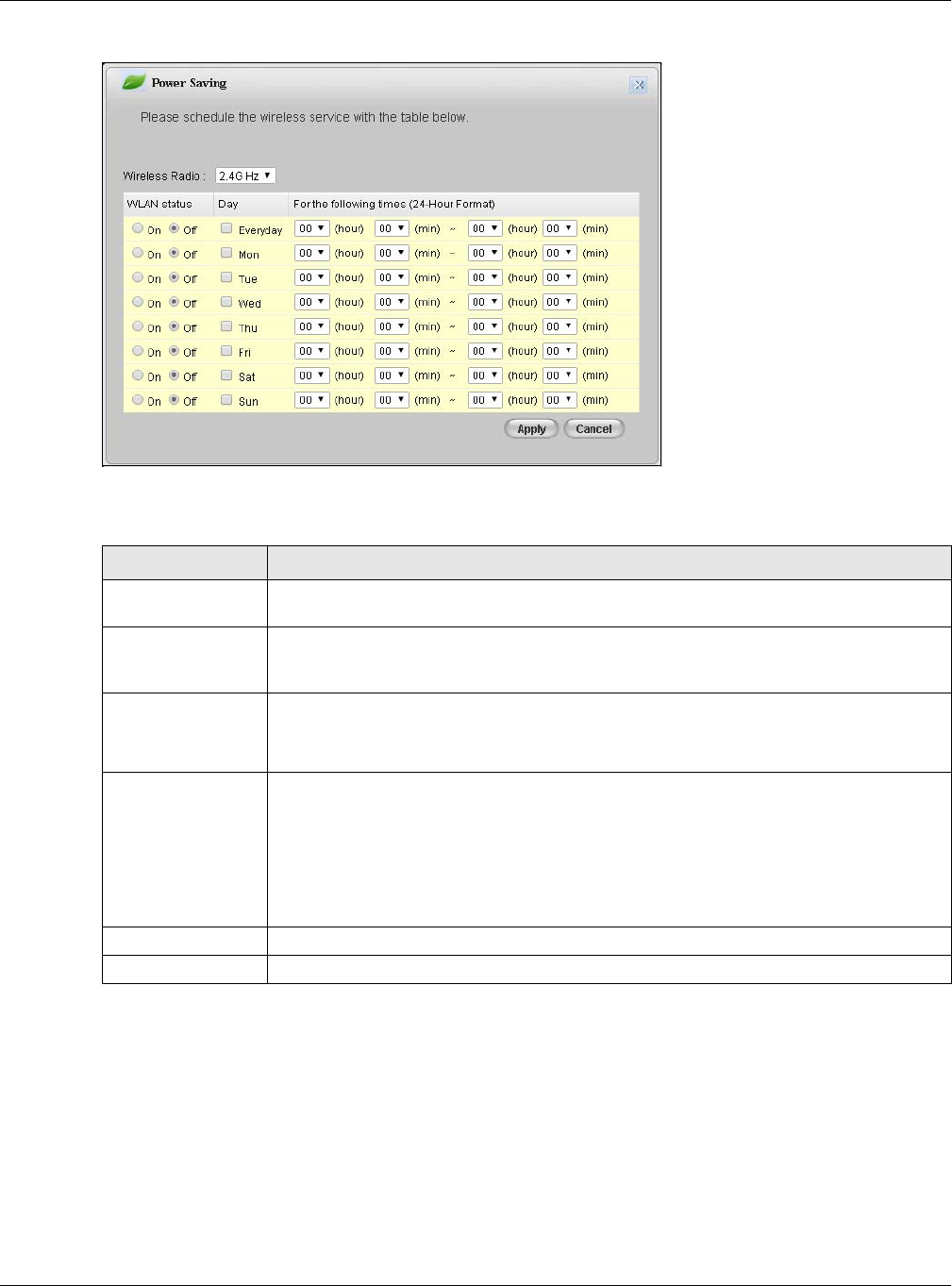
Chapter 5 Easy Mode
EMG2926-Q10A User’s Guide
36
Figure 24 Power Saving
The following table describes the labels in this screen.
5.6.2 Parental Control
Use this screen to view the parental control rules configured on the EMG2926-Q10A.
Table 13 Power Saving
LABEL DESCRIPTION
Wireless Radio Choose whether you want to apply the power saving schedule to 2.4G Hz or 5G Hz
wireless radio.
WLAN Status Select On or Off to specify whether the Wireless LAN is turned on or off (depending on
what you selected in the WLAN Status field). This field works in conjunction with the
Day and For the following times fields.
Day Select Everyday or the specific days to turn the Wireless LAN on or off.
If you select Everyday you can not select any specific days. This field works in
conjunction with the For the following times field.
For the following
times (24-Hour
Format)
Select a begin time using the first set of hour and minute (min) drop down boxes and
select an end time using the second set of hour and minute (min) drop down boxes. If
you have chosen On earlier for the WLAN Status the Wireless LAN will turn on between
the two times you enter in these fields. If you have chosen Off earlier for the WLAN
Status the Wireless LAN will turn off between the two times you enter in these fields.
In this time format, midnight is 00:00 and progresses up to 24:00. For example, 6:00
PM is 18:00.
Apply Click Apply to save your changes back to the EMG2926-Q10A.
Cancel Click Cancel to close this screen without saving any changes.
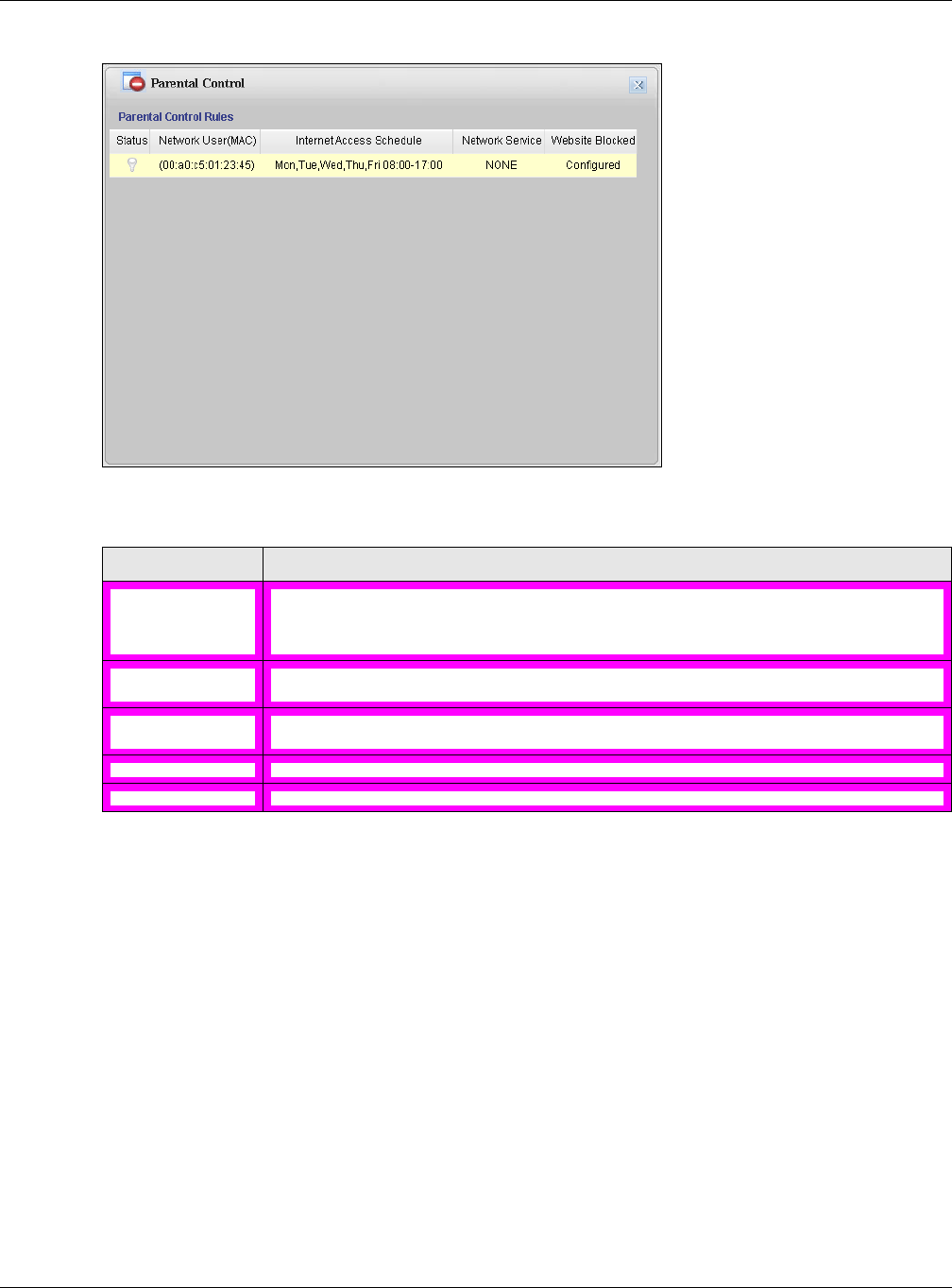
Chapter 5 Easy Mode
EMG2926-Q10A User’s Guide
37
Figure 25 Parental Control
The following table describes the labels in this screen.
5.6.3 Firewall
Enable this feature to protect the network from Denial of Service (DoS) attacks. The EMG2926-
Q10A blocks repetitive pings from the WAN that can otherwise cause systems to slow down or
hang.
Table 14 Parental Control
LABEL DESCRIPTION
Status This indicates whether the rule is active or not.
A yellow bulb signifies that this rule is active. A gray bulb signifies that this rule is not
active.
Network User
(MAC)
This shows the MAC address of the LAN user’s computer to which this rule applies.
Internet Access
Schedule
This shows the day(s) and time on which parental control is enabled.
Network Service This shows whether the network service is configured. If not, NONE will be shown.
Website Blocked This shows whether the website block is configured. If not, NONE will be shown.
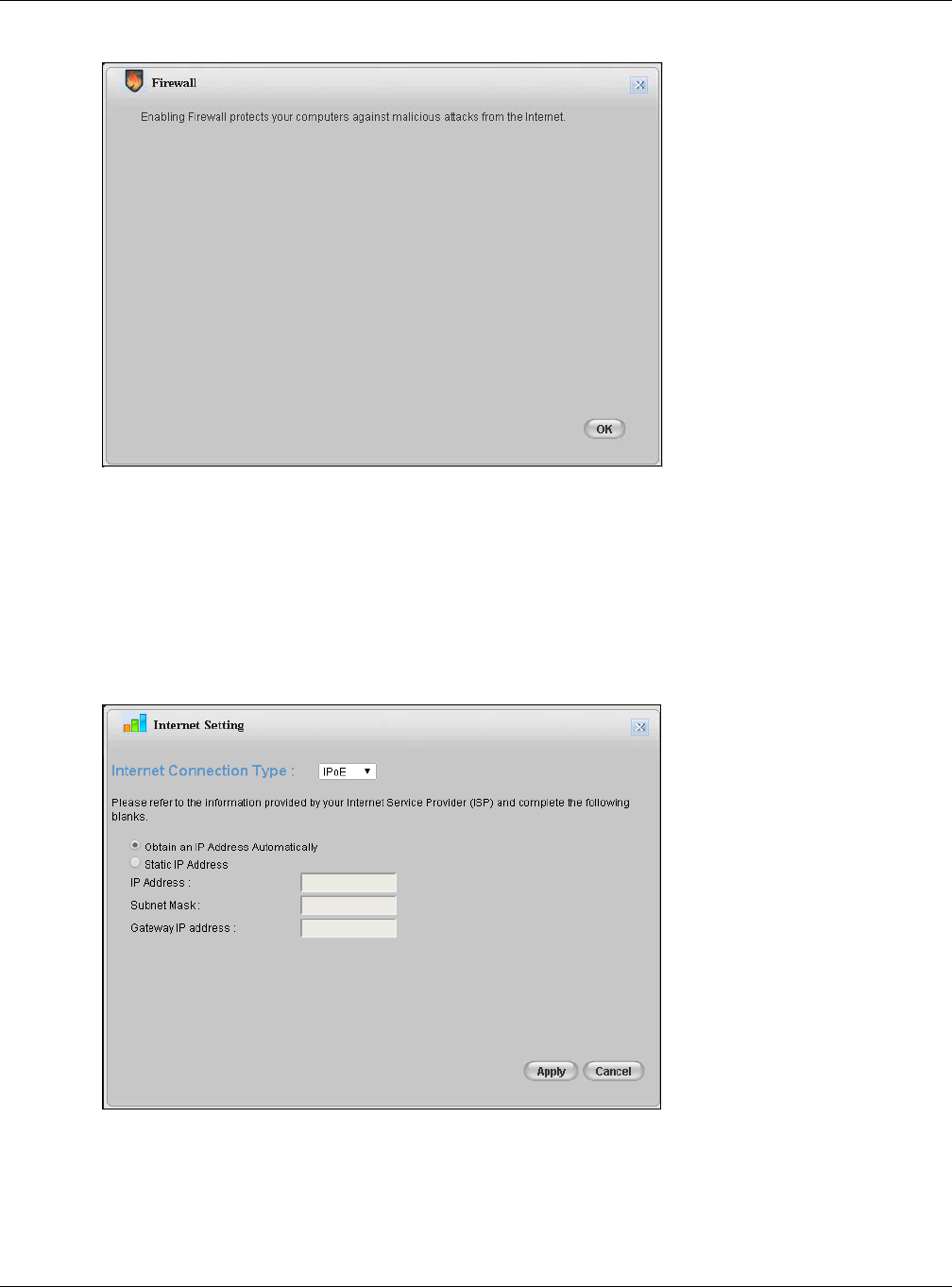
Chapter 5 Easy Mode
EMG2926-Q10A User’s Guide
38
Figure 26 Firewall
Click OK to close this screen.
5.6.4 Internet Setting
Use this screen to configure your EMG2926-Q10A for Internet access. You should already have
Internet account information from your ISP. The screen varies depending on the Internet
connection type you selected.
Figure 27 Internet Setting (IPoE)
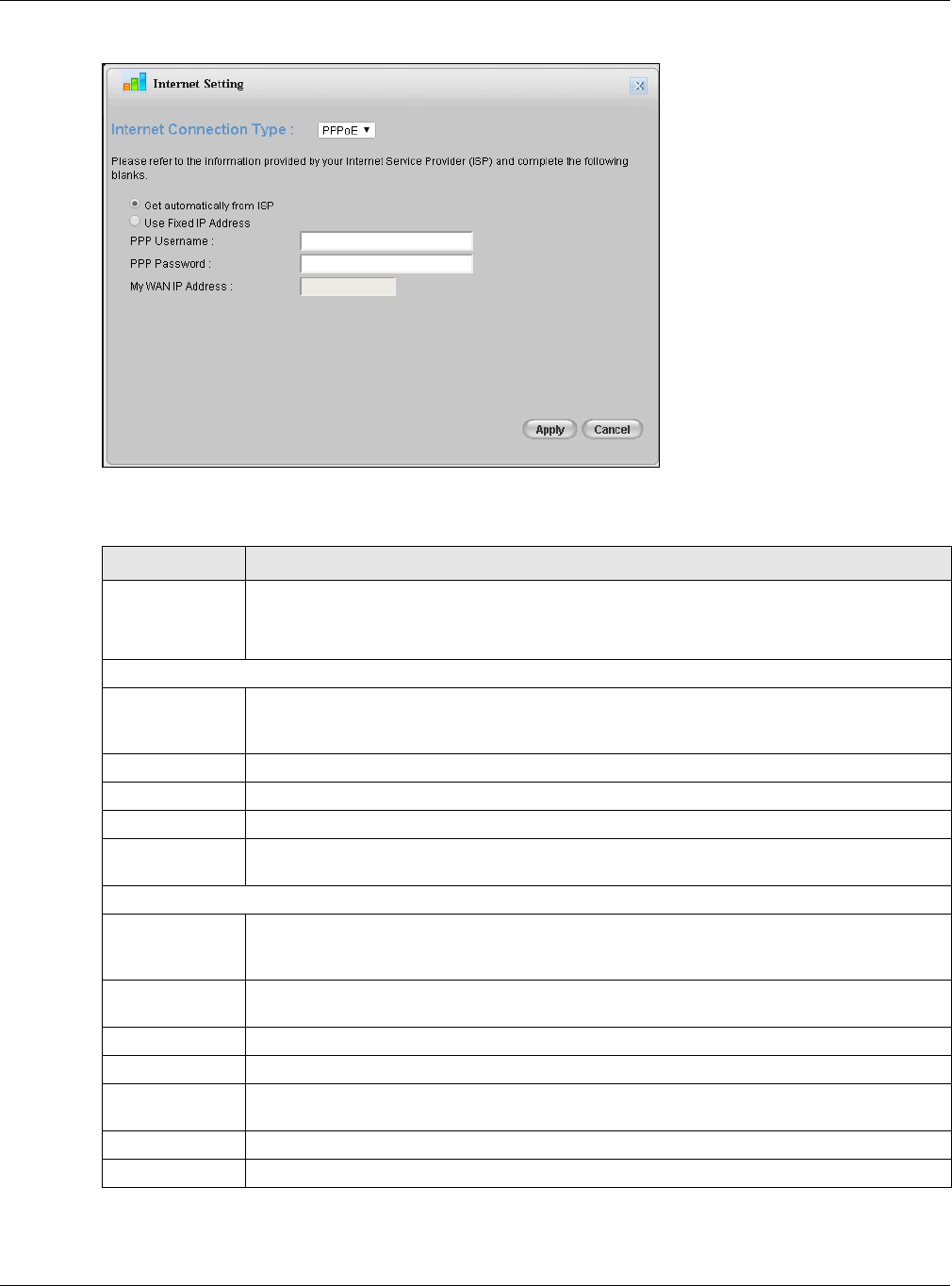
Chapter 5 Easy Mode
EMG2926-Q10A User’s Guide
39
Figure 28 Internet Setting (PPPoE)
The following table describes the labels in this screen.
Table 15 Internet Setting
LABEL DESCRIPTION
Internet
Connection Type
Select the IPoE (IP over Ethernet) option when the WAN port is used as a regular
Ethernet.
Select the PPPoE (Point-to-Point Protocol over Ethernet) option for a dial-up connection.
The following fields are available if you select IPoE.
Obtain an IP
Address
Automatically
Select this radio button if your ISP did not assign you a fixed IP address.
Static IP Address Select this radio button if your ISP assigned an IP address for your Internet connection.
IP Address Enter the IP address provided by your ISP.
Subnet Mask Enter the IP subnet mask in this field.
Gateway IP
Address
Enter the gateway IP address in this field.
The following fields are available if you select PPPoE.
Get
automatically
from ISP
Select this radio button if your ISP did not assign you a fixed IP address.
Use Fixed IP
Address
Select this radio button, provided by your ISP to give the EMG2926-Q10A a fixed, unique
IP address.
PPP Username Type the user name given to you by your ISP.
PPP Password Type the password associated with the user name above.
My WAN IP
Address
Type the name of your service provider.
Cancel Click Cancel to close this screen.
Apply Click Apply to save your changes back to the EMG2926-Q10A.
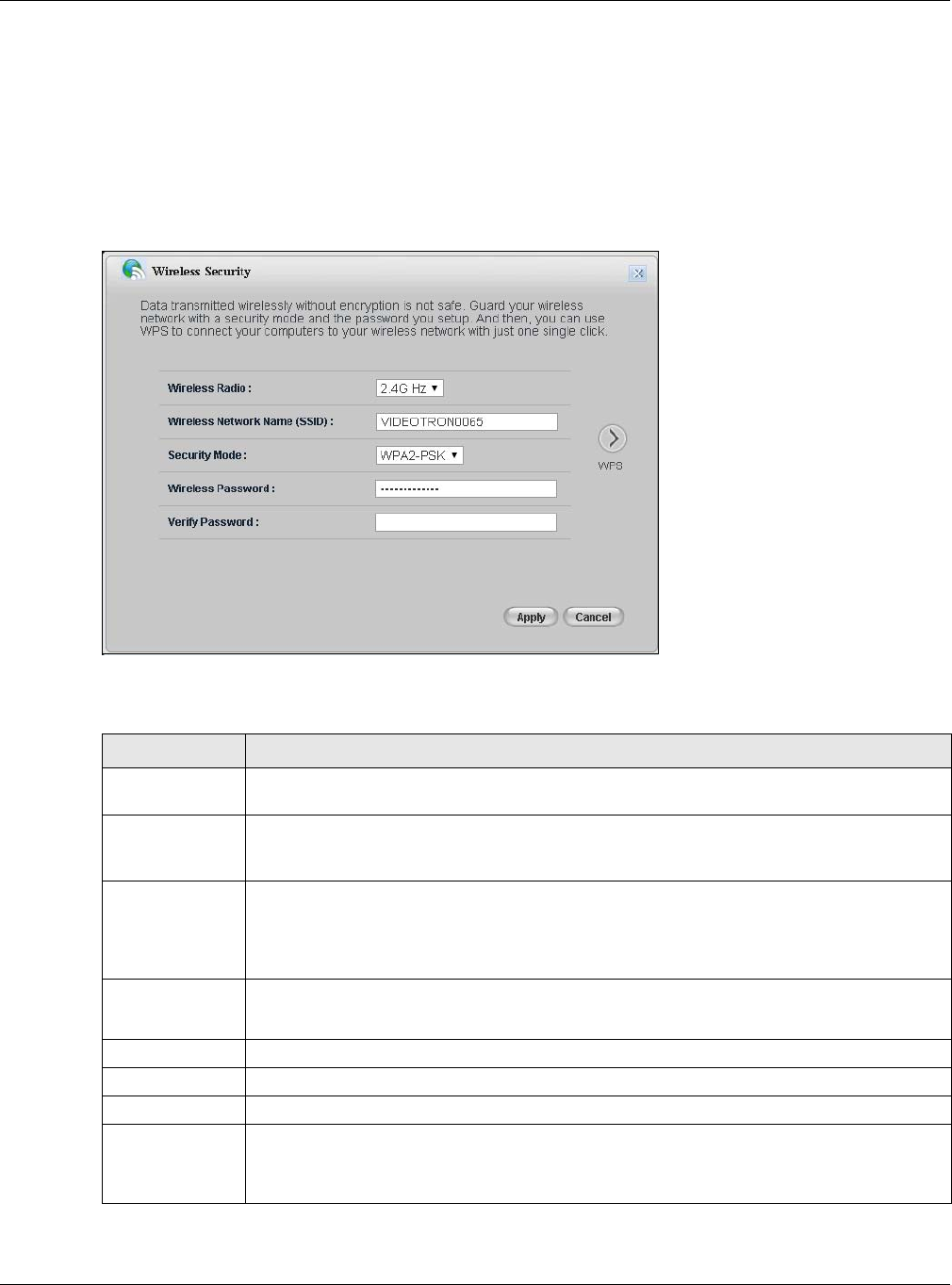
Chapter 5 Easy Mode
EMG2926-Q10A User’s Guide
40
5.6.5 Wireless Security
Use this screen to configure security for your the wireless LAN. You can enter the SSID and select
the wireless security mode in the following screen.
Note: You can enable the wireless function of your EMG2926-Q10A by first turning on the
switch in the side panel.
Figure 29 Wireless Security
The following table describes the general wireless LAN labels in this screen.
Table 16 Wireless Security
LABEL DESCRIPTION
Wireless Radio Choose whether you want to apply the wireless security to 2.4G Hz or 5G Hz wireless
radio.
Wireless
Network Name
(SSID)
(Service Set IDentity) The SSID identifies the Service Set with which a wireless station is
associated. Wireless stations associating to the access point (AP) must have the same
SSID. Enter a descriptive name (up to 32 keyboard characters) for the wireless LAN.
Security mode Select WPA2-PSK to add security on this wireless network. The wireless clients which
want to associate to this network must have same wireless security settings as this device.
After you select to use a security, additional options appears in this screen.
Select No Security to allow any client to connect to this network without authentication.
Wireless
password
This field appears when you choose wither WPA2-PSK as the security mode.
Type a pre-shared key from 8 to 63 case-sensitive keyboard characters.
Verify password Type the password again to confirm.
Apply Click Apply to save your changes back to the EMG2926-Q10A.
Cancel Click Cancel to close this screen.
WPS Click this to configure the WPS screen.
You can transfer the wireless settings configured here (Wireless Security screen) to
another wireless device that supports WPS.
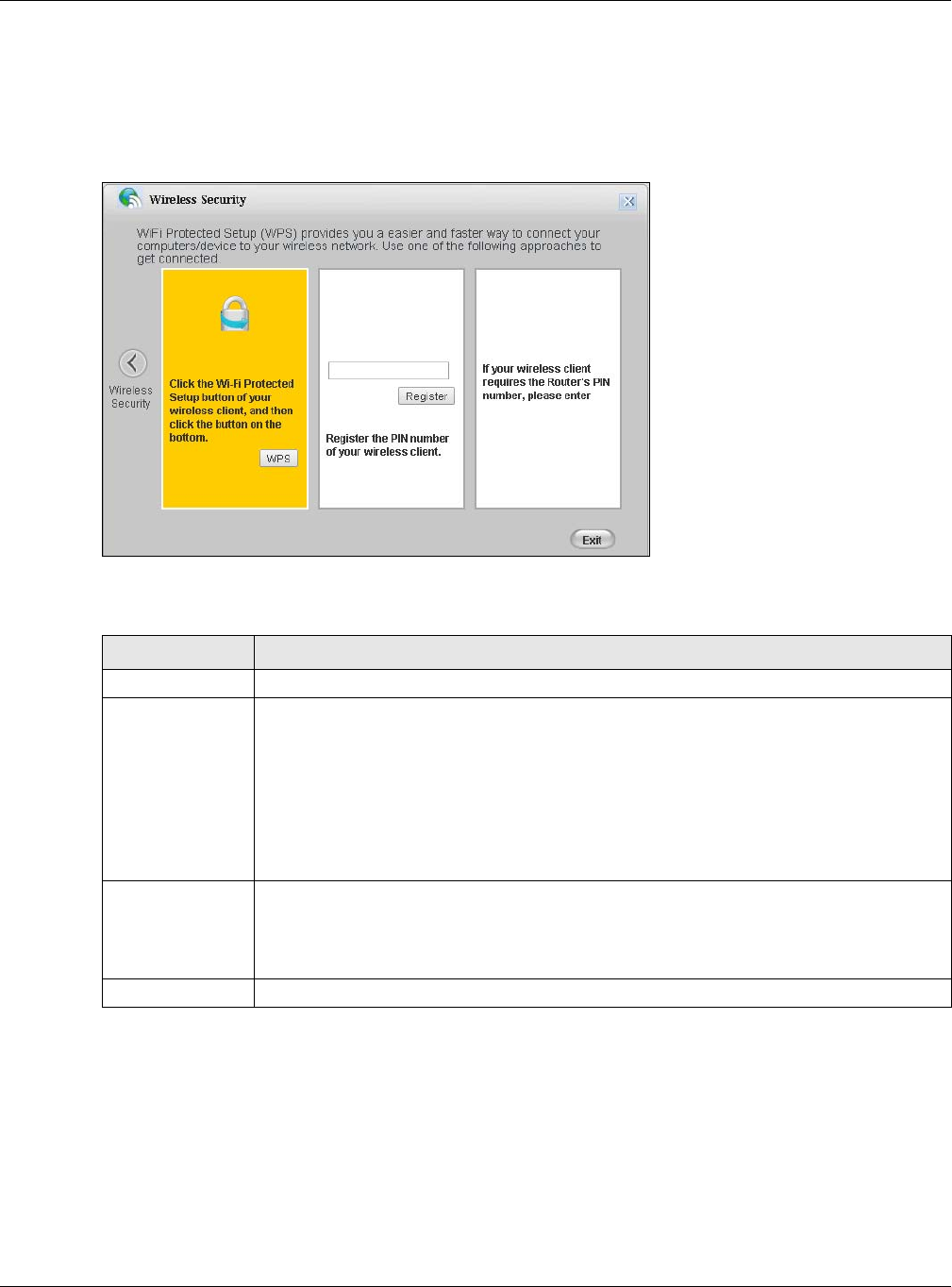
Chapter 5 Easy Mode
EMG2926-Q10A User’s Guide
41
5.6.6 WPS
Use this screen to add a wireless station to the network using WPS. Click WPS in the Wireless
Security to open the following screen.
Figure 30 Wireless Security: WPS
The following table describes the labels in this screen.
5.7 Status Screen in Easy Mode
In the Network Map screen, click Status to view read-only information about the EMG2926-Q10A.
Table 17 Wireless Security: WPS
LABEL DESCRIPTION
Wireless Security Click this to go back to the Wireless Security screen.
WPS Create a secure wireless network simply by pressing a button.
The EMG2926-Q10A scans for a WPS-enabled device within the range and performs
wireless security information synchronization.
Note: After you click the WPS button on this screen, you have to press a similar button in
the wireless station utility within 2 minutes. To add the second wireless station, you
have to press these buttons on both device and the wireless station again after the
first 2 minutes.
Register Create a secure wireless network simply by entering a wireless client's PIN (Personal
Identification Number) in the EMG2926-Q10A’s interface and pushing this button.
Type the same PIN number generated in the wireless station’s utility. Then click Register
to associate to each other and perform the wireless security information synchronization.
Exit Click Exit to close this screen.
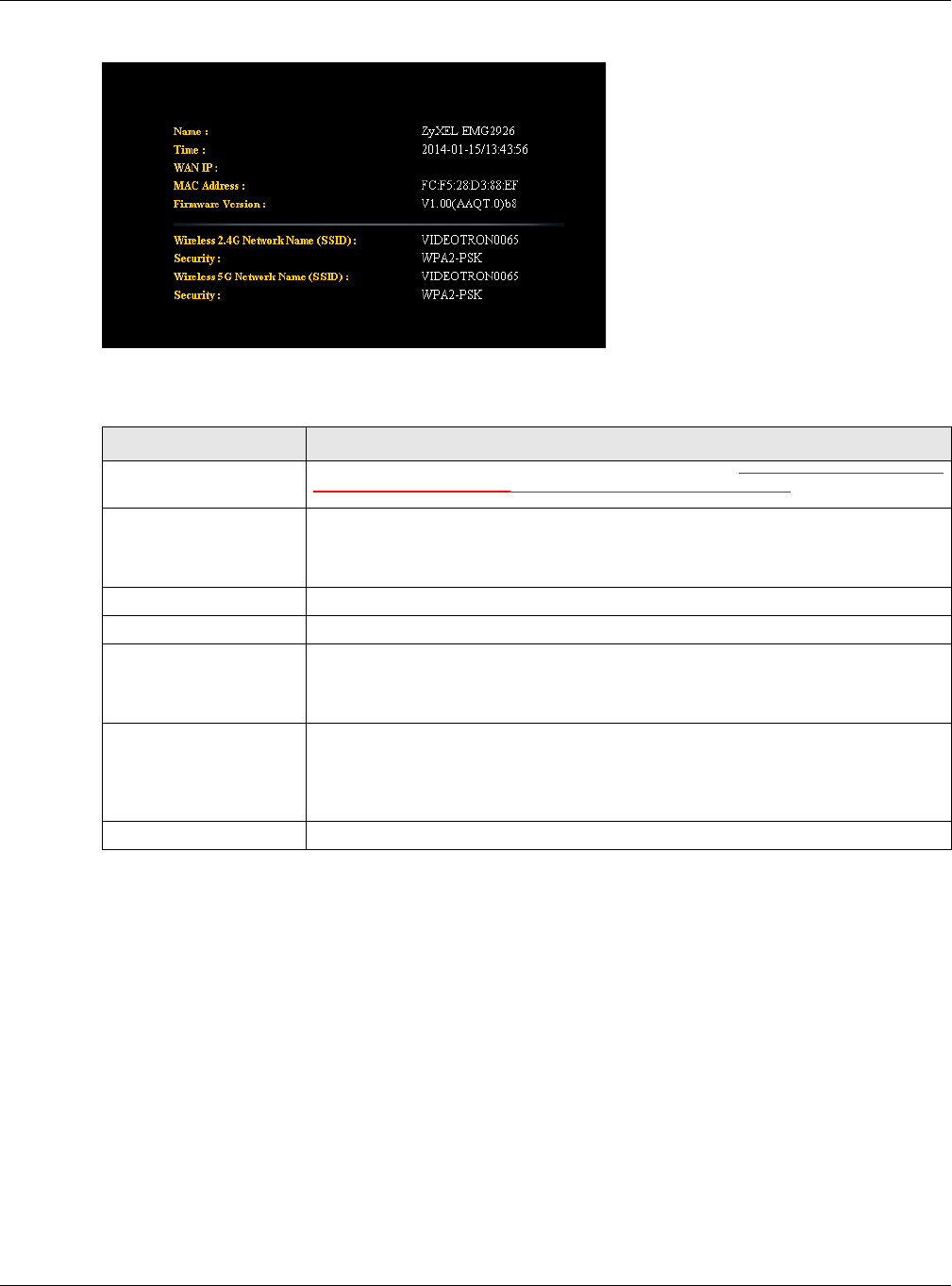
Chapter 5 Easy Mode
EMG2926-Q10A User’s Guide
42
Figure 31 Status Screen in Easy Mode
The following table describes the labels in this screen.
Table 18 Status Screen in Easy Mode
ITEM DESCRIPTION
Name This is the name of the EMG2926-Q10A in the network. You can change this in the
Maintenance > General screen in Section 26.3 on page 179.
Time This is the current system date and time.
The date is in YYYY:MM:DD (Year-Month-Day) format. The time is in HH:MM:SS
(Hour:Minutes:Seconds) format.
WAN IP This is the IP address of the WAN port.
MAC Address This is the MAC address of the EMG2926-Q10A.
Firmware Version This shows the firmware version of the EMG2926-Q10A.
The firmware version format shows the trunk version, model code and release
number.
Wireless 2.4G Network
Name (SSID)
Wireless 5G Network
Name (SSID)
This shows the SSID of the wireless network. You can configure this in the Wireless
Security screen (Section 5.6.5 on page 40; Section 11.2 on page 91).
Security This shows the wireless security used by the EMG2926-Q10A.
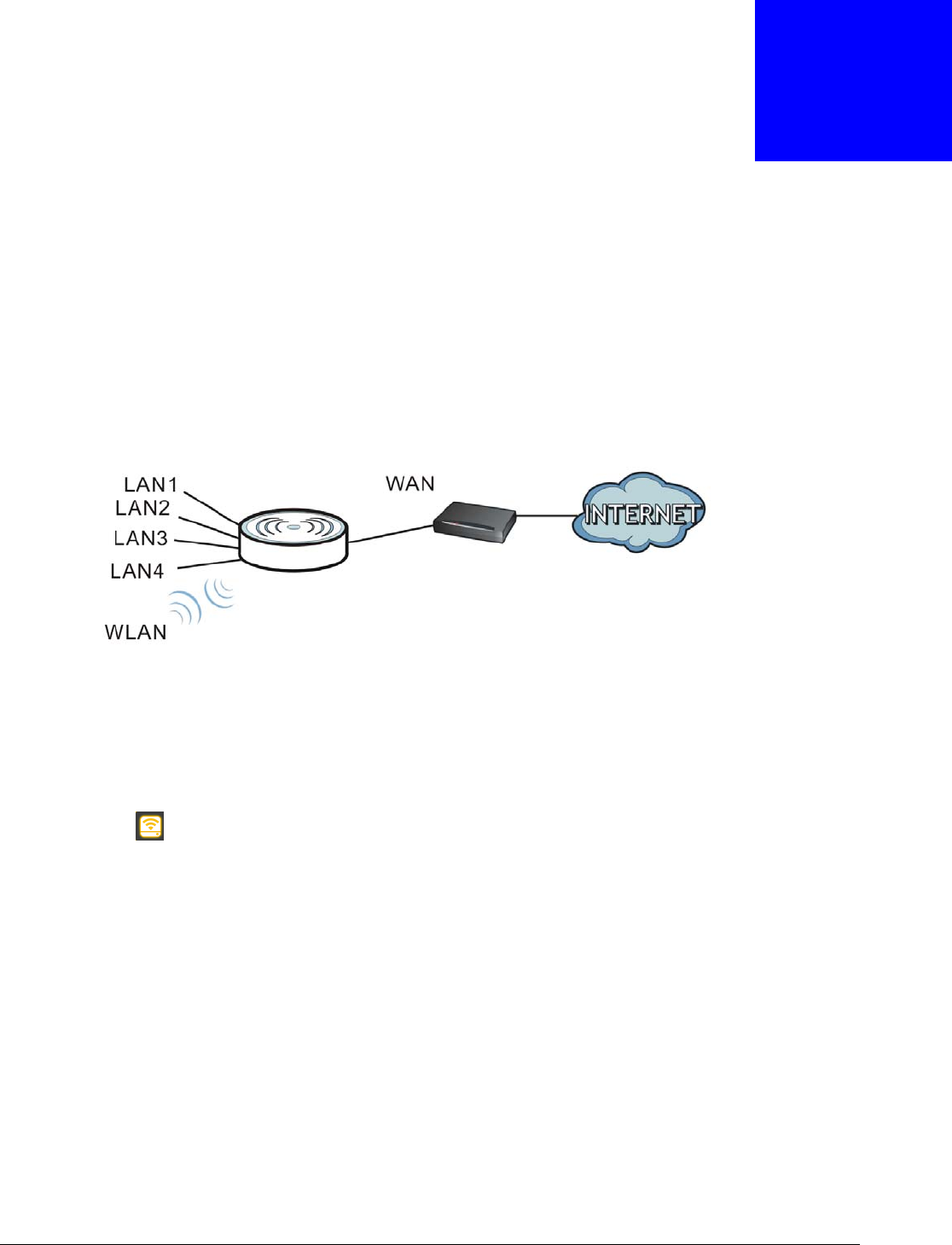
EMG2926-Q10A User’s Guide
43
CHAPTER 6
Router Mode
6.1 Overview
The EMG2926-Q10A is set to router mode by default. Routers are used to connect the local network
to another network (for example, the Internet). In the figure below, the EMG2926-Q10A connects
the local network (LAN1 ~ LAN4) to the Internet.
Figure 32 EMG2926-Q10A Network
Note: The Status screen is shown after changing to the Expert Mode of the Web
Configurator. It varies depending on the device mode of your EMG2926-Q10A.
6.2 Router Mode Status Screen
Click to open the status screen.
Modem
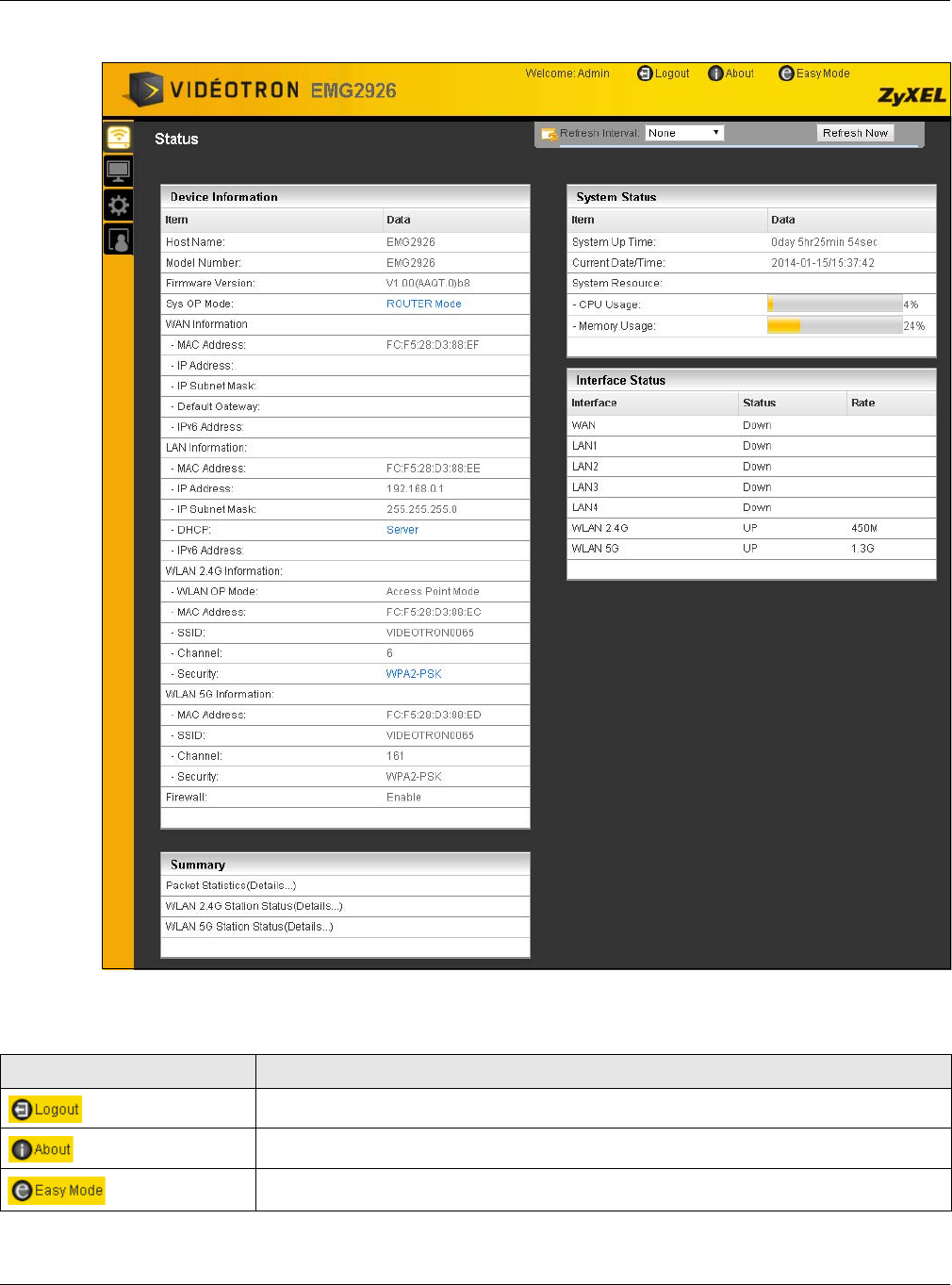
Chapter 6 Router Mode
EMG2926-Q10A User’s Guide
44
Figure 33 Status Screen: Router Mode
The following table describes the icons shown in the Status screen.
Table 19 Status Screen Icon Key
ICON DESCRIPTION
Click this at any time to exit the Web Configurator.
Click this icon to view copyright and a link for related product information.
Click this icon to go to Easy Mode. See Chapter 5 on page 32.
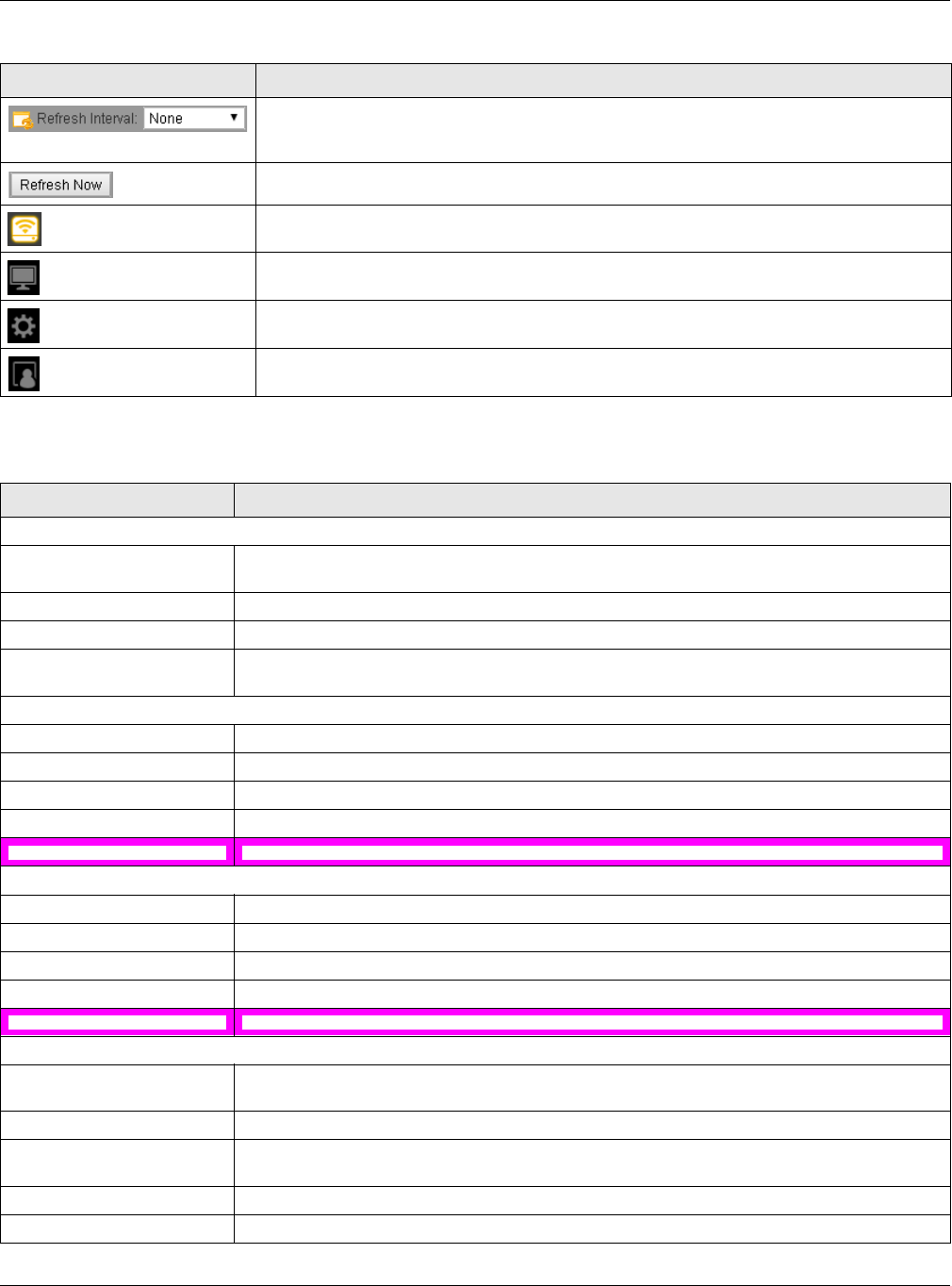
Chapter 6 Router Mode
EMG2926-Q10A User’s Guide
45
The following table describes the labels shown in the Status screen.
Select a number of seconds or None from the drop-down list box to refresh all screen
statistics automatically at the end of every time interval or to not refresh the screen
statistics.
Click this button to refresh the status screen statistics.
Click this icon to see the Status page. The information in this screen depends on the
device mode you select.
Click this icon to see the Monitor navigation menu.
Click this icon to see the Configuration navigation menu.
Click this icon to see the Maintenance navigation menu.
Table 19 Status Screen Icon Key (continued)
ICON DESCRIPTION
Table 20 Status Screen: Router Mode
LABEL DESCRIPTION
Device Information
Host Name This is the System Name you enter in the Maintenance > General screen. It is for
identification purposes.
Model Number This is the model name of your device.
Firmware Version This is the firmware version and the date created.
Sys OP Mode This is the device mode (Section 4.1.2 on page 31) to which the EMG2926-Q10A is set -
Router Mode.
WAN Information
MAC Address This shows the WAN Ethernet adapter MAC Address of your device.
IP Address This shows the WAN port’s IP address.
IP Subnet Mask This shows the WAN port’s subnet mask.
Default Gateway This shows the WAN port’s gateway IP address.
IPv6 Address This shows the IPv6 address of the EMG2926-Q10A on the WAN.
LAN Information
MAC Address This shows the LAN Ethernet adapter MAC Address of your device.
IP Address This shows the LAN port’s IP address.
IP Subnet Mask This shows the LAN port’s subnet mask.
DHCP This shows the LAN port’s DHCP role - Server or Disable.
IPv6 Address This shows the IPv6 address of the EMG2926-Q10A on the LAN.
WLAN 2.4G Information
WLAN OP Mode This is the device mode (Section 4.1.2 on page 31) to which the EMG2926-Q10A’s wireless
LAN is set - Access Point Mode.
MAC Address This shows the 2.4GHz wireless adapter MAC Address of your device.
SSID This shows a descriptive name used to identify the EMG2926-Q10A in the 2.4GHz wireless
LAN.
Channel This shows the channel number which you select manually.
Security This shows the level of wireless security the EMG2926-Q10A is using.

Chapter 6 Router Mode
EMG2926-Q10A User’s Guide
46
6.2.1 Navigation Panel
Use the sub-menus on the navigation panel to configure EMG2926-Q10A features.
WLAN 5G Information
MAC Address This shows the 5GHz wireless adapter MAC Address of your device.
SSID This shows a descriptive name used to identify the EMG2926-Q10A in the 5GHz wireless
LAN.
Channel This shows the channel number which you select manually.
Security This shows the level of wireless security the EMG2926-Q10A is using.
Firewall This shows whether the firewall is enabled or not.
Summary
Packet Statistics Click Details... to go to the Monitor > Packet Statistics screen (Section 9.5 on page 72).
Use this screen to view port status and packet specific statistics.
WLAN 2.4G Station
Status Click Details... to go to the Monitor > WLAN 2.4G Station Status screen (Section 9.6 on
page 73). Use this screen to view the wireless stations that are currently associated to the
EMG2926-Q10A’s 2.4GHz wireless LAN.
WLAN 5G Station Status Click Details... to go to the Monitor > WLAN 5G Station Status screen (Section 9.6 on
page 73). Use this screen to view the wireless stations that are currently associated to the
EMG2926-Q10A’s 5GHz wireless LAN.
System Status
Item This column shows the type of data the EMG2926-Q10A is recording.
Data This column shows the actual data recorded by the EMG2926-Q10A.
System Up Time This is the total time the EMG2926-Q10A has been on.
Current Date/Time This field displays your EMG2926-Q10A’s present date and time.
System Resource
- CPU Usage This displays what percentage of the EMG2926-Q10A’s processing ability is currently used.
When this percentage is close to 100%, the EMG2926-Q10A is running at full load, and the
throughput is not going to improve anymore. If you want some applications to have more
throughput, you should turn off other applications (for example, using bandwidth
management.)
- Memory Usage This shows what percentage of the heap memory the EMG2926-Q10A is using.
Interface Status
Interface This displays the EMG2926-Q10A port types. The port types are: WAN, LAN and WLAN.
Status For the LAN and WAN ports, this field displays Down (line is down) or Up (line is up or
connected).
For the 2.4GHz/5GHz WLAN, it displays Up when the 2.4GHz/5GHz WLAN is enabled or
Down when the 2.4G/5G WLAN is disabled.
Rate For the LAN ports, this displays the port speed and duplex setting or N/A when the line is
disconnected.
For the WAN port, it displays the port speed and duplex setting if you’re using Ethernet
encapsulation. This field displays N/A when the line is disconnected.
For the 2.4GHz/5GHz WLAN, it displays the maximum transmission rate when the 2.4GHz/
5GHz WLAN is enabled and N/A when the WLAN is disabled.
Table 20 Status Screen: Router Mode (continued)
LABEL DESCRIPTION
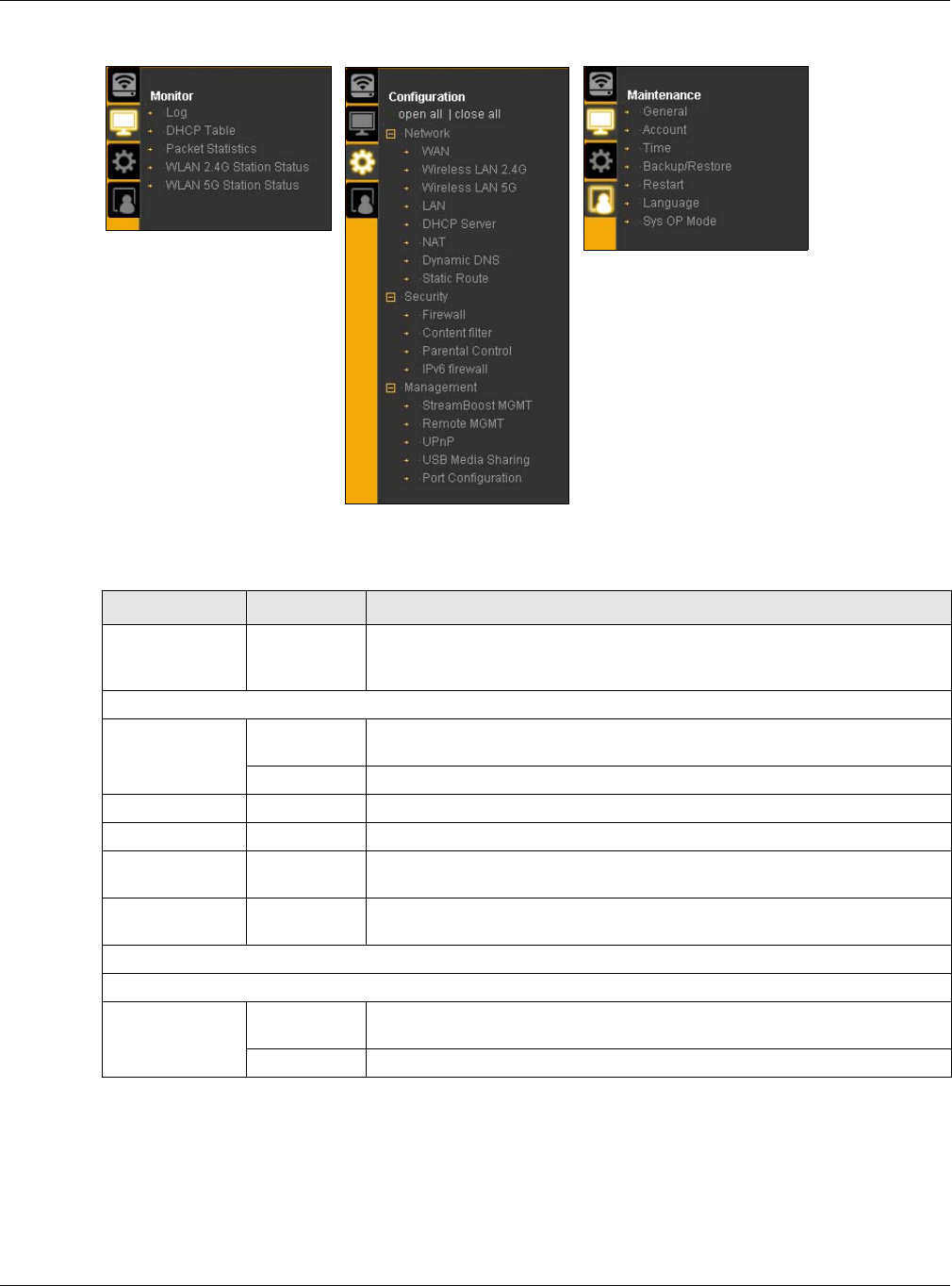
Chapter 6 Router Mode
EMG2926-Q10A User’s Guide
47
Figure 34 Navigation Panel: Router Mode
The following table describes the sub-menus.
Table 21 Navigation Panel: Router Mode
LINK TAB FUNCTION
Status This screen shows the EMG2926-Q10A’s general device, system and
interface status information. Use this screen to access summary statistics
tables.
MONITOR
Log View Log Use this screen to view the list of activities recorded by your EMG2926-
Q10A.
Log Setting Use this screen to select the logs you wish to display.
DHCP Table Use this screen to view current DHCP client information.
Packet Statistics Use this screen to view port status and packet specific statistics.
WLAN 2.4G
Station Status
Association
List
Use this screen to view the wireless stations that are currently associated
to the EMG2926-Q10A’s 2.4GHz wireless LAN.
WLAN 5G
Station Status
Association
List
Use this screen to view the wireless stations that are currently associated
to the EMG2926-Q10A’s 5GHz wireless LAN.
CONFIGURATION
Network
WAN Internet
Connection
This screen allows you to configure ISP parameters, WAN IP address
assignment, DNS servers and the WAN MAC address.
Advanced Use this screen to configure other advanced properties.
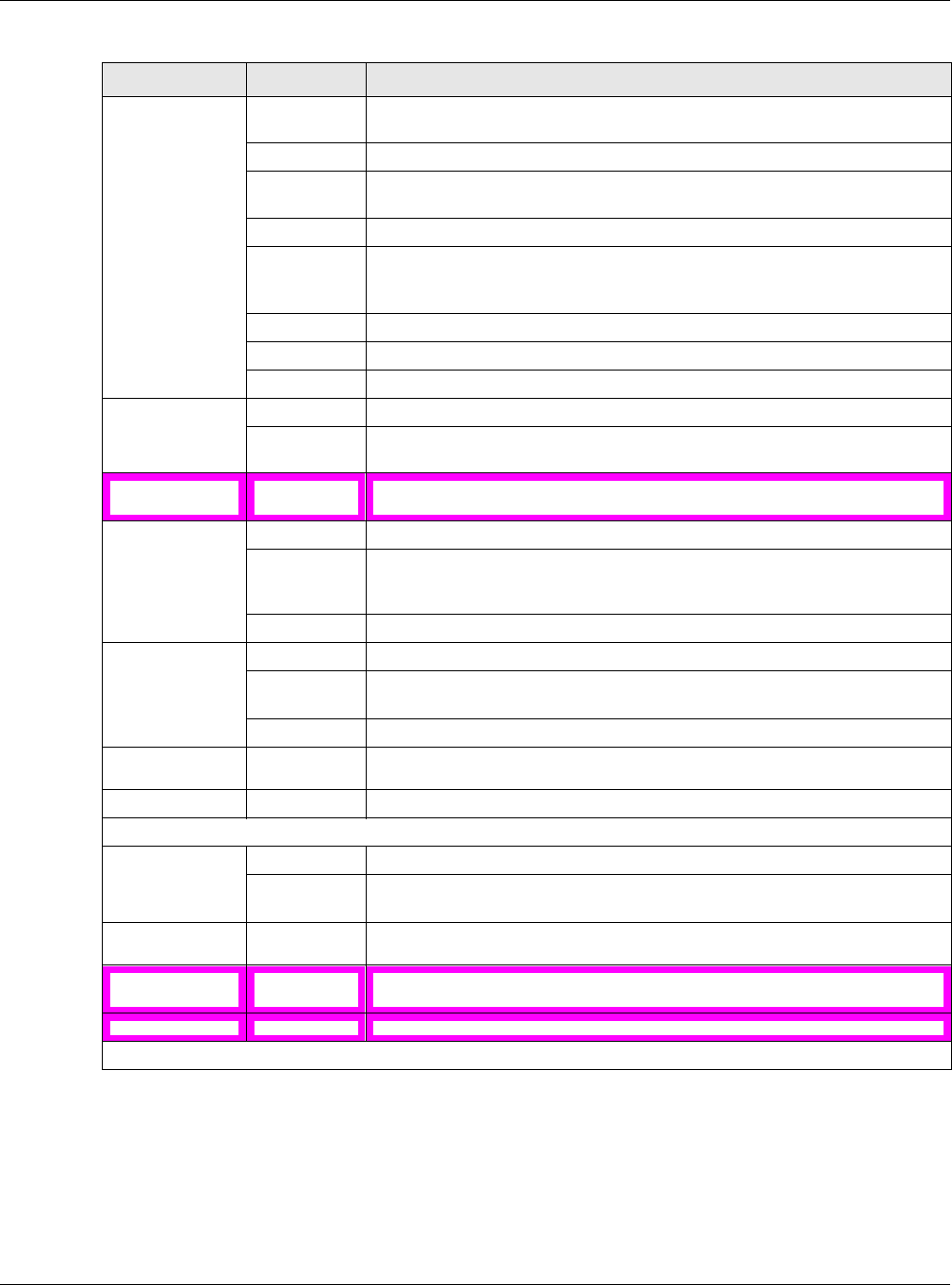
Chapter 6 Router Mode
EMG2926-Q10A User’s Guide
48
Wireless LAN
2.4G/5G General Use this screen to enable the wireless LAN and configure wireless LAN and
wireless security settings.
More AP Use this screen to configure multiple BSSs on the EMG2926-Q10A.
MAC Filter Use the MAC filter screen to configure the EMG2926-Q10A to block access
to devices or block the devices from accessing the EMG2926-Q10A.
Advanced This screen allows you to configure advanced wireless settings.
QoS Use this screen to configure Wi-Fi Multimedia Quality of Service (WMM
QoS). WMM QoS allows you to prioritize wireless traffic according to the
delivery requirements of individual services.
WPS Use this screen to configure WPS.
WPS Station Use this screen to add a wireless station using WPS.
Scheduling Use this screen to schedule the times the Wireless LAN is enabled.
LAN IP Use this screen to configure LAN IP address and subnet mask.
IP Alias Use this screen to have the EMG2926-Q10A apply IP alias to create LAN
subnets.
IPv6 LAN Use this screen to configure the IPv6 address for the EMG2926-Q10A on
the LAN.
DHCP Server General Use this screen to enable the EMG2926-Q10A’s DHCP server.
Advanced Use this screen to assign IP addresses to specific individual computers
based on their MAC addresses and to have DNS servers assigned by the
DHCP server.
Client List Use this screen to view information related to your DHCP status.
NAT General Use this screen to enable NAT.
Port
Forwarding
Use this screen to configure servers behind the EMG2926-Q10A and
forward incoming service requests to the server(s) on your local network.
Port Trigger Use this screen to change your EMG2926-Q10A’s port triggering settings.
Dynamic
DNS Dynamic DNS Use this screen to set up dynamic DNS.
Static Route Static Route Use this screen to configure IP static routes.
Security
Firewall General Use this screen to activate/deactivate the firewall.
Services This screen shows a summary of the IPv4 firewall rules, and allows you to
edit/add an IPv4 firewall rule.
Content
Filter Content Filter Use this screen to restrict web features and designate a trusted computer.
Parental
Control Use this screen to block certain web features and sites containing certain
keywords in the URL.
IPv6 firewall Services Use this screen to configure IPv6 firewall rules.
Management
Table 21 Navigation Panel: Router Mode (continued)
LINK TAB FUNCTION
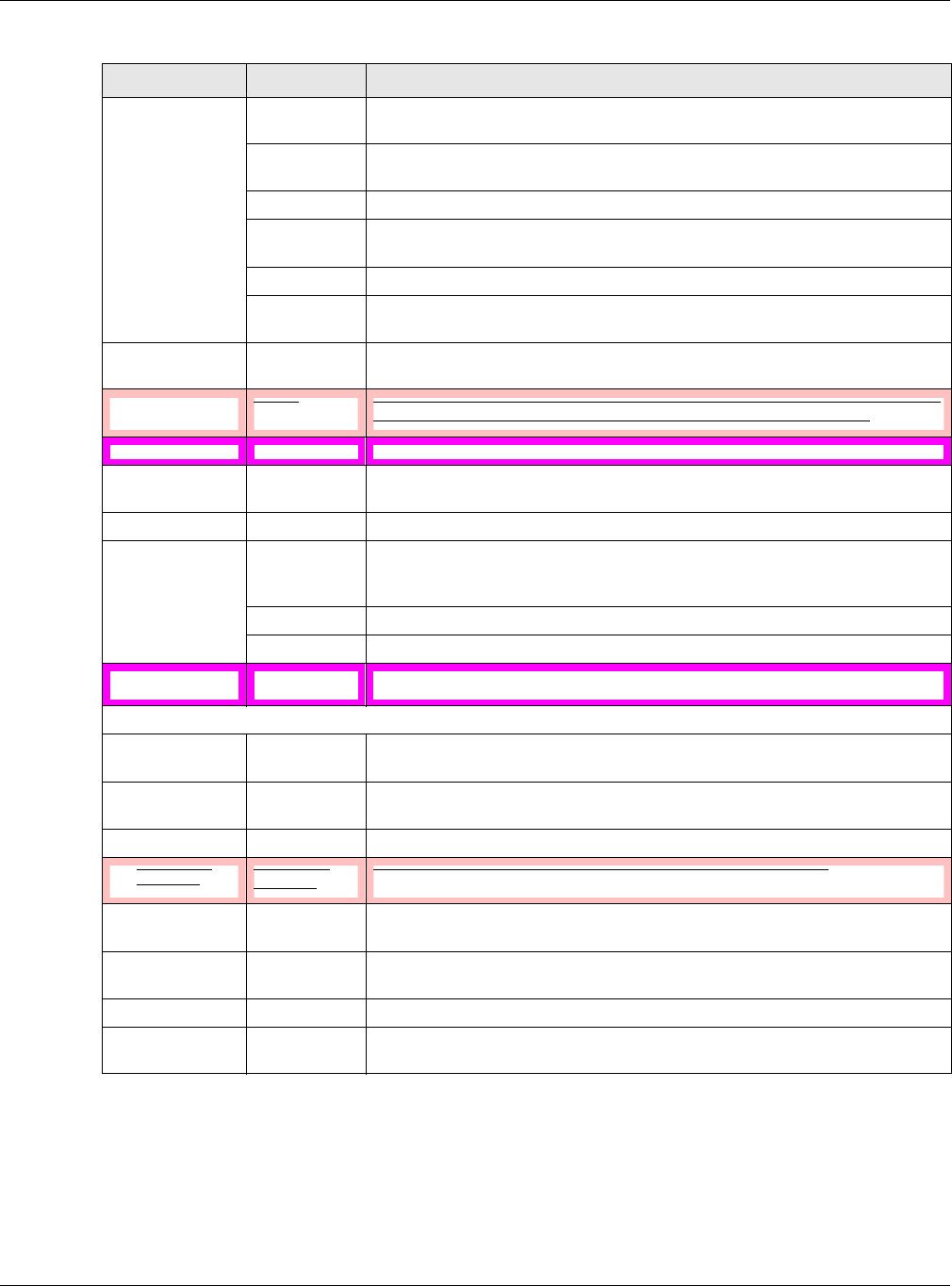
Chapter 6 Router Mode
EMG2926-Q10A User’s Guide
49
Streamboost
Management Network Use this screen to view transmission data rates between the EMG2926-
Q10A and the Internet or conencted devices.
Bandwidth Use this screen to configure the maximum allowable bandwidth and enable
automatic update.
Priorities Use this screen to change the priority of the conencted devices.
Up Time Use this screen to view the top five traffic flows transmitting from/to the
selected LAN device(s).
Downloads Use this screen to view the type and percentage of most download traffic.
All Events Use this screen to view the time at which a traffic flow is given bandwidth
for optimal, good or best-effort performance.
Remote
Management WWW Use this screen to configure through which interface(s) and from which IP
address(es) users can use HTTP to manage the EMG2926-Q10A.
Telnet Use this screen to configure through which interface(s) and from which IP
address(es) users can use Telnet to manage the EMG2926-Q10A.
SNMP Use this screen to change your EMG2926-Q10A’s SNMP settings.
Wake On LAN Use this screen to enable Wake on LAN to remotely turn on a device on the
local network.
UPnP General Use this screen to enable UPnP on the EMG2926-Q10A.
USB Media
Sharing DLNA Use this screen to have the EMG2926-Q10A function as a DLNA-compliant
media server, that lets DLNA-compliant media clients play video, audio, and
photo content files stored on the connected USB storage device.
SAMBA Use this screen to enable file sharing through the EMG2926-Q10A.
FTP Use this screen to have the EMG2926-Q10A act as a FTP server.
Port
Configuration Use this screen to change the Ethernet port speed and duplex settings.
MAINTENANCE
General General Use this screen to view and change administrative settings such as system
and domain names.
Account Account
Setup
Use this screen to change the password of your EMG2926-Q10A.
Time Time Setting Use this screen to change your EMG2926-Q10A’s time and date.
Firmware
Upgrade Firmware
Upgrade
Use this screen to upload firmware to your EMG2926-Q10A.
Backup/
Restore Backup/
Restore
Use this screen to backup and restore the configuration or reset the factory
defaults to your EMG2926-Q10A.
Restart System
Restart
This screen allows you to reboot the EMG2926-Q10A without turning the
power off.
Language Language This screen allows you to select the language you prefer.
Sys OP Mode Sys OP Mode This screen allows you to select whether your device acts as a router, or an
access point.
Table 21 Navigation Panel: Router Mode (continued)
LINK TAB FUNCTION
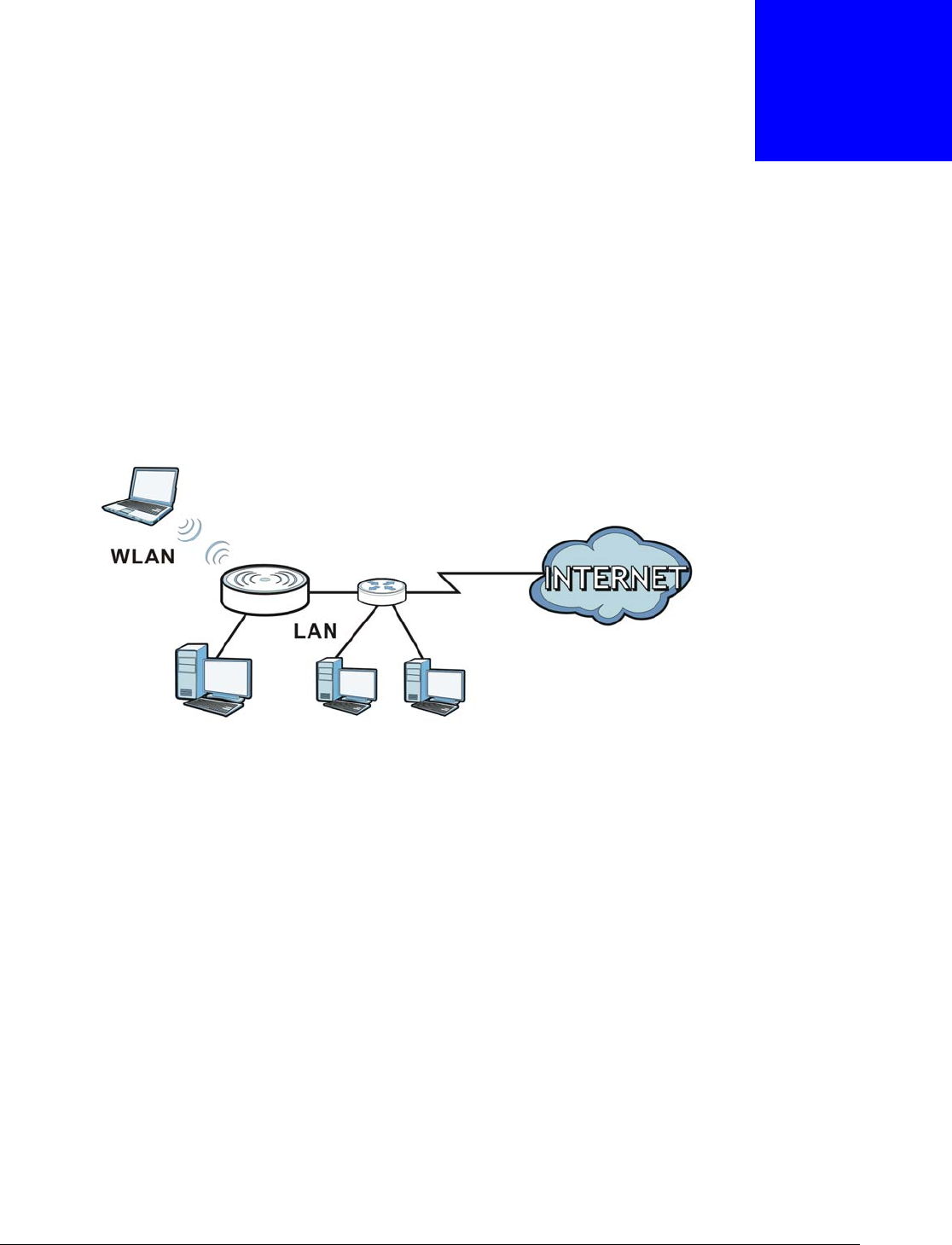
EMG2926-Q10A User’s Guide
50
CHAPTER 7
Access Point Mode
7.1 Overview
Use your EMG2926-Q10A as an access point (AP) if you already have a router or gateway on your
network. In this mode your EMG2926-Q10A bridges a wired network (LAN) and wireless LAN
(WLAN) in the same subnet. See the figure below for an example.
Figure 35 Wireless Internet Access in Access Point Mode
Many screens that are available in Router Mode are not available in Access Point Mode, such as
NAT and firewall.
Note: See Chapter 8 on page 57 for an example of setting up a wireless network in
Access Point mode.
7.2 What You Can Do
•Use the Status screen to view read-only information about your EMG2926-Q10A (Section 7.4 on
page 52).
•Use the LAN screen to set the IP address for your EMG2926-Q10A acting as an access point
(Section 7.5 on page 54).
7.3 What You Need to Know
See Chapter 8 on page 57 for a tutorial on setting up a network with the EMG2926-Q10A as an
access point.
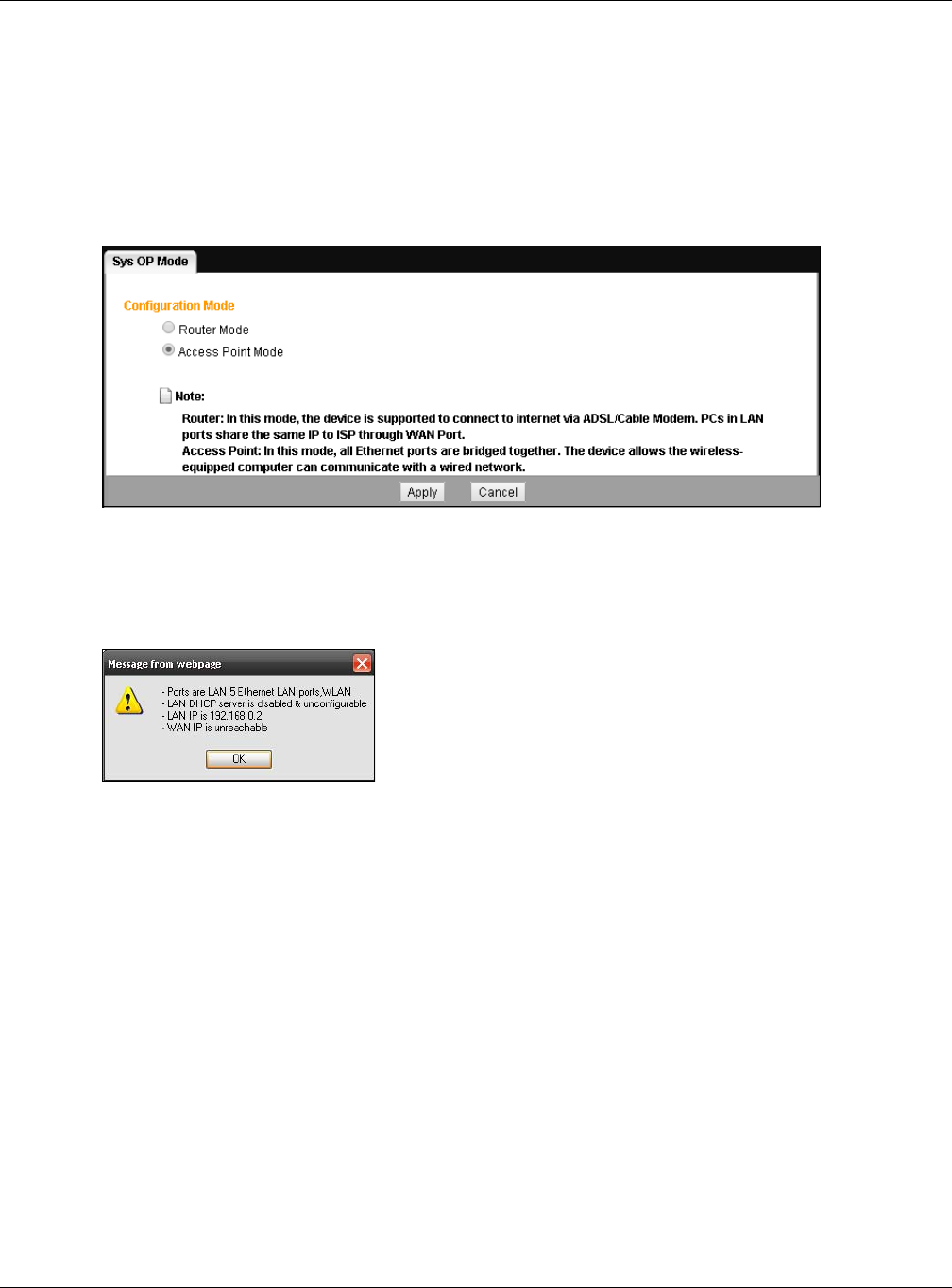
Chapter 7 Access Point Mode
EMG2926-Q10A User’s Guide
51
7.3.1 Setting your EMG2926-Q10A to AP Mode
1Log into the Web Configurator if you haven’t already. See the Quick start Guide for instructions on
how to do this.
2To use your EMG2926-Q10A as an access point, go to Maintenance > Sys OP Mode and select
Access Point Mode.
Figure 36 Changing to Access Point mode
Note: You have to log in to the Web Configurator again when you change modes. As soon
as you do, your EMG2926-Q10A is already in Access Point mode.
3When you select Access Point Mode, the following pop-up message window appears.
Figure 37 Pop up for Access Point mode
Click OK. Then click Apply. The Web Configurator refreshes once the change to Access Point mode
is successful.
7.3.2 Accessing the Web Configurator in Access Point Mode
Log in to the Web Configurator in Access Point mode, do the following:
1Connect your computer to the LAN port of the EMG2926-Q10A.
2The default IP address of the EMG2926-Q10A is “192.168.0.2”. In this case, your computer must
have an IP address in the range between “192.168.0.3” and “192.168.0.254”.
3Click Start > Run on your computer in Windows. Type “cmd” in the dialog box. Enter “ipconfig” to
show your computer’s IP address. If your computer’s IP address is not in the correct range then see
Appendix B on page 193 for information on changing your computer’s IP address.
4After you’ve set your computer’s IP address, open a web browser such as Internet Explorer and
type “192.168.0.2” as the web address in your web browser.
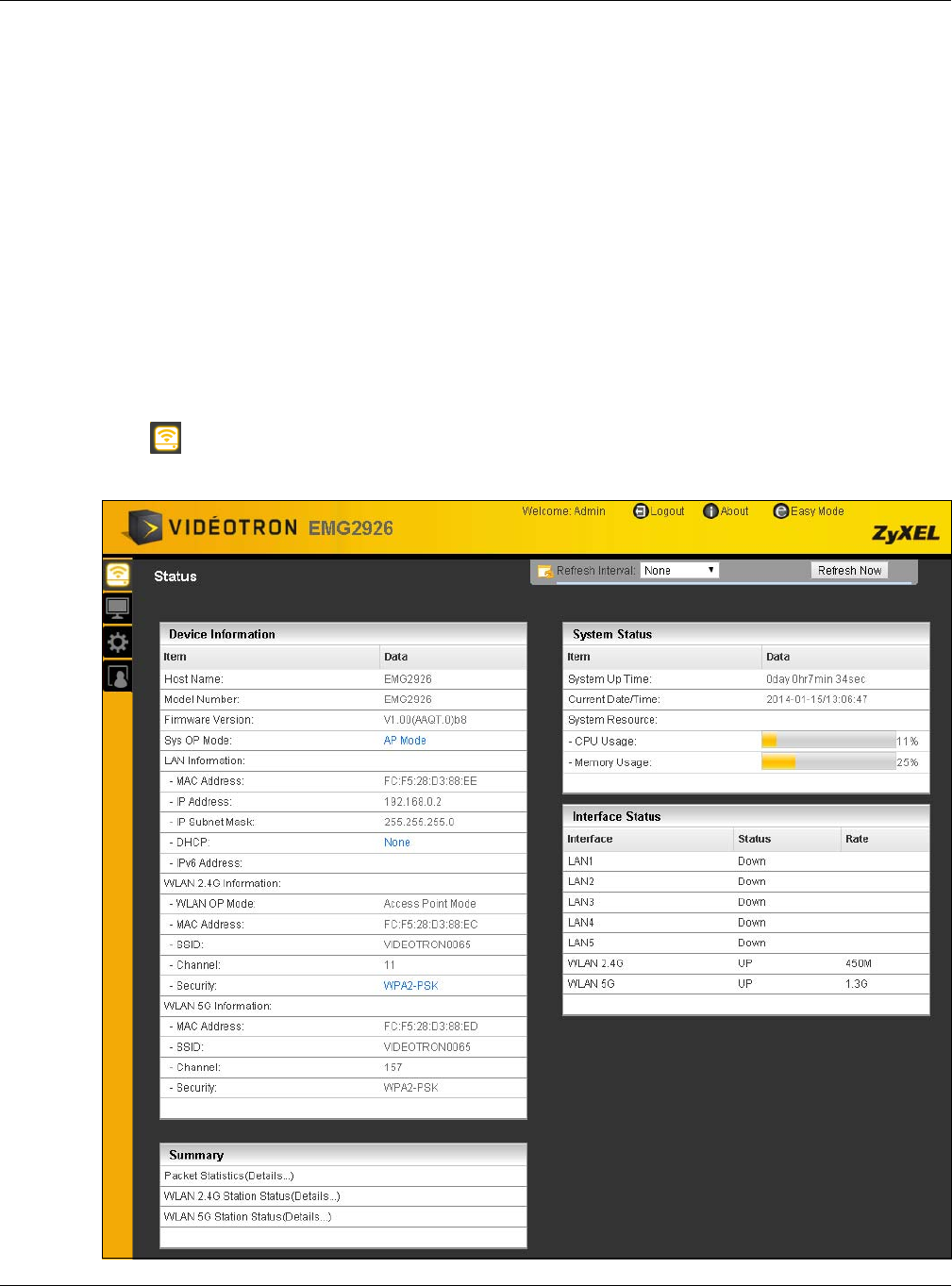
Chapter 7 Access Point Mode
EMG2926-Q10A User’s Guide
52
Note: After clicking Login, the Easy Mode appears. Refer to Section on page 32 for the
Easy Mode screens. Change to Expert Mode to see the screens described in the
sections following this.
7.3.3 Configuring your WLAN and Maintenance Settings
The configuration of wireless and maintenance settings in Access Point Mode is the same as for
Router Mode.
•See Chapter 11 on page 86 for information on the configuring your wireless network.
•See Chapter 26 on page 179 for information on configuring your Maintenance settings.
7.4 AP Mode Status Screen
Click to open the Status screen.
Figure 38 Status Screen: Access Point Mode
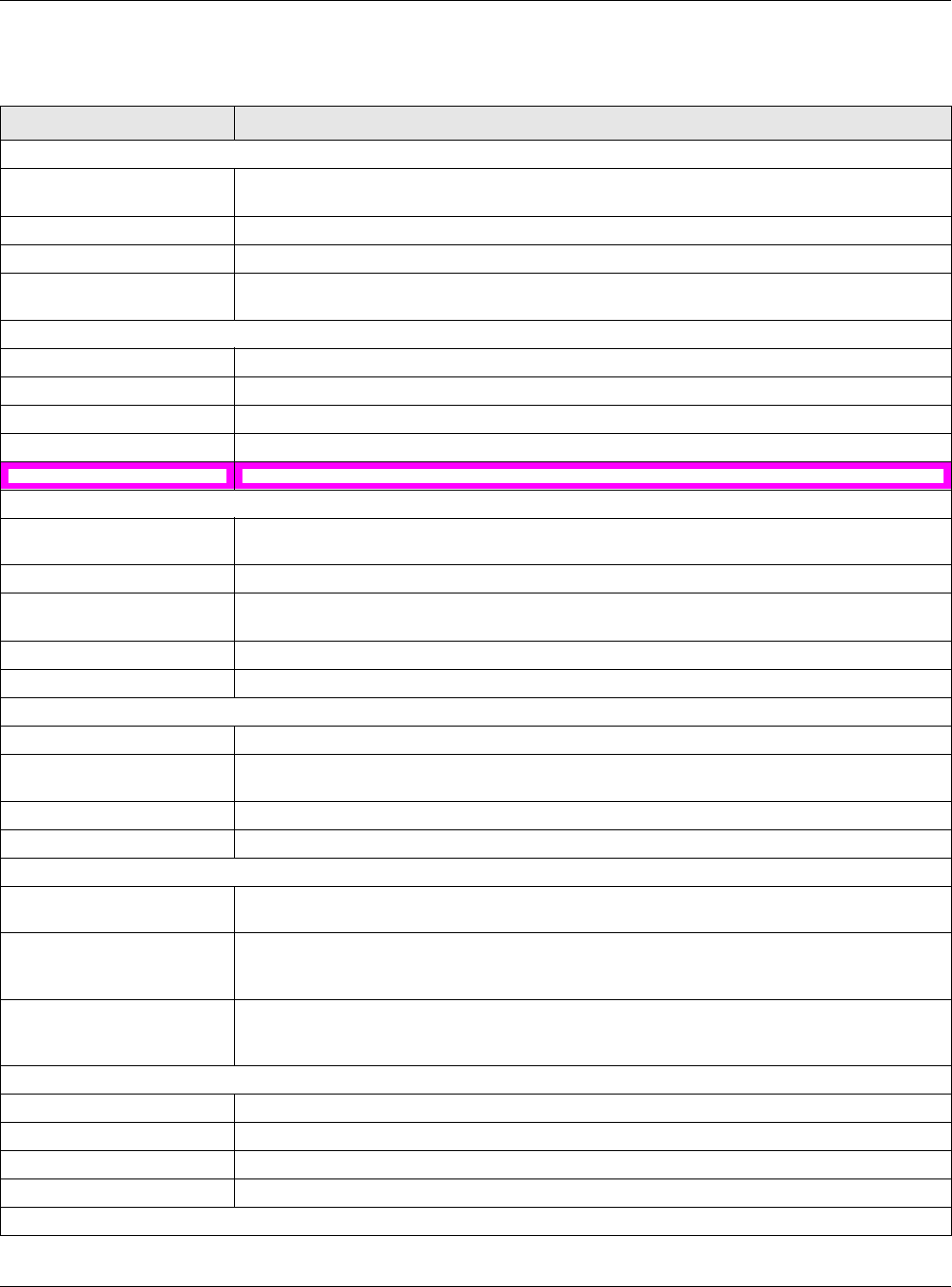
Chapter 7 Access Point Mode
EMG2926-Q10A User’s Guide
53
The following table describes the labels shown in the Status screen.
Table 22 Status Screen: Access Point Mode
LABEL DESCRIPTION
Device Information
Host Name This is the System Name you enter in the Maintenance > General screen. It is for
identification purposes.
Model Number This is the model name of your device.
Firmware Version This is the firmware version and the date created.
Sys OP Mode This is the device mode (Section 4.1.2 on page 31) to which the EMG2926-Q10A is set - AP
Mode.
LAN Information
MAC Address This shows the LAN Ethernet adapter MAC Address of your device.
IP Address This shows the LAN port’s IP address.
IP Subnet Mask This shows the LAN port’s subnet mask.
DHCP This shows the LAN port’s DHCP role - Client or None.
IPv6 Address This shows the IPv6 address of the EMG2926-Q10A on the LAN.
WLAN 2.4G Information
WLAN OP Mode This is the device mode (Section 4.1.2 on page 31) to which the EMG2926-Q10A’s wireless
LAN is set - Access Point Mode.
MAC Address This shows the 2.4GHz wireless adapter MAC Address of your device.
SSID This shows a descriptive name used to identify the EMG2926-Q10A in the 2.4GHz wireless
LAN.
Channel This shows the channel number which you select manually.
Security This shows the level of wireless security the EMG2926-Q10A is using.
WLAN 5G Information
MAC Address This shows the 5GHz wireless adapter MAC Address of your device.
SSID This shows a descriptive name used to identify the EMG2926-Q10A in the 5GHz wireless
LAN.
Channel This shows the channel number which you select manually.
Security This shows the level of wireless security the EMG2926-Q10A is using.
Summary
Packet Statistics Click Details... to go to the Monitor > Packet Statistics screen (Section 9.5 on page 72).
Use this screen to view port status and packet specific statistics.
WLAN 2.4G Station
Status Click Details... to go to the Monitor > WLAN 2.4G Station Status screen (Section 9.6 on
page 73). Use this screen to view the wireless stations that are currently associated to the
EMG2926-Q10A’s 2.4GHz wireless LAN.
WLAN 5G Station Status Click Details... to go to the Monitor > WLAN 5G Station Status screen (Section 9.6 on
page 73). Use this screen to view the wireless stations that are currently associated to the
EMG2926-Q10A’s 5GHz wireless LAN.
System Status
Item This column shows the type of data the EMG2926-Q10A is recording.
Data This column shows the actual data recorded by the EMG2926-Q10A.
System Up Time This is the total time the EMG2926-Q10A has been on.
Current Date/Time This field displays your EMG2926-Q10A’s present date and time.
System Resource
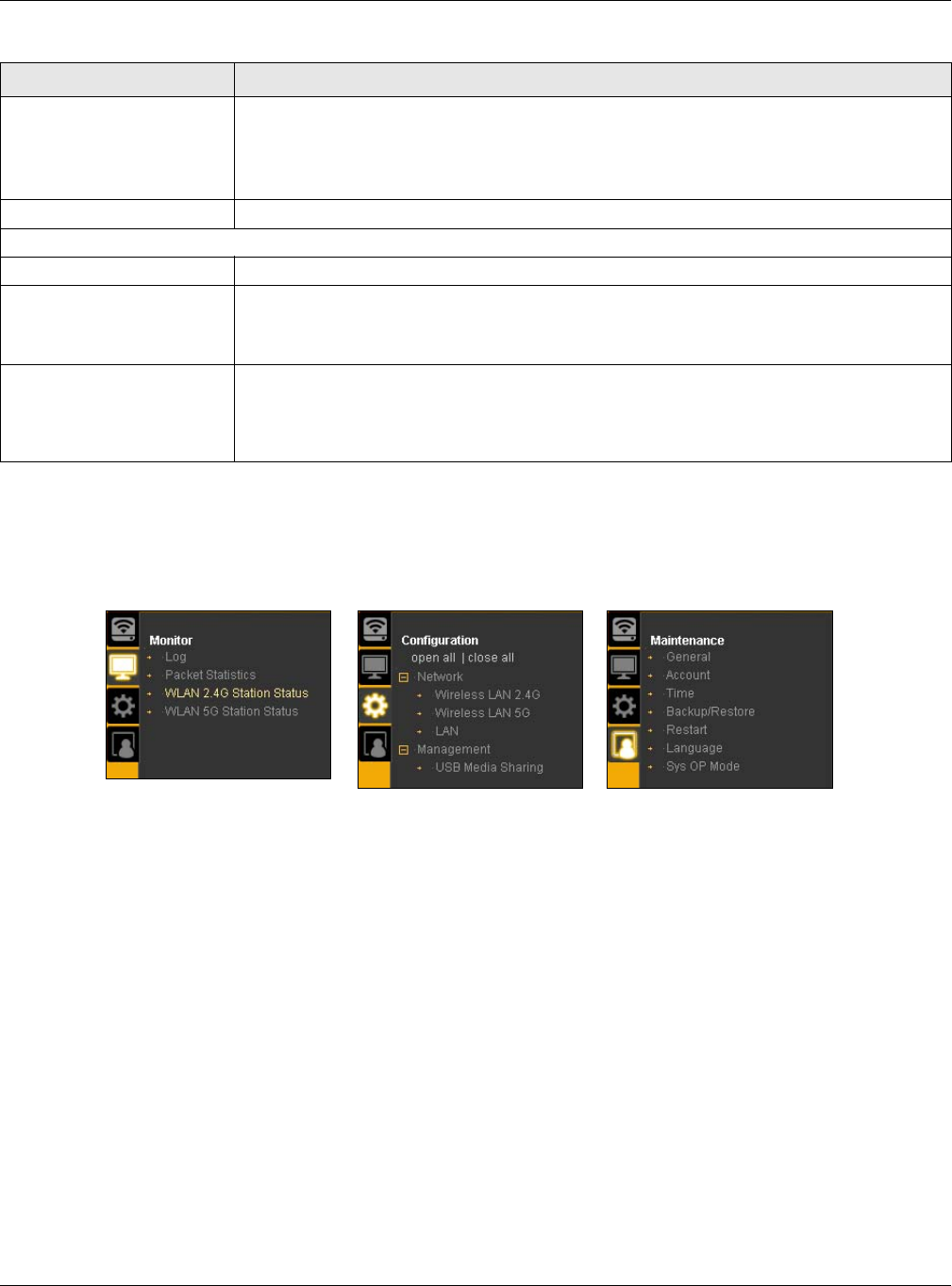
Chapter 7 Access Point Mode
EMG2926-Q10A User’s Guide
54
7.4.1 Navigation Panel
Use the menu in the navigation panel to configure EMG2926-Q10A features in Access Point Mode.
Figure 39 Menu: Access Point Mode
Refer to Table 21 on page 47 for descriptions of the labels shown in the navigation panel.
7.5 LAN Screen
Use this section to configure your LAN settings while in Access Point Mode.
Click Network > LAN to see the screen below.
Note: If you change the IP address of the EMG2926-Q10A in the screen below, you will
need to log into the EMG2926-Q10A again using the new IP address.
- CPU Usage This displays what percentage of the EMG2926-Q10A’s processing ability is currently used.
When this percentage is close to 100%, the EMG2926-Q10A is running at full load, and the
throughput is not going to improve anymore. If you want some applications to have more
throughput, you should turn off other applications (for example, using bandwidth
management.)
- Memory Usage This shows what percentage of the heap memory the EMG2926-Q10A is using.
Interface Status
Interface This displays the EMG2926-Q10A port types. The port types are: LAN and WLAN.
Status For the LAN ports, this field displays Down (line is down) or Up (line is up or connected).
For the 2.4GHz/5GHz WLAN, it displays Up when the 2.4GHz/5GHz WLAN is enabled or
Down when the 2.4G/5G WLAN is disabled.
Rate For the LAN ports, this displays the port speed and duplex setting or N/A when the line is
disconnected.
For the 2.4GHz/5GHz WLAN, it displays the maximum transmission rate when the 2.4GHz/
5GHz WLAN is enabled and N/A when the WLAN is disabled.
Table 22 Status Screen: Access Point Mode (continued)
LABEL DESCRIPTION
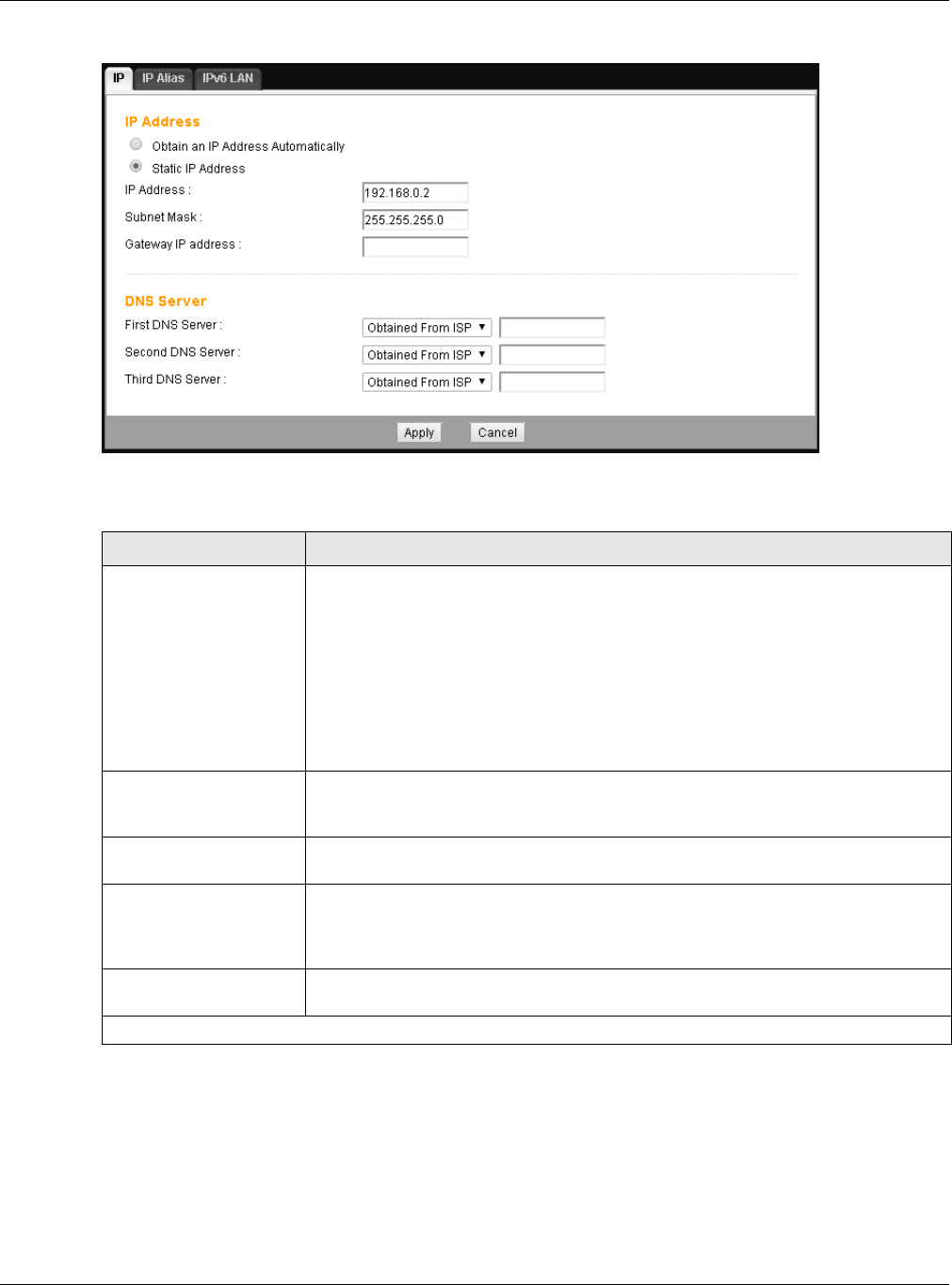
Chapter 7 Access Point Mode
EMG2926-Q10A User’s Guide
55
Figure 40 Network > LAN > IP
The table below describes the labels in the screen.
Table 23 Network > LAN > IP
LABEL DESCRIPTION
Obtain an IP Address
Automatically
When you enable this, the EMG2926-Q10A gets its IP address from the network’s
DHCP server (for example, your ISP). Users connected to the EMG2926-Q10A can
now access the network (i.e., the Internet if the IP address is given by the ISP).
The Web Configurator may no longer be accessible unless you know the IP address
assigned by the DHCP server to the EMG2926-Q10A. You need to reset the
EMG2926-Q10A to be able to access the Web Configurator again (see Section 26.7
on page 185 for details on how to reset the EMG2926-Q10A).
Also when you select this, you cannot enter an IP address for your EMG2926-Q10A
in the field below.
Static IP Address Click this if you want to specify the IP address of your EMG2926-Q10A. Or if your
ISP or network administrator gave you a static IP address to access the network or
the Internet.
IP Address Type the IP address in dotted decimal notation. The default setting is 192.168.0.2.
If you change the IP address you will have to log in again with the new IP address.
Subnet Mask The subnet mask specifies the network number portion of an IP address. Your
EMG2926-Q10A will automatically calculate the subnet mask based on the IP
address that you assign. Unless you are implementing subnetting, use the subnet
mask computed by the EMG2926-Q10A.
Gateway IP Address Enter a Gateway IP Address (if your ISP or network administrator gave you one)
in this field.
DNS Server

Chapter 7 Access Point Mode
EMG2926-Q10A User’s Guide
56
First DNS Server
Second DNS Server
Third DNS Server
Select Obtained From ISP if your ISP dynamically assigns DNS server information
(and the EMG2926-Q10A's WAN IP address). The field to the right displays the
(read-only) DNS server IP address that the ISP assigns.
Select User-Defined if you have the IP address of a DNS server. Enter the DNS
server's IP address in the field to the right. If you chose User-Defined, but leave
the IP address set to 0.0.0.0, User-Defined changes to None after you click
Apply. If you set a second choice to User-Defined, and enter the same IP
address, the second User-Defined changes to None after you click Apply.
Select None if you do not want to configure DNS servers. If you do not configure a
DNS server, you must know the IP address of a computer in order to access it.
Apply Click Apply to save your changes to the EMG2926-Q10A.
Cancel Click Cancel to reload the previous configuration for this screen.
Table 23 Network > LAN > IP (continued)
LABEL DESCRIPTION

EMG2926-Q10A User’s Guide
57
CHAPTER 8
Tutorials
8.1 Overview
This chapter provides tutorials for setting up your EMG2926-Q10A.
•Set Up a Wireless Network with WPS
•Configure Wireless Security without WPS
•Using Multiple SSIDs on the EMG2926-Q10A
8.2 Set Up a Wireless Network with WPS
This section gives you an example of how to set up wireless network using WPS. This example uses
the EMG2926-Q10A as the AP and NWD210N as the wireless client which connects to a notebook.
Note: The wireless client must be a WPS-aware device (for example, a WPS USB adapter
or PCI card).
There are two WPS methods for creating a secure connection. This tutorial shows you how to do
both.
•Push Button Configuration (PBC) - create a secure wireless network simply by pressing a
button. See Section 8.2.1 on page 57.This is the easier method.
•PIN Configuration - create a secure wireless network simply by entering a wireless client's PIN
(Personal Identification Number) in the EMG2926-Q10A’s interface. See Section 8.2.2 on page
58. This is the more secure method, since one device can authenticate the other.
8.2.1 Push Button Configuration (PBC)
1Make sure that your EMG2926-Q10A is turned on. Make sure the WIFI button (at the side panel of
the EMG2926-Q10A) is pushed in, and that the device is placed within range of your notebook.
2Make sure that you have installed the wireless client (this example uses the NWD210N) driver and
utility in your notebook.
3In the wireless client utility, find the WPS settings. Enable WPS and press the WPS button (Start or
WPS button)
4Log into EMG2926-Q10A’s Web Configurator and press the Push Button in the Configuration >
Network > Wireless LAN 2.4G > WPS Station screen.
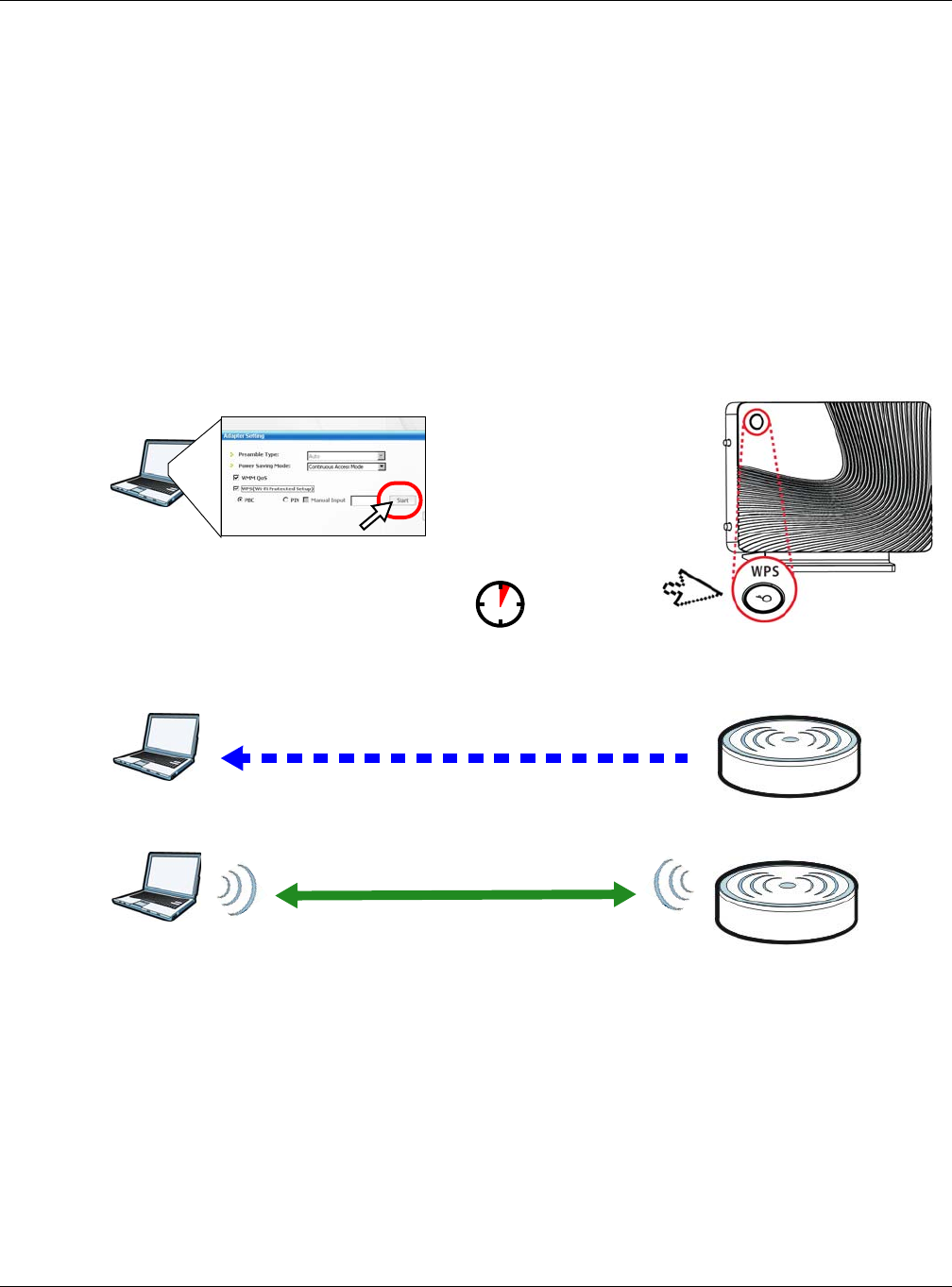
Chapter 8 Tutorials
EMG2926-Q10A User’s Guide
58
Note: Your EMG2926-Q10A has a WPS button located on its panel, as well as a WPS
button in its configuration utility. Both buttons have exactly the same function; you
can use one or the other.
Note: It doesn’t matter which button is pressed first. You must press the second button
within two minutes of pressing the first one.
The EMG2926-Q10A sends the proper configuration settings to the wireless client. This may take up
to two minutes. Then the wireless client is able to communicate with the EMG2926-Q10A securely.
The following figure shows you an example to set up wireless network and security by pressing a
button on both EMG2926-Q10A and wireless client (the NWD210N in this example).
Figure 41 Example WPS Process: PBC Method
8.2.2 PIN Configuration
When you use the PIN configuration method, you need to use both EMG2926-Q10A’s configuration
interface and the client’s utilities.
1Launch your wireless client’s configuration utility. Go to the WPS settings and select the PIN method
to get a PIN number.
2Enter the PIN number to the PIN field in the Configuration > Network > Wireless LAN 2.4G >
WPS Station screen on the EMG2926-Q10A.
Wireless Client Access Point
SECURITY INFO
COMMUNICATION
WITHIN 2 MINUTES
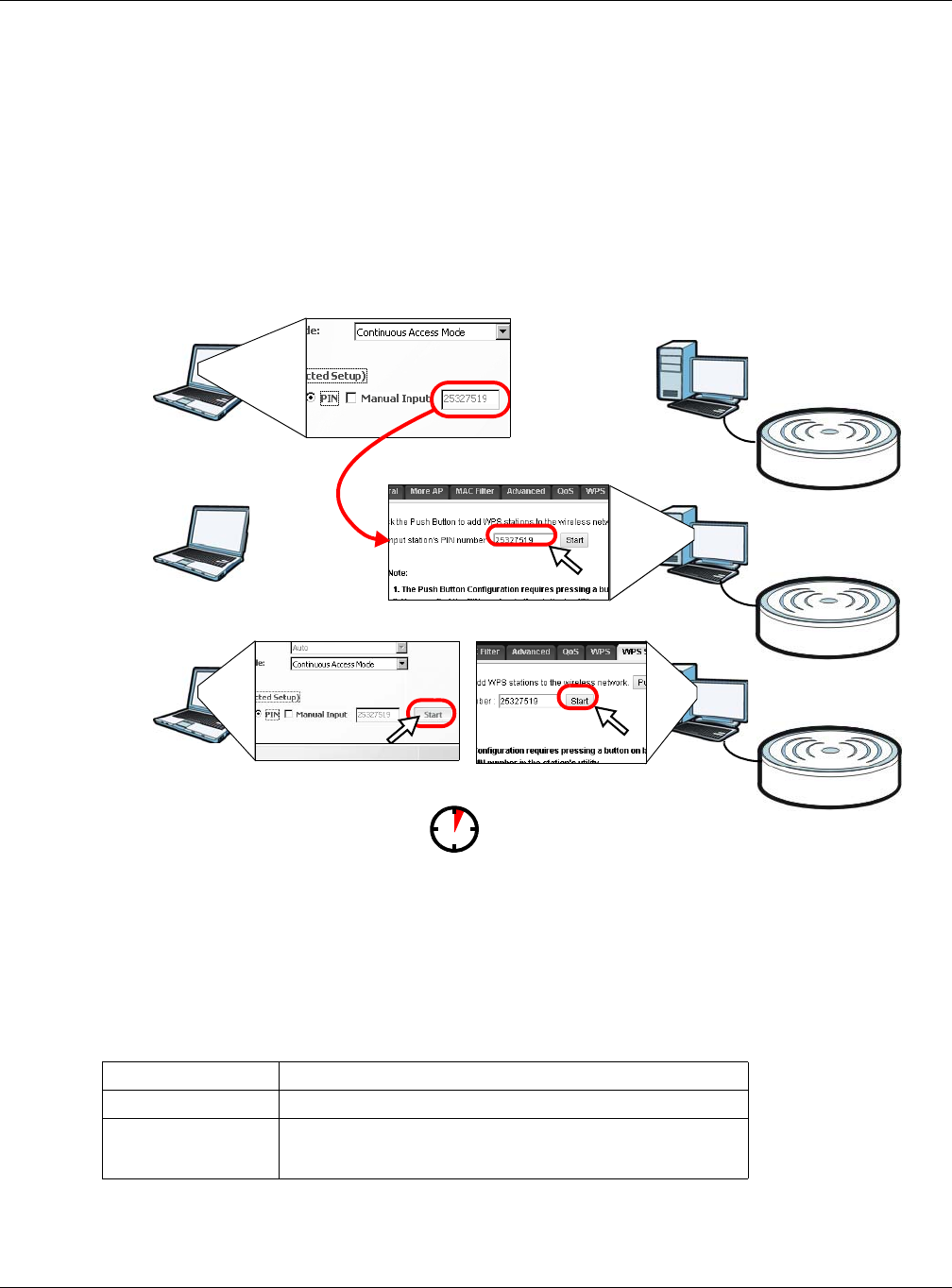
Chapter 8 Tutorials
EMG2926-Q10A User’s Guide
59
3Click Start buttons (or button next to the PIN field) on both the wireless client utility screen and the
EMG2926-Q10A’s WPS Station screen within two minutes.
The EMG2926-Q10A authenticates the wireless client and sends the proper configuration settings to
the wireless client. This may take up to two minutes. Then the wireless client is able to
communicate with the EMG2926-Q10A securely.
The following figure shows you the example to set up wireless network and security on EMG2926-
Q10A and wireless client (ex. NWD210N in this example) by using PIN method.
Figure 42 Example WPS Process: PIN Method
8.3 Configure Wireless Security without WPS
This example shows you how to configure wireless security settings with the following parameters
on your EMG2926-Q10A.
Follow the steps below to configure the wireless settings on your EMG2926-Q10A.
WITHIN 2 MINUTES
Wireless Client
Access Point
SSID SSID_Example3
Channel 6
Security WPA2-PSK
(Pre-Shared Key: ThisismyWPA-PSKpre-sharedkey)
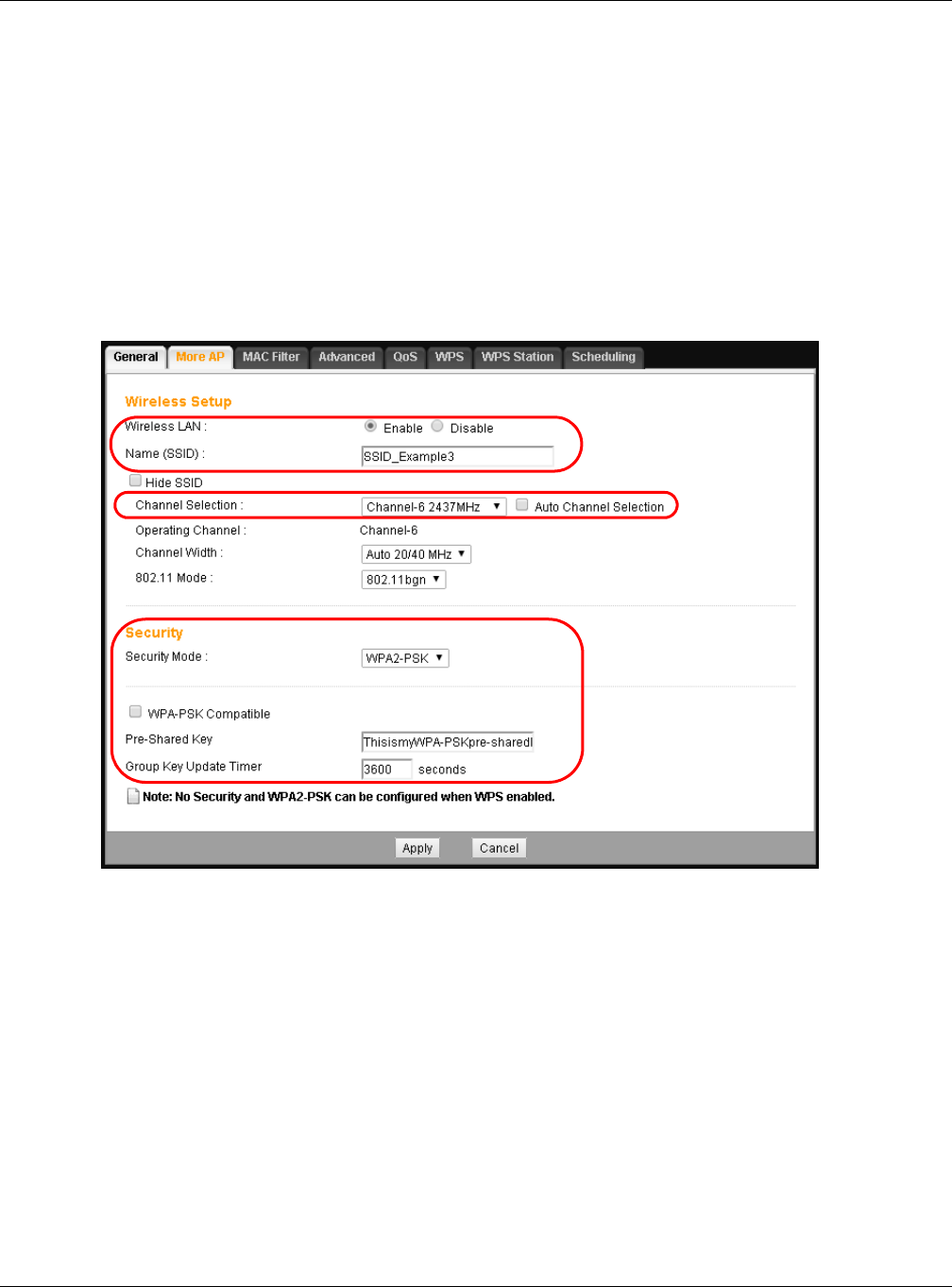
Chapter 8 Tutorials
EMG2926-Q10A User’s Guide
60
The instructions require that your hardware is connected (see the Quick Start Guide) and you are
logged into the Web Configurator through your LAN connection (see Section 3.2 on page 28).
1Make sure the WIFI switch (at the side panel of the EMG2926-Q10A) is set to ON.
2Open the Configuration > Network > Wireless LAN 2.4G > General screen in the AP’s Web
Configurator.
3Confirm that the wireless LAN is enabled on the EMG2926-Q10A.
4Enter SSID_Example3 as the SSID and select Channel-06 as the channel. Set security mode to
WPA2-PSK and enter ThisismyWPA-PSKpre-sharedkey in the Pre-Shared Key field. Click
Apply.
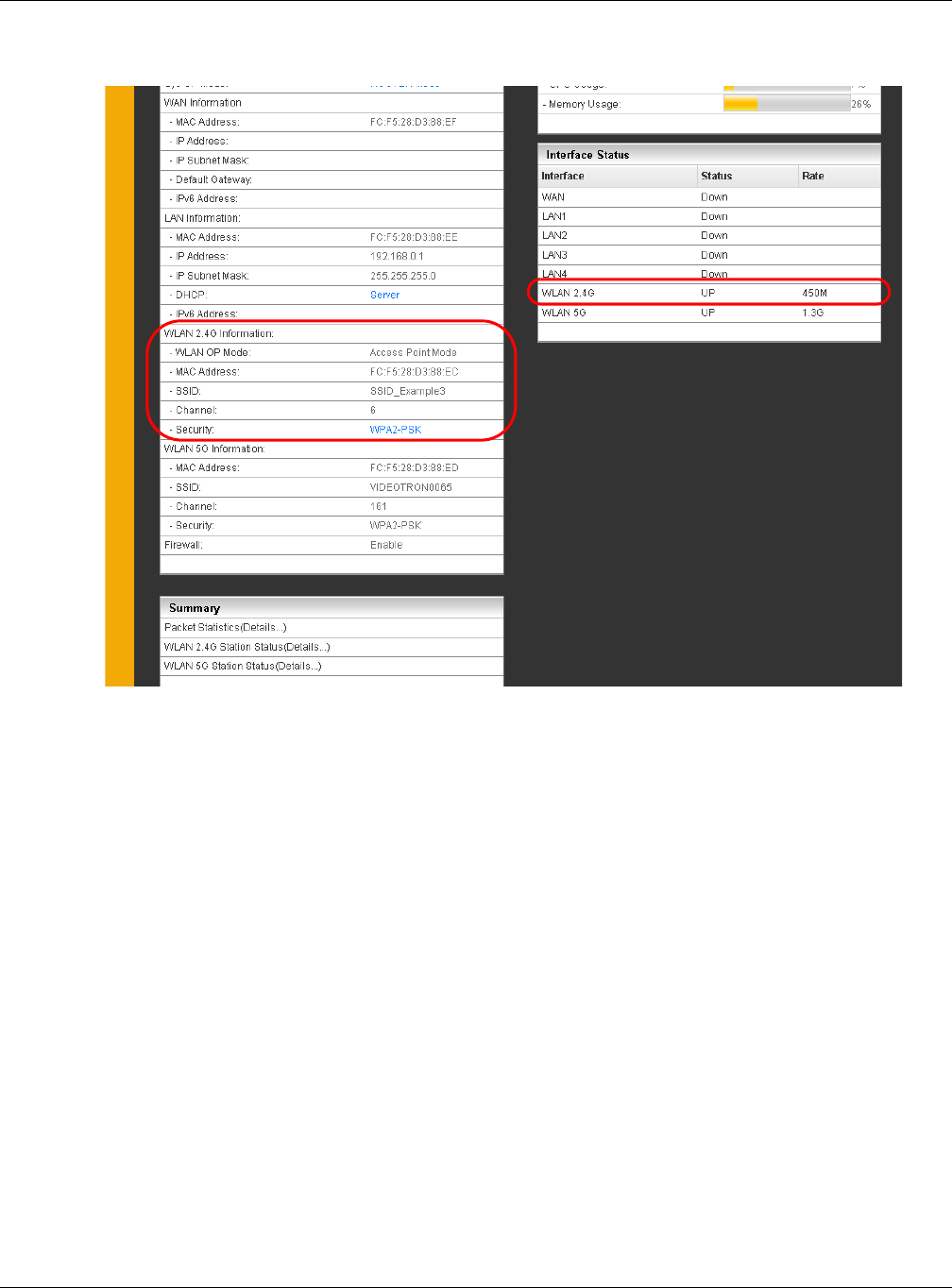
Chapter 8 Tutorials
EMG2926-Q10A User’s Guide
61
5Open the Status screen. Verify your wireless and wireless security settings under Device
Information and check if the WLAN connection is up under Interface Status.
8.3.1 Configure Your Notebook
Note: We use the ZyXEL NWD2205 wireless adapter utility screens as an example for the
wireless client. The screens may vary for different models.
1The EMG2926-Q10A supports IEEE 802.11a, IEEE 802.11b, IEEE 802.11g and IEEE 802.11n
wireless clients. Make sure that your notebook or computer’s wireless adapter supports one of
these standards.
2Wireless adapters come with software sometimes called a “utility” that you install on your
computer. See your wireless adapter’s User’s Guide for information on how to do that.
3After you’ve installed the utility, open it. If you cannot see your utility’s icon on your screen, go to
Start > Programs and click on your utility in the list of programs that appears. The utility displays
a list of APs within range, as shown in the example screen below.
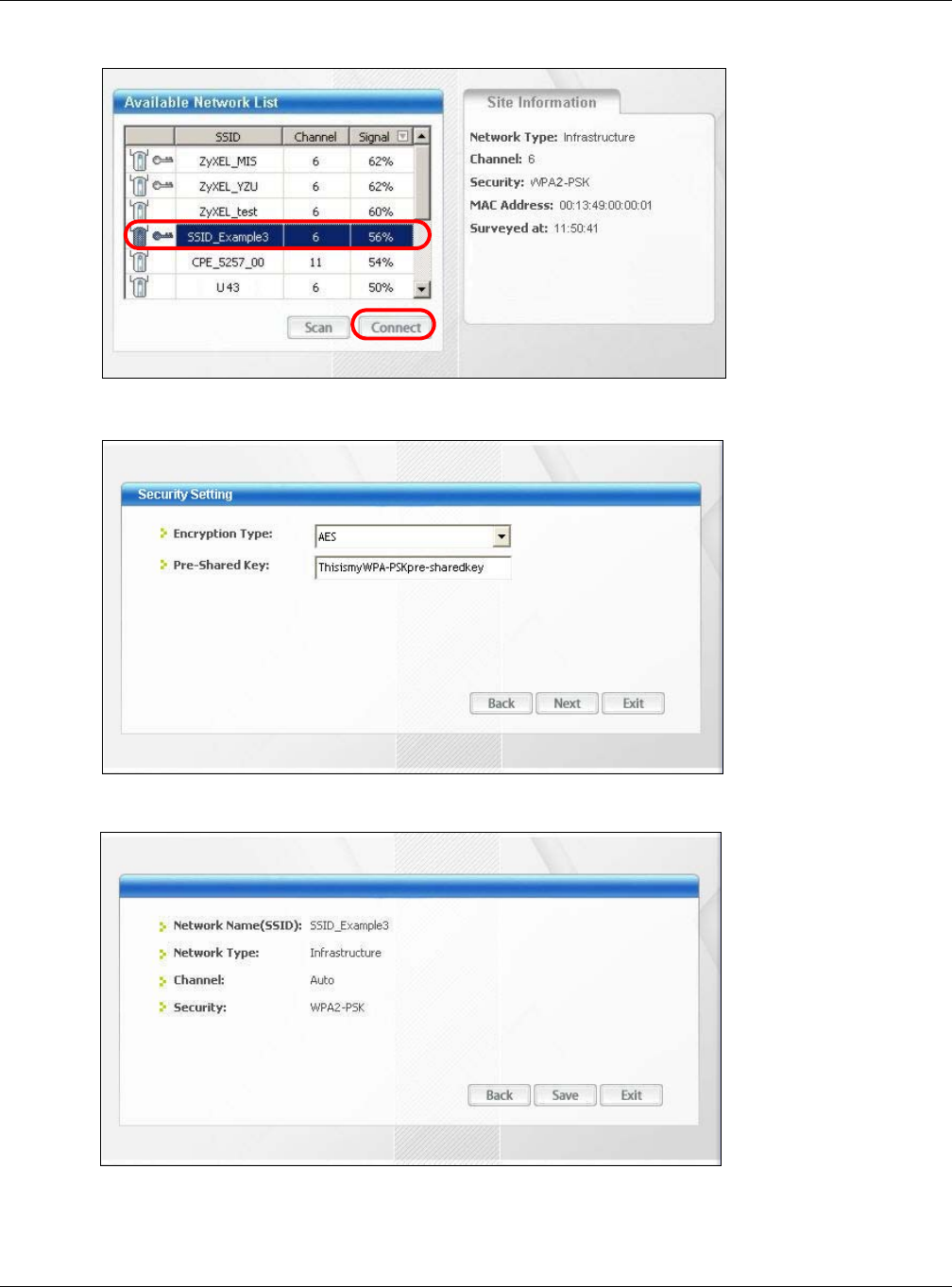
Chapter 8 Tutorials
EMG2926-Q10A User’s Guide
62
4Select SSID_Example3 and click Connect.
5Select AES and type the security key in the following screen. Click Next.
6The Confirm Save window appears. Check your settings and click Save to continue.
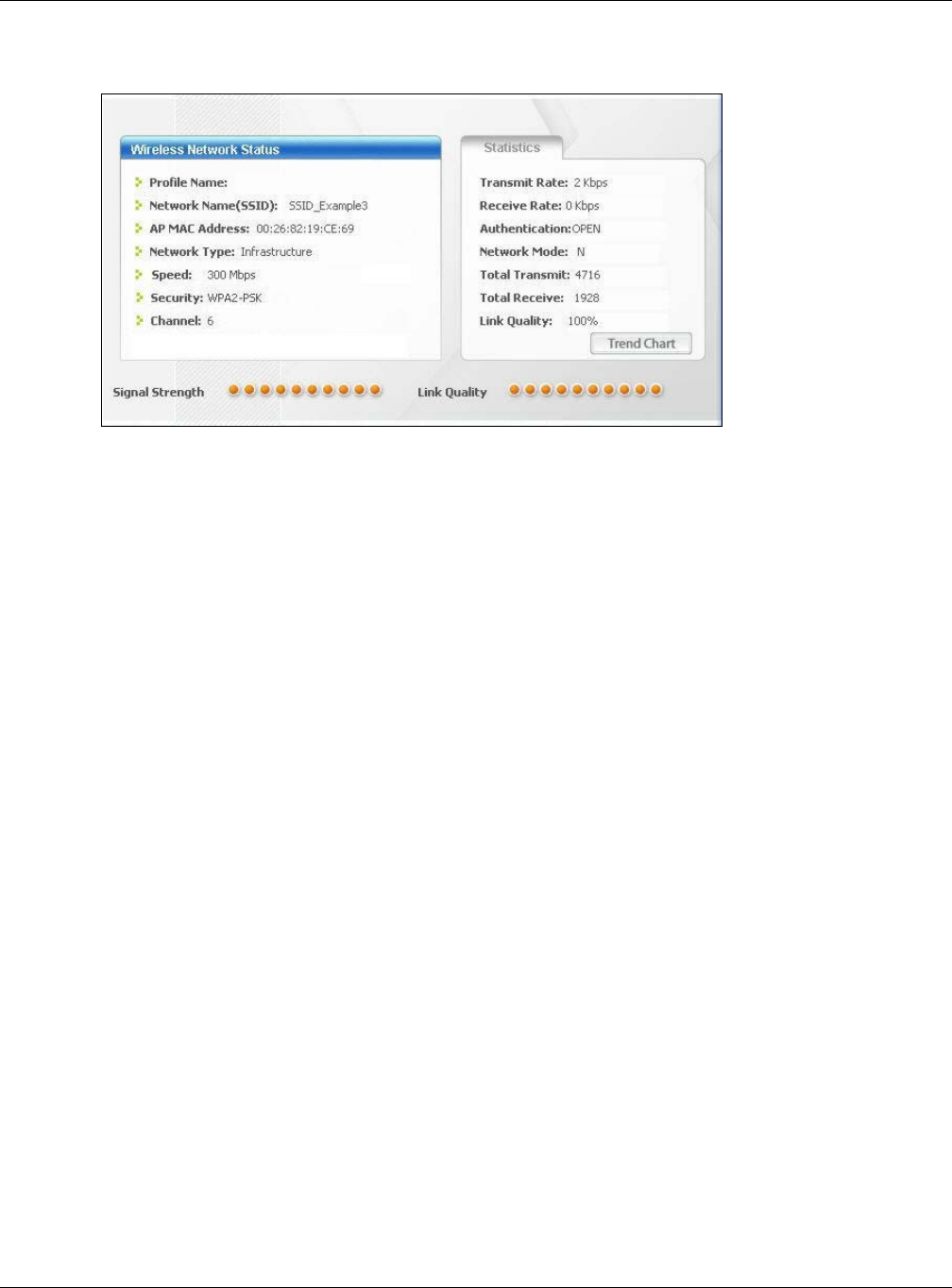
Chapter 8 Tutorials
EMG2926-Q10A User’s Guide
63
7Check the status of your wireless connection in the screen below. If your wireless connection is
weak or you have no connection, see the Troubleshooting section of this User’s Guide.
If your connection is successful, open your Internet browser and enter http://www.zyxel.com or the
URL of any other web site in the address bar. If you are able to access the web site, your wireless
connection is successfully configured.
8.4 Using Multiple SSIDs on the EMG2926-Q10A
You can configure more than one SSID on a EMG2926-Q10A. See Section 11.4 on page 99.
This allows you to configure multiple independent wireless networks on the EMG2926-Q10A as if
there were multiple APs (virtual APs). Each virtual AP has its own SSID, wireless security type and
MAC filtering settings. That is, each SSID on the EMG2926-Q10A represents a different access
point/wireless network to wireless clients in the network.
Clients can associate only with the SSIDs for which they have the correct security settings. Clients
using different SSIDs can access the Internet and the wired network behind the EMG2926-Q10A
(such as a printer).
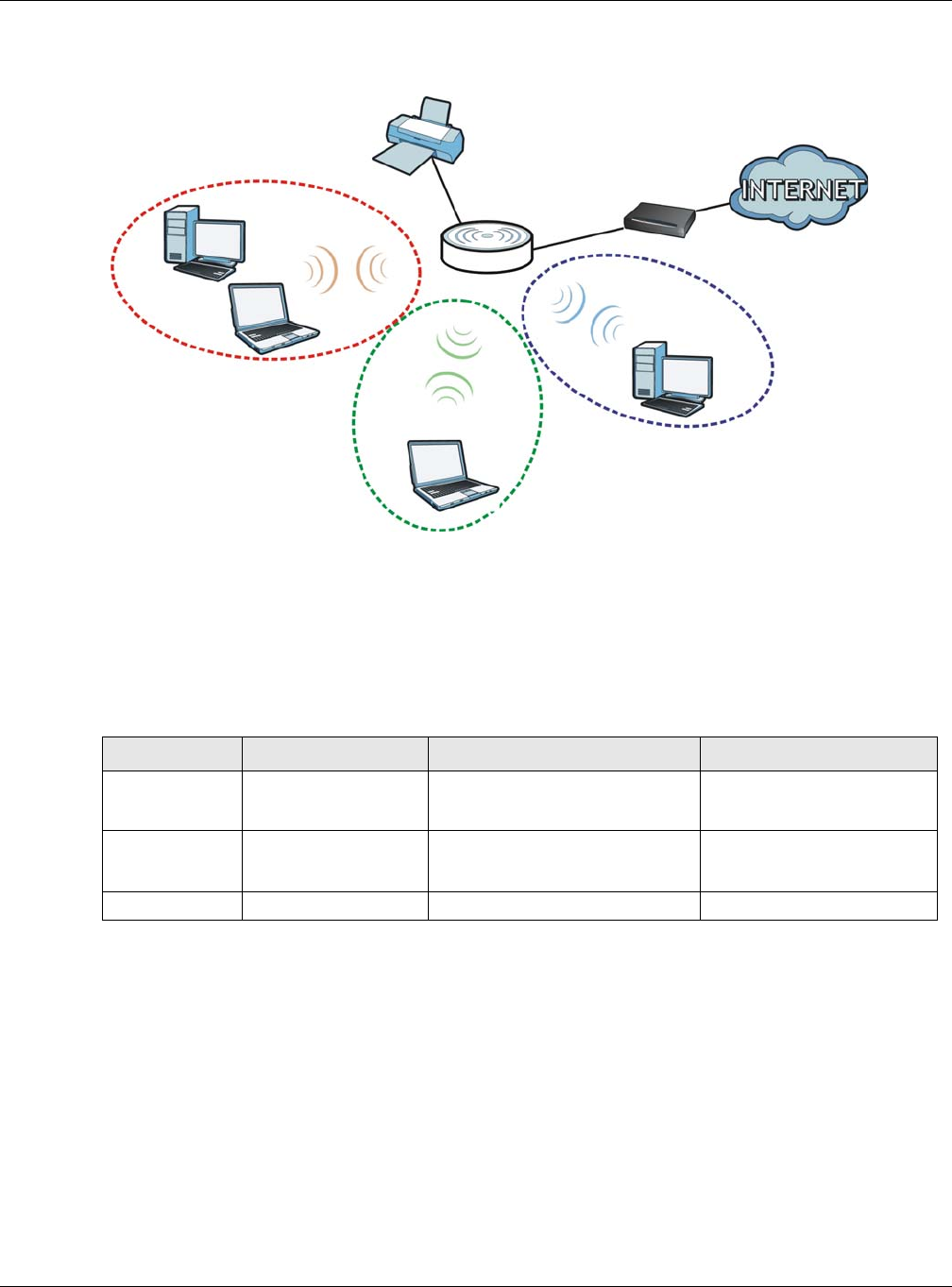
Chapter 8 Tutorials
EMG2926-Q10A User’s Guide
64
For example, you may set up three wireless networks (A, B and C) in your office. A is for workers,
B is for guests and C is specific to a VoIP device in the meeting room.
8.4.1 Configuring Security Settings of Multiple SSIDs
The EMG2926-Q10A is in router mode by default.
This example shows you how to configure the SSIDs with the following parameters on your
EMG2926-Q10A (in router mode).
1Connect your computer to the LAN port of the EMG2926-Q10A using an Ethernet cable.
2The default IP address of the EMG2926-Q10A in router mode is “192.168.0.1”. In this case, your
computer must have an IP address in the range between “192.168.0.2” and “192.168.0.254”.
3Click Start > Run on your computer in Windows. Type “cmd” in the dialog box. Enter “ipconfig” to
show your computer’s IP address. If your computer’s IP address is not in the correct range then see
Appendix B on page 193 for information on changing your computer’s IP address.
4After you’ve set your computer’s IP address, open a web browser such as Internet Explorer and
type “http://192.168.0.1” as the web address in your web browser.
5Enter “admin” (default) as the user name and click Login.
A
B
C
SSID_Guest
SSID_Worker
SSID_VoIP
SSID SECURITY TYPE KEY MAC FILTERING
SSID_Worker WPA2-PSK
WPA Compatible
DoNotStealMyWirelessNetwork Disable
SSID_VoIP WPA-PSK VoIPOnly12345678 Allow
00:A0:C5:01:23:45
SSID_Guest WPA-PSK keyexample123 Disable
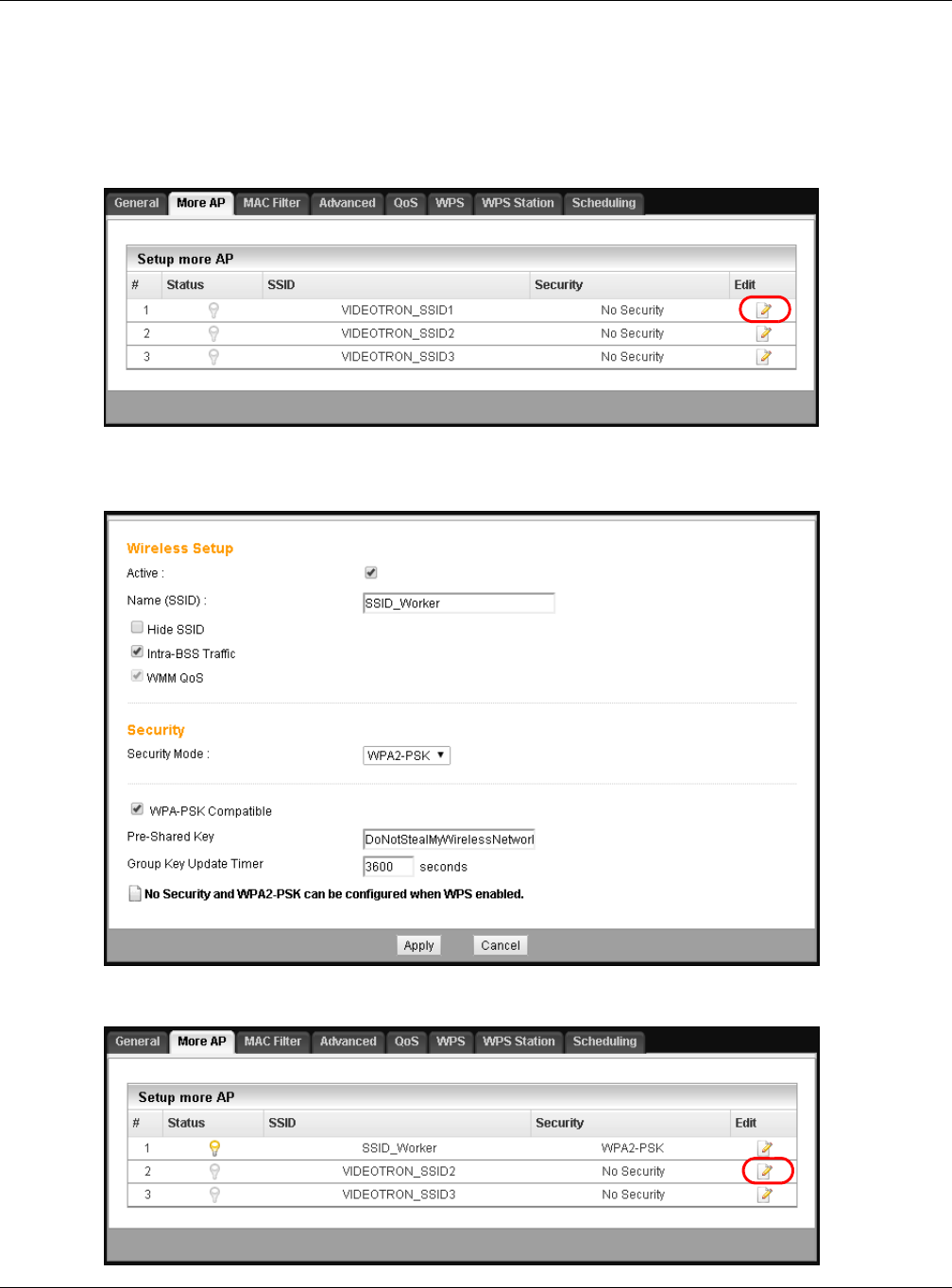
Chapter 8 Tutorials
EMG2926-Q10A User’s Guide
65
6Type a new password and retype it to confirm, then click Apply. Otherwise, click Ignore.
7The Easy Mode appears. Click Expert Mode in the navigation panel.
8Go to Configuration > Network > Wireless LAN 2.4G > More AP. Click the Edit icon of the first
entry to configure wireless and security settings for SSID_Worker.
9Configure the screen as follows. In this example, you enable Intra-BSS Traffic for SSID_Worker
to allow wireless clients in the same wireless network to communicate with each other. Click Apply.
10 Click the Edit icon of the second entry to configure wireless and security settings for SSID_VoIP.
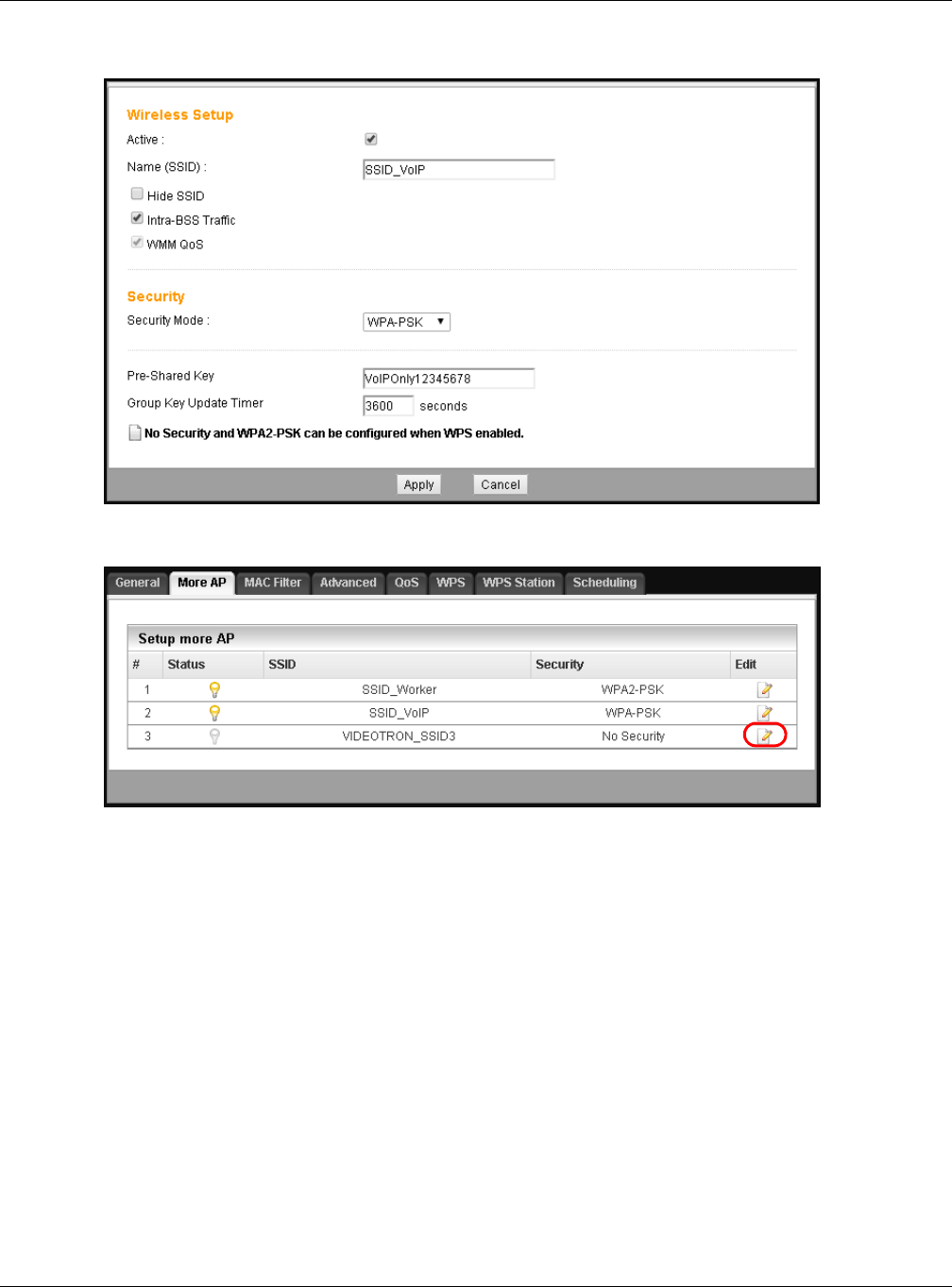
Chapter 8 Tutorials
EMG2926-Q10A User’s Guide
66
11 Configure the screen as follows. You do not enable Intra-BSS Traffic for SSID_VoIP. Click Apply.
12 Click the Edit icon of the third entry to configure wireless and security settings for SSID_Guest.
13 Configure the screen as follows. In this example, you enable Intra-BSS Traffic for SSID_Guest to
allow wireless clients in the same wireless network to communicate with each other. Select Enable
Guest WLAN to allow clients to access the Internet only. Click Apply.
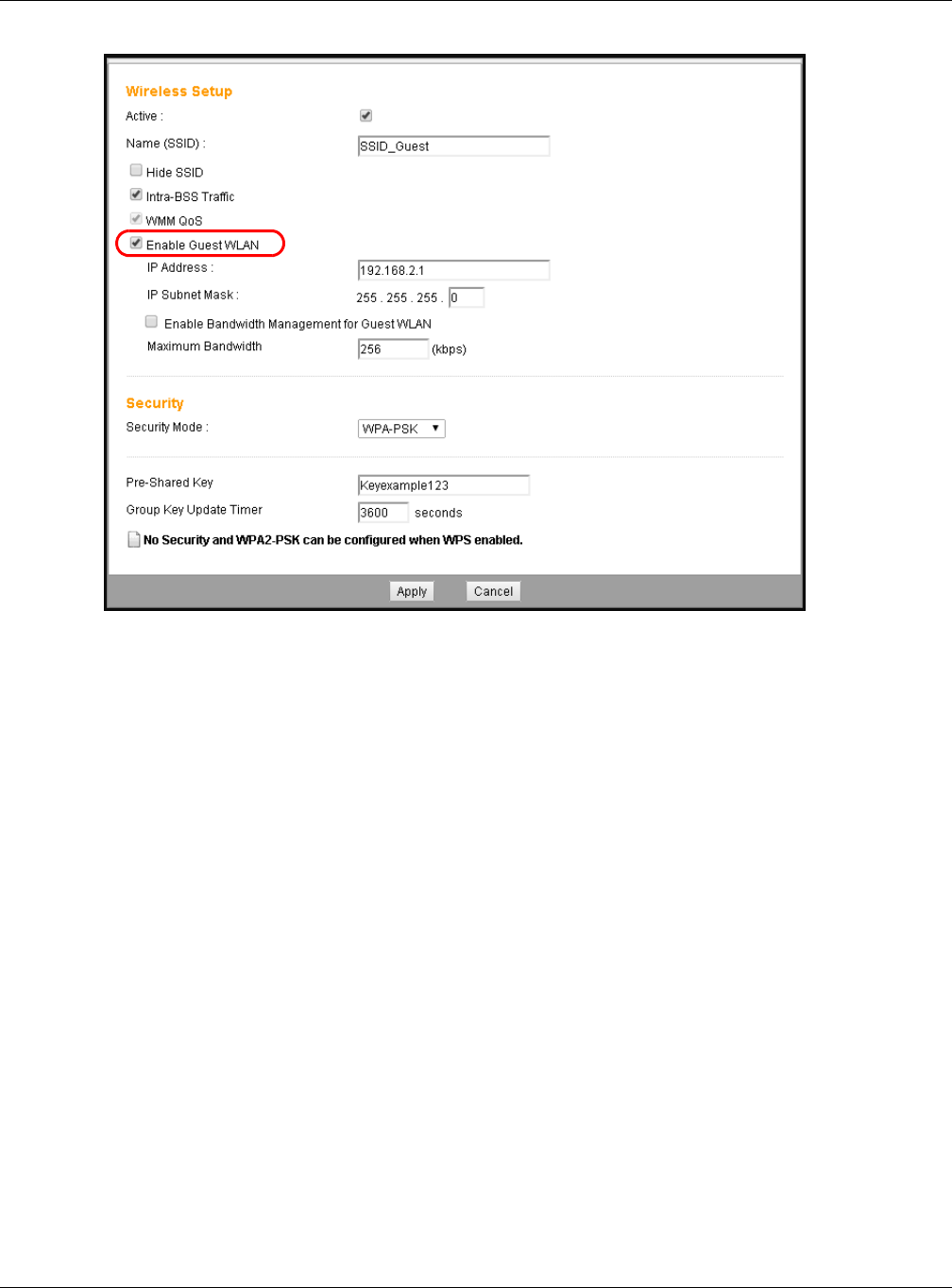
Chapter 8 Tutorials
EMG2926-Q10A User’s Guide
67
14 Click the MAC Filter tab to configure MAC filtering for the SSID_VoIP wireless network. Select
SSID_VoIP from the SSID Select drop-down list, enable MAC address filtering and set the Filter
Action to Allow. Enter the VoIP device’s MAC address in the Mac Address field and click Apply to
allow only the VoIP device to associate with the EMG2926-Q10A using this SSID.
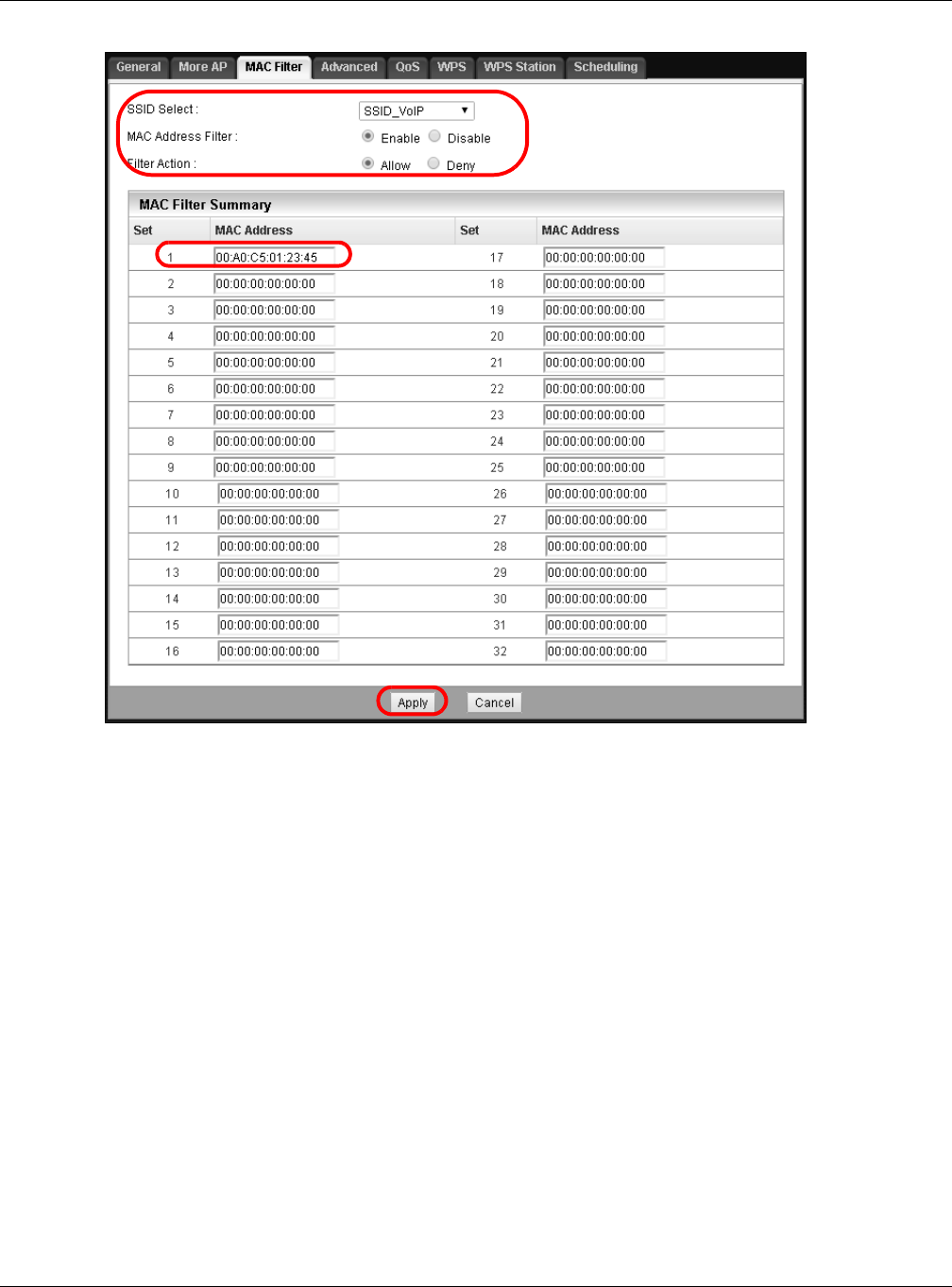
Chapter 8 Tutorials
EMG2926-Q10A User’s Guide
68

69
PART II
Technical Reference
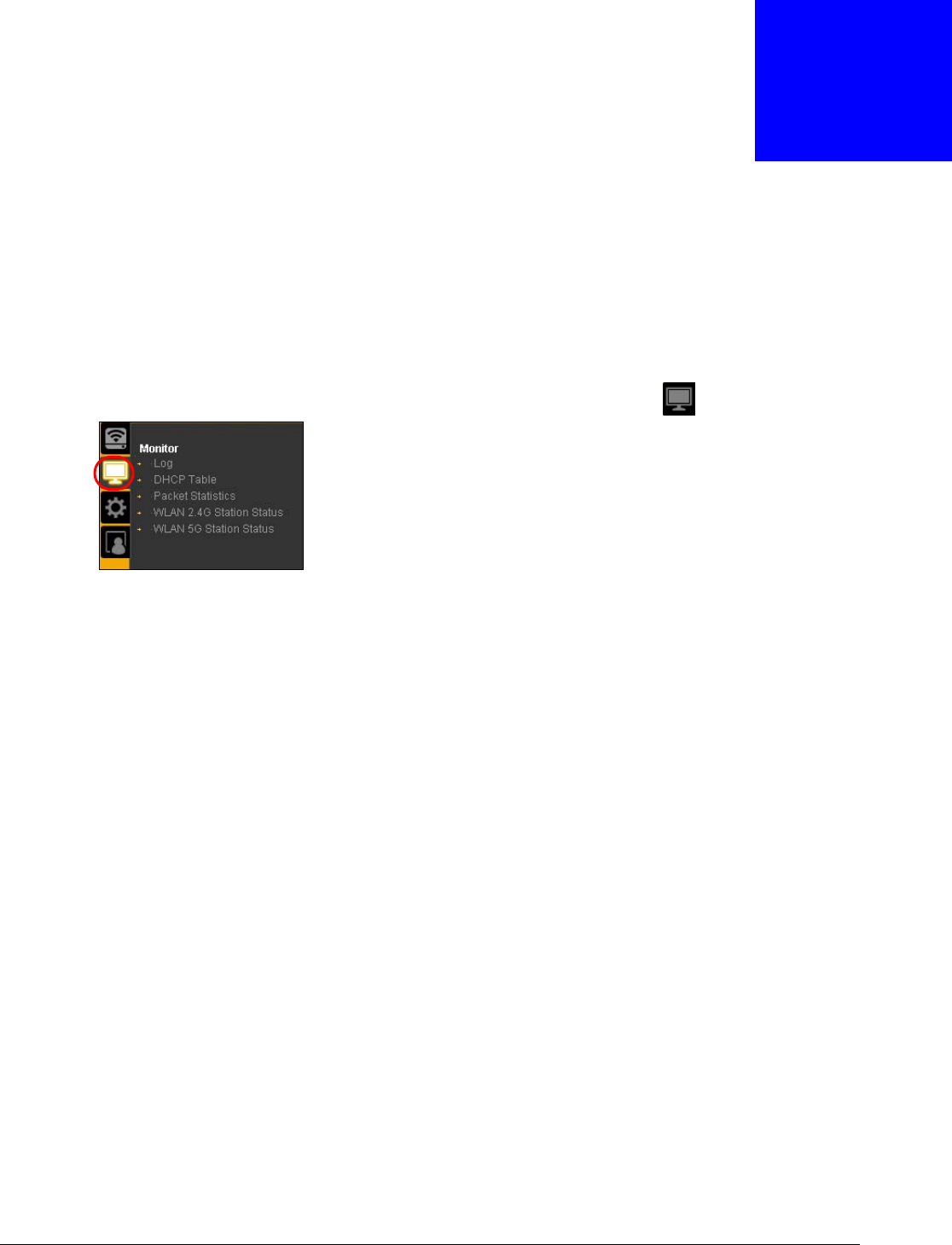
EMG2926-Q10A User’s Guide
70
CHAPTER 9
Monitor
9.1 Overview
This chapter discusses read-only information related to the device state of the EMG2926-Q10A.
To access the Monitor screens, go to Expert Mode after login, then click .
You can also click the links in the Summary table of the Status screen to view the packets sent/
received as well as the status of clients connected to the EMG2926-Q10A.
9.2 What You Can Do
•Use the Log screens to see the logs for the activity on the EMG2926-Q10A and select the logs
you wish to display (Section 9.3 on page 70).
•Use the DHCP Table screen to view information related to your DHCP status (Section 9.4 on
page 71).
•use the Packet Statistics screen to view port status, packet specific statistics, the "system up
time" and so on (Section 9.5 on page 72).
•Use the WLAN 2.4G/5G Station Status screen to view the wireless stations that are currently
associated to the EMG2926-Q10A (Section 9.6 on page 73).
9.3 The Log Screen
The Web Configurator allows you to look at all of the EMG2926-Q10A’s logs in one location and
select the logs you wish to display.
9.3.1 View Log
Use the View Log screen to see the logged messages for the EMG2926-Q10A. The log wraps
around and deletes the old entries after it fills. Select what logs you want to see from the Display
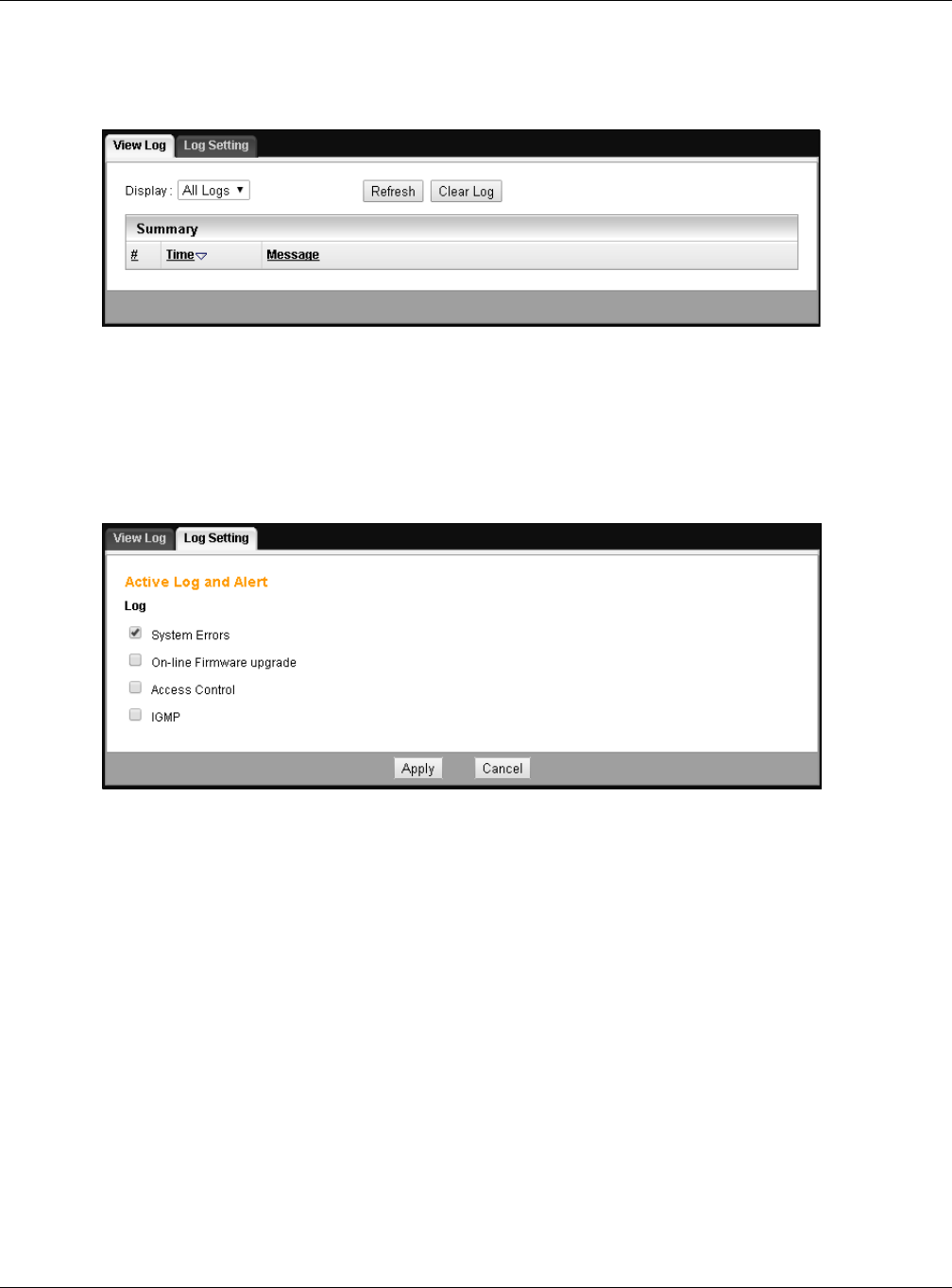
Chapter 9 Monitor
EMG2926-Q10A User’s Guide
71
drop list. The log choices depend on your settings in the Log Setting screen. Click Refresh to
renew the log screen. Click Clear Log to delete all the logs.
Figure 43 View Log
9.3.2 Log Setting
You can configure which logs to display in the View Log screen. Go to the Log Setting screen and
select the logs you wish to display. Click Apply to save your settings. Click Cancel to start the
screen afresh.
Figure 44 Log Settings
9.4 DHCP Table
DHCP (Dynamic Host Configuration Protocol, RFC 2131 and RFC 2132) allows individual clients to
obtain TCP/IP configuration at start-up from a server. You can configure the EMG2926-Q10A’s LAN
as a DHCP server or disable it. When configured as a server, the EMG2926-Q10A provides the TCP/
IP configuration for the clients. If DHCP service is disabled, you must have another DHCP server on
that network, or else the computer must be manually configured.
Click Monitor > DHCP Table or Configuration > Network > DHCP Server > Client List. Read-
only information here relates to your DHCP status. The DHCP table shows current DHCP client
information (including MAC Address, and IP Address) of all network clients using the EMG2926-
Q10A’s DHCP server.
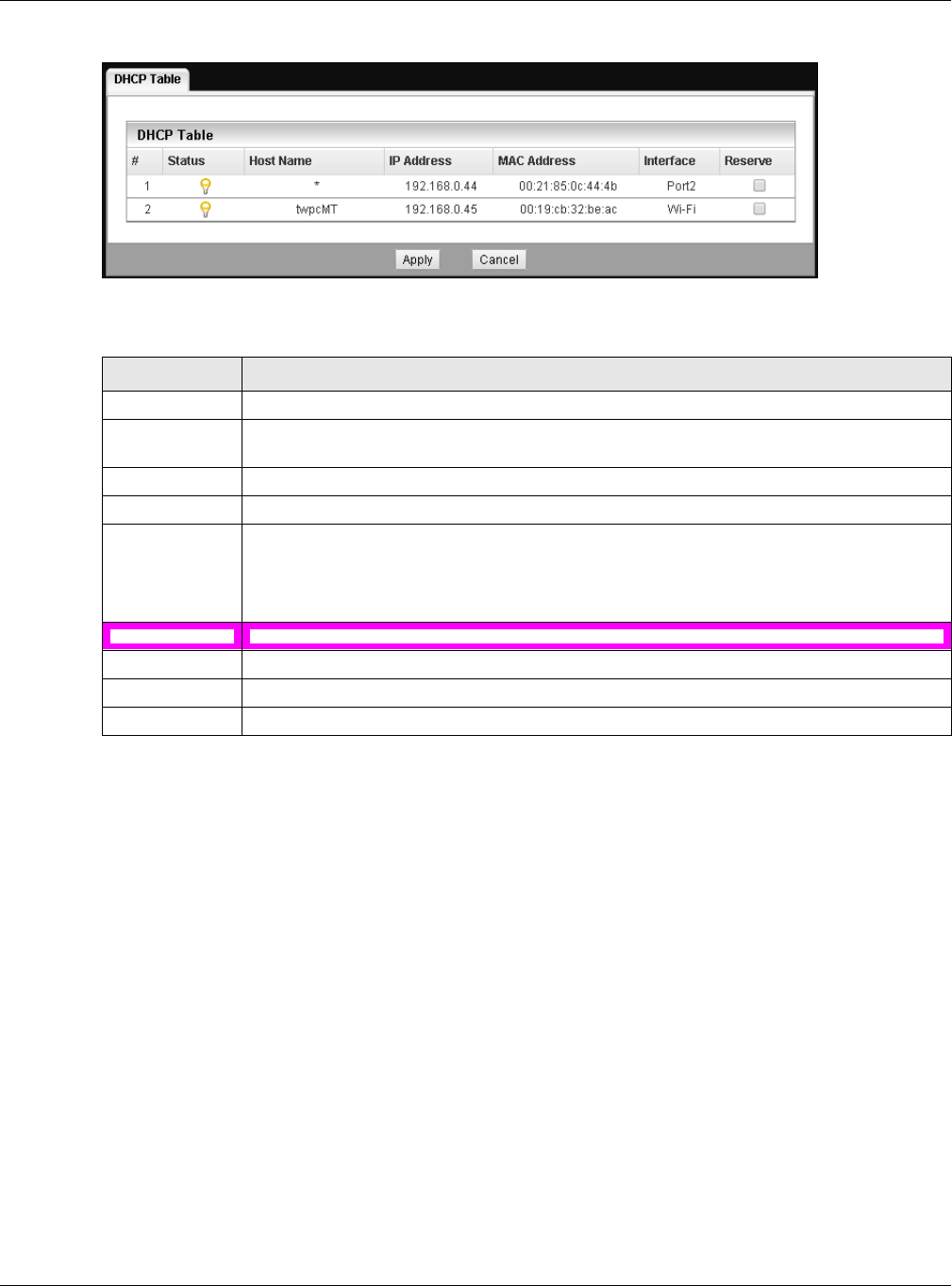
Chapter 9 Monitor
EMG2926-Q10A User’s Guide
72
Figure 45 Monitor > DHCP Table
The following table describes the labels in this screen.
9.5 Packet Statistics
Click Monitor > Packet Statistics or the Packet Statistics (Details...) hyperlink in the Status
screen. Read-only information here includes port status, packet specific statistics and the "system
up time". The Poll Interval(s) field is configurable and is used for refreshing the screen.
Table 24 Monitor > DHCP Table
LABEL DESCRIPTION
# This is the index number of the host computer.
Status This field displays whether the connection to the host computer is up (a yellow bulb) or
down (a gray bulb).
Host Name This field displays the computer host name.
IP Address This field displays the IP address relative to the # field listed above.
MAC Address This field shows the MAC address of the computer with the name in the Host Name field.
Every Ethernet device has a unique MAC (Media Access Control) address which uniquely
identifies a device. The MAC address is assigned at the factory and consists of six pairs of
hexadecimal characters, for example, 00:A0:C5:00:00:02.
Interface This field shows the interface to which the host computer is connected.
Reserve Select this if you want to reserve the IP address for this specific MAC address.
Apply Click Apply to save your changes back to the EMG2926-Q10A.
Cancel Click Cancel to reload the previous configuration for this screen.
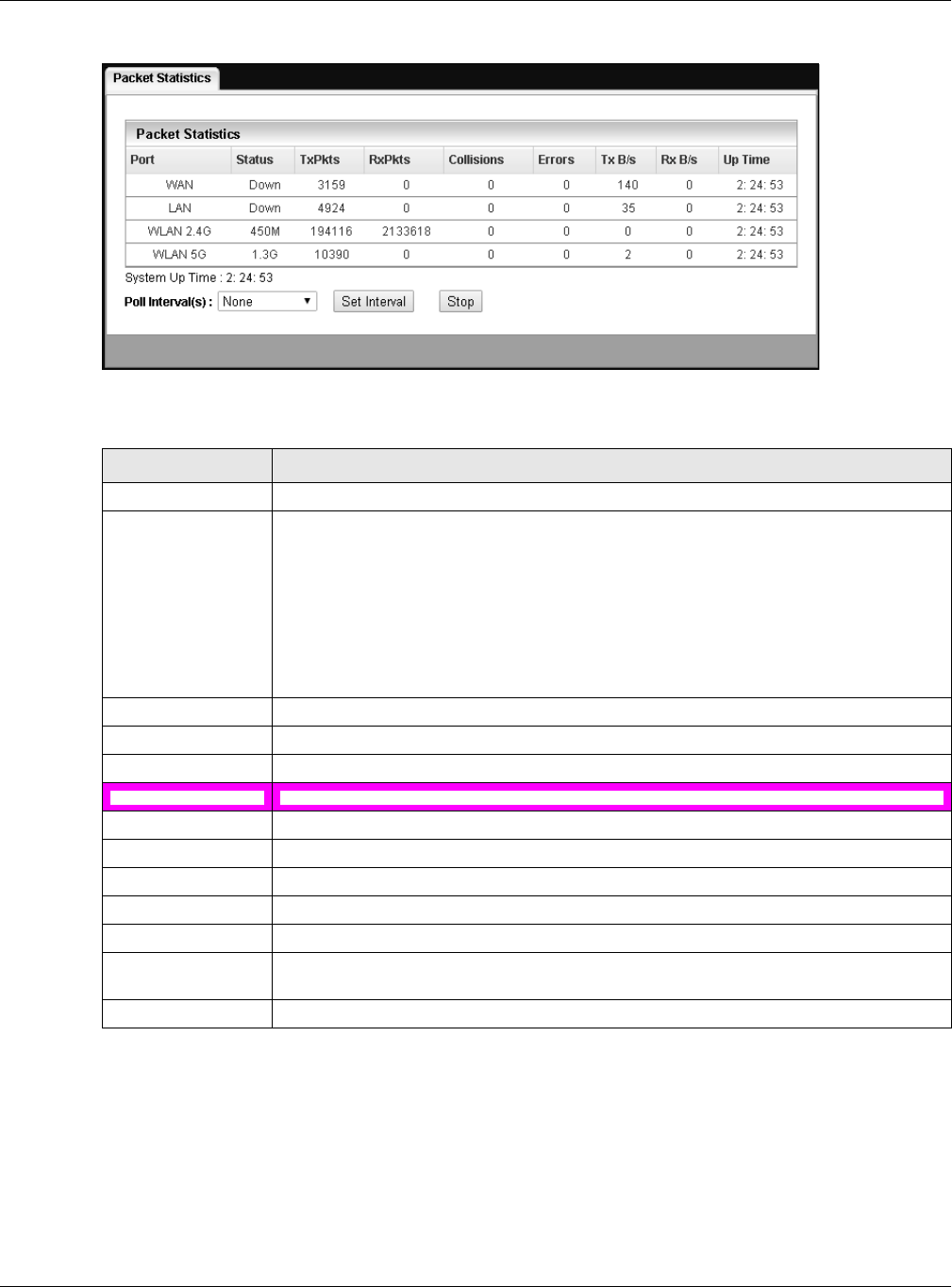
Chapter 9 Monitor
EMG2926-Q10A User’s Guide
73
Figure 46 Monitor > Packet Statistics
The following table describes the labels in this screen.
9.6 WLAN Station Status
Click Monitor > WLAN 2.4G/5G Station Status or the WLAN 2.4G/5G Station Status
(Details...) hyperlink in the Status screen. View the wireless stations that are currently associated
to the EMG2926-Q10A’s 2.4GHz or 5GHz wireless network in the Association List. Association
means that a wireless client (for example, your network or computer with a wireless network card)
Table 25 Monitor > Packet Statistics
LABEL DESCRIPTION
Port This is the EMG2926-Q10A’s interface type.
Status For the LAN ports, this displays the port speed and duplex setting or Down when the
line is disconnected.
For the WAN port, it displays the port speed and duplex setting if you’re using Ethernet
encapsulation and Idle (line (ppp) idle), Dial (starting to trigger a call) and Drop
(dropping a call) if you're using PPPoE encapsulation. This field displays Down when
the line is disconnected.
For the 2.4GHz or 5GHz WLAN, it displays the maximum transmission rate when the
WLAN is enabled and Down when the WLAN is disabled.
TxPkts This is the number of transmitted packets on this port.
RxPkts This is the number of received packets on this port.
Collisions This is the number of collisions on this port.
Errors This is the number of received errors on this port.
Tx B/s This displays the transmission speed in bytes per second on this port.
Rx B/s This displays the reception speed in bytes per second on this port.
Up Time This is the total time the EMG2926-Q10A has been for each session.
System Up Time This is the total time the EMG2926-Q10A has been on.
Poll Interval(s) Enter the time interval in seconds for refreshing statistics in this field.
Set Interval Click this button to apply the new poll interval you entered in the Poll Interval(s)
field.
Stop Click Stop to stop refreshing statistics.
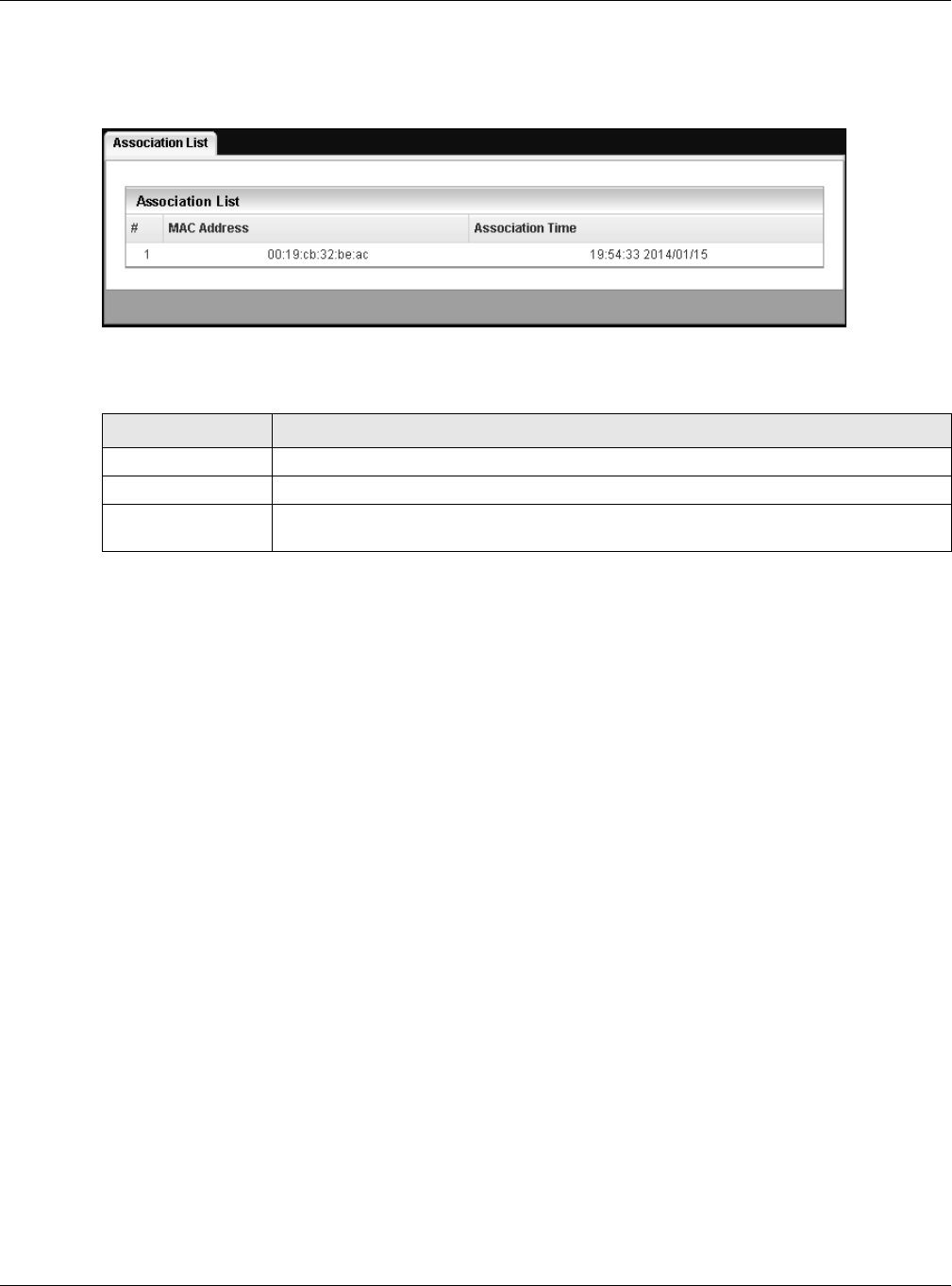
Chapter 9 Monitor
EMG2926-Q10A User’s Guide
74
has connected successfully to the AP (or wireless router) using the same SSID, channel and
security settings.
Figure 47 Monitor > WLAN Station Status
The following table describes the labels in this screen.
Table 26 Monitor > WLAN Station Status
LABEL DESCRIPTION
# This is the index number of an associated wireless station.
MAC Address This field displays the MAC address of an associated wireless station.
Association Time This field displays the time a wireless station first associated with the EMG2926-Q10A’s
WLAN.
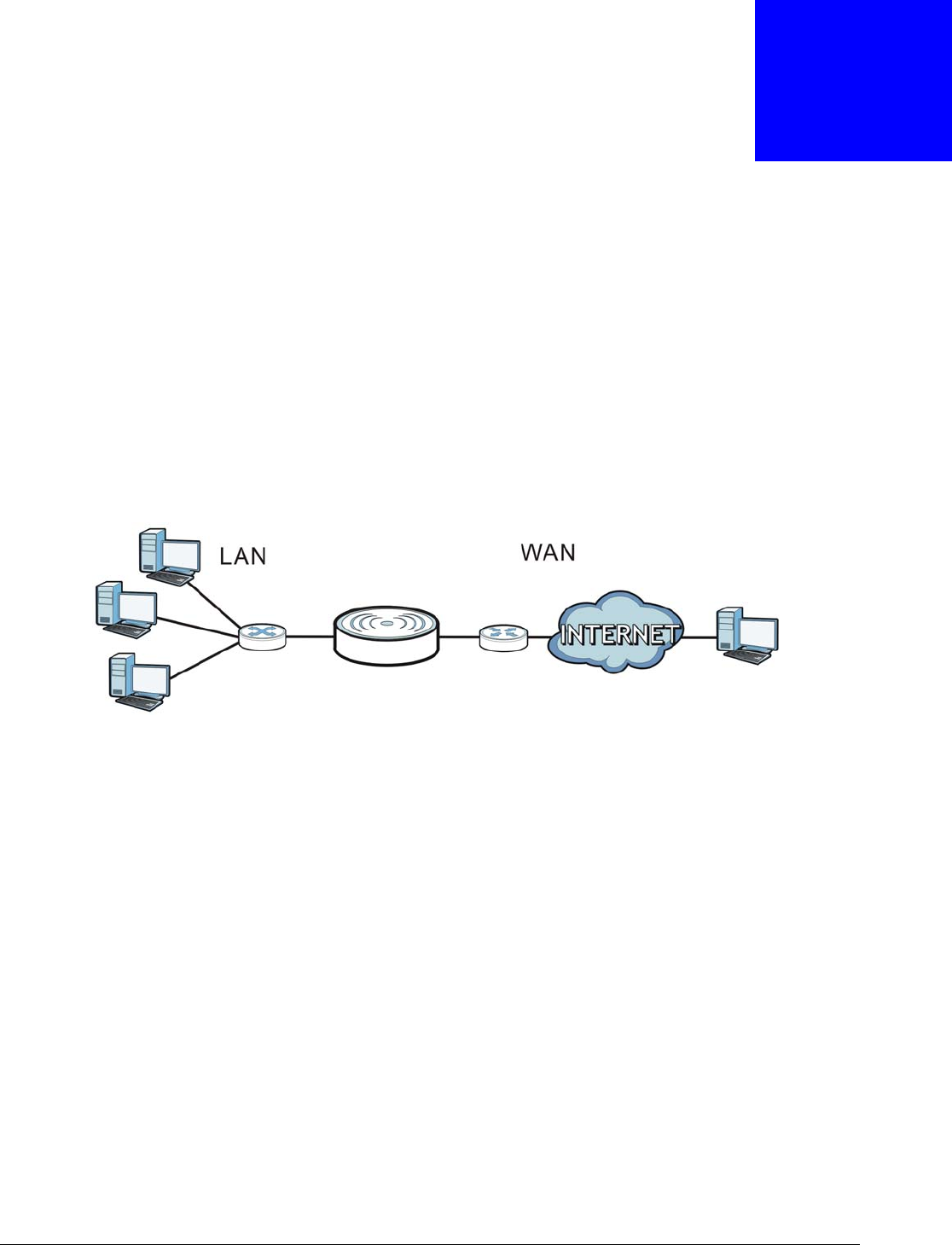
EMG2926-Q10A User’s Guide
75
CHAPTER 10
WAN
10.1 Overview
This chapter discusses the EMG2926-Q10A’s WAN screens. Use these screens to configure your
EMG2926-Q10A for Internet access.
A WAN (Wide Area Network) connection is an outside connection to another network or the
Internet. It connects your private networks such as a LAN (Local Area Network) and other
networks, so that a computer in one location can communicate with computers in other locations.
Figure 48 LAN and WAN
10.2 What You Can Do
•Use the Internet Connection screen to enter your ISP information and set how the computer
acquires its IP, DNS and WAN MAC addresses (Section 10.4 on page 78).
•Use the Advanced screen to enable multicasting, configure Windows networking and bridge
(Section 10.5 on page 84).
10.3 What You Need To Know
The information in this section can help you configure the screens for your WAN connection, as well
as enable/disable some advanced features of your EMG2926-Q10A.

Chapter 10 WAN
EMG2926-Q10A User’s Guide
76
10.3.1 Configuring Your Internet Connection
Encapsulation Method
Encapsulation is used to include data from an upper layer protocol into a lower layer protocol. To set
up a WAN connection to the Internet, you need to use the same encapsulation method used by your
ISP (Internet Service Provider). If your ISP offers a dial-up Internet connection using PPPoE (PPP
over Ethernet) or PPTP (Point-to-Point Tunneling Protocol), they should also provide a username
and password (and service name) for user authentication.
WAN IP Address
The WAN IP address is an IP address for the EMG2926-Q10A, which makes it accessible from an
outside network. It is used by the EMG2926-Q10A to communicate with other devices in other
networks. It can be static (fixed) or dynamically assigned by the ISP each time the EMG2926-Q10A
tries to access the Internet.
If your ISP assigns you a static WAN IP address, they should also assign you the subnet mask and
DNS server IP address(es) (and a gateway IP address if you use the Ethernet or ENET ENCAP
encapsulation method).
DNS Server Address Assignment
Use Domain Name System (DNS) to map a domain name to its corresponding IP address and vice
versa, for instance, the IP address of www.zyxel.com is 204.217.0.2. The DNS server is extremely
important because without it, you must know the IP address of a computer before you can access
it.
The EMG2926-Q10A can get the DNS server addresses in the following ways.
1The ISP tells you the DNS server addresses, usually in the form of an information sheet, when you
sign up. If your ISP gives you DNS server addresses, manually enter them in the DNS server fields.
2If your ISP dynamically assigns the DNS server IP addresses (along with the EMG2926-Q10A’s WAN
IP address), set the DNS server fields to get the DNS server address from the ISP.
IPv6 Rapid Deployment
Use IPv6 Rapid Deployment (6rd) when the local network uses IPv6 and the ISP has an IPv4
network. When the EMG2926-Q10A has an IPv4 WAN address and you set IPv6/IPv4 mode to
IPv4 Only, you can enable 6rd to encapsulate IPv6 packets in IPv4 packets to cross the ISP’s IPv4
network.
The EMG2926-Q10A generates a global IPv6 prefix from its IPv4 WAN address and tunnels IPv6
traffic to the ISP’s Border Relay router (BR in the figure) to connect to the native IPv6 Internet. The
local network can also use IPv4 services. The EMG2926-Q10A uses it’s configured IPv4 WAN IP to
route IPv4 traffic to the IPv4 Internet.
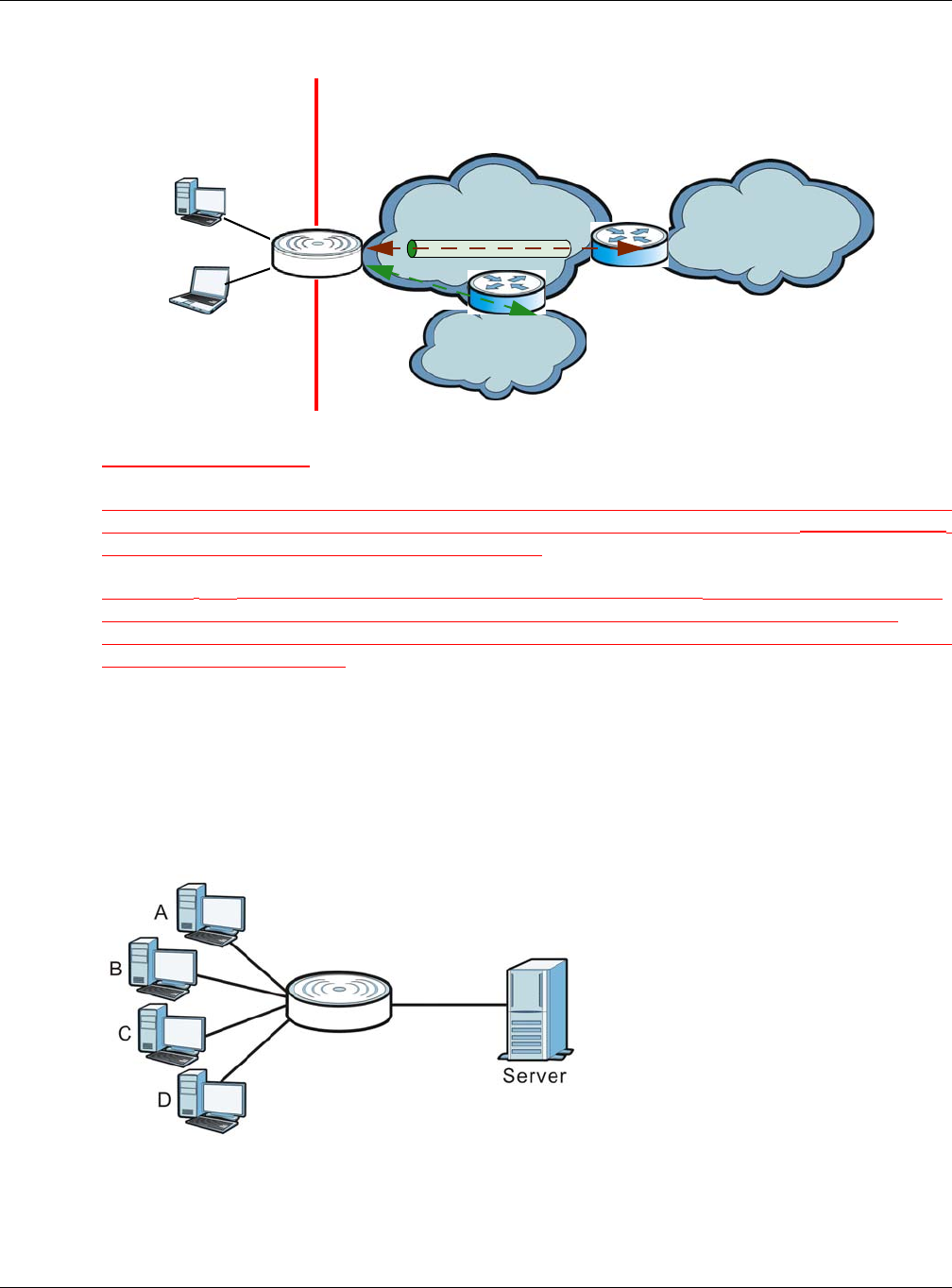
Chapter 10 WAN
EMG2926-Q10A User’s Guide
77
Figure 49 IPv6 Rapid Deployment
WAN MAC Address
The MAC address screen allows users to configure the WAN port's MAC address by either using the
factory default or cloning the MAC address from a computer on your LAN. Choose Factory Default
to select the factory assigned default MAC Address.
Otherwise, click Clone the computer's MAC address - IP Address and enter the IP address of
the computer on the LAN whose MAC you are cloning. Once it is successfully configured, the
address will be copied to configuration file. It is recommended that you clone the MAC address prior
to hooking up the WAN Port.
Multicast
Traditionally, IP packets are transmitted in one of either two ways - Unicast (1 sender - 1 recipient)
or Broadcast (1 sender - everybody on the network). Multicast delivers IP packets to a group of
hosts on the network - not everybody and not just 1.
Figure 50 Multicast Example
In the multicast example above, systems A and D comprise one multicast group. In multicasting,
the server only needs to send one data stream and this is delivered to systems A and D.
ISP (IPv4) IPv6 Internet
IPv4
IPv6
BR
IPv6 in IPv4
IPv4 Internet
IPv4
+
LAN
- IPv6
- IPv4
WAN
- IPv4
- IPv6 in IPv4

Chapter 10 WAN
EMG2926-Q10A User’s Guide
78
IGMP (Internet Group Multicast Protocol) is a network-layer protocol used to establish membership
in a multicast group - it is not used to carry user data. The EMG2926-Q10A supports both IGMP
version 1 (IGMP-v1) and IGMP version 2 (IGMP-v2).
At start up, the EMG2926-Q10A queries all directly connected networks to gather group
membership. After that, the EMG2926-Q10A periodically updates this information. IP multicasting
can be enabled/disabled on the EMG2926-Q10A WAN interface in the Web Configurator (WAN).
Select None to disable IP multicasting on these interfaces.
10.4 Internet Connection
Use this screen to change your EMG2926-Q10A’s Internet access settings. Click Network > WAN
from the Configuration menu. The screen differs according to the encapsulation and IPv4/IPv6
mode you choose.
10.4.1 IPoE Encapsulation
This screen displays when you select IPoE encapsulation.
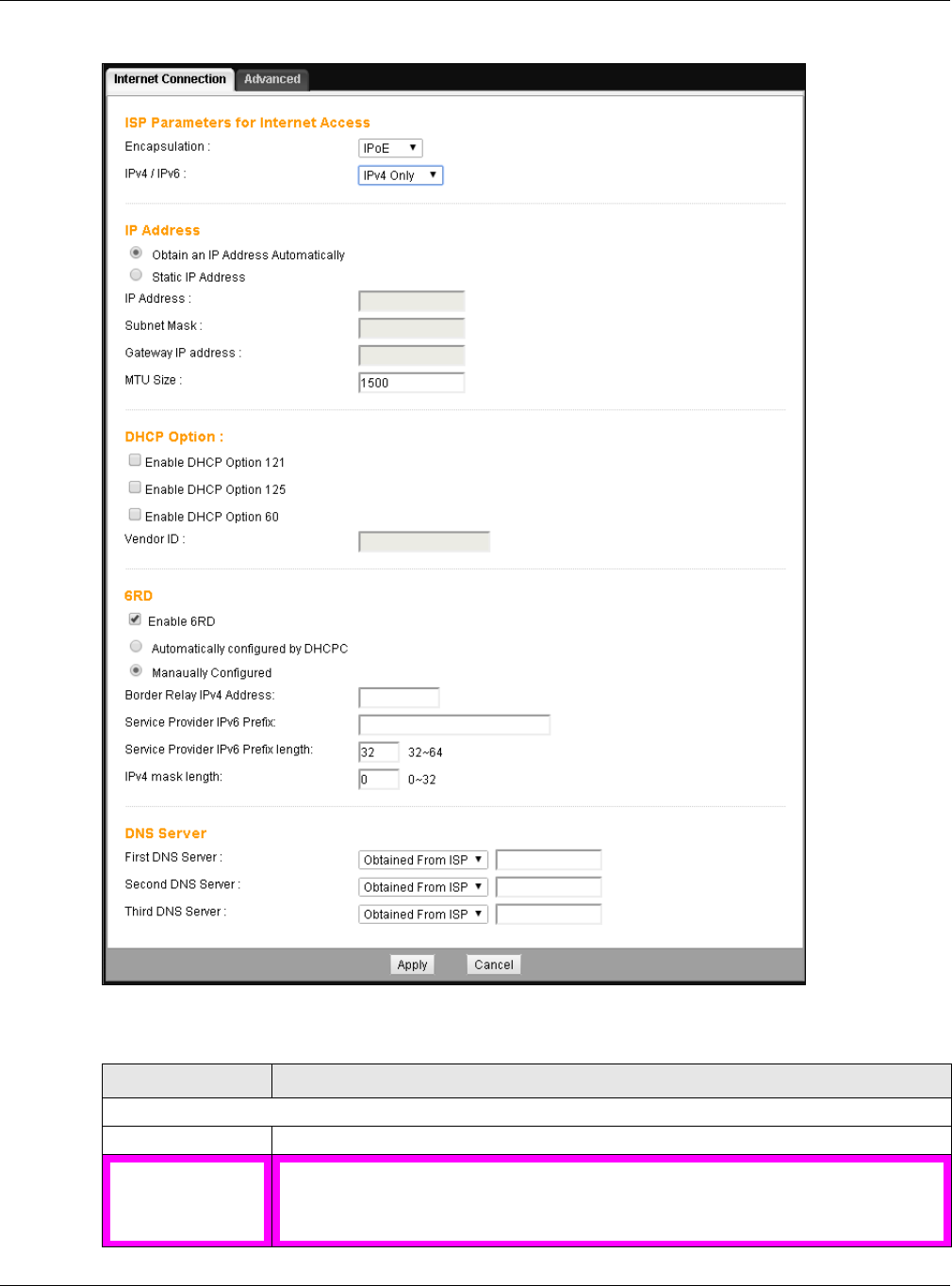
Chapter 10 WAN
EMG2926-Q10A User’s Guide
79
Figure 51 Network > WAN > Internet Connection: IPoE Encapsulation (IPv4 Only)
The following table describes the labels in this screen.
Table 27 Network > WAN > Internet Connection: IPoE Encapsulation
LABEL DESCRIPTION
ISP Parameters for Internet Access
Encapsulation You must choose the IPoE option when the WAN port is used as a regular Ethernet.
IPv4 / IPv6 Select IPv4 Only if you want the EMG2926-Q10A to run IPv4 only.
Select Dual Stack to allow the EMG2926-Q10A to run IPv4 and IPv6 at the same time.
Select IPv6 Only if you want the EMG2926-Q10A to run IPv6 only.
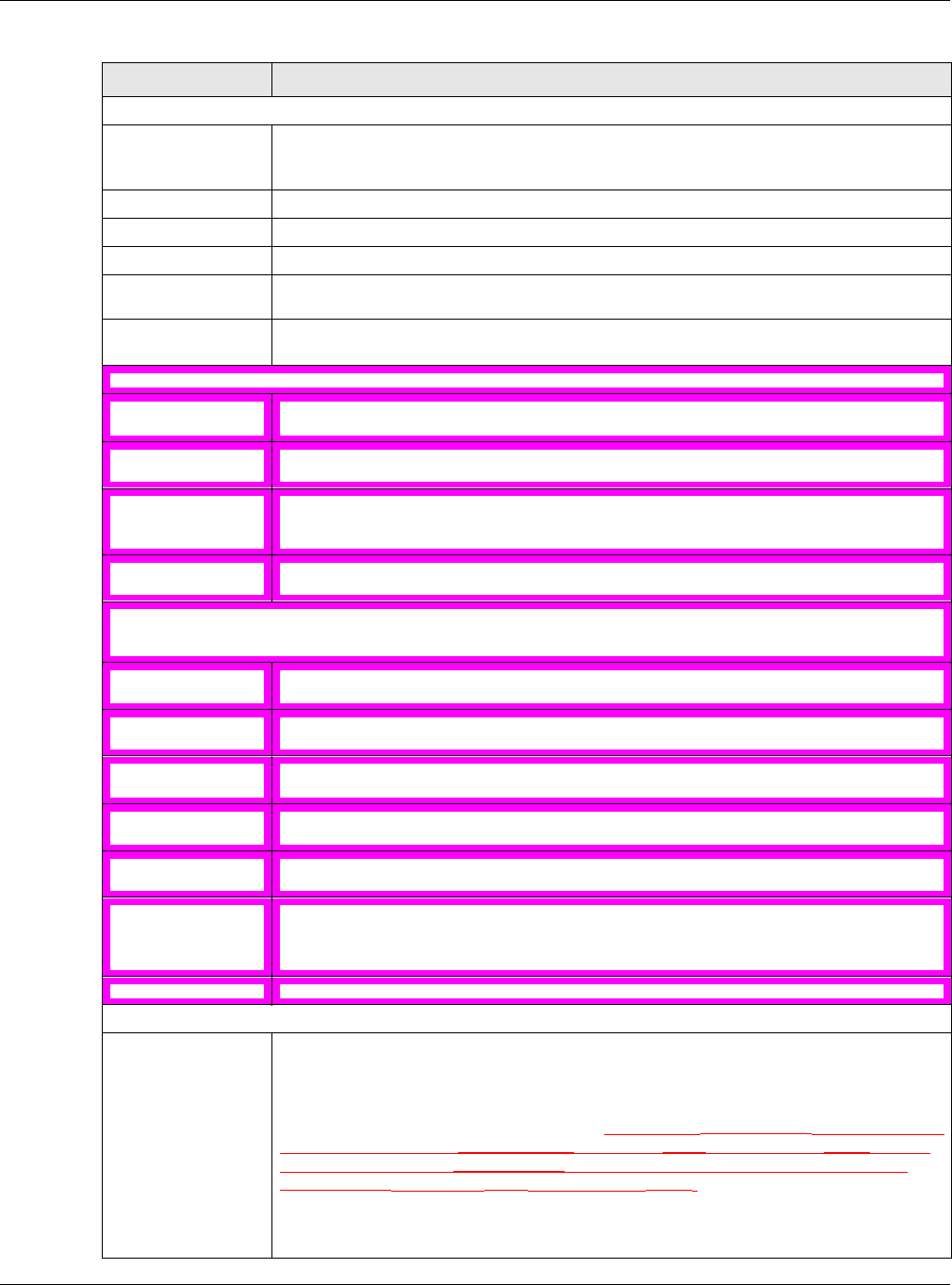
Chapter 10 WAN
EMG2926-Q10A User’s Guide
80
IP Address
Obtain an IP
Address
Automatically
Select this option If your ISP did not assign you a fixed IP address. This is the default
selection.
Static IP Address Select this option If the ISP assigned a fixed IP address.
IP Address Enter your WAN IP address in this field if you selected Static IP Address.
Subnet Mask Enter the Subnet Mask in this field.
Gateway IP
Address Enter a Gateway IP Address (if your ISP gave you one) in this field.
MTU Size Enter the MTU (Maximum Transmission Unit) size for each packet. If a larger packet
arrives, the EMG2926-Q10A divides it into smaller fragments.
DHCP Option
Enable DHCP Option
121
Select this to enable the classless route option 121.
Enable DHCP Option
125
Select this to add vendor specific information to DHCP requests that the EMG2926-
Q10A sends to a DHCP server when getting a WAN IP address.
Enable DHCP Option
60
Select this to identify the vendor and functionality of the EMG2926-Q10A in DHCP
requests that the EMG2926-Q10A sends to a DHCP server when getting a WAN IP
address.
Vendor ID Enter the Vendor Class Identifier (Option 60), such as the type of the hardware or
firmware.
6RD
This is available only when you select IPv4 Only in the IPv6/IPv4 field.
Enable 6RD Enable IPv6 rapid deployment to tunnel IPv6 traffic from the local network through the
ISP’s IPv4 network.
Automatically
configured by DHCP
Select this to have the EMG2926-Q10A detect the relay server IP address automatically
through DHCP.
Manaually
Configured
Select this if you have the IPv4 address of the relay server.
Border Relay IPv4
Address
Specify the relay server IPv4 address.
Service Provider
IPv6 Prefix
Enter an IPv6 prefix for tunneling IPv6 traffic to the ISP’s Border Relay router and
connecting to the native IPv6 Internet.
Service Provider
IPv6 Prefix length
Enter the IPv6 prefix length.
An IPv6 prefix length specifies how many most significant bits (starting from the left) in
the address compose the network address.
IPv4 mask length Enter the subnet mask number (1~32) for the IPv4 network.
DNS Server
First DNS Server
Second DNS Server
Third DNS Server
Select Obtained From ISP if your ISP dynamically assigns DNS server information
(and the EMG2926-Q10A's WAN IP address). The field to the right displays the (read-
only) DNS server IP address that the ISP assigns.
Select User-Defined if you have the IP address of a DNS server. Enter the DNS
server's IP address in the field to the right. If you chose User-Defined, but leave the IP
address set to 0.0.0.0, User-Defined changes to None after you click Apply. If you
set a second choice to User-Defined, and enter the same IP address, the second
User-Defined changes to None after you click Apply.
Select None if you do not want to configure DNS servers. If you do not configure a DNS
server, you must know the IP address of a computer in order to access it.
Table 27 Network > WAN > Internet Connection: IPoE Encapsulation (continued)
LABEL DESCRIPTION
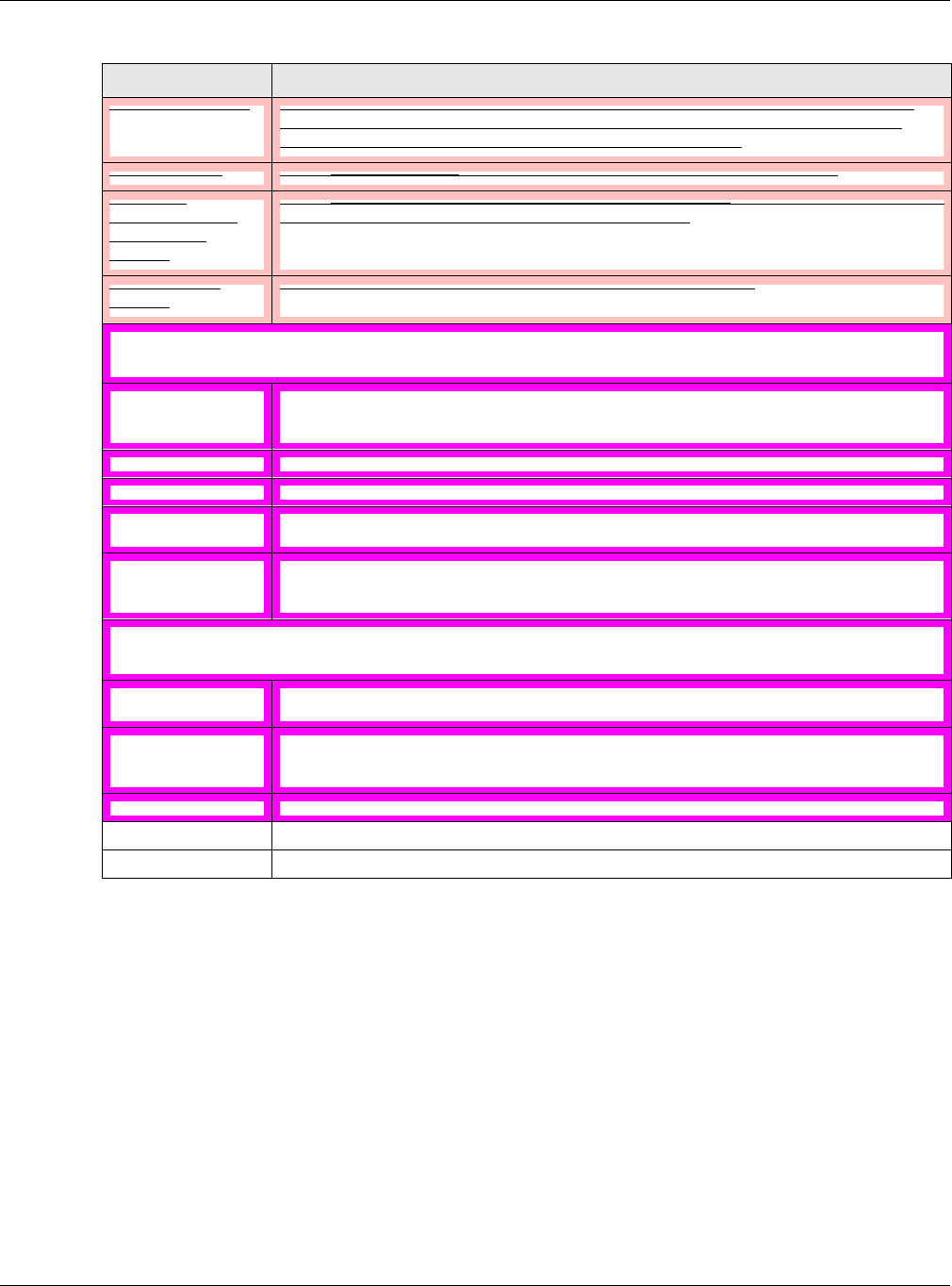
Chapter 10 WAN
EMG2926-Q10A User’s Guide
81
10.4.2 PPPoE Encapsulation
The EMG2926-Q10A supports PPPoE (Point-to-Point Protocol over Ethernet). PPPoE is an IETF
standard (RFC 2516) specifying how a personal computer (PC) interacts with a broadband modem
(DSL, cable, wireless, etc.) connection. The PPP over Ethernet option is for a dial-up connection
using PPPoE.
For the service provider, PPPoE offers an access and authentication method that works with existing
access control systems (for example Radius).
One of the benefits of PPPoE is the ability to let you access one of multiple network services, a
function known as dynamic service selection. This enables the service provider to easily create and
offer new IP services for individuals.
WAN MAC Address The MAC address section allows users to configure the WAN port's MAC address by
either using the EMG2926-Q10A’s MAC address, copying the MAC address from a
computer on your LAN or manually entering a MAC address.
Factory default Select Factory default to use the factory assigned default MAC Address.
Clone the
computer’s MAC
address - IP
Address
Select Clone the computer's MAC address - IP Address and enter the IP address of
the computer on the LAN whose MAC you are cloning.
Set WAN MAC
Address
Select this option and enter the MAC address you want to use.
IPv6 Address
This is not available when you select IPv4 Only in the IPv6/IPv4 field.
Obtain an IP
Address
Automatically
Select this if you want to obtain an IPv6 address from a DHCPv6 server.
Static IP Address Select this if you have a fixed IPv6 address assigned by your ISP.
IPv6 Address Enter the IPv6 address assigned by your ISP.
Prefix length Enter the address prefix length to specify how many most significant bits in an IPv6
address compose the network address.
IPv6 Default
Gateway Enter the IP address of the next-hop gateway. The gateway is a router or switch on the
same segment as your EMG2926-Q10A's interface(s). The gateway helps forward
packets to their destinations.
IPv6 DNS server
This is not available when you select IPv4 Only in the IPv6/IPv4 field.
Obtain IPv6 DNS
info Automatically
Select this to have the EMG2926-Q10A get the IPv6 DNS server addresses from the ISP
automatically.
Use the following
Static DNS IPv6
Address
Select this to have the EMG2926-Q10A use the IPv6 DNS server addresses you
configure manually.
IPv6 DNS Server Enter the IPv6 DNS server address assigned by the ISP.
Apply Click Apply to save your changes back to the EMG2926-Q10A.
Cancel Click Cancel to begin configuring this screen afresh.
Table 27 Network > WAN > Internet Connection: IPoE Encapsulation (continued)
LABEL DESCRIPTION
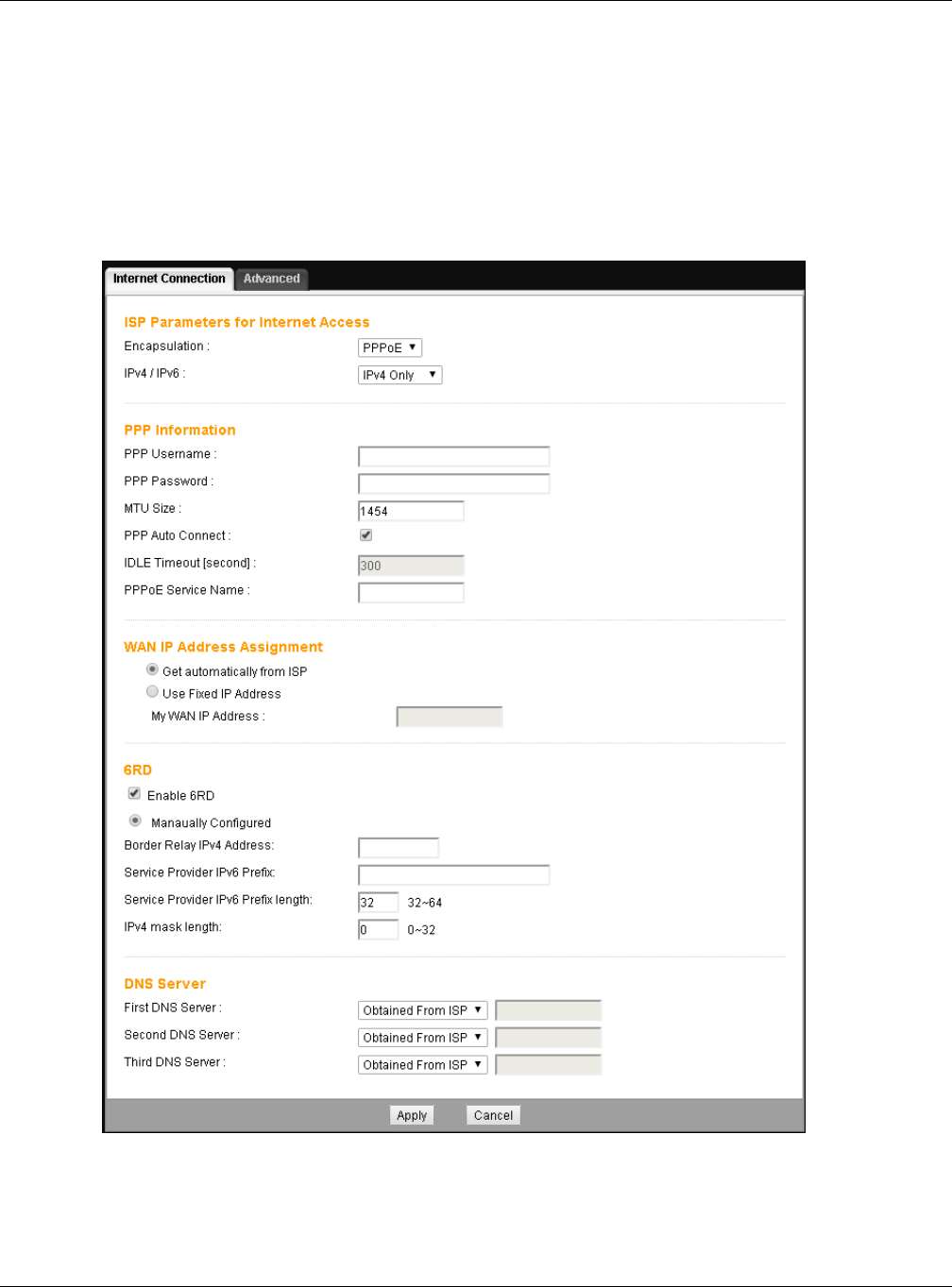
Chapter 10 WAN
EMG2926-Q10A User’s Guide
82
Operationally, PPPoE saves significant effort for both you and the ISP or carrier, as it requires no
specific configuration of the broadband modem at the customer site.
By implementing PPPoE directly on the EMG2926-Q10A (rather than individual computers), the
computers on the LAN do not need PPPoE software installed, since the EMG2926-Q10A does that
part of the task. Furthermore, with NAT, all of the LANs’ computers will have access.
This screen displays when you select PPPoE encapsulation.
Figure 52 Network > WAN > Internet Connection: PPPoE Encapsulation (IPv4 Only)
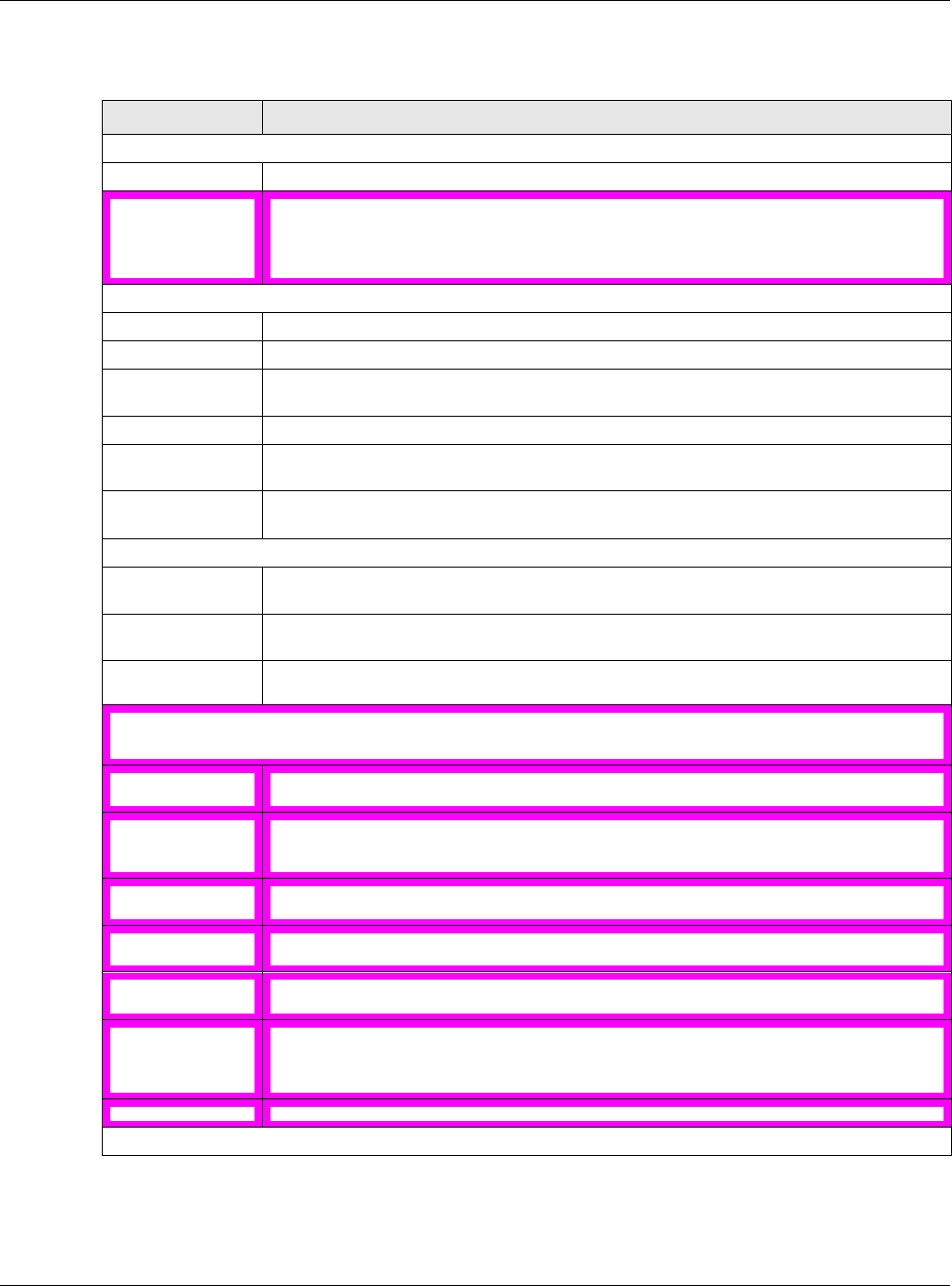
Chapter 10 WAN
EMG2926-Q10A User’s Guide
83
The following table describes the labels in this screen.
Table 28 Network > WAN > Internet Connection: PPPoE Encapsulation
LABEL DESCRIPTION
ISP Parameters for Internet Access
Encapsulation Select PPPoE if you connect to your Internet via dial-up.
IPv4 / IPv6 Select IPv4 Only if you want the EMG2926-Q10A to run IPv4 only.
Select Dual Stack to allow the EMG2926-Q10A to run IPv4 and IPv6 at the same time.
Select IPv6 Only if you want the EMG2926-Q10A to run IPv6 only.
PPP Information
PPP Username Type the user name given to you by your ISP.
PPP Password Type the password associated with the user name above.
MTU Size Enter the Maximum Transmission Unit (MTU) or the largest packet size per frame that
your EMG2926-Q10A can receive and process.
PPP Auto Connect Select this option if you do not want the connection to time out.
Idle Timeout
(second)
This value specifies the time in minutes that elapses before the router automatically
disconnects from the PPPoE server.
PPPoE Service
Name
Enter the PPPoE service name specified in the ISP account.
WAN IP Address Assignment
Get automatically
from ISP
Select this option If your ISP did not assign you a fixed IP address. This is the default
selection.
Use Fixed IP
Address
Select this option If the ISP assigned a fixed IP address.
My WAN IP
Address Enter your WAN IP address in this field if you selected Use Fixed IP Address.
6RD
This is available only when you select IPv4 Only in the IPv6/IPv4 field.
Enable 6RD Enable IPv6 rapid deployment to tunnel IPv6 traffic from the local network through the
ISP’s IPv4 network.
Automatically
configured by
DHCP
Select this to have the EMG2926-Q10A detect the relay server IP address automatically
through DHCP.
Manaually
Configured
Select this if you have the IPv4 address of the relay server.
Border Relay IPv4
Address
Specify the relay server IPv4 address.
Service Provider
IPv6 Prefix
Enter an IPv6 prefix for tunneling IPv6 traffic to the ISP’s Border Relay router and
connecting to the native IPv6 Internet.
Service Provider
IPv6 Prefix length
Enter the IPv6 prefix length.
An IPv6 prefix length specifies how many most significant bits (starting from the left) in
the address compose the network address.
IPv4 mask length Enter the subnet mask number (1~32) for the IPv4 network.
DNS Server
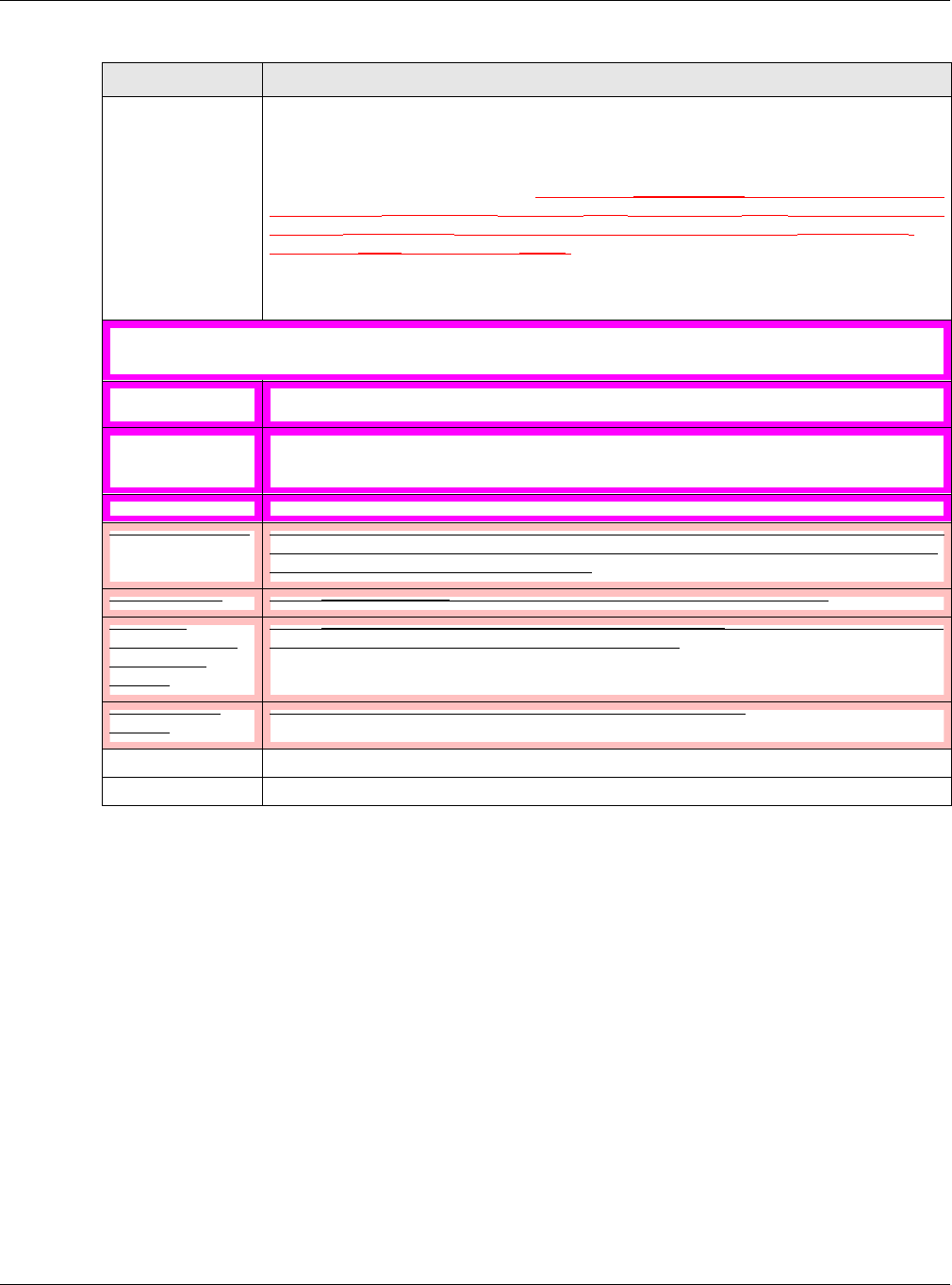
Chapter 10 WAN
EMG2926-Q10A User’s Guide
84
10.5 Advanced WAN Screen
To change your EMG2926-Q10A’s advanced WAN settings, click Network > WAN > Advanced.
The screen appears as shown.
First DNS Server
Second DNS
Server
Third DNS Server
Select Obtained From ISP if your ISP dynamically assigns DNS server information (and
the EMG2926-Q10A's WAN IP address). The field to the right displays the (read-only)
DNS server IP address that the ISP assigns.
Select User-Defined if you have the IP address of a DNS server. Enter the DNS server's
IP address in the field to the right. If you chose User-Defined, but leave the IP address
set to 0.0.0.0, User-Defined changes to None after you click Apply. If you set a second
choice to User-Defined, and enter the same IP address, the second User-Defined
changes to None after you click Apply.
Select None if you do not want to configure DNS servers. If you do not configure a DNS
server, you must know the IP address of a computer in order to access it.
IPv6 DNS server
This is not available when you select IPv4 Only in the IPv6/IPv4 field.
Obtain IPv6 DNS
info Automatically
Select this to have the EMG2926-Q10A get the IPv6 DNS server addresses from the ISP
automatically.
Use the following
Static DNS IPv6
Address
Select this to have the EMG2926-Q10A use the IPv6 DNS server addresses you configure
manually.
IPv6 DNS Server Enter the IPv6 DNS server address assigned by the ISP.
WAN MAC Address The MAC address section allows users to configure the WAN port's MAC address by using
the EMG2926-Q10A’s MAC address, copying the MAC address from a computer on your
LAN or manually entering a MAC address.
Factory default Select Factory default to use the factory assigned default MAC Address.
Clone the
computer’s MAC
address - IP
Address
Select Clone the computer's MAC address - IP Address and enter the IP address of
the computer on the LAN whose MAC you are cloning.
Set WAN MAC
Address
Select this option and enter the MAC address you want to use.
Apply Click Apply to save your changes back to the EMG2926-Q10A.
Cancel Click Cancel to begin configuring this screen afresh.
Table 28 Network > WAN > Internet Connection: PPPoE Encapsulation (continued)
LABEL DESCRIPTION
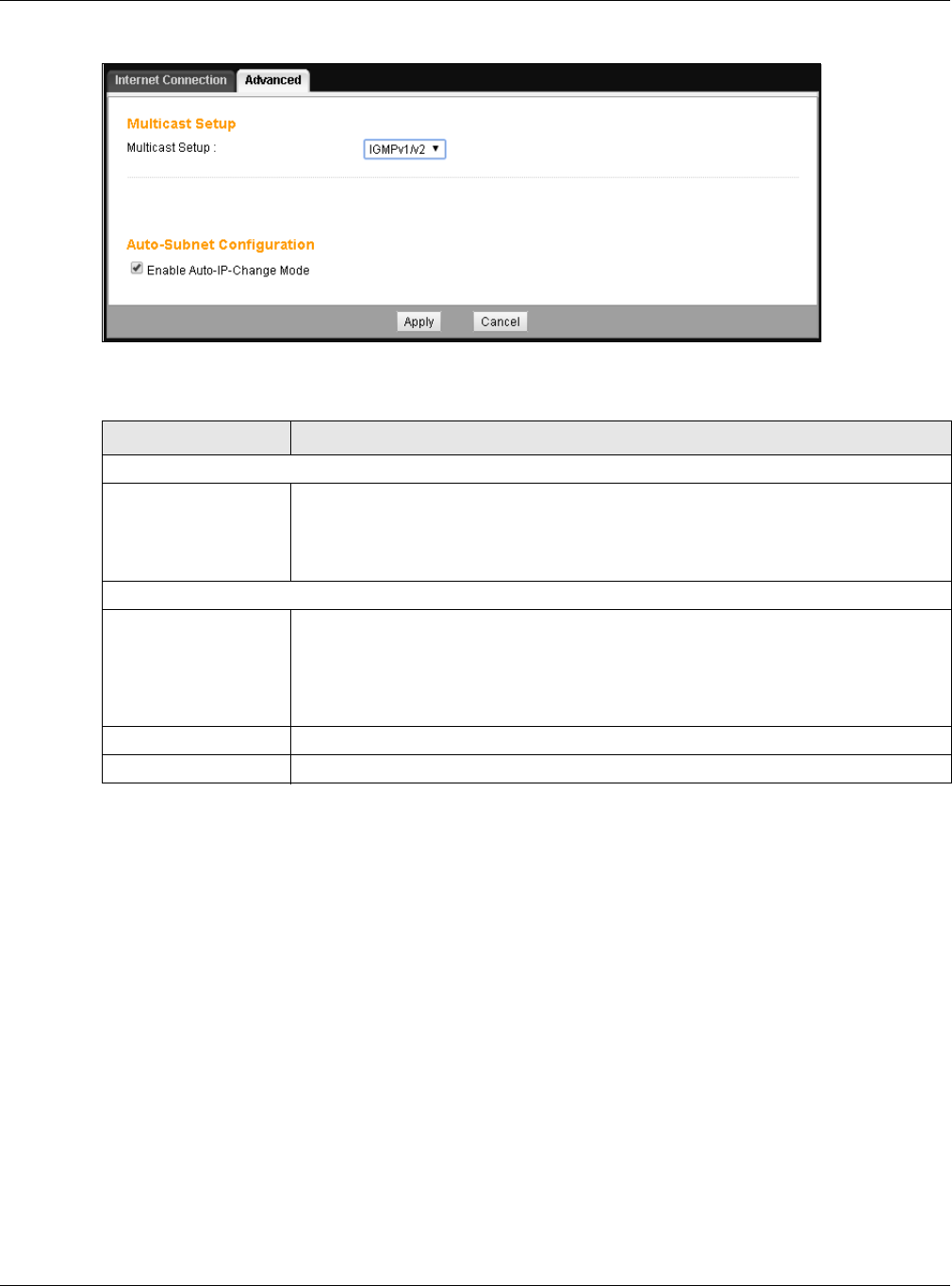
Chapter 10 WAN
EMG2926-Q10A User’s Guide
85
Figure 53 Network > WAN > Advanced
The following table describes the labels in this screen.
Table 29 Network > WAN > Advanced
LABEL DESCRIPTION
Multicast Setup
Multicast Select IGMPv1/v2 to enable multicasting. This applies to traffic routed from the
WAN to the LAN.
Select None to disable this feature. This may cause incoming traffic to be dropped or
sent to all connected network devices.
Auto-Subnet Configuration
Enable Auto-IP-
Change mode
Select this option to have the EMG2926-Q10A change its LAN IP address to 10.0.0.1
or 192.168.0.1 accordingly when the EMG2926-Q10A gets a dynamic WAN IP
address in the same subnet as the LAN IP address 192.168.0.1 or 10.0.0.1.
The NAT, DHCP server and firewall functions on the EMG2926-Q10A are still available
in this mode.
Apply Click Apply to save your changes back to the EMG2926-Q10A.
Cancel Click Cancel to begin configuring this screen afresh.
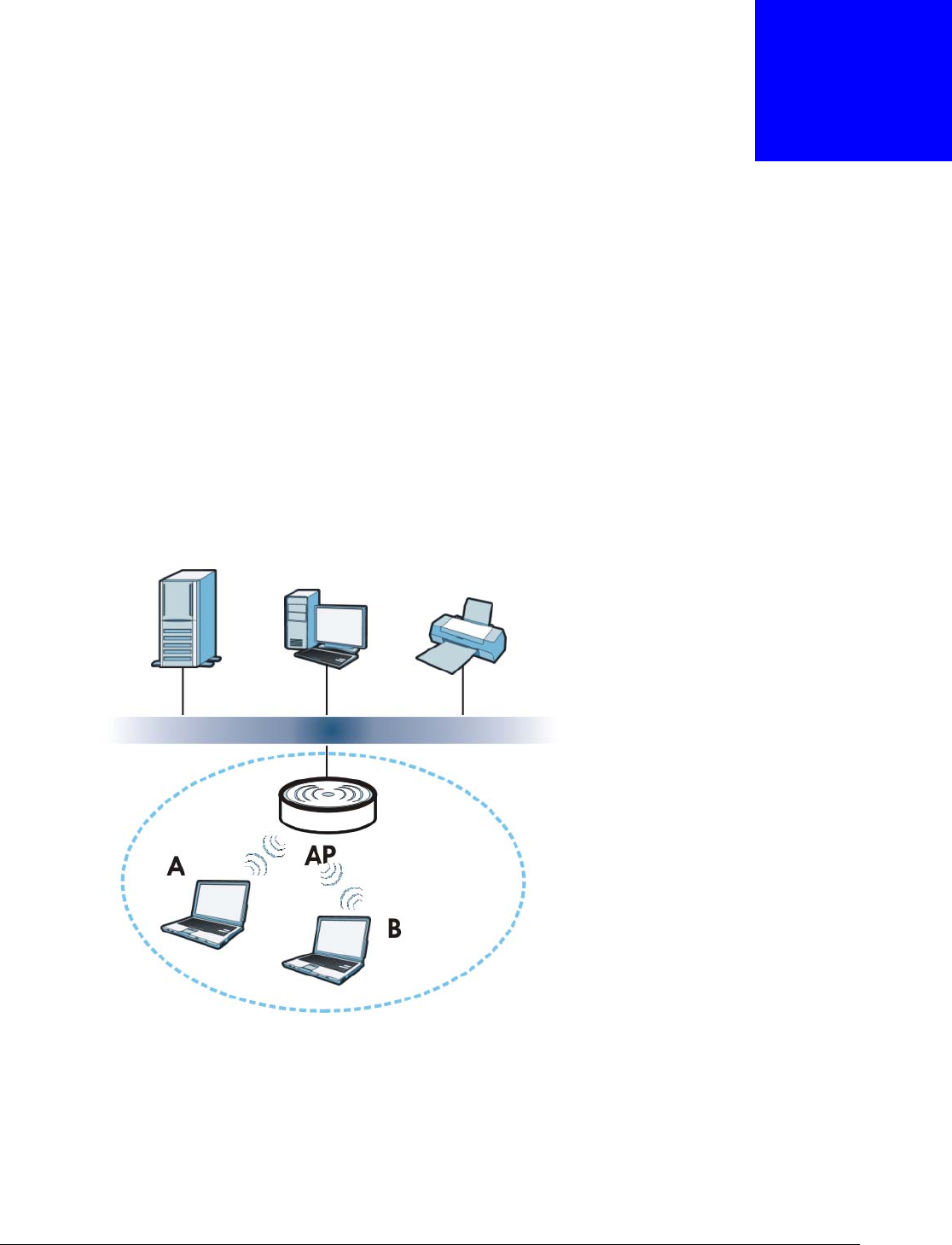
EMG2926-Q10A User’s Guide
86
CHAPTER 11
Wireless LAN
11.1 Overview
This chapter discusses how to configure the wireless network settings in your EMG2926-Q10A. The
EMG2926-Q10A is able to function both 2.4GHz and 5GHz network at the same time. You can have
different wireless and wireless security settings for 2.4GHz and 5GHz wireless LANs. Click
Configuration > Network > Wireless LAN 2.4G or Wireless LAN 5G to configure to do so.
See the appendices for more detailed information about wireless networks.
The following figure provides an example of a wireless network.
Figure 54 Example of a Wireless Network
The wireless network is the part in the blue circle. In this wireless network, devices A and B are
called wireless clients. The wireless clients use the access point (AP) to interact with other devices
(such as the printer) or with the Internet. Your EMG2926-Q10A is the AP.

Chapter 11 Wireless LAN
EMG2926-Q10A User’s Guide
87
11.1.1 What You Can Do
•Use the General screen to turn the wireless connection on or off, set up wireless security
between the EMG2926-Q10A and the wireless clients, and make other basic configuration
changes (Section 11.2 on page 91).
•Use the More AP screen to set up multiple wireless networks on your EMG2926-Q10A (Section
11.4 on page 99).
•Use the MAC Filter screen to allow or deny wireless stations based on their MAC addresses from
connecting to the EMG2926-Q10A (Section 11.5 on page 102).
•Use the Advanced screen to allow intra-BSS networking and set the RTS/CTS Threshold (Section
11.6 on page 104).
•Use the QoS screen to ensure Quality of Service (QoS) in your wireless network (Section 11.7 on
page 105).
•Use the WPS screen to quickly set up a wireless network with strong security, without having to
configure security settings manually (Section 11.8 on page 105).
•Use the WPS Station screen to add a wireless station using WPS (Section 11.9 on page 107).
•Use the Scheduling screen to set the times your wireless LAN is turned on and off (Section
11.10 on page 107).
11.1.2 What You Should Know
Every wireless network must follow these basic guidelines.
• Every wireless client in the same wireless network must use the same SSID.
The SSID is the name of the wireless network. It stands for Service Set IDentity.
• If two wireless networks overlap, they should use different channels.
Like radio stations or television channels, each wireless network uses a specific channel, or
frequency, to send and receive information.
• Every wireless client in the same wireless network must use security compatible with the AP.
Security stops unauthorized devices from using the wireless network. It can also protect the
information that is sent in the wireless network.
Wireless Security Overview
The following sections introduce different types of wireless security you can set up in the wireless
network.
SSID
Normally, the AP acts like a beacon and regularly broadcasts the SSID in the area. You can hide the
SSID instead, in which case the AP does not broadcast the SSID. In addition, you should change
the default SSID to something that is difficult to guess.
This type of security is fairly weak, however, because there are ways for unauthorized devices to
get the SSID. In addition, unauthorized devices can still see the information that is sent in the
wireless network.

Chapter 11 Wireless LAN
EMG2926-Q10A User’s Guide
88
MAC Address Filter
Every wireless client has a unique identification number, called a MAC address.1 A MAC address is
usually written using twelve hexadecimal characters2; for example, 00A0C5000002 or
00:A0:C5:00:00:02. To get the MAC address for each wireless client, see the appropriate User’s
Guide or other documentation.
You can use the MAC address filter to tell the AP which wireless clients are allowed or not allowed to
use the wireless network. If a wireless client is allowed to use the wireless network, it still has to
have the correct settings (SSID, channel, and security). If a wireless client is not allowed to use the
wireless network, it does not matter if it has the correct settings.
This type of security does not protect the information that is sent in the wireless network.
Furthermore, there are ways for unauthorized devices to get the MAC address of an authorized
wireless client. Then, they can use that MAC address to use the wireless network.
User Authentication
You can make every user log in to the wireless network before they can use it. This is called user
authentication. However, every wireless client in the wireless network has to support IEEE 802.1x
to do this.
For wireless networks, there are two typical places to store the user names and passwords for each
user.
• In the AP: this feature is called a local user database or a local database.
• In a RADIUS server: this is a server used in businesses more than in homes.
If your AP does not provide a local user database and if you do not have a RADIUS server, you
cannot set up user names and passwords for your users.
Unauthorized devices can still see the information that is sent in the wireless network, even if they
cannot use the wireless network. Furthermore, there are ways for unauthorized wireless users to
get a valid user name and password. Then, they can use that user name and password to use the
wireless network.
Local user databases also have an additional limitation that is explained in the next section.
Encryption
Wireless networks can use encryption to protect the information that is sent in the wireless
network. Encryption is like a secret code. If you do not know the secret code, you cannot
understand the message.
1. Some wireless devices, such as scanners, can detect wireless networks but cannot use wireless networks. These kinds
of wireless devices might not have MAC addresses.
2. Hexadecimal characters are 0, 1, 2, 3, 4, 5, 6, 7, 8, 9, A, B, C, D, E, and F.

Chapter 11 Wireless LAN
EMG2926-Q10A User’s Guide
89
The types of encryption you can choose depend on the type of user authentication. (See page 88
for information about this.)
For example, if the wireless network has a RADIUS server, you can choose WPA or WPA2. If users
do not log in to the wireless network, you can choose no encryption, Static WEP, WPA-PSK, or
WPA2-PSK.
Usually, you should set up the strongest encryption that every wireless client in the wireless
network supports. For example, suppose the AP does not have a local user database, and you do
not have a RADIUS server. Therefore, there is no user authentication. Suppose the wireless network
has two wireless clients. Device A only supports WEP, and device B supports WEP and WPA.
Therefore, you should set up Static WEP in the wireless network.
Note: It is recommended that wireless networks use WPA-PSK, WPA, or stronger
encryption. IEEE 802.1x and WEP encryption are better than none at all, but it is
still possible for unauthorized devices to figure out the original information pretty
quickly.
Note: It is not possible to use WPA-PSK, WPA or stronger encryption with a local user
database. In this case, it is better to set up stronger encryption with no
authentication than to set up weaker encryption with the local user database.
When you select WPA2 or WPA2-PSK in your EMG2926-Q10A, you can also select an option
(WPA/WPA-PSK Compatible) to support WPA/WPA-PSK as well. In this case, if some wireless
clients support WPA and some support WPA2, you should set up WPA2-PSK or WPA2 (depending
on the type of wireless network login) and select the WPA/WPA-PSK Compatible option in the
EMG2926-Q10A.
Many types of encryption use a key to protect the information in the wireless network. The longer
the key, the stronger the encryption. Every wireless client in the wireless network must have the
same key.
Guest WLAN
Guest WLAN allows you to set up a wireless network where users can access to Internet via the
EMG2926-Q10A (Z), but not other networks connected to the Z. In the following figure, a guest
user can access the Internet from the guest wireless network A via Z but not the home or company
network N.
Note: The home or company network N and Guest WLAN network are independent
networks.
Note: Only Router mode supports guest WLAN.
Table 30 Types of Encryption for Each Type of Authentication
NO AUTHENTICATION RADIUS SERVER
Weakest No Security WPA
Static WEP
WPA-PSK
Strongest WPA2-PSK WPA2
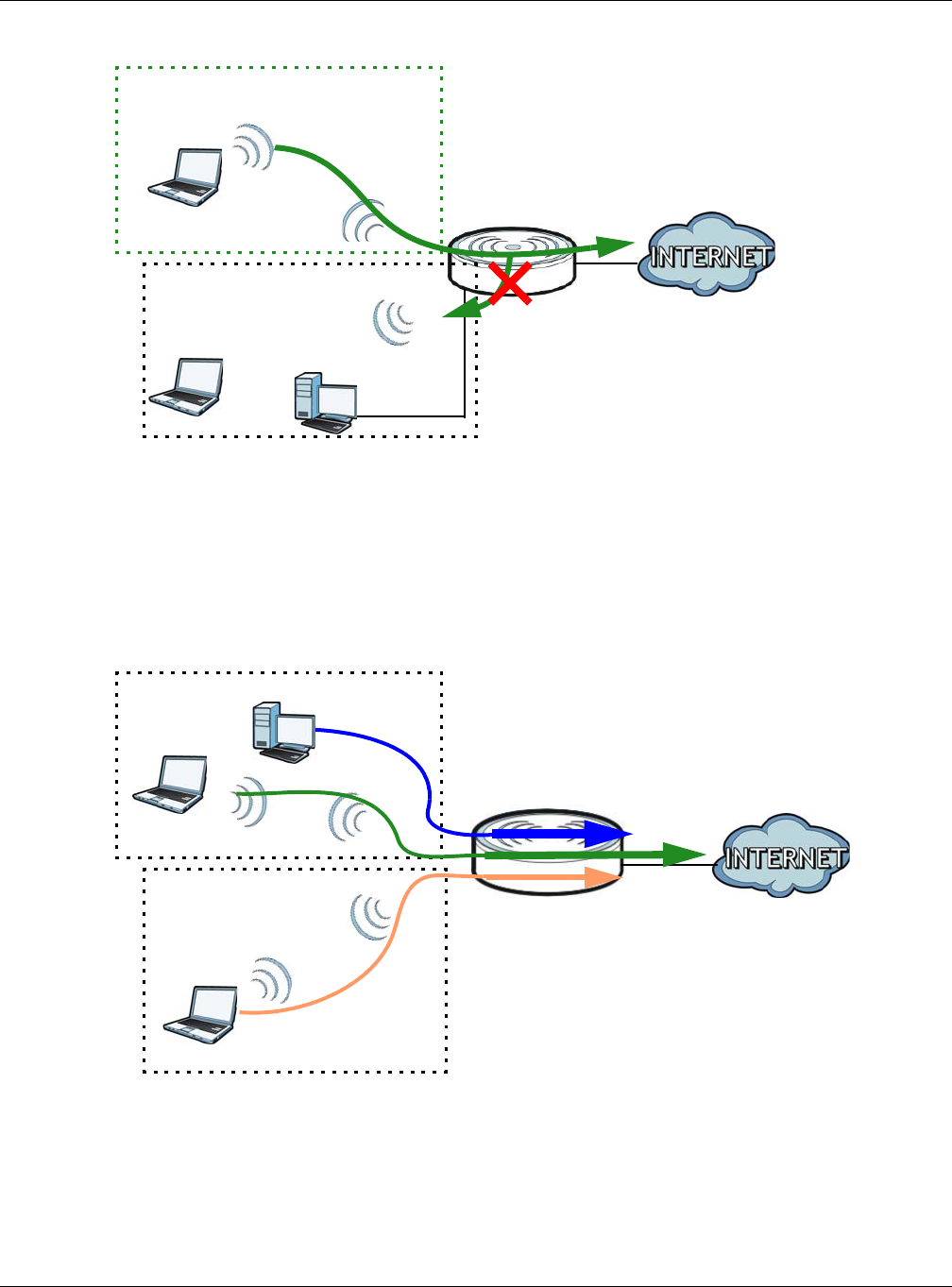
Chapter 11 Wireless LAN
EMG2926-Q10A User’s Guide
90
Figure 55 Guest Wireless LAN Network
Guest WLAN Bandwidth
The Guest WLAN Bandwidth function allows you to restrict the maximum bandwidth for the guest
wireless network. Additionally, you can also define bandwidth for your home or office network. An
example is shown next to define maximum bandwidth for your networks (A is Guest WLAN and N is
home or company network.)
Figure 56 Example: Bandwidth for Different Networks
WPS
WiFi Protected Setup (WPS) is an industry standard specification, defined by the WiFi Alliance. WPS
allows you to quickly set up a wireless network with strong security, without having to configure
security settings manually. Depending on the devices in your network, you can either press a
button (on the device itself, or in its configuration utility) or enter a PIN (Personal Identification
N
A
Z
600 kbps
100 kbps
N
A
300 kbps
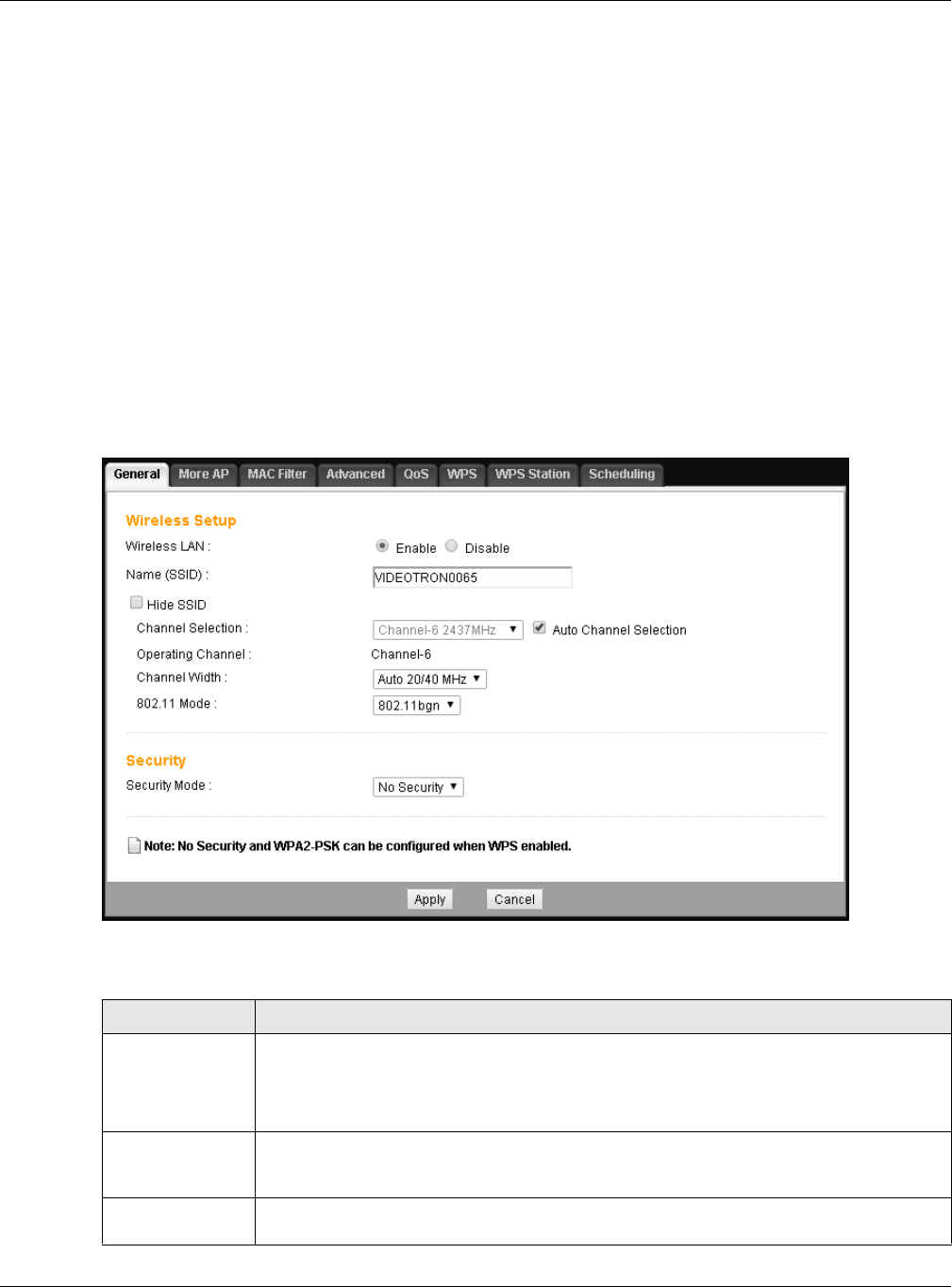
Chapter 11 Wireless LAN
EMG2926-Q10A User’s Guide
91
Number) in the devices. Then, they connect and set up a secure network by themselves. See how
to set up a secure wireless network using WPS in the Section 8.2 on page 57.
11.2 General Wireless LAN Screen
Use this screen to configure the SSID and wireless security of the wireless LAN.
Note: If you are configuring the EMG2926-Q10A from a computer connected to the
wireless LAN and you change the EMG2926-Q10A’s SSID, channel or security
settings, you will lose your wireless connection when you press Apply to confirm.
You must then change the wireless settings of your computer to match the
EMG2926-Q10A’s new settings.
Click Network > Wireless LAN 2.4G/5G to open the General screen.
Figure 57 Network > Wireless LAN 2.4G/5G > General
The following table describes the general wireless LAN labels in this screen.
Table 31 Network > Wireless LAN 2.4G/5G > General
LABEL DESCRIPTION
Wireless LAN Select Enable to activate the 2.4GHz and/or 5GHz wireless LAN. Select Disable to turn it
off.
You can enable or disable both 2.4GHz and 5GHz wireless LANs by using the WIFI button
located on the side panel of the EMG2926-Q10A.
Name (SSID) The SSID (Service Set IDentity) identifies the Service Set with which a wireless client is
associated. Enter a descriptive name (up to 32 printable characters found on a typical
English language keyboard) for the wireless LAN.
Hide SSID Select this check box to hide the SSID in the outgoing beacon frame so a station cannot
obtain the SSID through scanning using a site survey tool.

Chapter 11 Wireless LAN
EMG2926-Q10A User’s Guide
92
Channel Selection Set the operating frequency/channel depending on your particular region.
Select a channel from the drop-down list box. The options vary depending on the
frequency band and the country you are in.
Refer to the Connection Wizard chapter for more information on channels. This option is
only available if Auto Channel Selection is disabled.
Auto Channel
Selection
Select this check box for the EMG2926-Q10A to automatically choose the channel with
the least interference. Deselect this check box if you wish to manually select the channel
using the Channel Selection field.
Operating
Channel
This displays the channel the EMG2926-Q10A is currently using.
Channel Width Select the wireless channel width used by EMG2926-Q10A.
A standard 20MHz channel offers transfer speeds of up to 144Mbps (2.4GHz) or 217Mbps
(5GHZ) whereas a 40MHz channel uses two standard channels and offers speeds of up to
300Mbps (2.4GHz) or 450Mbps (5GHZ). An IEEE 802.11ac-specific 80MHz channel offers
speeds of up to 1.3Gbps.
Because not all devices support 40 MHz and/or 80 MHz channels, select Auto 20/40
MHz or Auto 20/40/80 MHz to allow the EMG2926-Q10A to adjust the channel
bandwidth automatically.
40 MHz (channel bonding or dual channel) bonds two adjacent radio channels to increase
throughput. A 80 MHz channel consists of two adjacent 40 MHz channels. The wireless
clients must also support 40 MHz or 80 MHz. It is often better to use the 20 MHz setting
in a location where the environment hinders the wireless signal.
Select 20 MHz if you want to lessen radio interference with other wireless devices in your
neighborhood or the wireless clients do not support channel bonding.
802.11 Mode If you are in the Wireless LAN 2.4G > General screen, you can select from the
following:
•802.11b: allows either IEEE 802.11b or IEEE 802.11g compliant WLAN devices to
associate with the EMG2926-Q10A. In this mode, all wireless devices can only
transmit at the data rates supported by IEEE 802.11b.
•802.11g: allows IEEE 802.11g compliant WLAN devices to associate with the Device.
IEEE 802.11b compliant WLAN devices can associate with the EMG2926-Q10A only
when they use the short preamble type.
•802.11bg: allows either IEEE 802.11b or IEEE 802.11g compliant WLAN devices to
associate with the EMG2926-Q10A. The EMG2926-Q10A adjusts the transmission rate
automatically according to the wireless standard supported by the wireless devices.
•802.11n: allows IEEE 802.11n compliant WLAN devices to associate with the
EMG2926-Q10A. This can increase transmission rates, although IEEE 802.11b or IEEE
802.11g clients will not be able to connect to the EMG2926-Q10A. I
•802.11gn: allows either IEEE 802.11g or IEEE 802.11n compliant WLAN devices to
associate with the EMG2926-Q10A. The transmission rate of your EMG2926-Q10A
might be reduced.
•802.11 bgn: allows IEEE802.11b, IEEE802.11g and IEEE802.11n compliant WLAN
devices to associate with the EMG2926-Q10A. The transmission rate of your
EMG2926-Q10A might be reduced.
If you are in the Wireless LAN 5G > General screen, you can select from the following:
•802.11a: allows only IEEE 802.11a compliant WLAN devices to associate with the
EMG2926-Q10A.
•802.11an: allows both IEEE802.11n and IEEE802.11a compliant WLAN devices to
associate with the EMG2926-Q10A. The transmission rate of your EMG2926-Q10A
might be reduced.
•802.11ac: allows only IEEE 802.11ac compliant WLAN devices to associate with the
EMG2926-Q10A.
Table 31 Network > Wireless LAN 2.4G/5G > General (continued)
LABEL DESCRIPTION
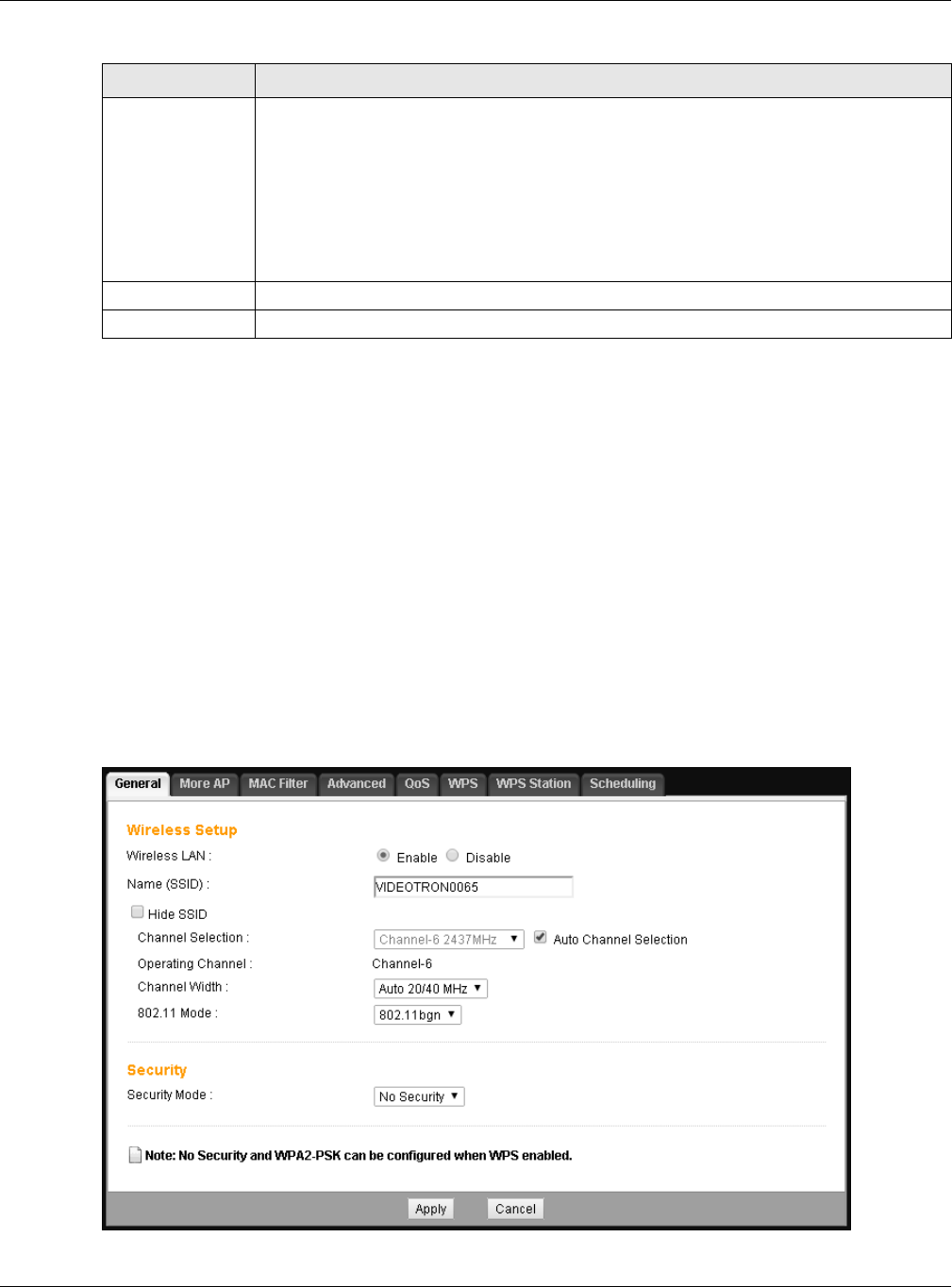
Chapter 11 Wireless LAN
EMG2926-Q10A User’s Guide
93
See the rest of this chapter for information on the other labels in this screen.
11.3 Wireless Security
The screen varies depending on what you select in the Security Mode field.
11.3.1 No Security
Select No Security to allow wireless clients to communicate with the access points without any
data encryption.
Note: If you do not enable any wireless security on your EMG2926-Q10A, your network is
accessible to any wireless networking device that is within range.
Figure 58 Network > Wireless LAN 2.4G/5G > General: No Security
Security Mode Select Static WEP, WPA-PSK, WPA, WPA2-PSK or WPA2 to add security on this
wireless network. The wireless clients which want to associate to this network must have
same wireless security settings as this device. After you select to use a security,
additional options appears in this screen. See Section 11.3 on page 93 for detailed
information on different security modes. Or you can select No Security to allow any
client to associate this network without authentication.
Note: If the WPS function is enabled (default), only No Security and WPA2-PSK are
available in this field.
Apply Click Apply to save your changes back to the EMG2926-Q10A.
Cancel Click Cancel to reload the previous configuration for this screen.
Table 31 Network > Wireless LAN 2.4G/5G > General (continued)
LABEL DESCRIPTION

Chapter 11 Wireless LAN
EMG2926-Q10A User’s Guide
94
The following table describes the labels in this screen.
11.3.2 WEP Encryption
WEP encryption scrambles the data transmitted between the wireless stations and the access points
to keep network communications private. It encrypts unicast and multicast communications in a
network. Both the wireless stations and the access points must use the same WEP key.
Your EMG2926-Q10A allows you to configure up to four 64-bit or 128-bit WEP keys but only one key
can be enabled at any one time.
Select Static WEP from the Security Mode list.
Table 32 Network > Wireless LAN 2.4G/5G > General: No Security
LABEL DESCRIPTION
Security Mode Choose No Security from the drop-down list box.
Apply Click Apply to save your changes back to the EMG2926-Q10A.
Cancel Click Cancel to reload the previous configuration for this screen.
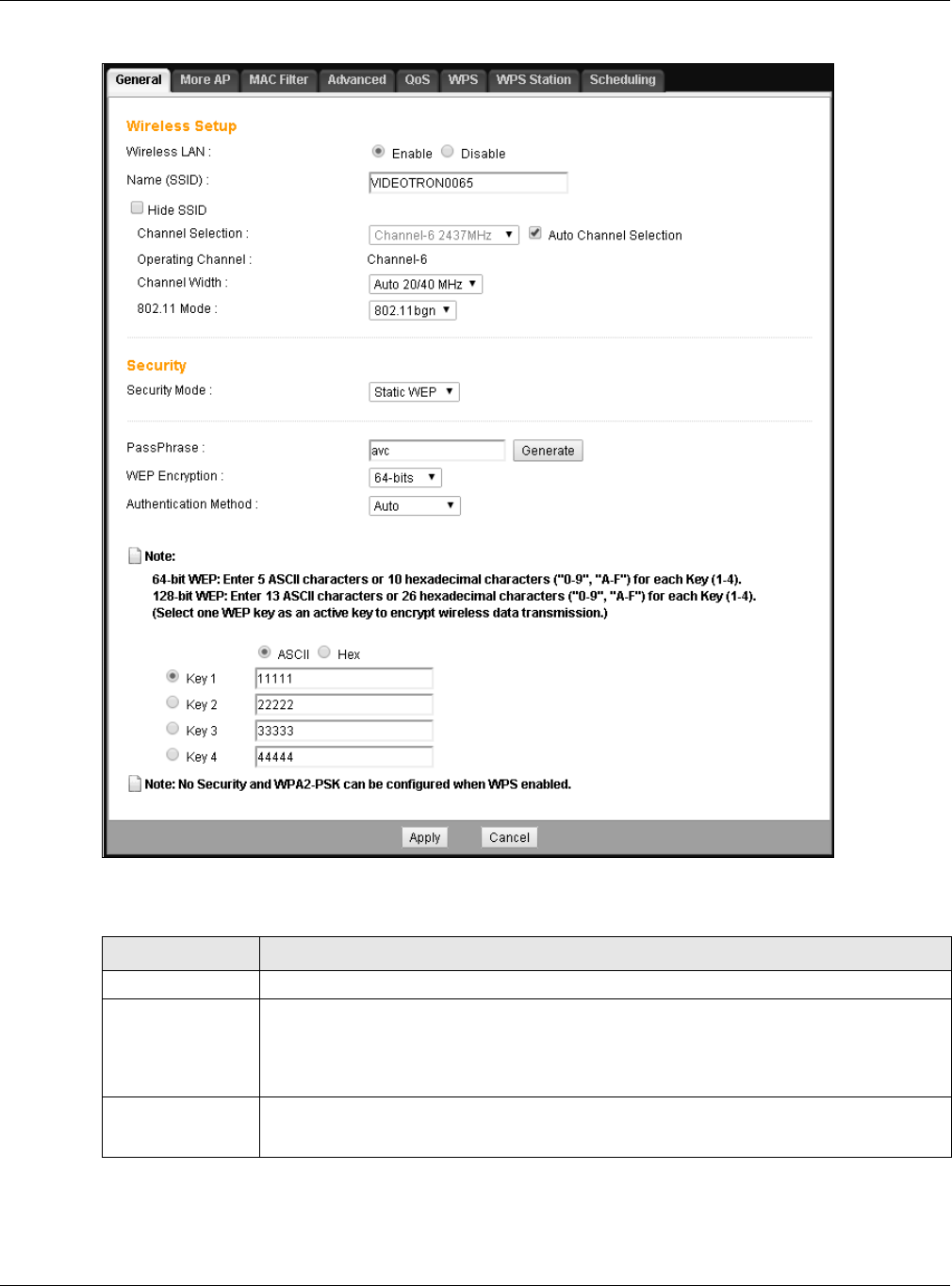
Chapter 11 Wireless LAN
EMG2926-Q10A User’s Guide
95
Figure 59 Network > Wireless LAN 2.4G/5G > General: Static WEP
The following table describes the wireless LAN security labels in this screen.
Table 33 Network > Wireless LAN 2.4G/5G > General: Static WEP
LABEL DESCRIPTION
Security Mode Select Static WEP to enable data encryption.
PassPhrase Enter a Passphrase (up to 26 printable characters) and click Generate.
A passphrase functions like a password. In WEP security mode, it is further converted by
the EMG2926-Q10A into a complicated string that is referred to as the “key”. This key is
requested from all devices wishing to connect to a wireless network.
WEP Encryption Select 64-bits or 128-bits.
This dictates the length of the security key that the network is going to use.
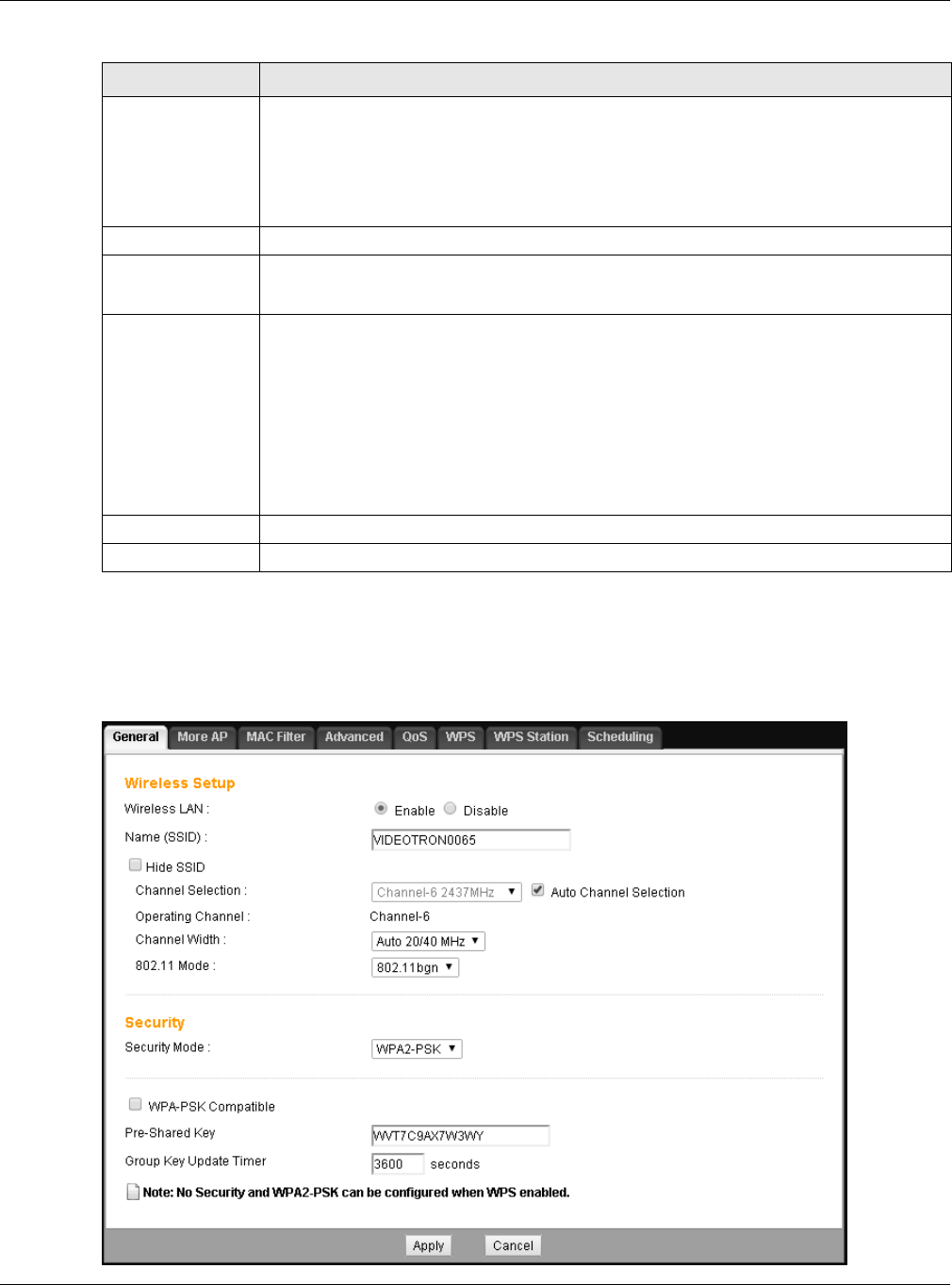
Chapter 11 Wireless LAN
EMG2926-Q10A User’s Guide
96
11.3.3 WPA-PSK/WPA2-PSK
Select WPA-PSK or WPA2-PSK from the Security Mode list.
Figure 60 Network > Wireless LAN 2.4G/5G > General: WPA-PSK/WPA2-PSK
Authentication
Method
Select Auto or Shared Key from the drop-down list box.
This field specifies whether the wireless clients have to provide the WEP key to login to
the wireless client. Keep this setting at Auto unless you want to force a key verification
before communication between the wireless client and the EMG2926-Q10A occurs.
Select Shared Key to force the clients to provide the WEP key prior to communication.
ASCII Select this option in order to enter ASCII characters as WEP key.
Hex Select this option in order to enter hexadecimal characters as a WEP key.
The preceding "0x", that identifies a hexadecimal key, is entered automatically.
Key 1 to Key 4 The WEP keys are used to encrypt data. Both the EMG2926-Q10A and the wireless
stations must use the same WEP key for data transmission.
If you chose 64-bits, then enter any 5 ASCII characters or 10 hexadecimal characters
("0-9", "A-F").
If you chose 128-bits, then enter 13 ASCII characters or 26 hexadecimal characters ("0-
9", "A-F").
You must configure at least one key, only one key can be activated at any one time. The
default key is key 1.
Apply Click Apply to save your changes back to the EMG2926-Q10A.
Cancel Click Cancel to reload the previous configuration for this screen.
Table 33 Network > Wireless LAN 2.4G/5G > General: Static WEP (continued)
LABEL DESCRIPTION

Chapter 11 Wireless LAN
EMG2926-Q10A User’s Guide
97
The following table describes the labels in this screen.
11.3.4 WPA/WPA2
Select WPA or WPA2 from the Security Mode list.
Note: WPA or WPA2 is not available if you enable WPS before you configure WPA or WPA2
in the Wireless LAN 2.4G/5G > General screen.
Table 34 Network > Wireless LAN 2.4G/5G > General: WPA-PSK/WPA2-PSK
LABEL DESCRIPTION
Security Mode Select WPA-PSK or WPA2-PSK to enable data encryption.
WPA-PSK
Compatible
This field appears when you choose WPA2-PSK as the Security Mode.
Check this field to allow wireless devices using WPA-PSK security mode to connect to
your EMG2926-Q10A.
Pre-Shared Key WPA-PSK/WPA2-PSK uses a simple common password for authentication.
Type a pre-shared key from 8 to 63 case-sensitive keyboard characters.
Group Key Update
Timer
The Group Key Update Timer is the rate at which the AP sends a new group key out to
all clients.
The default is 3600 seconds (60 minutes).
Apply Click Apply to save your changes back to the EMG2926-Q10A.
Cancel Click Cancel to reload the previous configuration for this screen.
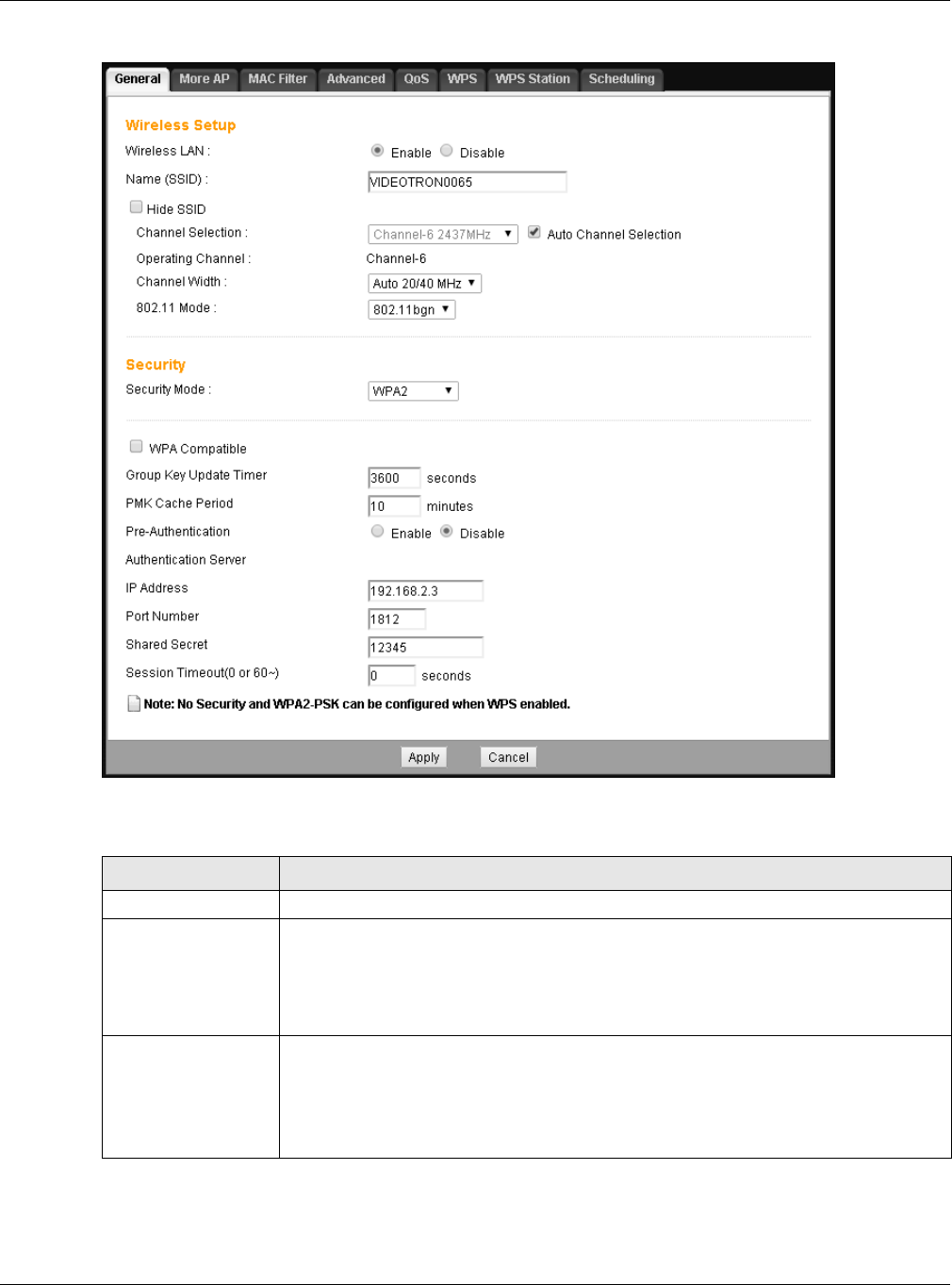
Chapter 11 Wireless LAN
EMG2926-Q10A User’s Guide
98
Figure 61 Network > Wireless LAN 2.4G/5G > General: WPA/WPA2
The following table describes the labels in this screen.
Table 35 Network > Wireless LAN 2.4G/5G > General: WPA/WPA2
LABEL DESCRIPTION
Security Mode Select WPA or WPA2 to enable data encryption.
WPA Compatible This check box is available only when you select WPA2-PSK or WPA2 in the Security
Mode field.
Select the check box to have both WPA2 and WPA wireless clients be able to
communicate with the EMG2926-Q10A even when the EMG2926-Q10A is using WPA2-
PSK or WPA2.
Group Key Update
Timer
The Group Key Update Timer is the rate at which the AP (if using WPA-PSK/
WPA2-PSK key management) or RADIUS server (if using WPA/WPA2 key
management) sends a new group key out to all clients. The re-keying process is the
WPA/WPA2 equivalent of automatically changing the WEP key for an AP and all
stations in a WLAN on a periodic basis. Setting of the Group Key Update Timer is
also supported in WPA-PSK/WPA2-PSK mode.

Chapter 11 Wireless LAN
EMG2926-Q10A User’s Guide
99
11.4 More AP Screen
This screen allows you to enable and configure multiple wireless networks and guest wireless
network settings on the EMG2926-Q10A.
You can configure up to four SSIDs to enable multiple BSSs (Basic Service Sets) on the EMG2926-
Q10A. This allows you to use one access point to provide several BSSs simultaneously. You can then
assign varying security types to different SSIDs. Wireless clients can use different SSIDs to
associate with the same access point.
Click Network > Wireless LAN 2.4G/5G > More AP. The following screen displays.
PMK Cache Period This field is available only when you select WPA2.
Specify how often wireless clients have to resend usernames and passwords in order
to stay connected. Enter a time interval between 10 and 999999 minutes.
Note: If wireless client authentication is done using a RADIUS server, the
reauthentication timer on the RADIUS server has priority.
Pre-Authentication This field is available only when you select WPA2.
Pre-authentication enables fast roaming by allowing the wireless client (already
connecting to an AP) to perform IEEE 802.1x authentication with another AP before
connecting to it. Select Enable to turn on preauthentication in WAP2. Otherwise,
select Disable.
Authentication Server
IP Address Enter the IP address of the external authentication server in dotted decimal notation.
Port Number Enter the port number of the external authentication server.
You need not change this value unless your network administrator instructs you to do
so with additional information.
Shared Secret Enter a password (up to 127 alphanumeric characters) as the key to be shared
between the external authentication server and the EMG2926-Q10A.
The key must be the same on the external authentication server and your EMG2926-
Q10A. The key is not sent over the network.
Session Timeout The EMG2926-Q10A automatically disconnects a wireless client from the wireless and
wired networks after a period of inactivity. The wireless client needs to send the
username and password again before it can use the wireless and wired networks
again. Some wireless clients may prompt users for a username and password; other
clients may use saved login credentials. In either case, there is usually a short delay
while the wireless client logs in to the wireless network again.
Enter the time in seconds from 0 to 999999.
Apply Click Apply to save your changes back to the EMG2926-Q10A.
Cancel Click Cancel to reload the previous configuration for this screen.
Table 35 Network > Wireless LAN 2.4G/5G > General: WPA/WPA2 (continued)
LABEL DESCRIPTION
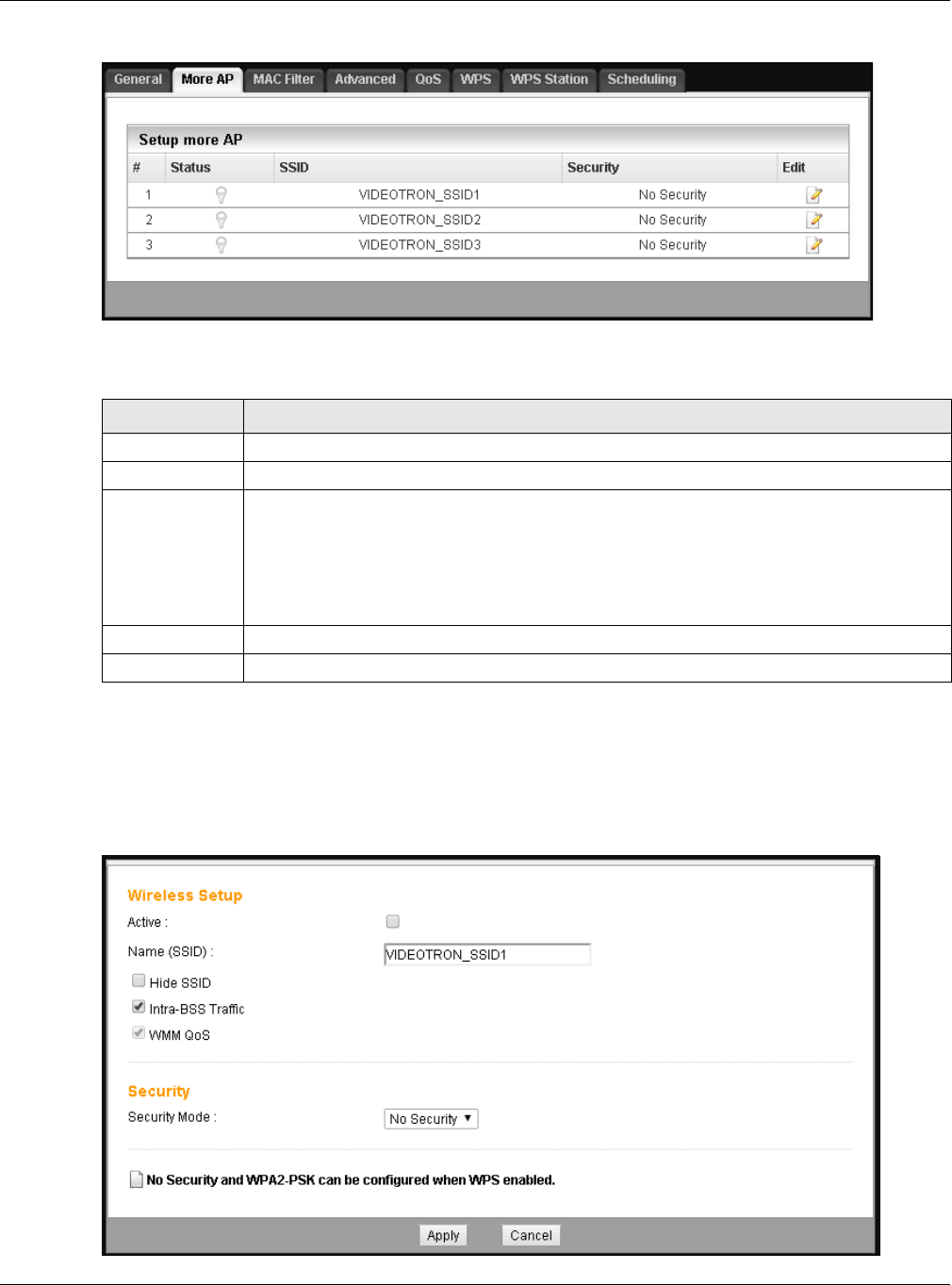
Chapter 11 Wireless LAN
EMG2926-Q10A User’s Guide
100
Figure 62 Network > Wireless LAN 2.4G/5G > More AP
The following table describes the labels in this screen.
11.4.1 More AP Edit
Use this screen to edit an SSID profile. Click the Edit icon next to an SSID in the More AP screen.
The following screen displays.
Figure 63 Network > Wireless LAN 2.4G/5G > More AP: Edit
Table 36 Network > Wireless LAN 2.4G/5G > More AP
LABEL DESCRIPTION
#This is the index number of each SSID profile.
Status This shows whether the SSID profile is active (a yellow bulb) or not (a gray bulb).
SSID An SSID profile is the set of parameters relating to one of the EMG2926-Q10A’s BSSs. The
SSID (Service Set IDentifier) identifies the Service Set with which a wireless device is
associated.
This field displays the name of the wireless profile on the network. When a wireless client
scans for an AP to associate with, this is the name that is broadcast and seen in the
wireless client utility.
Security This field indicates the security mode of the SSID profile.
Edit Click the Edit icon to configure the SSID profile.
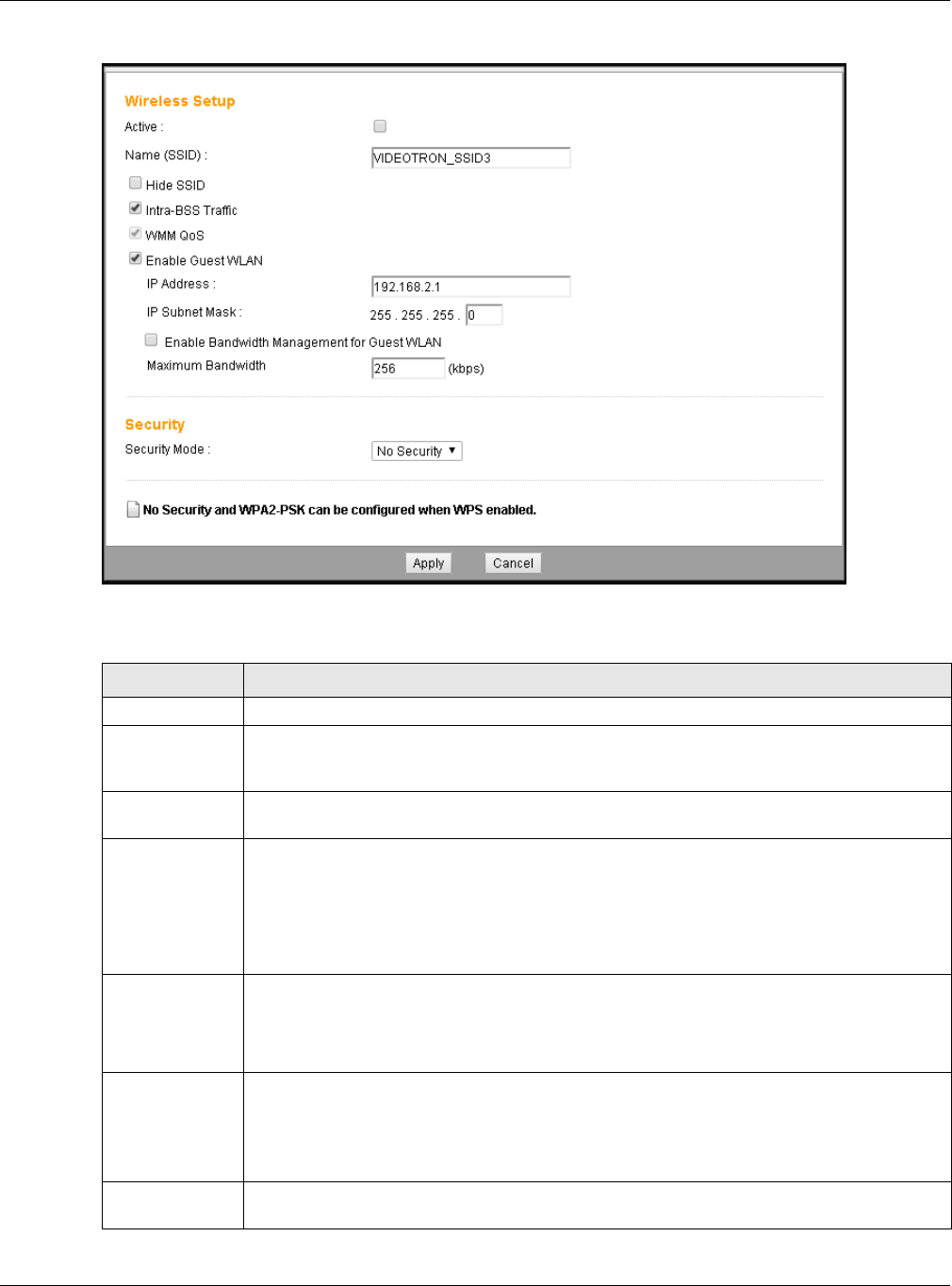
Chapter 11 Wireless LAN
EMG2926-Q10A User’s Guide
101
Figure 64 Network > Wireless LAN 2.4G/5G > More AP: Edit (the last SSID)
The following table describes the labels in this screen.
Table 37 Network > Wireless LAN 2.4G/5G > More AP: Edit
LABEL DESCRIPTION
Active Select this to activate the SSID profile.
Name (SSID) The SSID (Service Set IDentity) identifies the Service Set with which a wireless client is
associated. Enter a descriptive name (up to 32 printable characters found on a typical
English language keyboard) for the wireless LAN.
Hide SSID Select this check box to hide the SSID in the outgoing beacon frame so a station cannot
obtain the SSID through scanning using a site survey tool.
Intra-BSS Traffic A Basic Service Set (BSS) exists when all communications between wireless clients or
between a wireless client and a wired network client go through one access point (AP).
Intra-BSS traffic is traffic between wireless clients in the BSS. When Intra-BSS is enabled,
wireless clients can access the wired network and communicate with each other. When
Intra-BSS is disabled, wireless clients can still access the wired network but cannot
communicate with each other.
WMM QoS Check this to have the EMG2926-Q10A automatically give a service a priority level
according to the ToS value in the IP header of packets it sends.
WMM QoS (Wifi MultiMedia Quality of Service) gives high priority to voice and video, which
makes them run more smoothly.
Enable Guest
WLAN
Select the check box to activate guest wireless LAN. This is available only for the last SSID
on the EMG2926-Q10A.
Note: Only Router mode supports guest WLAN. AP mode, Universal Repeater mode, WISP
mode and WISP + Universal Repeater mode don’t support guest WLAN.
IP Address Type an IP address for the devices on the Guest WLAN using this as the gateway IP
address.

Chapter 11 Wireless LAN
EMG2926-Q10A User’s Guide
102
11.5 MAC Filter Screen
The MAC filter screen allows you to configure the EMG2926-Q10A to give exclusive access to
devices (Allow) or exclude devices from accessing the EMG2926-Q10A (Deny). Every Ethernet
device has a unique MAC (Media Access Control) address. The MAC address is assigned at the
factory and consists of six pairs of hexadecimal characters, for example, 00:A0:C5:00:00:02. You
need to know the MAC address of the devices to configure this screen.
To change your EMG2926-Q10A’s MAC filter settings, click Network > Wireless LAN 2.4G/5G >
MAC Filter. The screen appears as shown.
IP Subnet
Mask Type the subnet mask for the guest wireless LAN.
Enable
Bandwidth
Management
for Guest
WLAN
Select this to turn on bandwidth management for the Guest WLAN network.
Maximum
Bandwidth Enter a number to specify maximum bandwidth the Guest WLAN network can use.
Security Mode Select Static WEP, WPA-PSK, WPA, WPA2-PSK or WPA2 to add security on this
wireless network. The wireless clients which want to associate to this network must have
same wireless security settings as this device. After you select to use a security, additional
options appears in this screen. See Section 11.3 on page 93 for detailed information on
different security modes. Or you can select No Security to allow any client to associate
this network without authentication.
Note: If the WPS function is enabled (default), only No Security and WPA2-PSK are
available in this field.
Apply Click Apply to save your changes back to the EMG2926-Q10A.
Cancel Click Cancel to reload the previous configuration for this screen.
Table 37 Network > Wireless LAN 2.4G/5G > More AP: Edit (continued)
LABEL DESCRIPTION
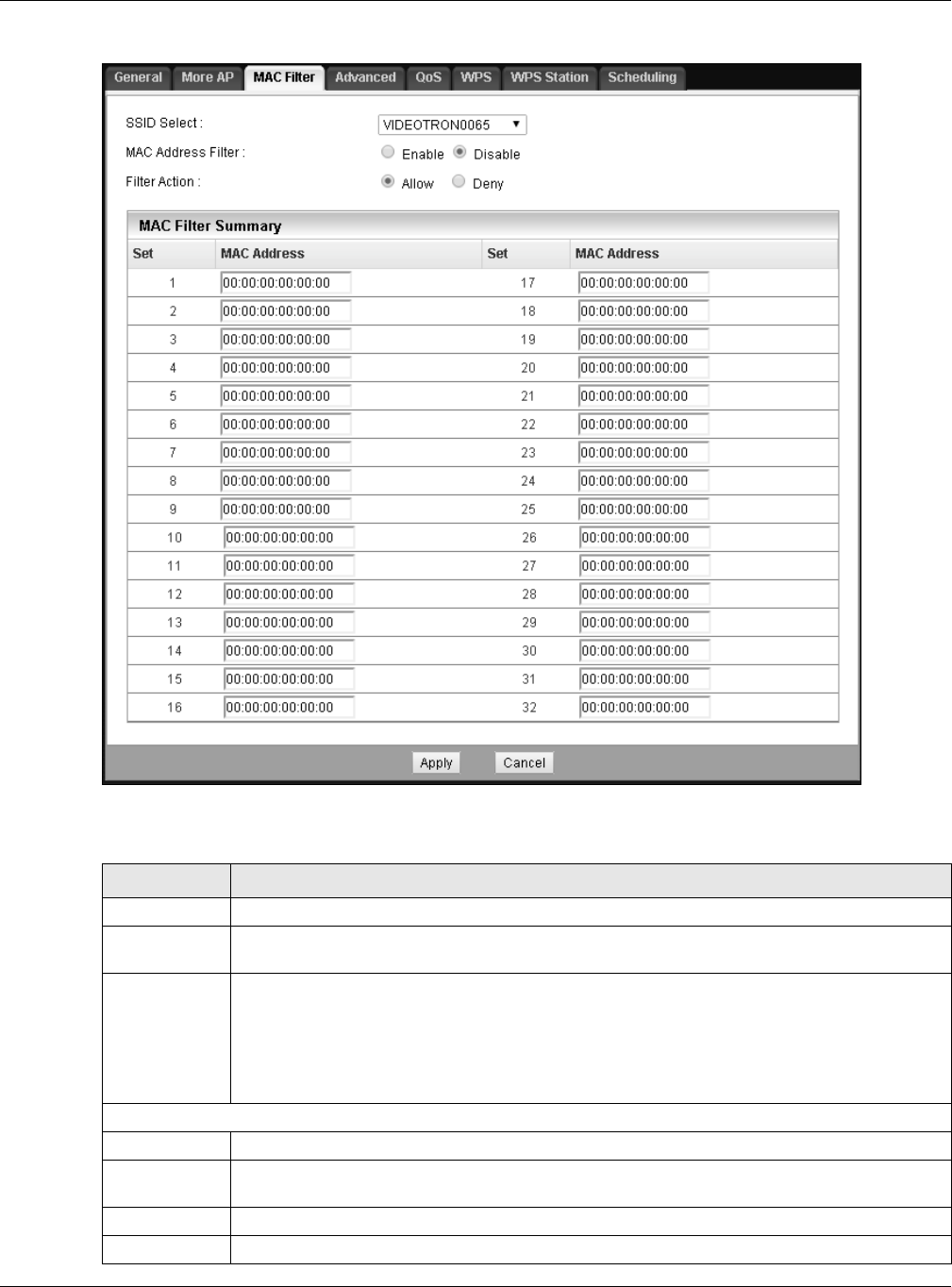
Chapter 11 Wireless LAN
EMG2926-Q10A User’s Guide
103
Figure 65 Network > Wireless LAN 2.4G/5G > MAC Filter
The following table describes the labels in this menu.
Table 38 Network > Wireless LAN 2.4G/5G > MAC Filter
LABEL DESCRIPTION
SSID Select Select the SSID for which you want to configure MAC filtering.
MAC Address
Filter
Select to turn on (Enable) or off (Disable) MAC address filtering.
Filter Action Define the filter action for the list of MAC addresses in the MAC Filter Summary table.
Select Allow to permit access to the EMG2926-Q10A, MAC addresses not listed will be
denied access to the EMG2926-Q10A.
Select Deny to block access to the EMG2926-Q10A, MAC addresses not listed will be allowed
to access the EMG2926-Q10A.
MAC Filter Summary
Set This is the index number of the MAC address.
MAC Address Enter the MAC address of the wireless station that are allowed or denied access to the
EMG2926-Q10A.
Apply Click Apply to save your changes back to the EMG2926-Q10A.
Cancel Click Cancel to reload the previous configuration for this screen.
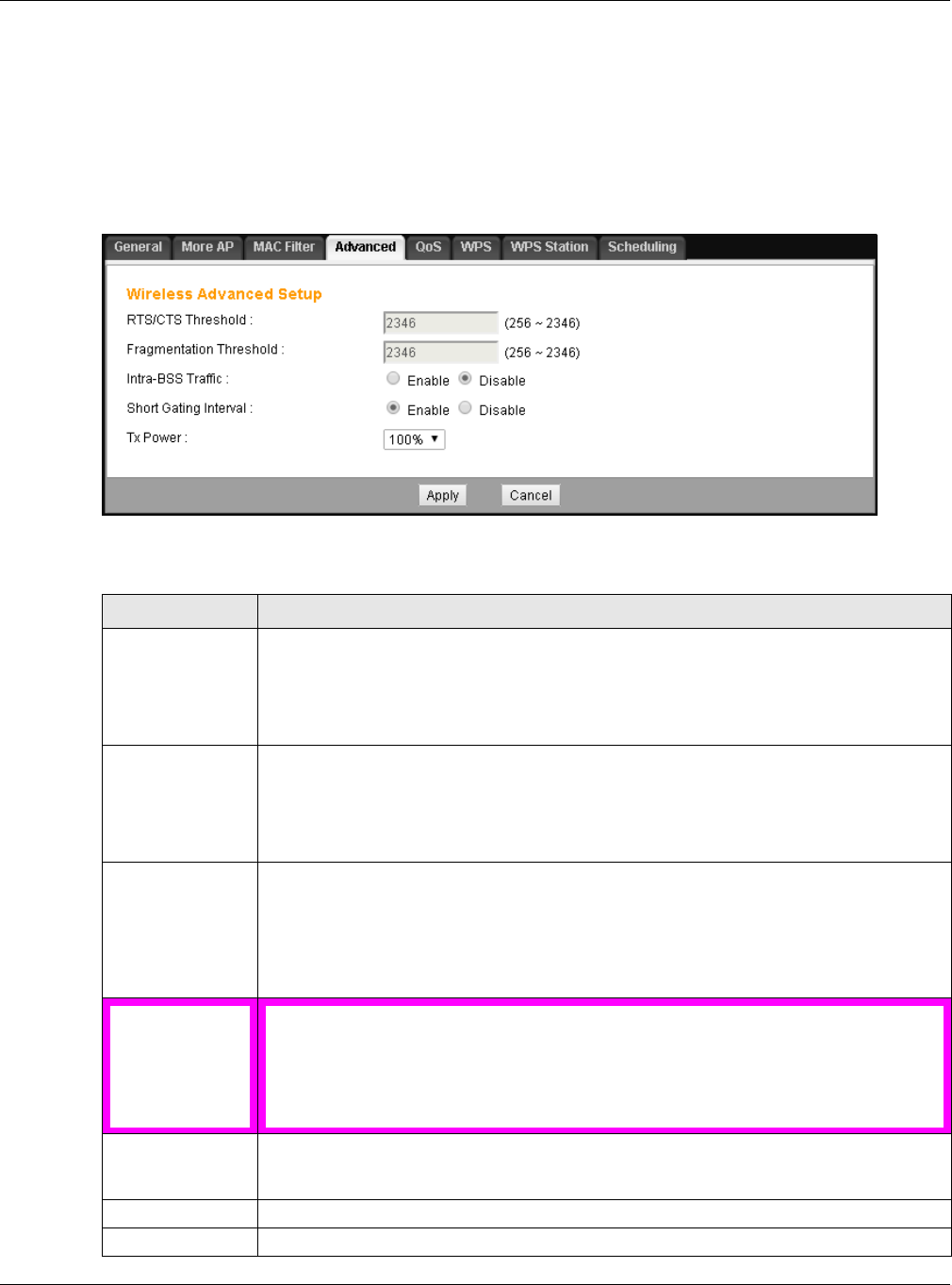
Chapter 11 Wireless LAN
EMG2926-Q10A User’s Guide
104
11.6 Wireless LAN Advanced Screen
Use this screen to allow wireless advanced features, such as the output power, RTS/CTS Threshold
settings.
Click Network > Wireless LAN 2.4G/5G > Advanced. The screen appears as shown.
Figure 66 Network > Wireless LAN 2.4G/5G > Advanced
The following table describes the labels in this screen.
Table 39 Network > Wireless LAN 2.4G/5G > Advanced
LABEL DESCRIPTION
RTS/CTS
Threshold
Data with its frame size larger than this value will perform the RTS (Request To Send)/
CTS (Clear To Send) handshake.
This field is not configurable and the EMG2926-Q10A automatically changes to use the
maximum value if you select 802.11n, 802.11an, 802.11gn, 802.11bgn or 802.11ac
in the Wireless LAN 2.4G/5G > General screen.
Fragmentation
Threshold
The threshold (number of bytes) for the fragmentation boundary for directed messages.
It is the maximum data fragment size that can be sent.
This field is not configurable and the EMG2926-Q10A automatically changes to use the
maximum value if you select 802.11n, 802.11an, 802.11gn, 802.11bgn or 802.11ac
in the Wireless LAN 2.4G/5G > General screen.
Intra-BSS Traffic A Basic Service Set (BSS) exists when all communications between wireless clients or
between a wireless client and a wired network client go through one access point (AP).
Intra-BSS traffic is traffic between wireless clients in the BSS. When Intra-BSS is
enabled, wireless clients can access the wired network and communicate with each other.
When Intra-BSS is disabled, wireless clients can still access the wired network but cannot
communicate with each other.
Short Guarding
Interval
The guard interval is the gap introduced between data transmission from users in order
to reduce interference. Reducing the interval increases data transfer rates but also
increases interference. Increasing the interval reduces data transfer rates but also
reduces interference.
Select Enable to use the short guard interval. Otherwise, select Disable to use the long
guard interval.
Tx Power Set the output power of the EMG2926-Q10A in this field. If there is a high density of APs
in an area, decrease the output power of the EMG2926-Q10A to reduce interference with
other APs. Select one of the following 100%, 90%, 75%, 50%, 25% or 10%.
Apply Click Apply to save your changes back to the EMG2926-Q10A.
Cancel Click Cancel to reload the previous configuration for this screen.
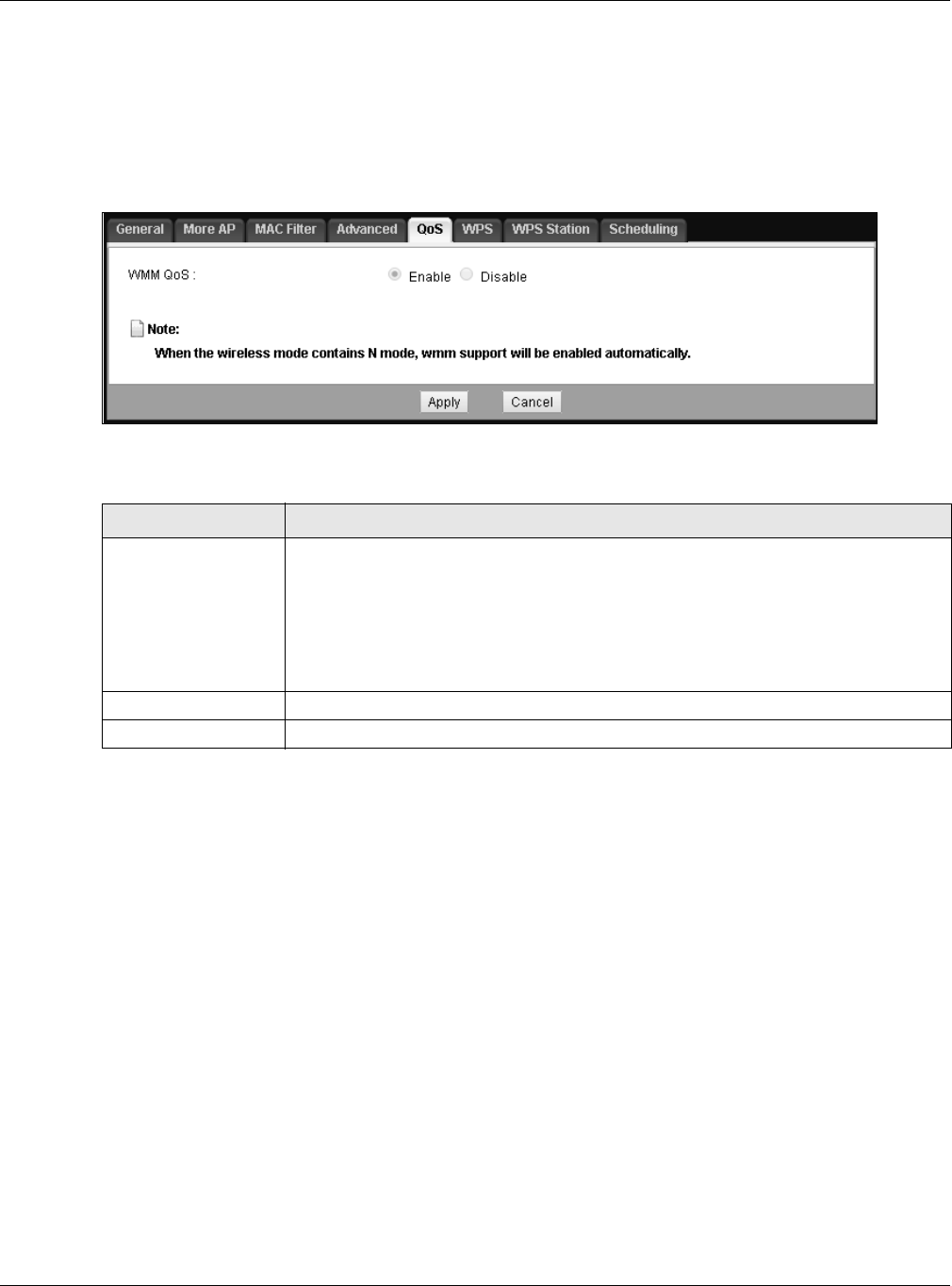
Chapter 11 Wireless LAN
EMG2926-Q10A User’s Guide
105
11.7 Quality of Service (QoS) Screen
The QoS screen allows you to automatically give a service (such as VoIP and video) a priority level.
Click Network > Wireless LAN 2.4G/5G > QoS. The following screen appears.
Figure 67 Network > Wireless LAN 2.4G/5G > QoS
The following table describes the labels in this screen.
11.8 WPS Screen
Use this screen to enable/disable WPS, view or generate a new PIN number and check current WPS
status. To open this screen, click Network > Wireless LAN 2.4G/5G > WPS.
Note: With WPS, wireless clients can only connect to the wireless network using the first
SSID on the EMG2926-Q10A.
Table 40 Network > Wireless LAN 2.4G/5G > QoS
LABEL DESCRIPTION
WMM QoS Select Enable to have the EMG2926-Q10A automatically give a service a priority level
according to the ToS value in the IP header of packets it sends. WMM QoS (Wifi
MultiMedia Quality of Service) gives high priority to voice and video, which makes
them run more smoothly.
This field is not configurable and the EMG2926-Q10A automatically enables WMM QoS
if you select 802.11n, 802.11an, 802.11gn, 802.11bgn or 802.11ac in the
Wireless LAN 24G/5G > General screen.
Apply Click Apply to save your changes to the EMG2926-Q10A.
Cancel Click Cancel to reload the previous configuration for this screen.
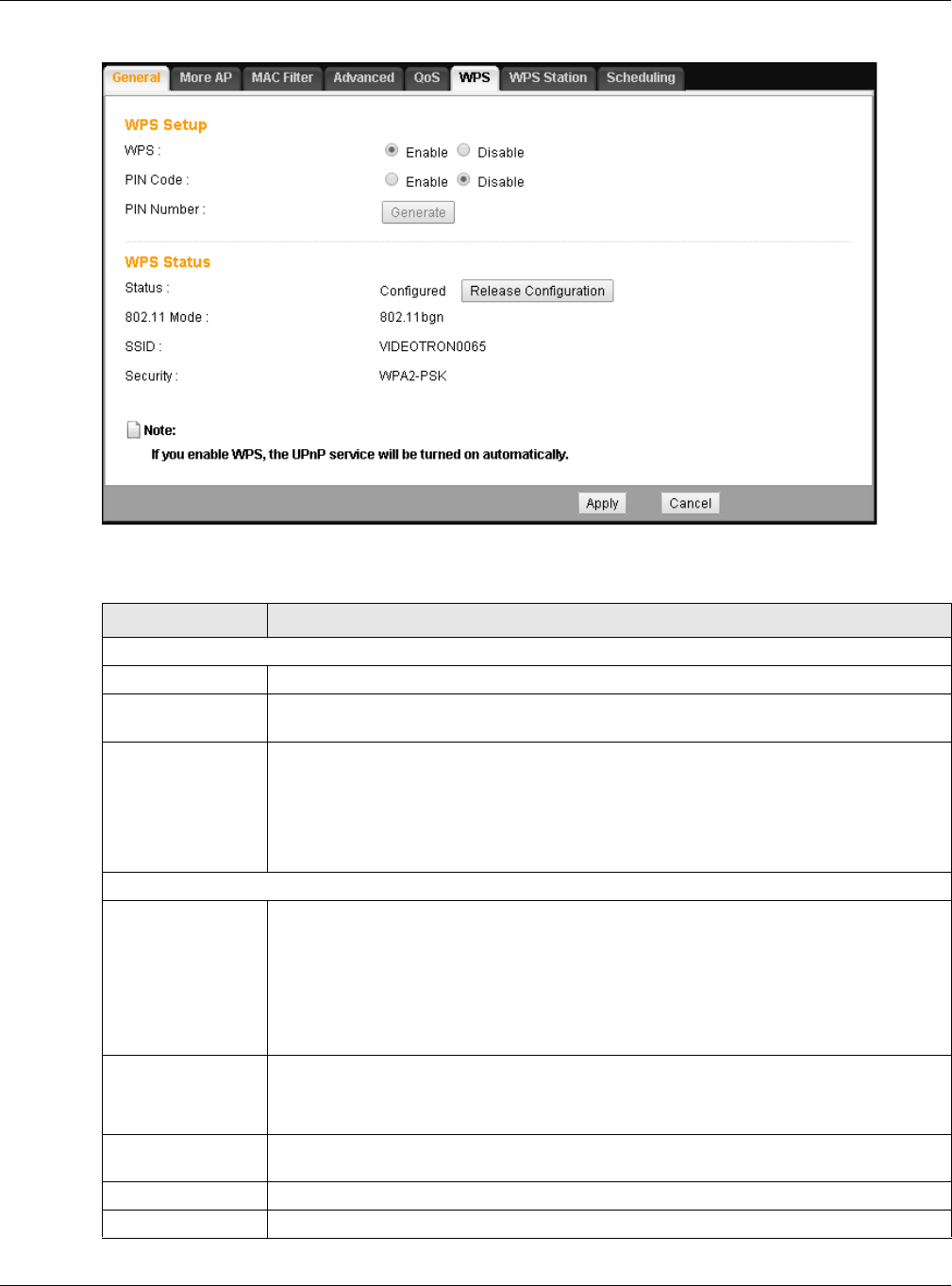
Chapter 11 Wireless LAN
EMG2926-Q10A User’s Guide
106
Figure 68 Network > Wireless LAN 2.4G/5G > WPS
The following table describes the labels in this screen.
Table 41 Network > Wireless LAN 2.4G/5G > WPS
LABEL DESCRIPTION
WPS Setup
WPS Select Enable to turn on the WPS feature. Otherwise, select Disable.
PIN Code Select Enable and click Apply to allow the PIN Configuration method. If you select
Disable, you cannot create a new PIN number.
PIN Number This is the WPS PIN (Personal Identification Number) of the EMG2926-Q10A. Enter this
PIN in the configuration utility of the device you want to connect to the EMG2926-Q10A
using WPS.
The PIN is not necessary when you use WPS push-button method.
Click Generate to generate a new PIN number.
WPS Status
Status This displays Configured when the EMG2926-Q10A has connected to a wireless
network using WPS or when WPS Enable is selected and wireless or wireless security
settings have been changed. The current wireless and wireless security settings also
appear in the screen.
This displays Unconfigured if WPS is disabled and there are no wireless or wireless
security changes on the EMG2926-Q10A or you click Release Configuration to remove
the configured wireless and wireless security settings.
Release
Configuration
This button is only available when the WPS status displays Configured.
Click this button to remove all configured wireless and wireless security settings for WPS
connections on the EMG2926-Q10A.
802.11 Mode This is the 802.11 mode used. Only compliant WLAN devices can associate with the
EMG2926-Q10A.
SSID This is the name of the wireless network (the EMG2926-Q10A’s first SSID).
Security This is the type of wireless security employed by the network.
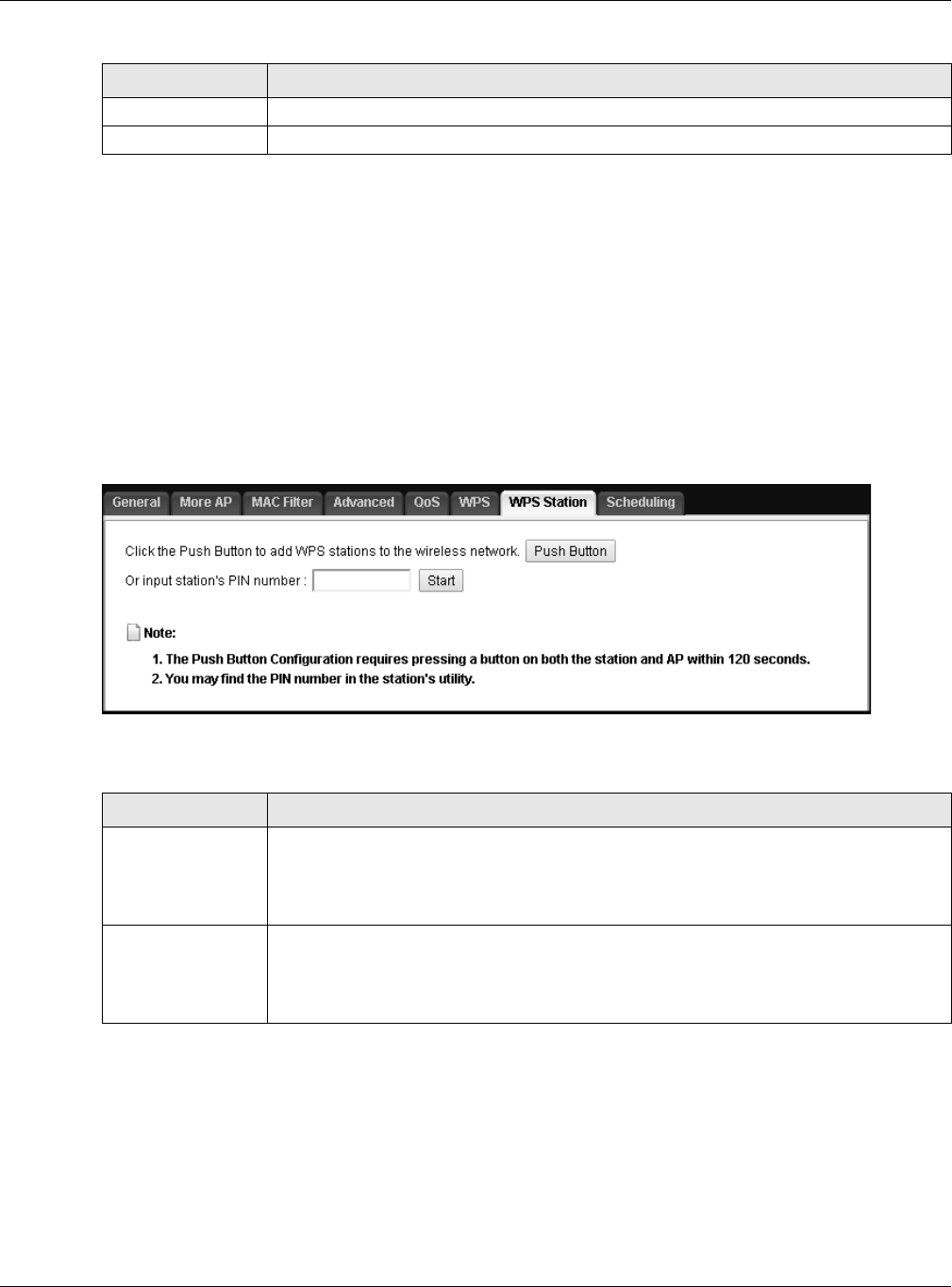
Chapter 11 Wireless LAN
EMG2926-Q10A User’s Guide
107
11.9 WPS Station Screen
Use this screen when you want to add a wireless station using WPS. To open this screen, click
Network > Wireless LAN 2.4G/5G > WPS Station tab.
Note: After you click Push Button on this screen, you have to press a similar button in
the wireless station utility within 2 minutes. To add the second wireless station, you
have to press these buttons on both device and the wireless station again after the
first 2 minutes.
Figure 69 Network > Wireless LAN 2.4G/5G > WPS Station
The following table describes the labels in this screen.
11.10 Scheduling Screen
Use this screen to set the times your wireless LAN is turned on and off. Wireless LAN scheduling is
disabled by default. The wireless LAN can be scheduled to turn on or off on certain days and at
certain times. To open this screen, click Network > Wireless LAN 2.4G/5G > Scheduling tab.
Apply Click Apply to save your changes back to the EMG2926-Q10A.
Cancel Click Cancel to reload the previous configuration for this screen.
Table 41 Network > Wireless LAN 2.4G/5G > WPS (continued)
LABEL DESCRIPTION
Table 42 Network > Wireless LAN 2.4G/5G > WPS Station
LABEL DESCRIPTION
Push Button Use this button when you use the PBC (Push Button Configuration) method to configure
wireless stations’s wireless settings.
Click this to start WPS-aware wireless station scanning and the wireless security
information synchronization.
Or input station’s
PIN number
Use this button when you use the PIN Configuration method to configure wireless
station’s wireless settings.
Type the same PIN number generated in the wireless station’s utility. Then click Start to
associate to each other and perform the wireless security information synchronization.
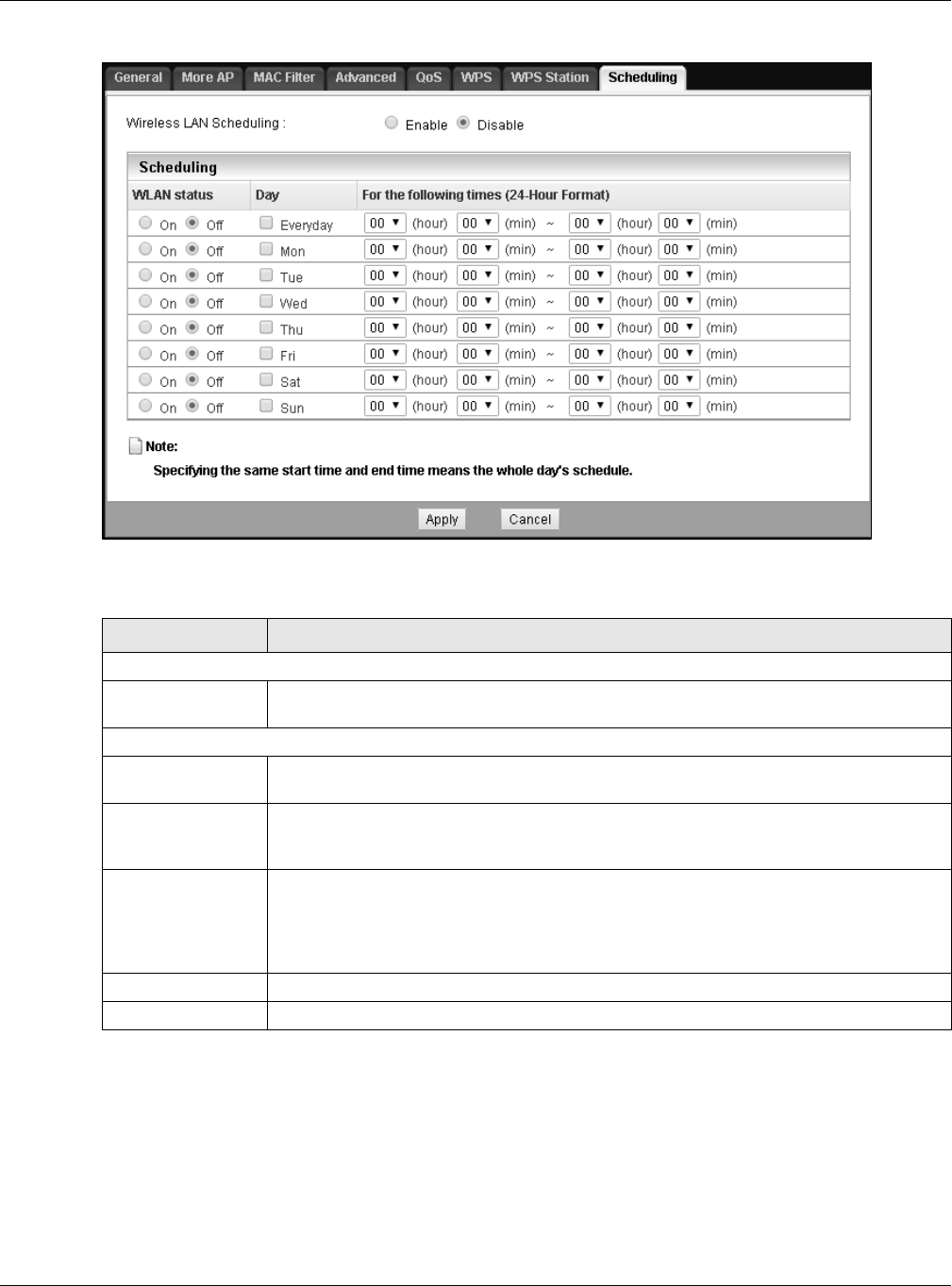
Chapter 11 Wireless LAN
EMG2926-Q10A User’s Guide
108
Figure 70 Network > Wireless LAN 2.4G/5G > Scheduling
The following table describes the labels in this screen.
Table 43 Network > Wireless LAN 2.4G/5G > Scheduling
LABEL DESCRIPTION
Wireless LAN Scheduling
Wireless LAN
Scheduling
Select Enable to activate the wireless LAN scheduling feature. Select Disable to turn it
off.
Scheduling
WLAN Status Select On or Off to specify whether the Wireless LAN is turned on or off. This field works
in conjunction with the Day and For the following times fields.
Day Select Everyday or the specific days to turn the Wireless LAN on or off. If you select
Everyday you can not select any specific days. This field works in conjunction with the
For the following times field.
For the following
times (24-Hour
Format)
Select a begin time using the first set of hour and minute (min) drop down boxes and
select an end time using the second set of hour and minute (min) drop down boxes. If
you have chosen On earlier for the WLAN Status the Wireless LAN will turn on between
the two times you enter in these fields. If you have chosen Off earlier for the WLAN
Status the Wireless LAN will turn off between the two times you enter in these fields.
Apply Click Apply to save your changes back to the EMG2926-Q10A.
Cancel Click Cancel to reload the previous configuration for this screen.
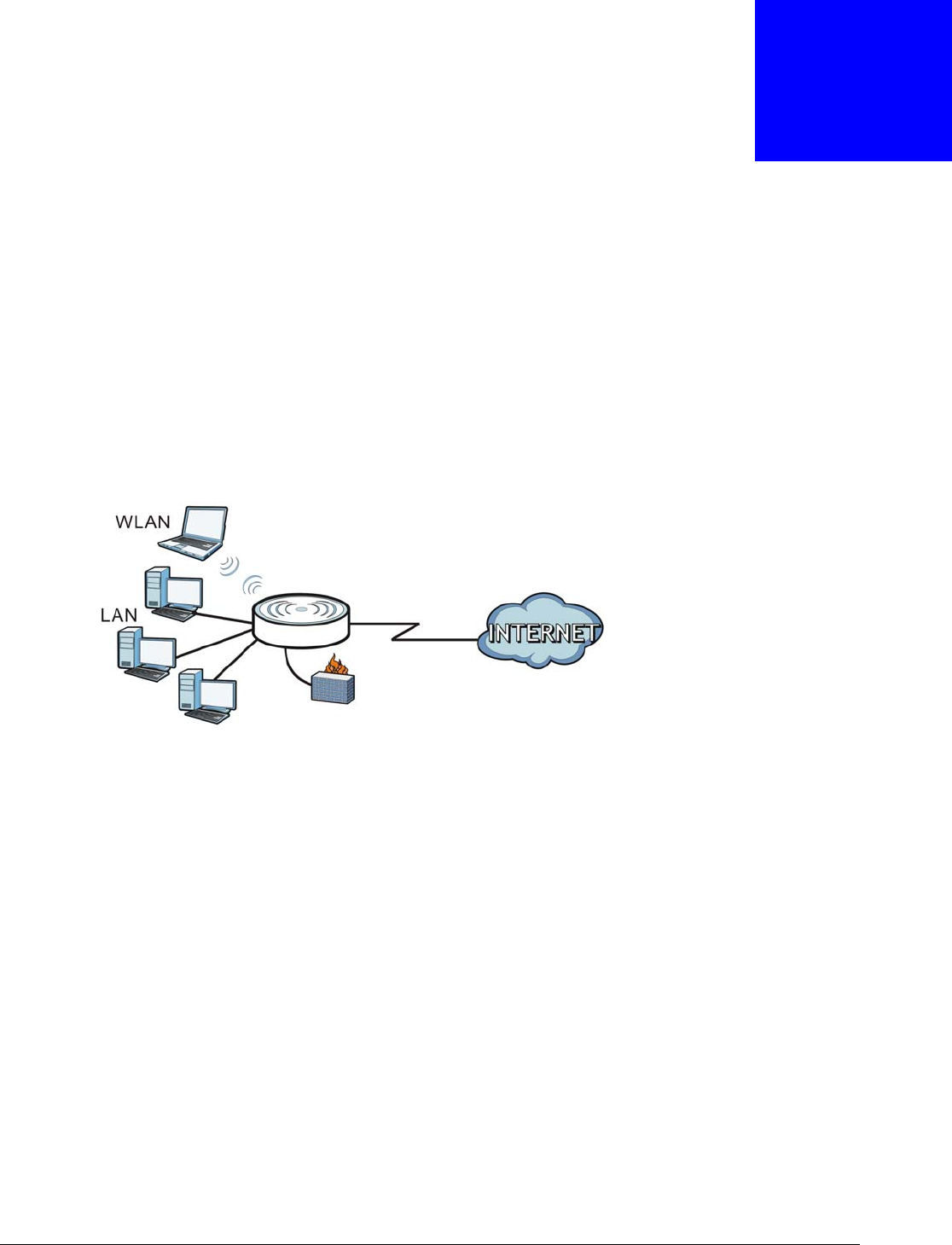
EMG2926-Q10A User’s Guide
109
CHAPTER 12
LAN
12.1 Overview
This chapter describes how to configure LAN settings.
A Local Area Network (LAN) is a shared communication system to which many computers are
attached. A LAN is a computer network limited to the immediate area, usually the same building or
floor of a building.
Figure 71 LAN Example
The LAN screens can help you configure a manage IP address, and partition your physical network
into logical networks.
12.2 What You Can Do
•Use the IP screen to change the IPv4 address for your EMG2926-Q10A (Section 12.4 on page
110).
•Use the IP Alias screen to have the EMG2926-Q10A apply IP alias to create LAN subnets
(Section 12.5 on page 111).
•Use the IPv6 LAN screen to configure the IPv6 address for your EMG2926-Q10A on the LAN
(Section 12.6 on page 112).
12.3 What You Need To Know
The actual physical connection determines whether the EMG2926-Q10A ports are LAN or WAN
ports. There are two separate IP networks, one inside the LAN network and the other outside the
WAN network as shown next.
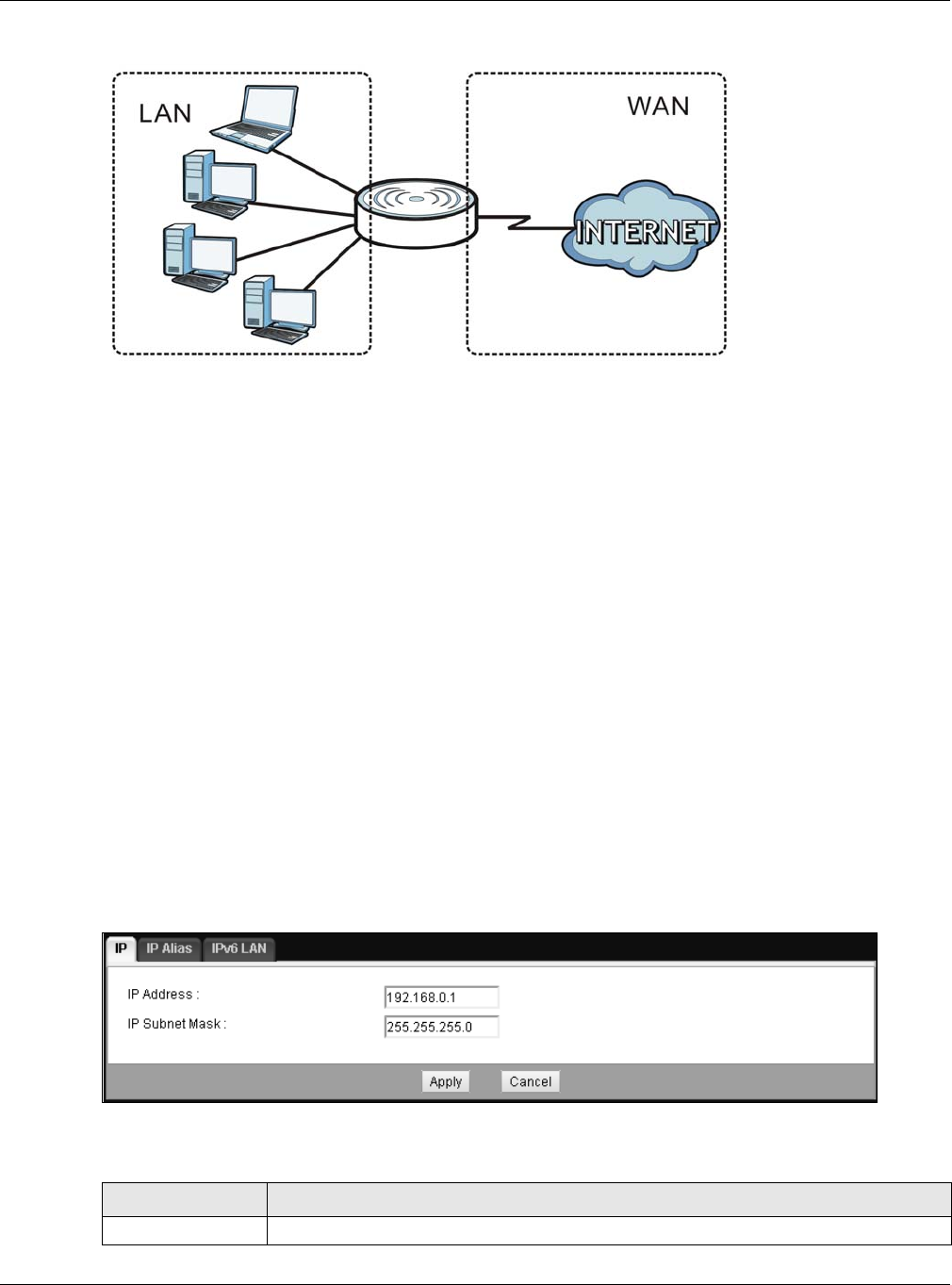
Chapter 12 LAN
EMG2926-Q10A User’s Guide
110
Figure 72 LAN and WAN IP Addresses
The LAN parameters of the EMG2926-Q10A in router mode are preset in the factory with the
following values:
•IPv4 address of 192.168.0.1 with subnet mask of 255.255.255.0 (24 bits)
• DHCP server enabled with 32 client IP addresses starting from 192.168.0.33.
These parameters should work for the majority of installations. If your ISP gives you explicit DNS
server address(es), read the embedded Web Configurator help regarding what fields need to be
configured.
12.3.1 IP Alias
IP alias allows you to partition a physical network into different logical networks over the same
Ethernet interface. The EMG2926-Q10A supports three logical LAN interfaces via its single physical
Ethernet interface with the EMG2926-Q10A itself as the gateway for each LAN network.
12.4 LAN IP Screen
Use this screen to change the IPv4 address for your EMG2926-Q10A. Click Network > LAN > IP.
Figure 73 Network > LAN > IP
The following table describes the labels in this screen.
Table 44 Network > LAN > IP
LABEL DESCRIPTION
IP Address Type the IP address of your EMG2926-Q10A in dotted decimal notation.
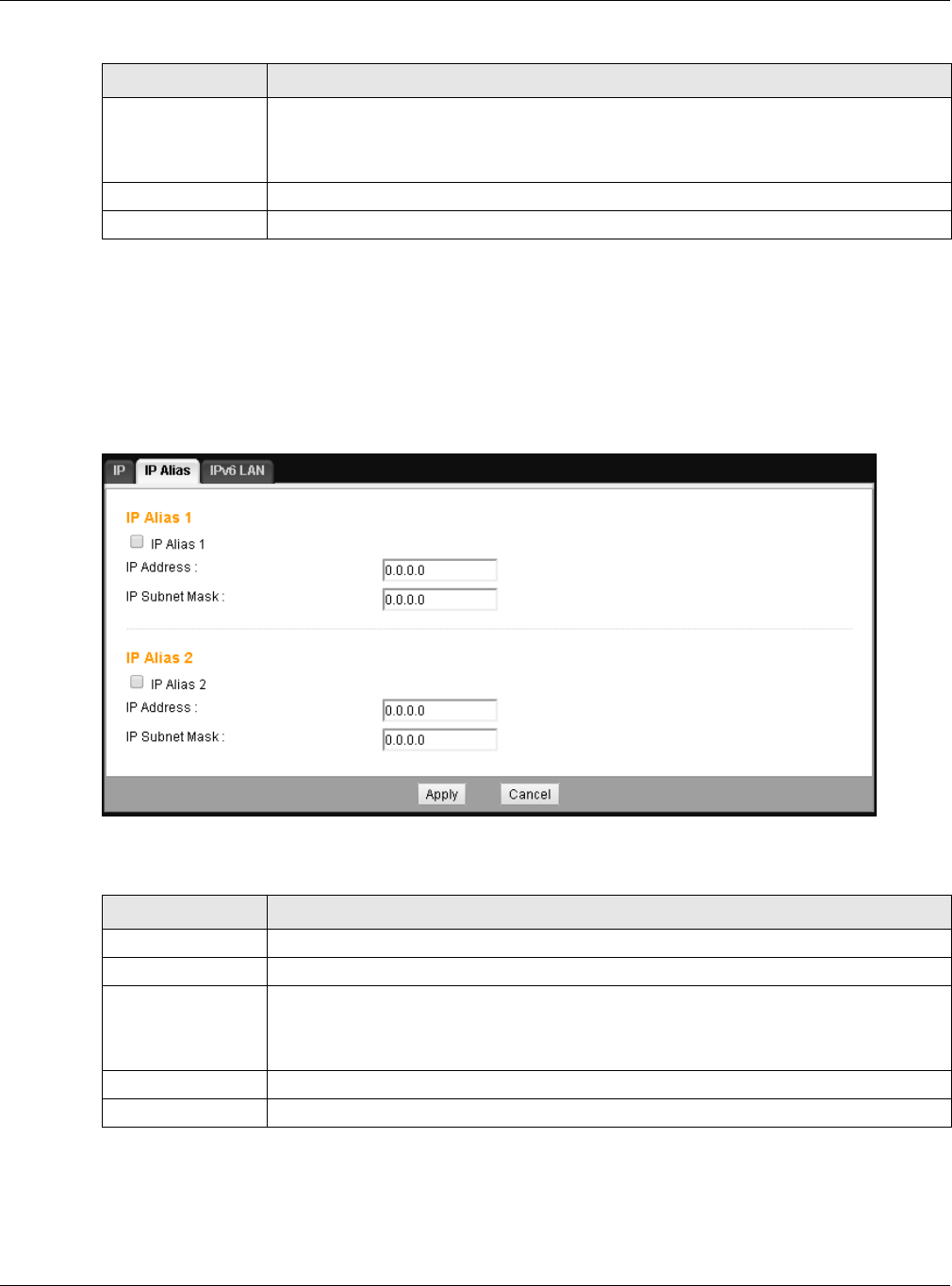
Chapter 12 LAN
EMG2926-Q10A User’s Guide
111
12.5 IP Alias Screen
Use this screen to have the EMG2926-Q10A apply IP alias to create LAN subnets. Click LAN > IP
Alias.
Figure 74 Network > LAN > IP Alias
The following table describes the labels in this screen.
IP Subnet Mask The subnet mask specifies the network number portion of an IP address. Your
EMG2926-Q10A will automatically calculate the subnet mask based on the IP address
that you assign. Unless you are implementing subnetting, use the subnet mask
computed by the EMG2926-Q10A.
Apply Click Apply to save your changes back to the EMG2926-Q10A.
Cancel Click Cancel to begin configuring this screen afresh.
Table 44 Network > LAN > IP (continued)
LABEL DESCRIPTION
Table 45 Network > LAN > IP Alias
LABEL DESCRIPTION
IP Alias 1, 2 Check this to enable IP alias to configure another LAN network for the EMG2926-Q10A.
IP Address Type the IP alias address of your EMG2926-Q10A in dotted decimal notation.
IP Subnet Mask The subnet mask specifies the network number portion of an IP address. Your
EMG2926-Q10A will automatically calculate the subnet mask based on the IP address
that you assign. Unless you are implementing subnetting, use the subnet mask
computed by the EMG2926-Q10A.
Apply Click Apply to save your changes back to the EMG2926-Q10A.
Cancel Click Cancel to begin configuring this screen afresh.
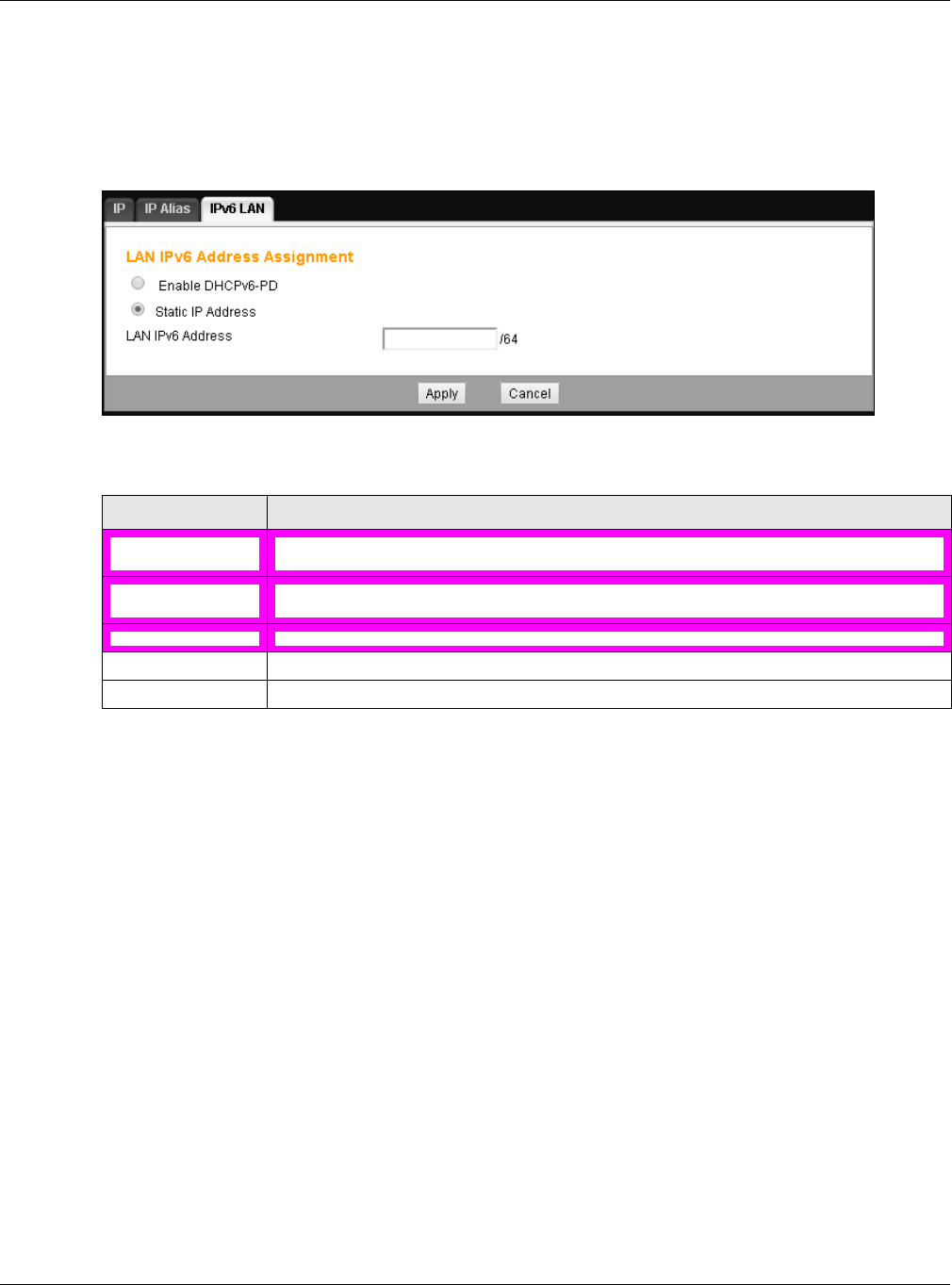
Chapter 12 LAN
EMG2926-Q10A User’s Guide
112
12.6 IPv6 LAN Screen
Use this screen to configure the IPv6 address for your EMG2926-Q10A on the LAN. Click Network
> LAN > IPv6 LAN.
Figure 75 Network > LAN > IPv6 LAN
The following table describes the labels in this screen.
Table 46 Network > LAN > IPv6 LAN
LABEL DESCRIPTION
Enable DHCPv6-PD Select this option to use DHCPv6 prefix delegation. The EMG2926-Q10A will obtain an
IPv6 prefix from the ISP or a connected uplink router for the LAN.
Static IP Address Select this option to manually enter an IPv6 address if you want to use a static IP
address.
LAN IPv6 Address Enter the IPv6 address for the EMG2926-Q10A on the LAN.
Apply Click Apply to save your changes back to the EMG2926-Q10A.
Cancel Click Cancel to begin configuring this screen afresh.

EMG2926-Q10A User’s Guide
113
CHAPTER 13
DHCP Server
13.1 Overview
DHCP (Dynamic Host Configuration Protocol, RFC 2131 and RFC 2132) allows individual clients to
obtain TCP/IP configuration at start-up from a server. You can configure the EMG2926-Q10A’s LAN
as a DHCP server or disable it. When configured as a server, the EMG2926-Q10A provides the TCP/
IP configuration for the clients. If DHCP service is disabled, you must have another DHCP server on
your LAN, or else the computer must be manually configured.
13.1.1 What You Can Do
•Use the General screen to enable the DHCP server (Section 13.2 on page 114).
•Use the Advanced screen to assign IP addresses on the LAN to specific individual computers
based on their MAC Addresses (Section 13.3 on page 114).
•Use the Client List screen to view the current DHCP client information (Section 13.4 on page
116).
13.1.2 What You Need To Know
The following terms and concepts may help as you read through this chapter.
LAN TCP/IP
The EMG2926-Q10A has built-in DHCP server capability that assigns IP addresses and DNS servers
to systems that support DHCP client capability.
IP Pool Setup
The EMG2926-Q10A is pre-configured with a pool of 32 IP addresses starting from 192.168.0.33 to
192.168.0.64. This configuration leaves 31 IP addresses (excluding the EMG2926-Q10A itself) in
the lower range (192.168.0.2 to 192.168.0.32) for other server computers, for instance, servers for
mail, FTP, TFTP, web, etc., that you may have.
MAC Addresses
Every Ethernet device has a unique MAC (Media Access Control) address. The MAC address is
assigned at the factory and consists of six pairs of hexadecimal characters, for example,
00:A0:C5:00:00:02. Find out the MAC addresses of your network devices if you intend to add them
to the DHCP Client List screen.
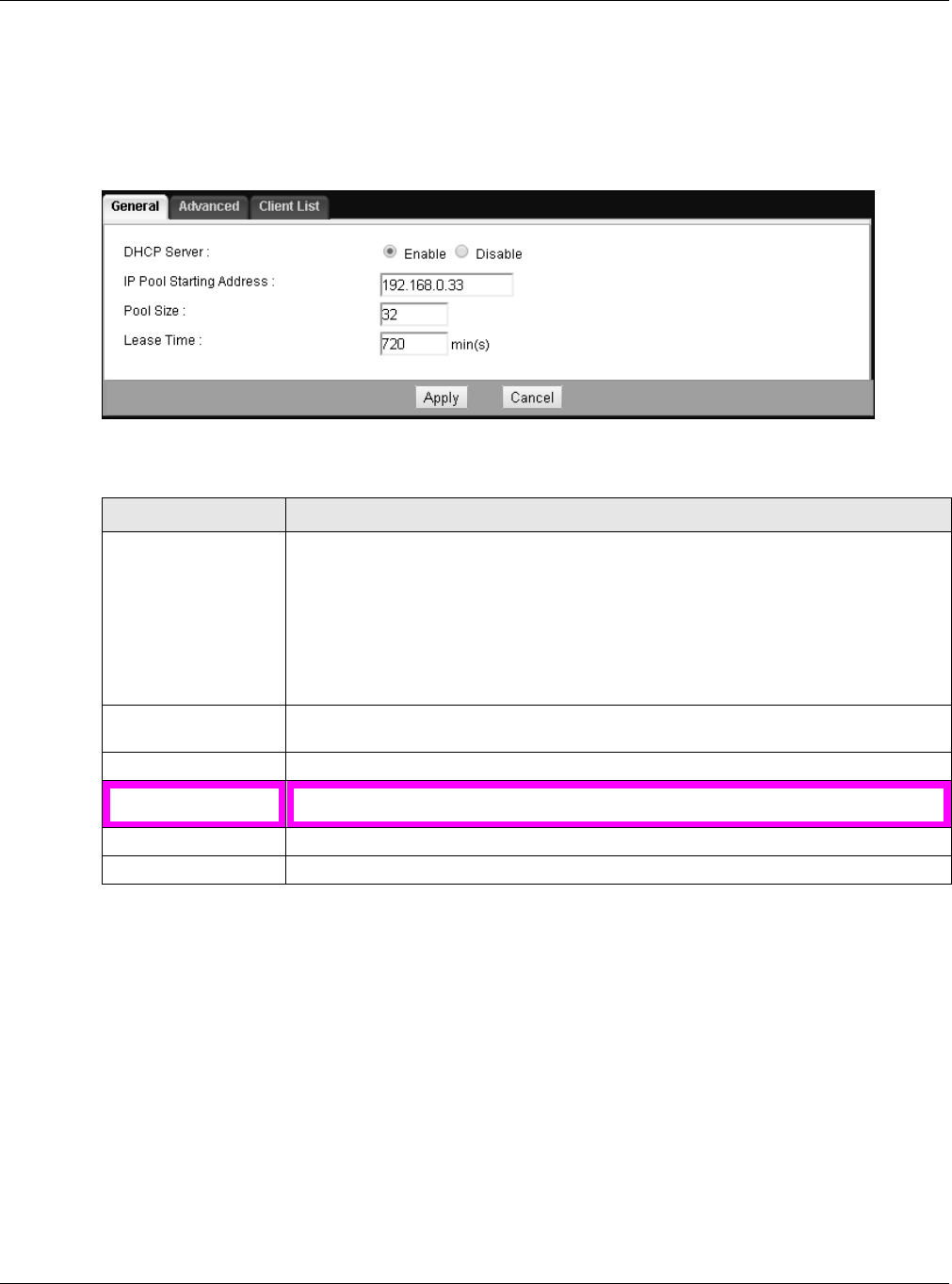
Chapter 13 DHCP Server
EMG2926-Q10A User’s Guide
114
13.2 DHCP Server General Screen
Use this screen to enable the DHCP server. Click Network > DHCP Server. The following screen
displays.
Figure 76 Network > DHCP Server > General
The following table describes the labels in this screen.
13.3 DHCP Server Advanced Screen
This screen allows you to assign IP addresses on the LAN to specific individual computers based on
their MAC addresses. You can also use this screen to configure the DNS server information that the
EMG2926-Q10A sends to the DHCP clients.
To change your EMG2926-Q10A’s static DHCP settings, click Network > DHCP Server >
Advanced. The following screen displays.
Table 47 Network > DHCP Server > General
LABEL DESCRIPTION
DHCP Server Select Enable to activate DHCP for LAN.
DHCP (Dynamic Host Configuration Protocol, RFC 2131 and RFC 2132) allows
individual clients (computers) to obtain TCP/IP configuration at startup from a server.
Enable the DHCP server unless your ISP instructs you to do otherwise. Select Disable
to stop the EMG2926-Q10A acting as a DHCP server. When configured as a server, the
EMG2926-Q10A provides TCP/IP configuration for the clients. If not, DHCP service is
disabled and you must have another DHCP server on your LAN, or else the computers
must be manually configured. When set as a server, fill in the following four fields.
IP Pool Starting
Address
This field specifies the first of the contiguous addresses in the IP address pool for LAN.
Pool Size This field specifies the size, or count of the IP address pool for LAN.
Lease Time Specify how long each computer can use the the IP address before it has to request
the information again.
Apply Click Apply to save your changes back to the EMG2926-Q10A.
Cancel Click Cancel to begin configuring this screen afresh.
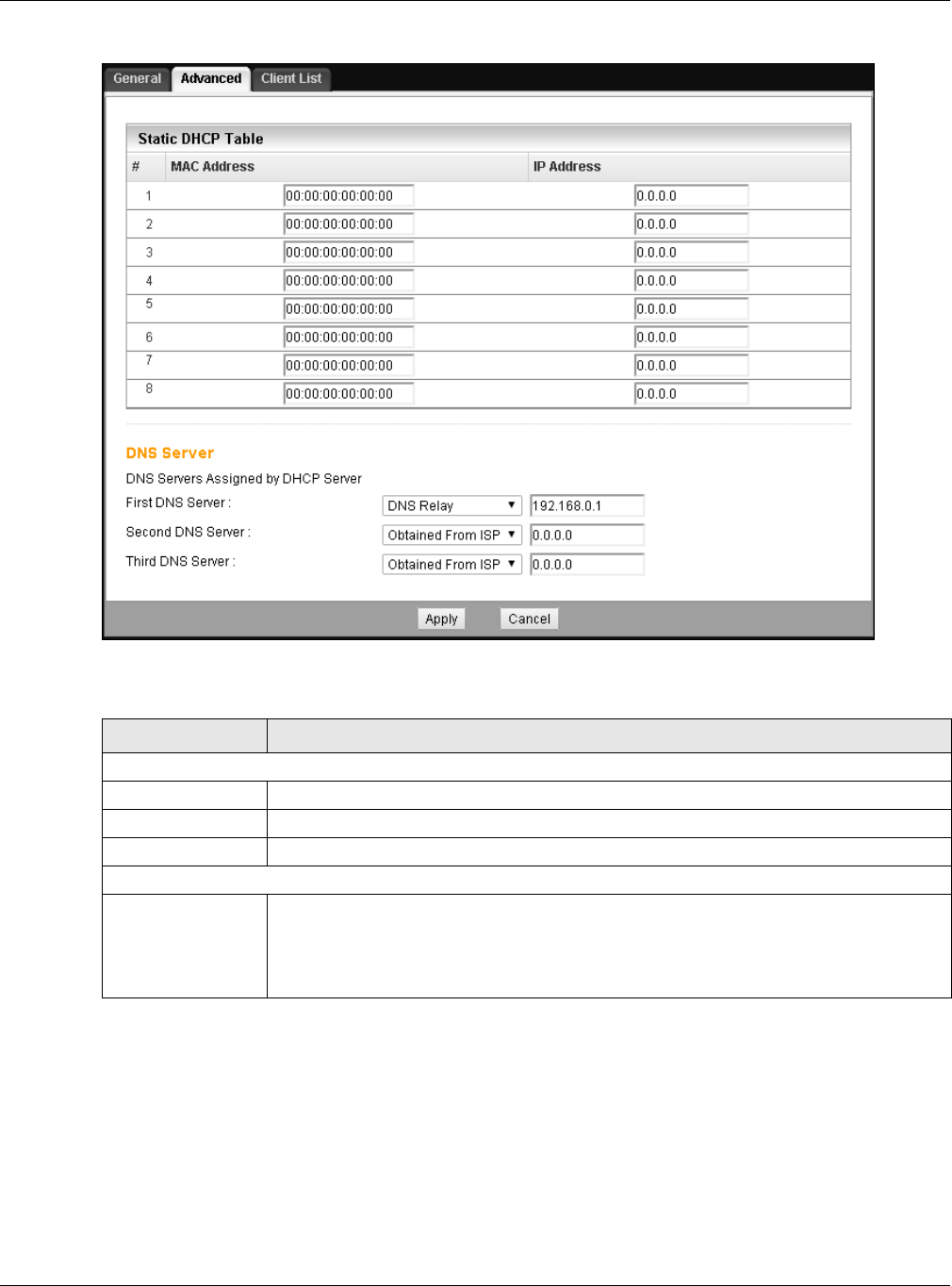
Chapter 13 DHCP Server
EMG2926-Q10A User’s Guide
115
Figure 77 Network > DHCP Server > Advanced
The following table describes the labels in this screen.
Table 48 Network > DHCP Server > Advanced
LABEL DESCRIPTION
Static DHCP Table
# This is the index number of the static IP table entry (row).
MAC Address Type the MAC address (with colons) of a computer on your LAN.
IP Address Type the LAN IP address of a computer on your LAN.
DNS Server
DNS Servers
Assigned by DHCP
Server
The EMG2926-Q10A passes a DNS (Domain Name System) server IP address (in the
order you specify here) to the DHCP clients. The EMG2926-Q10A only passes this
information to the LAN DHCP clients when you enable DHCP Server. When you disable
DHCP Server, DHCP service is disabled and you must have another DHCP sever on your
LAN, or else the computers must have their DNS server addresses manually configured.
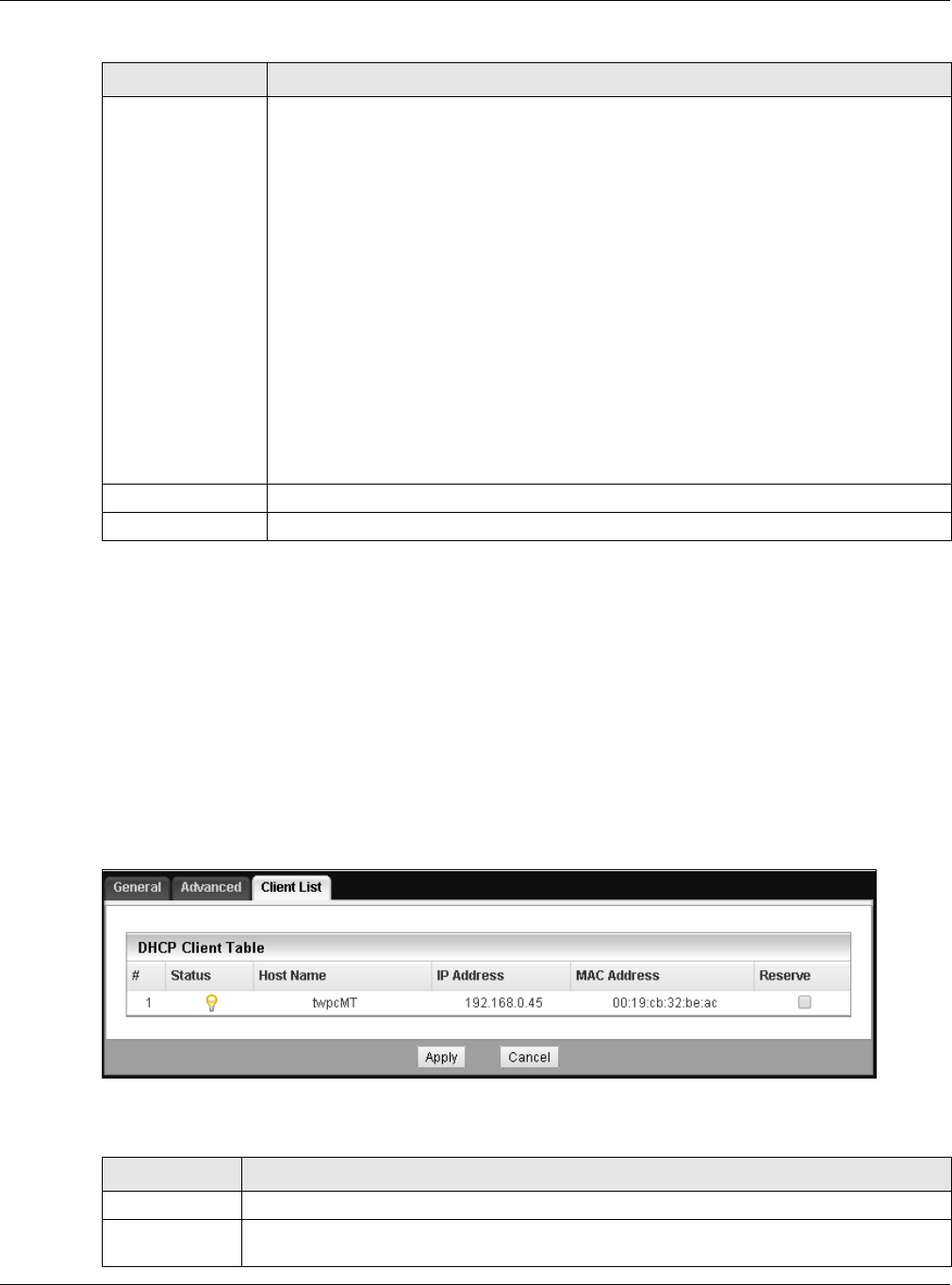
Chapter 13 DHCP Server
EMG2926-Q10A User’s Guide
116
13.4 DHCP Client List Screen
The DHCP table shows current DHCP client information (including IP Address, Host Name and MAC
Address) of network clients using the EMG2926-Q10A’s DHCP servers.
Configure this screen to always assign an IP address to a MAC address (and host name). Click
Network > DHCP Server > Client List.
Note: You can also view a read-only client list by clicking Monitor > DHCP Server.
Figure 78 Network > DHCP Server > Client List
The following table describes the labels in this screen.
First DNS Server
Second DNS Server
Third DNS Server
Select Obtained From ISP if your ISP dynamically assigns DNS server information
(and the EMG2926-Q10A's WAN IP address). The field to the right displays the (read-
only) DNS server IP address that the ISP assigns.
Select User-Defined if you have the IP address of a DNS server. Enter the DNS server's
IP address in the field to the right. If you chose User-Defined, but leave the IP address
set to 0.0.0.0, User-Defined changes to None after you click Apply. If you set a
second choice to User-Defined, and enter the same IP address, the second User-
Defined changes to None after you click Apply.
Select DNS Relay to have the EMG2926-Q10A act as a DNS proxy. The EMG2926-
Q10A's LAN IP address displays in the field to the right (read-only). The EMG2926-Q10A
tells the DHCP clients on the LAN that the EMG2926-Q10A itself is the DNS server. When
a computer on the LAN sends a DNS query to the EMG2926-Q10A, the EMG2926-Q10A
forwards the query to the EMG2926-Q10A's system DNS server (configured in the WAN
> Internet Connection screen) and relays the response back to the computer. You can
only select DNS Relay for one of the three servers; if you select DNS Relay for a
second or third DNS server, that choice changes to None after you click Apply.
Select None if you do not want to configure DNS servers. If you do not configure a DNS
server, you must know the IP address of a computer in order to access it.
Apply Click Apply to save your changes back to the EMG2926-Q10A.
Cancel Click Cancel to begin configuring this screen afresh.
Table 48 Network > DHCP Server > Advanced (continued)
LABEL DESCRIPTION
Table 49 Network > DHCP Server > Client List
LABEL DESCRIPTION
# This is the index number of the host computer.
Status This field displays whether the connection to the host computer is up (a yellow bulb) or
down (a gray bulb).

Chapter 13 DHCP Server
EMG2926-Q10A User’s Guide
117
Host Name This field displays the computer host name.
IP Address This field displays the IP address relative to the # field listed above.
MAC Address This field shows the MAC address of the computer with the name in the Host Name field.
Every Ethernet device has a unique MAC (Media Access Control) address which uniquely
identifies a device. The MAC address is assigned at the factory and consists of six pairs of
hexadecimal characters, for example, 00:A0:C5:00:00:02.
Reserve Select this if you want to reserve the IP address for this specific MAC address.
Apply Click Apply to save your changes back to the EMG2926-Q10A.
Cancel Click Cancel to reload the previous configuration for this screen.
Table 49 Network > DHCP Server > Client List (continued)
LABEL DESCRIPTION
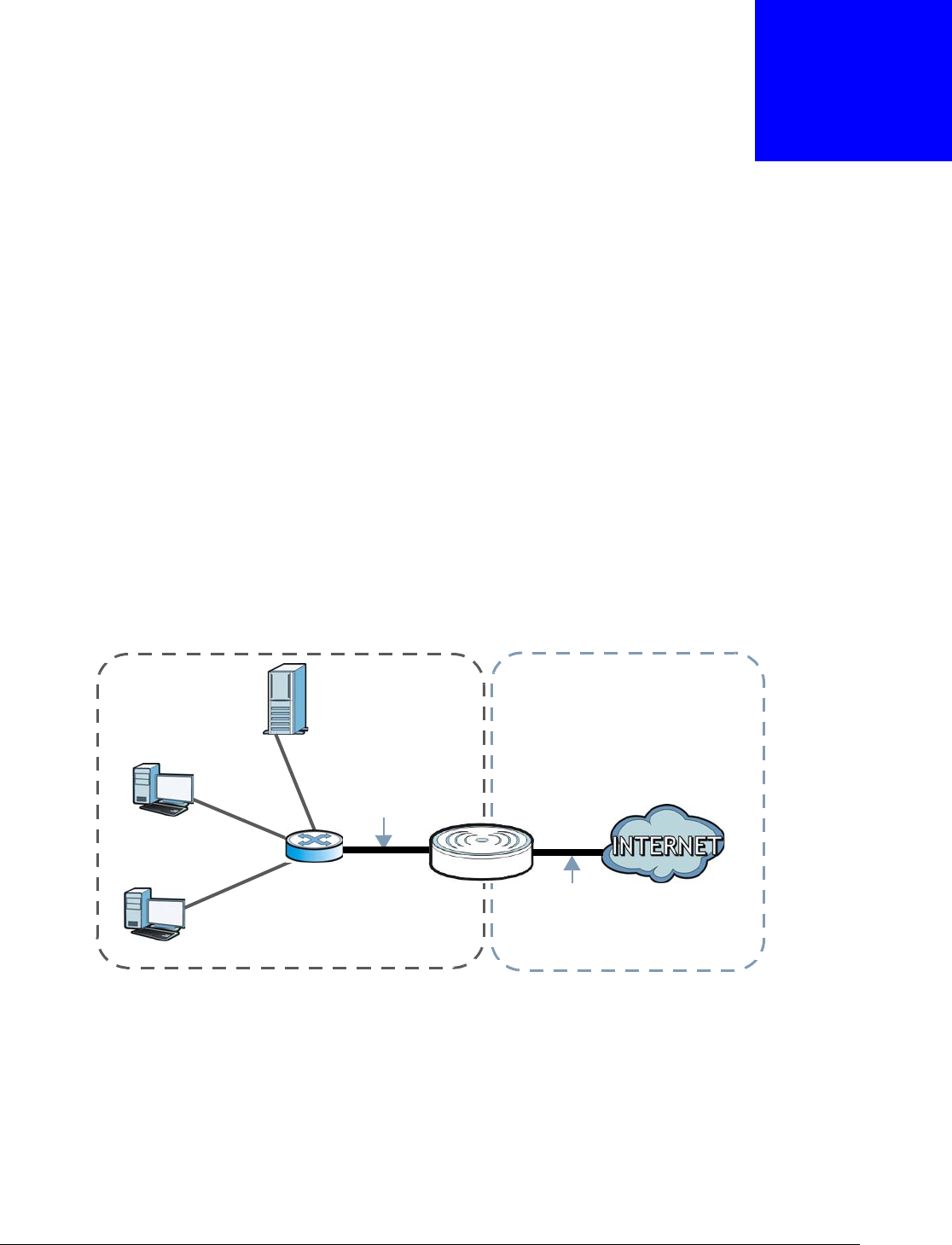
EMG2926-Q10A User’s Guide
118
CHAPTER 14
NAT
14.1 Overview
NAT (Network Address Translation - NAT, RFC 1631) is the translation of the IP address of a host in
a packet. For example, the source address of an outgoing packet, used within one network is
changed to a different IP address known within another network.
The figure below is a simple illustration of a NAT network. You want to assign ports 21-25 to one
FTP, Telnet and SMTP server (A in the example), port 80 to another (B in the example) and assign
a default server IP address of 192.168.0.35 to a third (C in the example).
You assign the LAN IP addresses to the devices (A to D) connected to your EMG2926-Q10A. The
ISP assigns the WAN IP address. The NAT network appears as a single host on the Internet. All
traffic coming from A to D going out to the Internet use the IP address of the EMG2926-Q10A,
which is 192.168.0.1.
Figure 79 NAT Example
This chapter discusses how to configure NAT on the EMG2926-Q10A.
Note: You must create a firewall rule in addition to setting up NAT, to allow traffic from
the WAN to be forwarded through the EMG2926-Q10A.
14.1.1 What You Can Do
•Use the General screen to enable NAT (Section 14.2 on page 120).
A: 192.168.0.33
B: 192.168.0.34
C: 192.168.0.35
IP address
192.168.0.1
WANLAN
assigned by ISP
FTP, Telnet, SNMP
Port 80
Ports 21 to 25
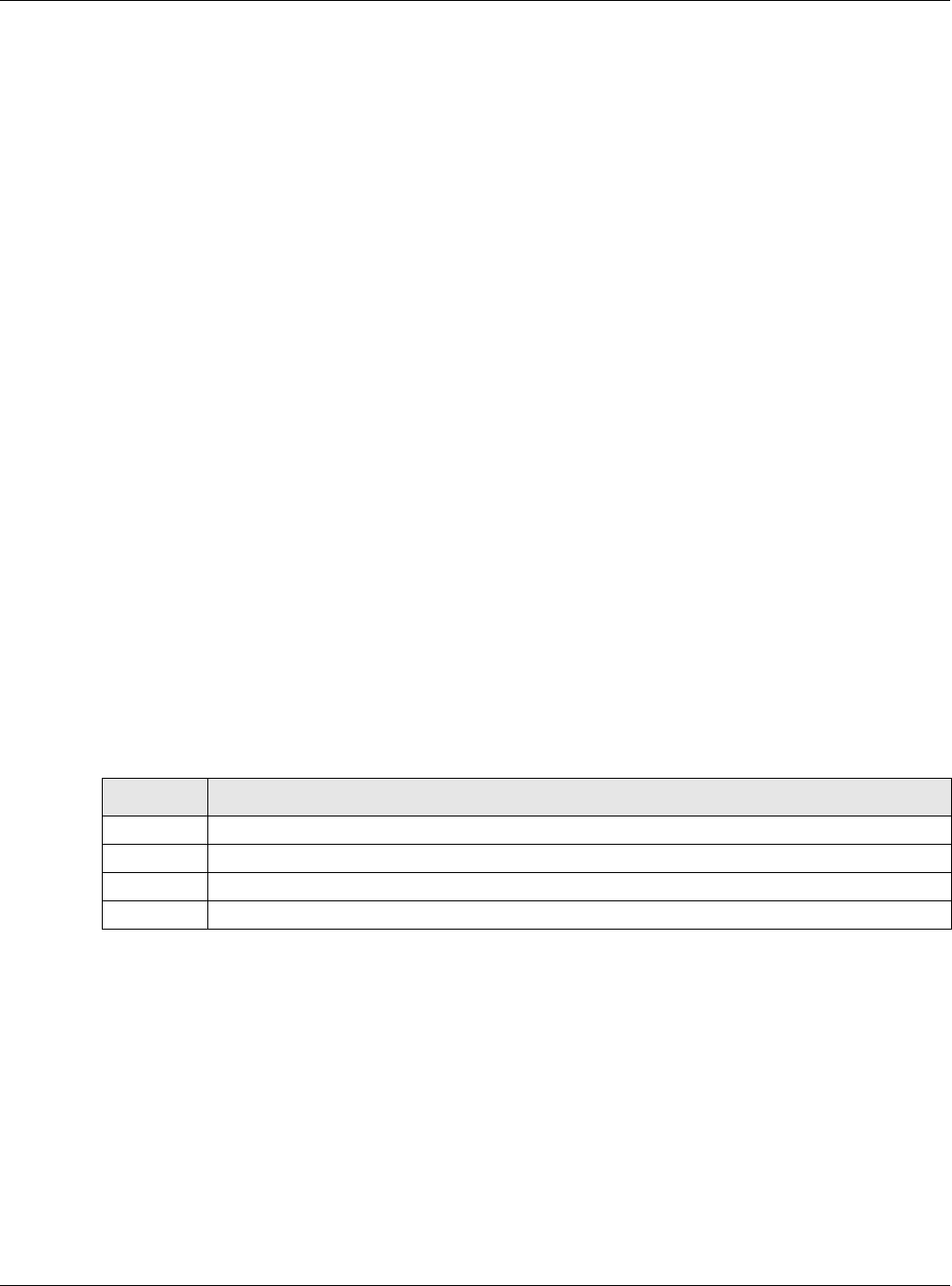
Chapter 14 NAT
EMG2926-Q10A User’s Guide
119
•Use the Port Forwarding screen to set a default server and change your EMG2926-Q10A’s port
forwarding settings to forward incoming service requests to the server(s) on your local network
(Section 14.3 on page 121).
•Use the Port Trigger screen to change your EMG2926-Q10A’s trigger port settings (Section
14.5.3 on page 127).
14.1.2 What You Need To Know
The following terms and concepts may help as you read through this chapter.
Inside/Outside
This denotes where a host is located relative to the EMG2926-Q10A, for example, the computers of
your subscribers are the inside hosts, while the web servers on the Internet are the outside hosts.
Global/Local
This denotes the IP address of a host in a packet as the packet traverses a router, for example, the
local address refers to the IP address of a host when the packet is in the local network, while the
global address refers to the IP address of the host when the same packet is traveling in the WAN
side.
Note: Inside/outside refers to the location of a host, while global/local refers to the IP
address of a host used in a packet.
An inside local address (ILA) is the IP address of an inside host in a packet when the packet is still
in the local network, while an inside global address (IGA) is the IP address of the same inside host
when the packet is on the WAN side. The following table summarizes this information.
Note: NAT never changes the IP address (either local or global) of an outside host.
What NAT Does
In the simplest form, NAT changes the source IP address in a packet received from a subscriber
(the inside local address) to another (the inside global address) before forwarding the packet to the
WAN side. When the response comes back, NAT translates the destination address (the inside
global address) back to the inside local address before forwarding it to the original inside host. Note
that the IP address (either local or global) of an outside host is never changed.
The global IP addresses for the inside hosts can be either static or dynamically assigned by the ISP.
In addition, you can designate servers, for example, a web server and a telnet server, on your local
Table 50 NAT Definitions
ITEM DESCRIPTION
Inside This refers to the host on the LAN.
Outside This refers to the host on the WAN.
Local This refers to the packet address (source or destination) as the packet travels on the LAN.
Global This refers to the packet address (source or destination) as the packet travels on the WAN.
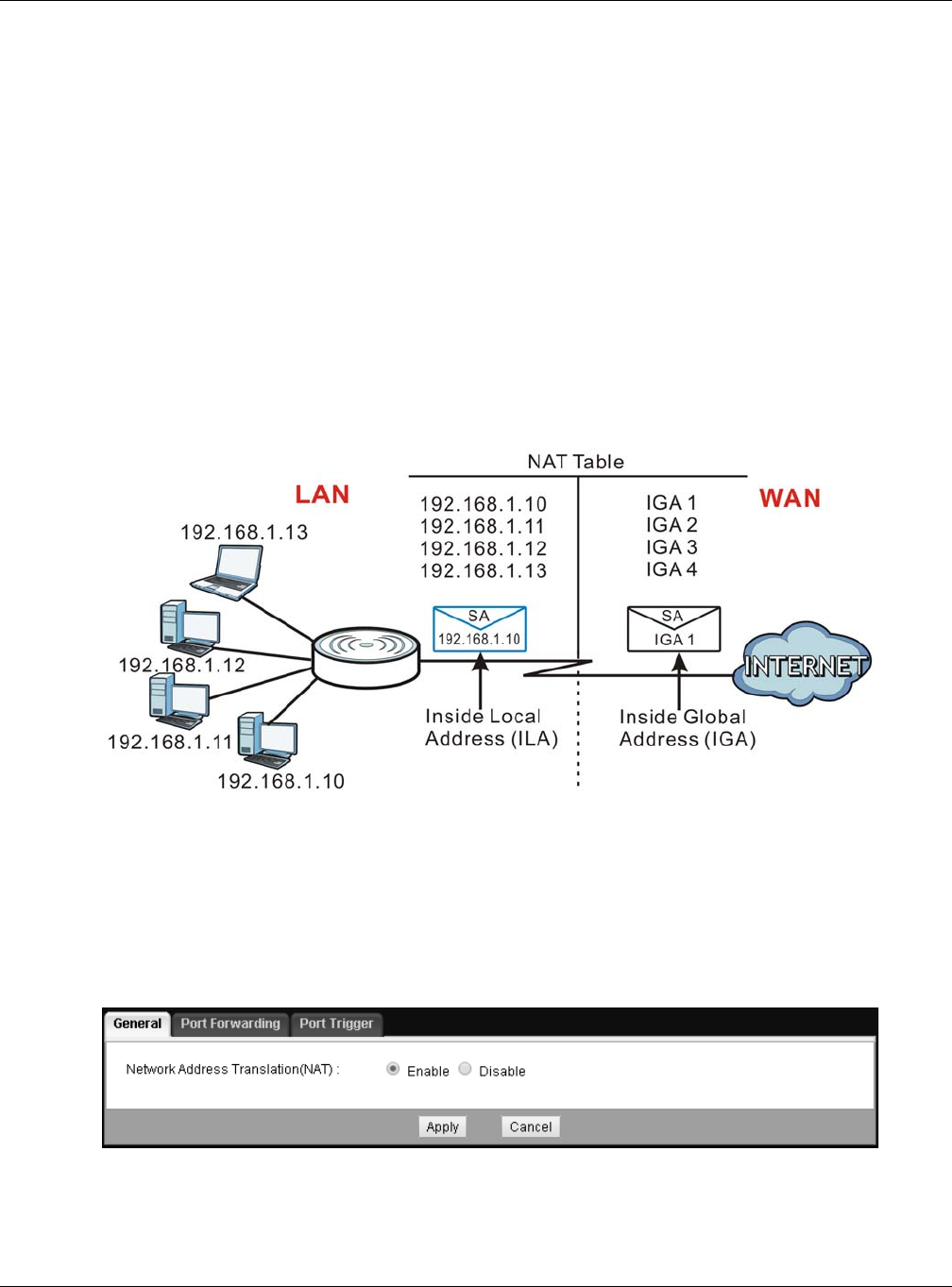
Chapter 14 NAT
EMG2926-Q10A User’s Guide
120
network and make them accessible to the outside world. If you do not define any servers , NAT
offers the additional benefit of firewall protection. With no servers defined, your EMG2926-Q10A
filters out all incoming inquiries, thus preventing intruders from probing your network. For more
information on IP address translation, refer to RFC 1631, The IP Network Address Translator (NAT).
How NAT Works
Each packet has two addresses – a source address and a destination address. For outgoing packets,
the ILA (Inside Local Address) is the source address on the LAN, and the IGA (Inside Global
Address) is the source address on the WAN. For incoming packets, the ILA is the destination
address on the LAN, and the IGA is the destination address on the WAN. NAT maps private (local)
IP addresses to globally unique ones required for communication with hosts on other networks. It
replaces the original IP source address in each packet and then forwards it to the Internet. The
EMG2926-Q10A keeps track of the original addresses and port numbers so incoming reply packets
can have their original values restored. The following figure illustrates this.
Figure 80 How NAT Works
14.2 NAT General Screen
Use this screen to enable NAT and set a default server. Click Network > NAT to open the General
screen.
Figure 81 Network > NAT > General

Chapter 14 NAT
EMG2926-Q10A User’s Guide
121
The following table describes the labels in this screen.
14.3 Port Forwarding Screen
Use this screen to forward incoming service requests to the server(s) on your local network and set
a default server. You may enter a single port number or a range of port numbers to be forwarded,
and the local IP address of the desired server. The port number identifies a service; for example,
web service is on port 80 and FTP on port 21. In some cases, such as for unknown services or
where one server can support more than one service (for example both FTP and web service), it
might be better to specify a range of port numbers.
In addition to the servers for specified services, NAT supports a default server. A service request
that does not have a server explicitly designated for it is forwarded to the default server. If the
default is not defined, the service request is simply discarded.
Note: Many residential broadband ISP accounts do not allow you to run any server
processes (such as a Web or FTP server) from your location. Your ISP may
periodically check for servers and may suspend your account if it discovers any
active services at your location. If you are unsure, refer to your ISP.
Port forwarding allows you to define the local servers to which the incoming services will be
forwarded. To change your EMG2926-Q10A’s port forwarding settings, click Network > NAT >
Port Forwarding. The screen appears as shown.
Note: If you do not assign a Default Server, the EMG2926-Q10A discards all packets
received for ports that are not specified in this screen or remote management.
Refer to Appendix C on page 221 for port numbers commonly used for particular services.
Table 51 Network > NAT > General
LABEL DESCRIPTION
Network Address
Translation (NAT)
Network Address Translation (NAT) allows the translation of an Internet protocol
address used within one network (for example a private IP address used in a local
network) to a different IP address known within another network (for example a public
IP address used on the Internet).
Select Enable to activate NAT. Select Disable to turn it off.
Apply Click Apply to save your changes back to the EMG2926-Q10A.
Cancel Click Cancel to begin configuring this screen afresh.
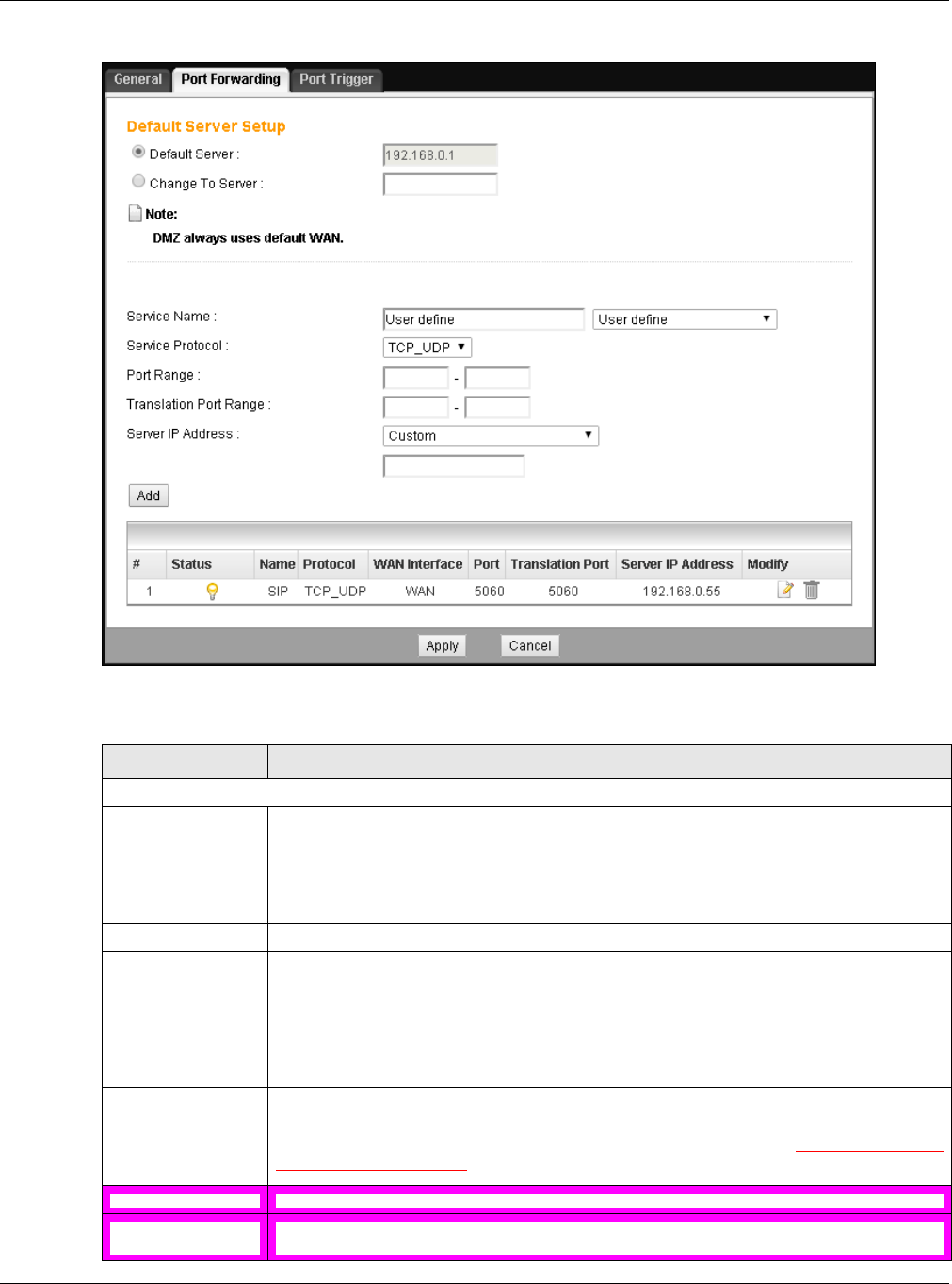
Chapter 14 NAT
EMG2926-Q10A User’s Guide
122
Figure 82 Network > NAT > Port Forwarding
The following table describes the labels in this screen.
Table 52 Network > NAT > Port Forwarding
LABEL DESCRIPTION
Default Server Setup
Default Server In addition to the servers for specified services, NAT supports a default server. A default
server receives packets from ports that are not specified in the Port Forwarding
screen. You can decide whether you want to use the default server or specify a server
manually.
Select this to use the default server.
Change to Server Select this and manually enter the server’s IP address.
Service Name Select a pre-defined service in the second field next to Service Name. The pre-defined
service port number(s) and protocol will be displayed in the port forwarding summary
table.
Otherwise, select User define and type a name (of up to 31 printable characters) to
identify this rule in the first field next to Service Name. You need to manually enter the
port number(s) and select the IP protocol.
Service Protocol Select the transport layer protocol supported by this virtual server. Choices are TCP,
UDP, or TCP_UDP.
If you have chosen a pre-defined service in the Service Name field, the protocol will be
configured automatically this field is not available.
Port Range Type the first and last internal port number that identifies a service.
Translation Port
Range
Type the first and last external port number that identifies a service.
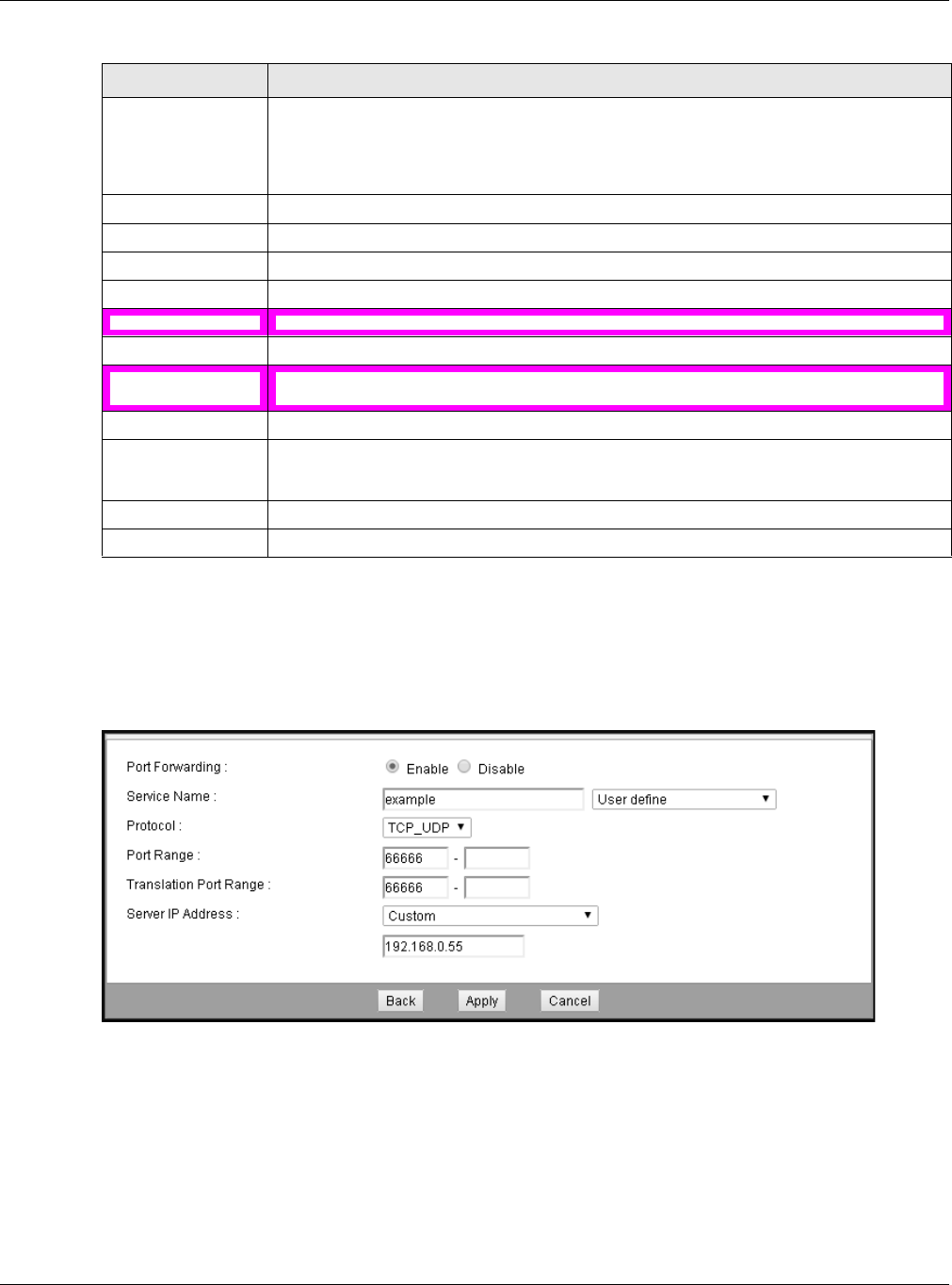
Chapter 14 NAT
EMG2926-Q10A User’s Guide
123
14.3.1 Port Forwarding Edit Screen
This screen lets you edit a port forwarding rule. Click a rule’s Edit icon in the Port Forwarding
screen to open the following screen.
Figure 83 Network > NAT > Port Forwarding Edit
Server IP Address Select a DHCP client as the virtual server and click Add to add it in the port forwarding
summary table.
Otherwise, select Custom and manually enter the inside IP address of the virtual server
here.
#This is the number of an individual port forwarding server entry.
Status This icon is turned on when the rule is enabled.
Name This field displays a name to identify this rule.
Protocol This is the transport layer protocol used for the service.
WAN Interface This is the WAN interface of the rule.
Port This is the internal port number(s) that identifies the service.
Translation Port
Range
This is the external port number(s) that identifies the service.
Server IP Address This field displays the inside IP address of the server.
Modify Click the Edit icon to open the edit screen where you can modify an existing rule.
Click the Delete icon to remove a rule.
Apply Click Apply to save your changes back to the EMG2926-Q10A.
Cancel Click Cancel to begin configuring this screen afresh.
Table 52 Network > NAT > Port Forwarding (continued)
LABEL DESCRIPTION
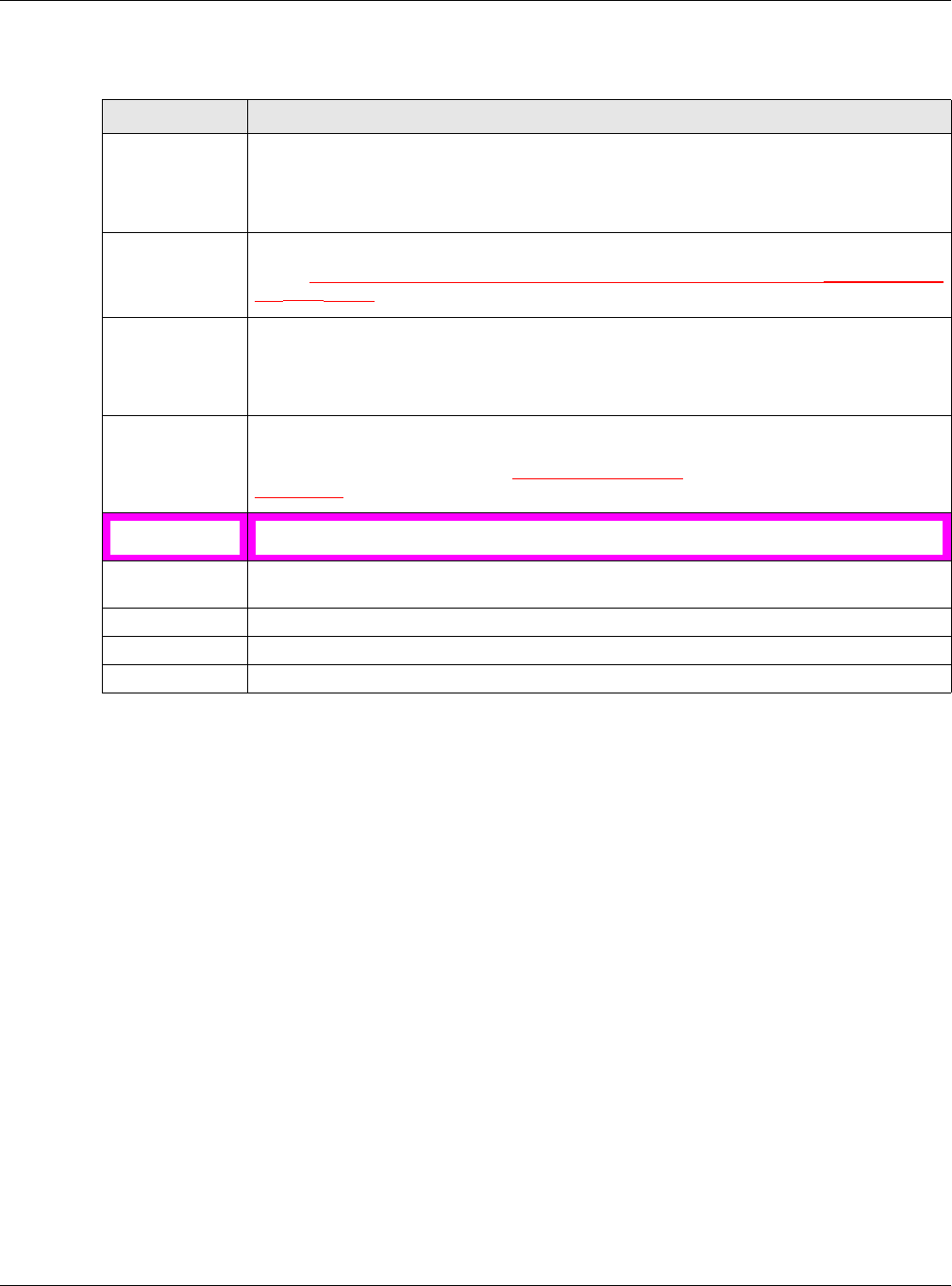
Chapter 14 NAT
EMG2926-Q10A User’s Guide
124
The following table describes the labels in this screen.
Table 53 Network > NAT > Port Forwarding Edit
LABEL DESCRIPTION
Port Forwarding Select Enable to turn on this rule and the requested service can be forwarded to the host
with a specified internal IP address.
Select Disable to disallow forwarding of these ports to an inside server without having to
delete the entry.
Service Name Type a name (of up to 31 printable characters) to identify this rule in the first field next to
Service Name. Otherwise, select a predefined service in the second field next to Service
Name. The predefined service name and port number(s) will display in the Service Name
and Port fields.
Protocol Select the transport layer protocol supported by this virtual server. Choices are TCP, UDP,
or TCP_UDP.
If you have chosen a pre-defined service in the Service Name field, the protocol will be
configured automatically.
Port Range Type an internal port number(s) to define the service to be forwarded to the specified
server.
To specify a range of ports, enter a hyphen (-) between the first port and the last port,
such as 10-.
Translation Port
Range
Type the first and last external port number that identifies a service.
Server IP
Address
Type the IP address of the server on your LAN that receives packets from the port(s)
specified in the Port field.
Back Click Back to return to the previous screen.
Apply Click Apply to save your changes back to the EMG2926-Q10A.
Cancel Click Cancel to begin configuring this screen afresh.
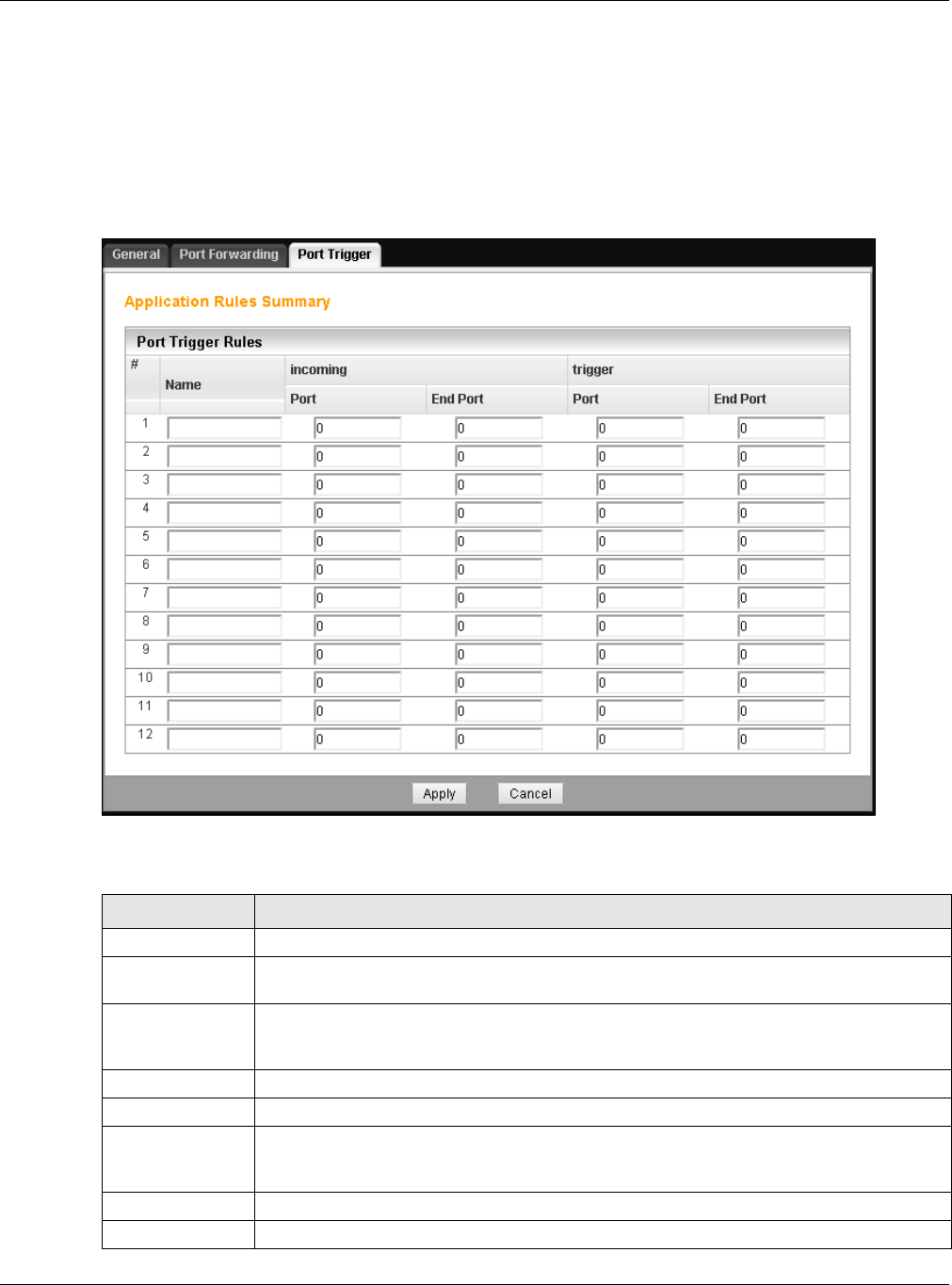
Chapter 14 NAT
EMG2926-Q10A User’s Guide
125
14.4 Port Trigger Screen
To change your EMG2926-Q10A’s trigger port settings, click Network > NAT > Port Trigger. The
screen appears as shown.
Note: Only one LAN computer can use a trigger port (range) at a time.
Figure 84 Network > NAT > Port Trigger
The following table describes the labels in this screen.
Table 54 Network > NAT > Port Trigger
LABEL DESCRIPTION
#This is the rule index number (read-only).
Name Type a unique name (up to 15 characters) for identification purposes. All characters are
permitted - including spaces.
Incoming Incoming is a port (or a range of ports) that a server on the WAN uses when it sends out
a particular service. The EMG2926-Q10A forwards the traffic with this port (or range of
ports) to the client computer on the LAN that requested the service.
Port Type a port number or the starting port number in a range of port numbers.
End Port Type a port number or the ending port number in a range of port numbers.
Trigger The trigger port is a port (or a range of ports) that causes (or triggers) the EMG2926-
Q10A to record the IP address of the LAN computer that sent the traffic to a server on the
WAN.
Port Type a port number or the starting port number in a range of port numbers.
End Port Type a port number or the ending port number in a range of port numbers.

Chapter 14 NAT
EMG2926-Q10A User’s Guide
126
14.5 Technical Reference
The following section contains additional technical information about the EMG2926-Q10A features
described in this chapter.
14.5.1 NATPort Forwarding: Services and Port Numbers
A port forwarding set is a list of inside (behind NAT on the LAN) servers, for example, web or FTP,
that you can make accessible to the outside world even though NAT makes your whole inside
network appear as a single machine to the outside world.
Use the Port Forwarding screen to forward incoming service requests to the server(s) on your
local network. You may enter a single port number or a range of port numbers to be forwarded, and
the local IP address of the desired server. The port number identifies a service; for example, web
service is on port 80 and FTP on port 21. In some cases, such as for unknown services or where one
server can support more than one service (for example both FTP and web service), it might be
better to specify a range of port numbers.
In addition to the servers for specified services, NAT supports a default server. A service request
that does not have a server explicitly designated for it is forwarded to the default server. If the
default is not defined, the service request is simply discarded.
Note: Many residential broadband ISP accounts do not allow you to run any server
processes (such as a Web or FTP server) from your location. Your ISP may
periodically check for servers and may suspend your account if it discovers any
active services at your location. If you are unsure, refer to your ISP.
14.5.2 NAT Port Forwarding Example
Let's say you want to assign ports 21-25 to one FTP, Telnet and SMTP server (A in the example),
port 80 to another (B in the example) and assign a default server IP address of 192.168.0.35 to a
third (C in the example). You assign the LAN IP addresses and the ISP assigns the WAN IP address.
The NAT network appears as a single host on the Internet.
Apply Click Apply to save your changes back to the EMG2926-Q10A.
Cancel Click Cancel to begin configuring this screen afresh.
Table 54 Network > NAT > Port Trigger (continued)
LABEL DESCRIPTION
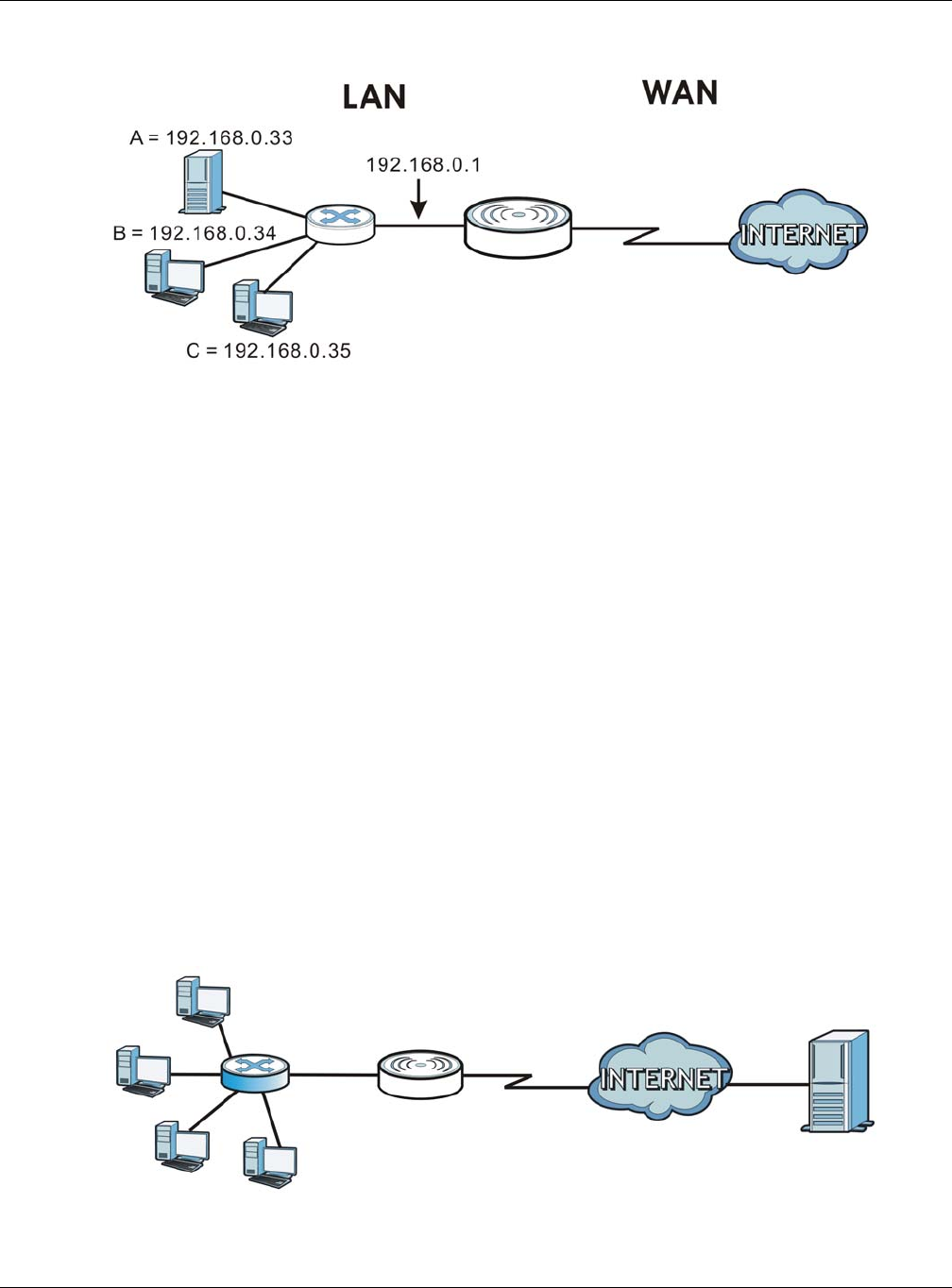
Chapter 14 NAT
EMG2926-Q10A User’s Guide
127
Figure 85 Multiple Servers Behind NAT Example
14.5.3 Trigger Port Forwarding
Some services use a dedicated range of ports on the client side and a dedicated range of ports on
the server side. With regular port forwarding you set a forwarding port in NAT to forward a service
(coming in from the server on the WAN) to the IP address of a computer on the client side (LAN).
The problem is that port forwarding only forwards a service to a single LAN IP address. In order to
use the same service on a different LAN computer, you have to manually replace the LAN
computer's IP address in the forwarding port with another LAN computer's IP address.
Trigger port forwarding solves this problem by allowing computers on the LAN to dynamically take
turns using the service. The EMG2926-Q10A records the IP address of a LAN computer that sends
traffic to the WAN to request a service with a specific port number and protocol (a "trigger" port).
When the EMG2926-Q10A's WAN port receives a response with a specific port number and protocol
("incoming" port), the EMG2926-Q10A forwards the traffic to the LAN IP address of the computer
that sent the request. After that computer’s connection for that service closes, another computer on
the LAN can use the service in the same manner. This way you do not need to configure a new IP
address each time you want a different LAN computer to use the application.
14.5.4 Trigger Port Forwarding Example
The following is an example of trigger port forwarding.
Figure 86 Trigger Port Forwarding Process: Example
1Jane requests a file from the Real Audio server (port 7070).
Jane’s computer
Real Audio Server
Port 7070

Chapter 14 NAT
EMG2926-Q10A User’s Guide
128
2Port 7070 is a “trigger” port and causes the EMG2926-Q10A to record Jane’s computer IP address.
The EMG2926-Q10A associates Jane's computer IP address with the "incoming" port range of 6970-
7170.
3The Real Audio server responds using a port number ranging between 6970-7170.
4The EMG2926-Q10A forwards the traffic to Jane’s computer IP address.
5Only Jane can connect to the Real Audio server until the connection is closed or times out. The
EMG2926-Q10A times out in three minutes with UDP (User Datagram Protocol), or two hours with
TCP/IP (Transfer Control Protocol/Internet Protocol).
14.5.5 Two Points To Remember About Trigger Ports
1Trigger events only happen on data that is coming from inside the EMG2926-Q10A and going to the
outside.
2If an application needs a continuous data stream, that port (range) will be tied up so that another
computer on the LAN can’t trigger it.
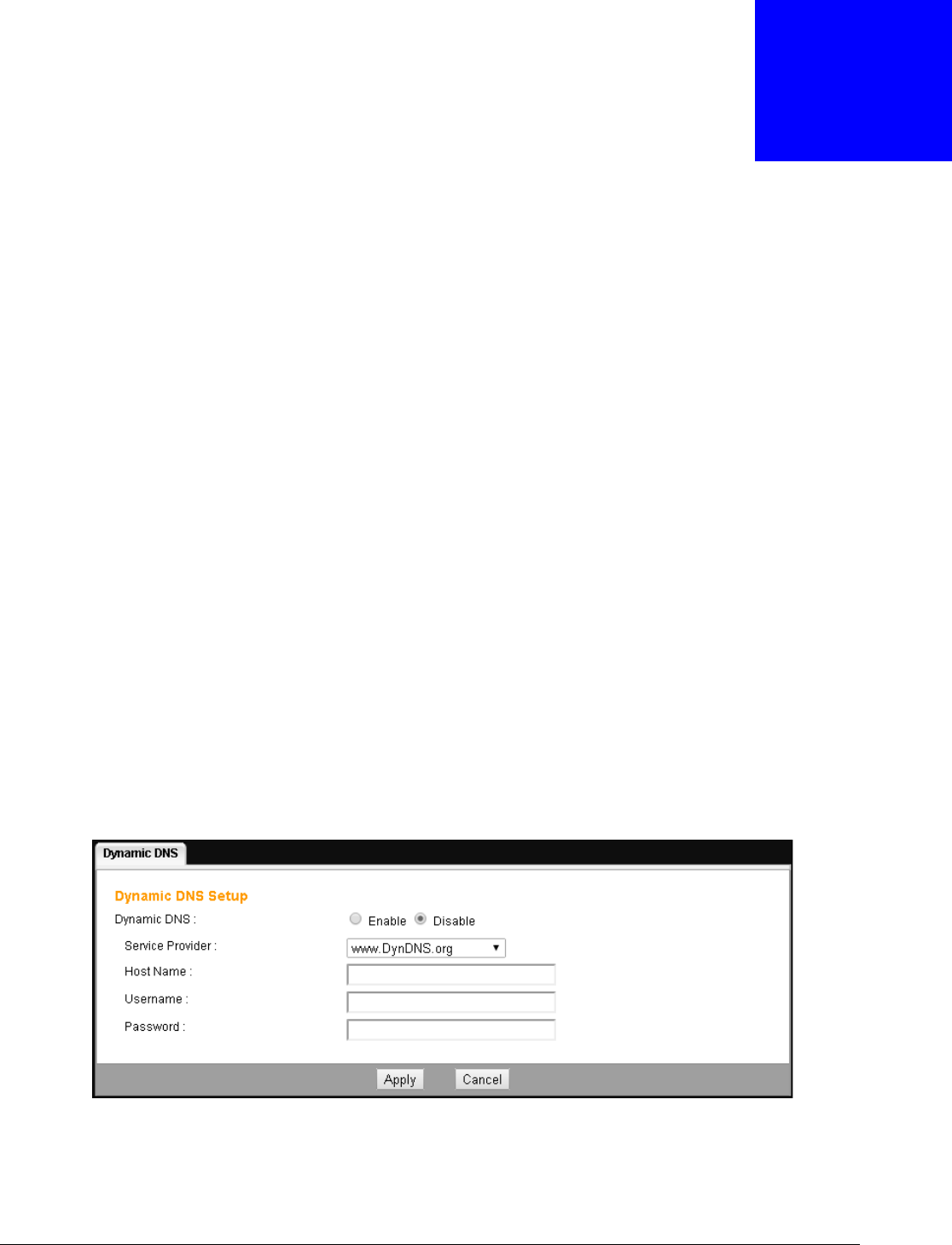
EMG2926-Q10A User’s Guide
129
CHAPTER 15
DDNS
15.1 Overview
DDNS services let you use a domain name with a dynamic IP address.
15.1.1 What You Need To Know
The following terms and concepts may help as you read through this chapter.
What is DDNS?
Dynamic Domain Name Service (DDNS) services let you use a fixed domain name with a dynamic
IP address. Users can always use the same domain name instead of a different dynamic IP address
that changes each time to connect to the EMG2926-Q10A or a server in your network.
Note: The EMG2926-Q10A must have a public global IP address and you should have
your registered DDNS account information on hand.
15.2 General
To change your EMG2926-Q10A’s DDNS, click Network > DDNS. The screen appears as shown.
Figure 87 Dynamic DNS

Chapter 15 DDNS
EMG2926-Q10A User’s Guide
130
The following table describes the labels in this screen.
Table 55 Dynamic DNS
LABEL DESCRIPTION
Dynamic DNS Select Enable to use dynamic DNS. Select Disable to turn this feature off.
Service Provider Select the name of your Dynamic DNS service provider.
Host Name Enter a host names in the field provided. You can specify up to two host names in the
field separated by a comma (",").
Usename Enter your user name.
Password Enter the password assigned to you.
Apply Click Apply to save your changes back to the EMG2926-Q10A.
Cancel Click Cancel to begin configuring this screen afresh.
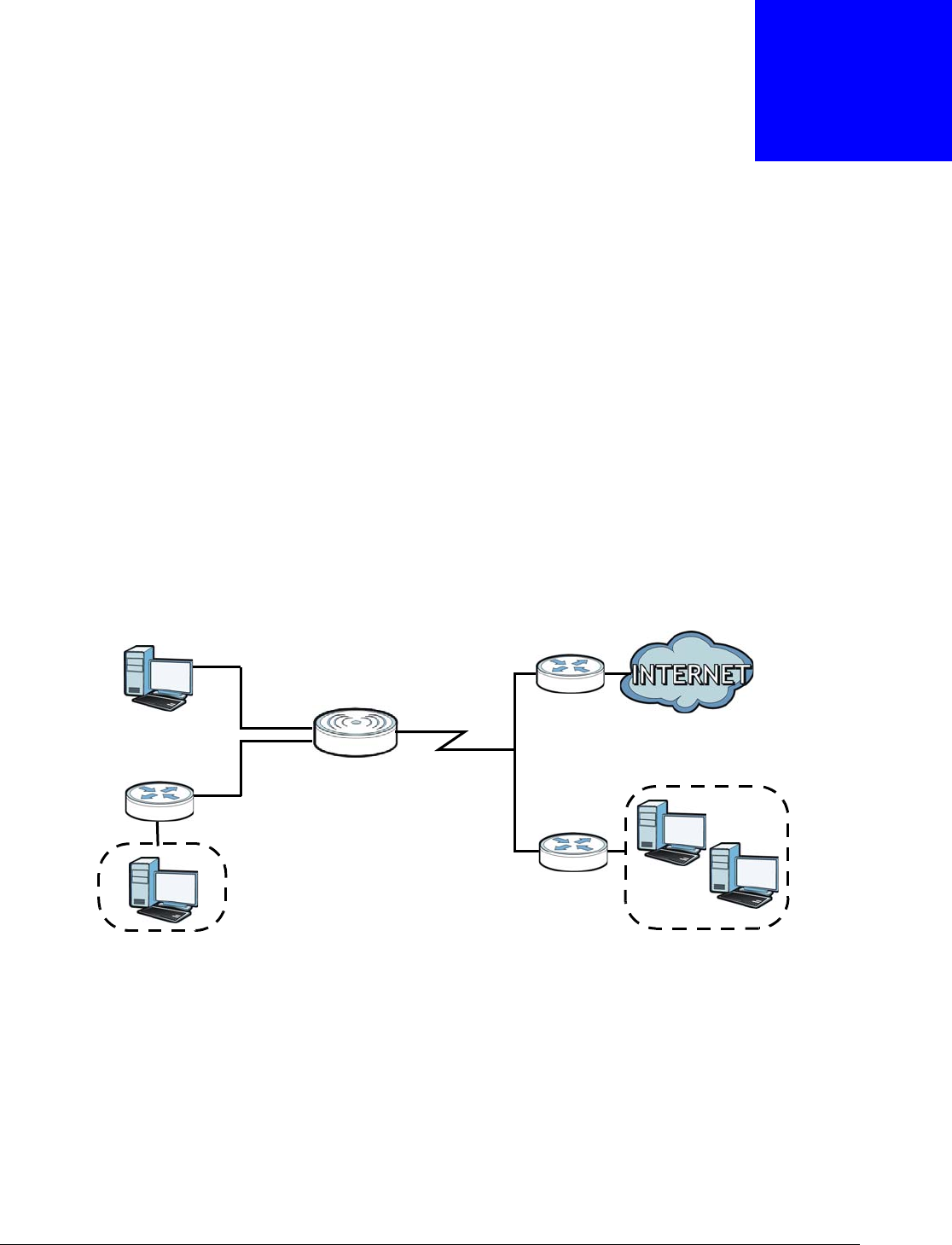
EMG2926-Q10A User’s Guide
131
CHAPTER 16
Static Route
16.1 Overview
This chapter shows you how to configure static routes for your EMG2926-Q10A.
The EMG2926-Q10A usually uses the default gateway to route outbound traffic from computers on
the LAN to the Internet. To have the EMG2926-Q10A send data to devices not reachable through
the default gateway, use static routes.
For example, the next figure shows a computer (A) connected to the EMG2926-Q10A’s LAN
interface. The EMG2926-Q10A routes most traffic from A to the Internet through the EMG2926-
Q10A’s default gateway (R1). You create one static route to connect to services offered by your ISP
behind router R2. You create another static route to communicate with a separate network behind
a router R3 connected to the LAN.
Figure 88 Example of Static Routing Topology
16.2 IP Static Route Screen
Click Network > Static Route to open the Static Route screen.
WAN
R1
R2
A
R3
LAN
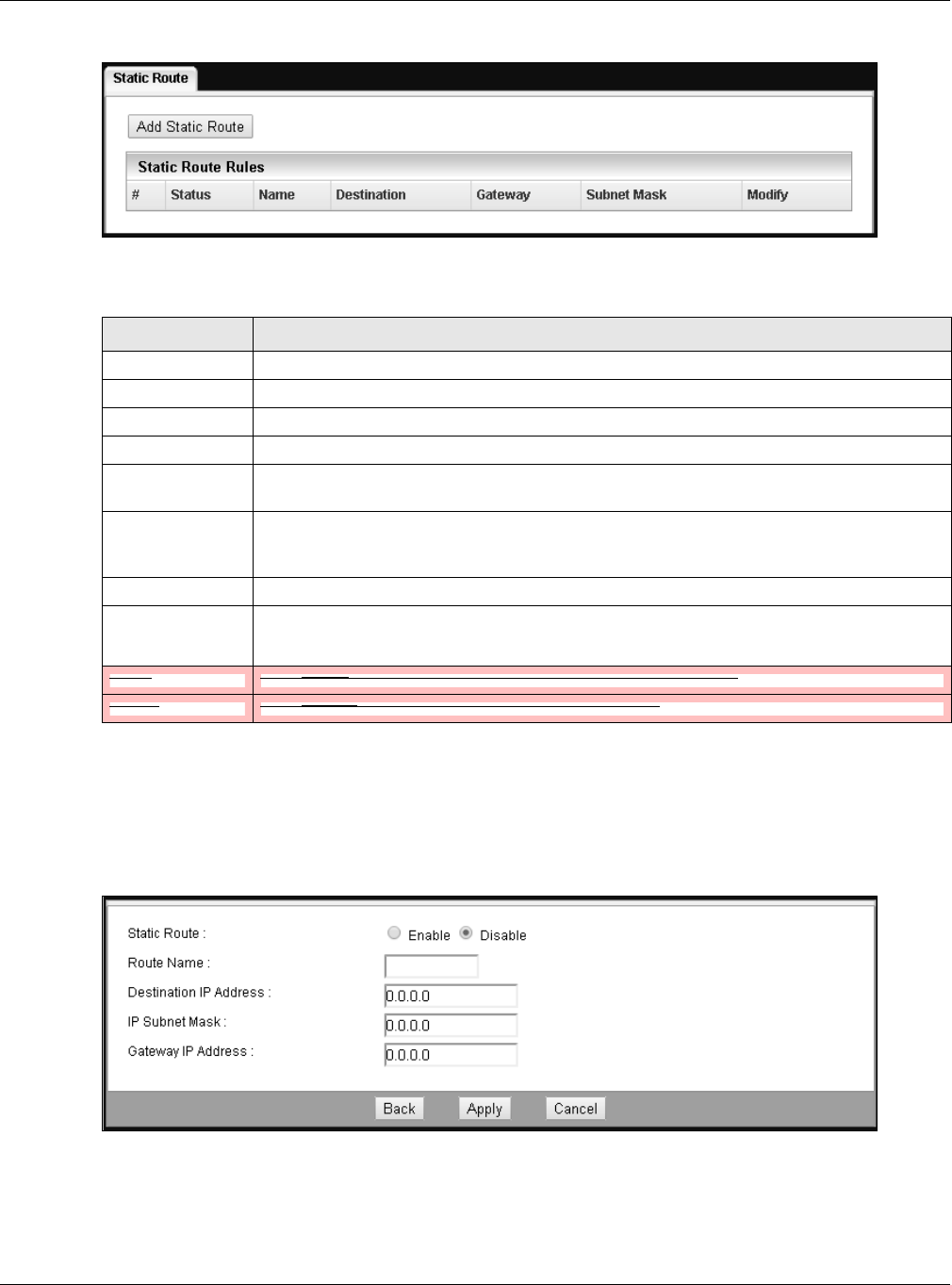
Chapter 16 Static Route
EMG2926-Q10A User’s Guide
132
Figure 89 Network > Static Route
The following table describes the labels in this screen.
16.2.1 Add/Edit Static Route
Click the Add Static Route button or a rule’s Edit icon in the Static Route screen. Use this screen
to configure the required information for a static route.
Figure 90 Network > Static Route: Add/Edit
Table 56 Network > Static Route
LABEL DESCRIPTION
Add Static Route Click this to create a new rule.
#This is the number of an individual static route.
Status This field indicates whether the rule is active (yellow bulb) or not (gray bulb).
Name This field displays a name to identify this rule.
Destination This parameter specifies the IP network address of the final destination. Routing is always
based on network number.
Gateway This is the IP address of the gateway. The gateway is a router or switch on the same
network segment as the device's LAN or WAN port. The gateway helps forward packets to
their destinations.
Subent Mask This parameter specifies the IP network subnet mask of the final destination.
Modify Click the Edit icon to open a screen where you can modify an existing rule.
Click the Delete icon to remove a rule from the EMG2926-Q10A.
Apply Click Apply to save your changes back to the EMG2926-Q10A.
Cancel Click Cancel to begin configuring this screen afresh.

Chapter 16 Static Route
EMG2926-Q10A User’s Guide
133
The following table describes the labels in this screen.
Table 57 Network > Static Route: Add/Edit
LABEL DESCRIPTION
Static Route Select to enable or disable this rule.
Route Name Type a name to identify this rule. You can use up to printable English keyboard
characters, including spaces.
Destination IP
Address
This parameter specifies the IP network address of the final destination. Routing is
always based on network number. If you need to specify a route to a single host, use a
subnet mask of 255.255.255.255 in the subnet mask field to force the network number to
be identical to the host ID.
IP Subnet Mask Enter the IP subnet mask here.
Gateway IP
Address
Enter the IP address of the next-hop gateway. The gateway is a router or switch on the
same segment as your EMG2926-Q10A's interface(s). The gateway helps forward packets
to their destinations.
Back Click Back to return to the previous screen without saving.
Apply Click Apply to save your changes back to the EMG2926-Q10A.
Cancel Click Cancel to set every field in this screen to its last-saved value.
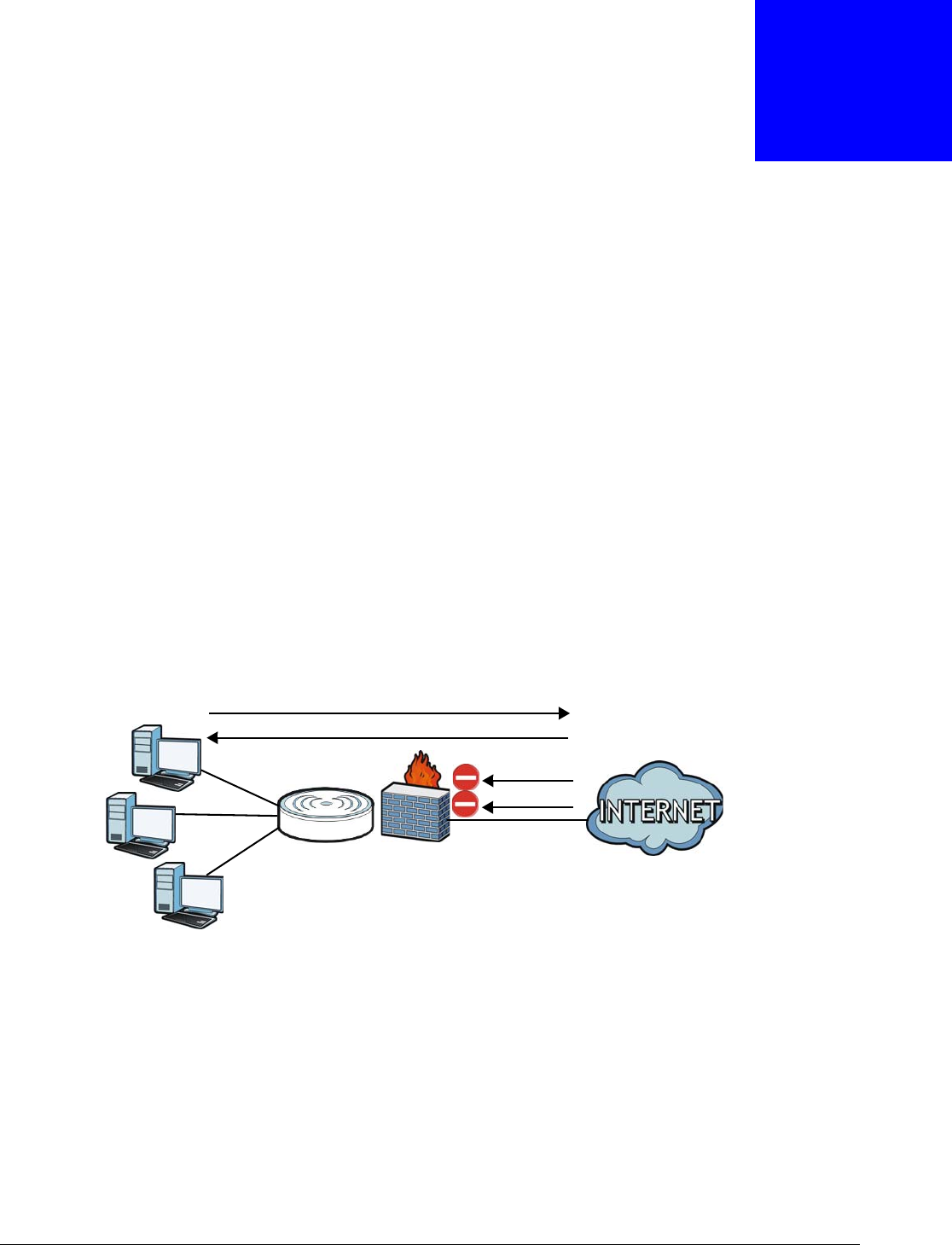
EMG2926-Q10A User’s Guide
134
CHAPTER 17
Firewall
17.1 Overview
Use these screens to enable and configure the firewall that protects your EMG2926-Q10A and your
LAN from unwanted or malicious traffic.
Enable the firewall to protect your LAN computers from attacks by hackers on the Internet and
control access between the LAN and WAN. By default the firewall:
• allows traffic that originates from your LAN computers to go to all of the networks.
• blocks traffic that originates on the other networks from going to the LAN.
The following figure illustrates the default firewall action. User A can initiate an IM (Instant
Messaging) session from the LAN to the WAN (1). Return traffic for this session is also allowed (2).
However other traffic initiated from the WAN is blocked (3 and 4).
Figure 91 Default Firewall Action
17.1.1 What You Can Do
•Use the General screen to enable or disable the EMG2926-Q10A’s firewall (Section 17.2 on page
136).
•Use the Services screen to enable service blocking, enter/delete/modify the services you want
to block and the date/time you want to block them (Section 17.3 on page 136).
17.1.2 What You Need To Know
The following terms and concepts may help as you read through this chapter.
WAN
LAN
3
4
1
2
A

Chapter 17 Firewall
EMG2926-Q10A User’s Guide
135
What is a Firewall?
Originally, the term “firewall” referred to a construction technique designed to prevent the spread of
fire from one room to another. The networking term "firewall" is a system or group of systems that
enforces an access-control policy between two networks. It may also be defined as a mechanism
used to protect a trusted network from a network that is not trusted. Of course, firewalls cannot
solve every security problem. A firewall is one of the mechanisms used to establish a network
security perimeter in support of a network security policy. It should never be the only mechanism or
method employed. For a firewall to guard effectively, you must design and deploy it appropriately.
This requires integrating the firewall into a broad information-security policy. In addition, specific
policies must be implemented within the firewall itself.
Stateful Inspection Firewall
Stateful inspection firewalls restrict access by screening data packets against defined access rules.
They make access control decisions based on IP address and protocol. They also "inspect" the
session data to assure the integrity of the connection and to adapt to dynamic protocols. These
firewalls generally provide the best speed and transparency; however, they may lack the granular
application level access control or caching that some proxies support. Firewalls, of one type or
another, have become an integral part of standard security solutions for enterprises.
About the EMG2926-Q10A Firewall
The EMG2926-Q10A’s firewall feature physically separates the LAN and the WAN and acts as a
secure gateway for all data passing between the networks.
It is a stateful inspection firewall and is designed to protect against Denial of Service attacks when
activated (click the General tab under Firewall and then click the Enable Firewall check box).
The EMG2926-Q10A's purpose is to allow a private Local Area Network (LAN) to be securely
connected to the Internet. The EMG2926-Q10A can be used to prevent theft, destruction and
modification of data, as well as log events, which may be important to the security of your network.
The EMG2926-Q10A is installed between the LAN and a broadband modem connecting to the
Internet. This allows it to act as a secure gateway for all data passing between the Internet and the
LAN.
The EMG2926-Q10A has one Ethernet WAN port and four Ethernet LAN ports, which are used to
physically separate the network into two areas.The WAN (Wide Area Network) port attaches to the
broadband (cable or DSL) modem to the Internet.
The LAN (Local Area Network) port attaches to a network of computers, which needs security from
the outside world. These computers will have access to Internet services such as e-mail, FTP and
the World Wide Web. However, "inbound access" is not allowed (by default) unless the remote host
is authorized to use a specific service.
Guidelines For Enhancing Security With Your Firewall
1Change the default password via Web Configurator.
2Think about access control before you connect to the network in any way, including attaching a
modem to the port.
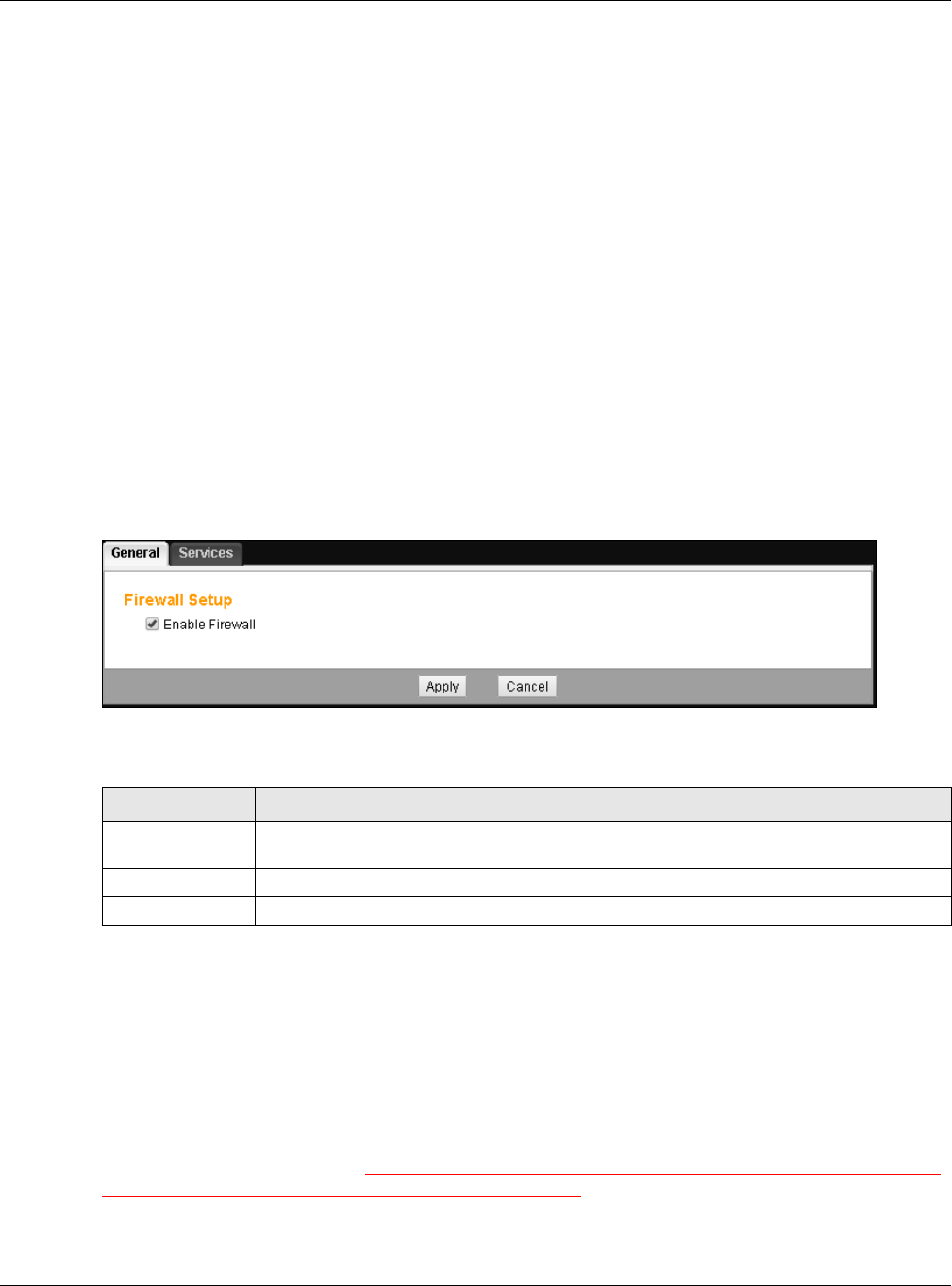
Chapter 17 Firewall
EMG2926-Q10A User’s Guide
136
3Limit who can access your router.
4Don't enable any local service (such as NTP) that you don't use. Any enabled service could present
a potential security risk. A determined hacker might be able to find creative ways to misuse the
enabled services to access the firewall or the network.
5For local services that are enabled, protect against misuse. Protect by configuring the services to
communicate only with specific peers, and protect by configuring rules to block packets for the
services at specific interfaces.
6Protect against IP spoofing by making sure the firewall is active.
7Keep the firewall in a secured (locked) room.
17.2 General Screen
Use this screen to enable or disable the EMG2926-Q10A’s firewall, and set up firewall logs. Click
Security > Firewall to open the General screen.
Figure 92 Security > Firewall > General l
The following table describes the labels in this screen.
17.3 Services Screen
If an outside user attempts to probe an unsupported port on your EMG2926-Q10A, an ICMP
response packet is automatically returned. This allows the outside user to know the EMG2926-Q10A
exists. Use this screen to prevent the ICMP response packet from being sent. This keeps outsiders
from discovering your EMG2926-Q10A when unsupported ports are probed.
You can also use this screen to enable service blocking, and enter/delete/modify the services you
want to block and the date/time you want to block them enable/add/delete/modify an IPv4 firewall
rule.
Table 58 Security > Firewall > General
LABEL DESCRIPTION
Enable Firewall Select this check box to activate the firewall. The EMG2926-Q10A performs access control
and protects against Denial of Service (DoS) attacks when the firewall is activated.
Apply Click Apply to save the settings.
Cancel Click Cancel to start configuring this screen again.
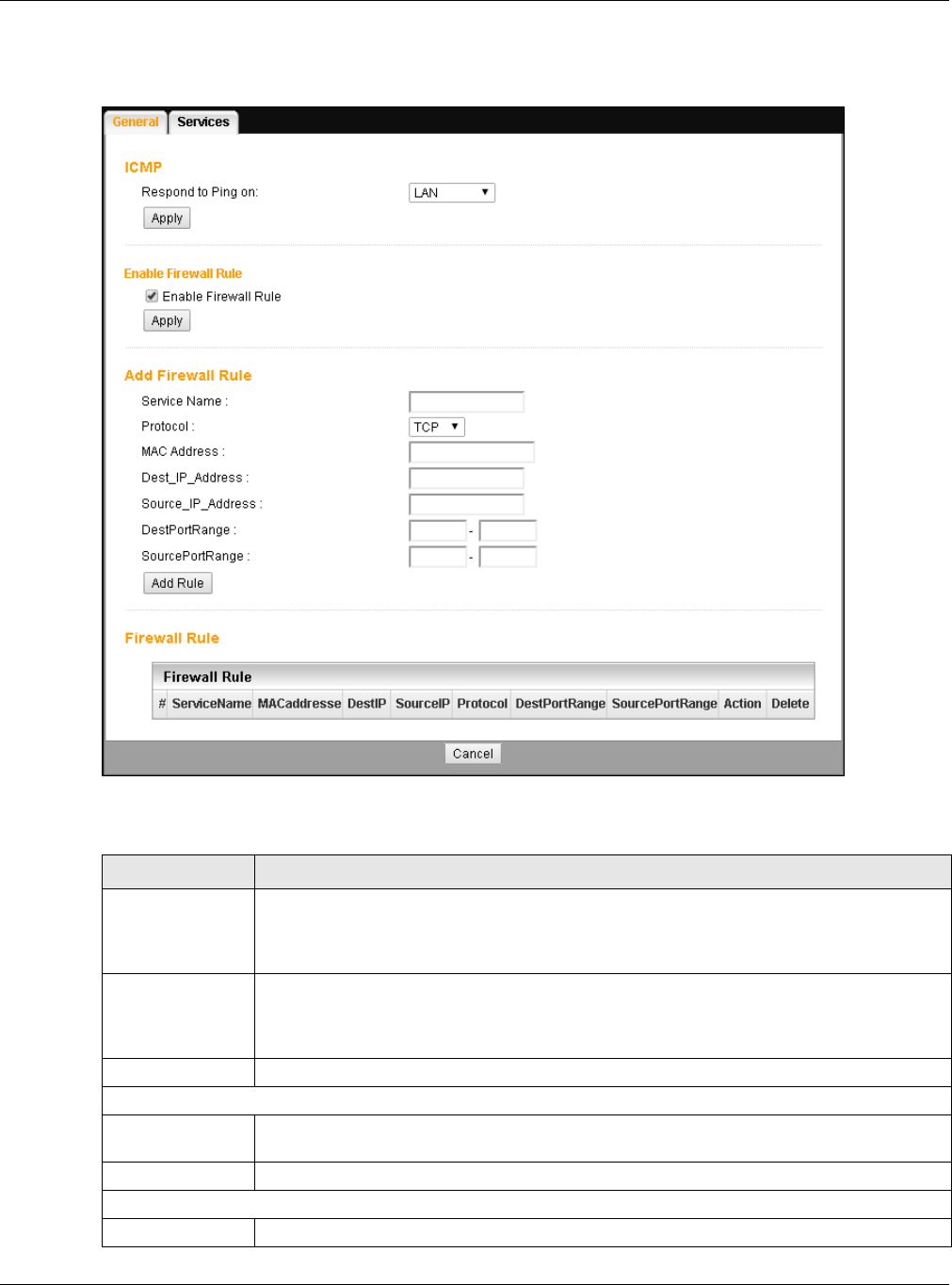
Chapter 17 Firewall
EMG2926-Q10A User’s Guide
137
Click Security > Firewall > Services. The screen appears as shown next.
Figure 93 Security > Firewall > Services l
The following table describes the labels in this screen.
Table 59 Security > Firewall > Services
LABEL DESCRIPTION
ICMP Internet Control Message Protocol is a message control and error-reporting protocol
between a host server and a gateway to the Internet. ICMP uses Internet Protocol (IP)
datagrams, but the messages are processed by the TCP/IP software and directly apparent
to the application user.
Respond to Ping
on
The EMG2926-Q10A will not respond to any incoming Ping requests when Disable is
selected. Select LAN to reply to incoming LAN Ping requests. Select WAN to reply to
incoming WAN Ping requests. Otherwise select LAN&WAN to reply to all incoming LAN
and WAN Ping requests.
Apply Click Apply to save the settings.
Enable Firewall Rule
Enable Firewall
Rule
Select this check box to activate the firewall rules that you define (see Add Firewall Rule
below).
Apply Click Apply to save the settings.
Add Firewall Rule
Service Name Enter a name that identifies or describes the firewall rule.

Chapter 17 Firewall
EMG2926-Q10A User’s Guide
138
See Appendix C on page 221 for commonly used services and port numbers.
Protocol Select the protocol (TCP, UDP or ICMP) used to transport the packets for which you want
to apply the firewall rule.
MAC Address Enter the MAC address of the computer for which the firewall rule applies.
Dest IP Address Enter the IP address of the computer to which traffic for the application or service is
entering.
The EMG2926-Q10A applies the firewall rule to traffic initiating from this computer.
Source IP Address Enter the IP address of the computer that initializes traffic for the application or service.
The EMG2926-Q10A applies the firewall rule to traffic initiating from this computer.
Dest Port Range Enter the port number/range of the destination that define the traffic type, for example
TCP port 80 defines web traffic.
Source Port
Range
Enter the port number/range of the source that define the traffic type, for example TCP
port 80 defines web traffic.
Add Rule Click Add to save the firewall rule.
Firewall Rule
#This is your firewall rule number. The ordering of your rules is important as rules are
applied in turn.
Service Name This is a name that identifies or describes the firewall rule.
MAC address This is the MAC address of the computer for which the firewall rule applies.
Dest IP This is the IP address of the computer to which traffic for the application or service is
entering.
Source IP This is the IP address of the computer from which traffic for the application or service is
initialized.
Protocol This is the protocol (TCP, UDP or ICMP) used to transport the packets for which you want
to apply the firewall rule.
Dest Port Range This is the port number/range of the destination that define the traffic type, for example
TCP port 80 defines web traffic.
Source Port
Range
This is the port number/range of the source that define the traffic type, for example TCP
port 80 defines web traffic.
Action DROP - Traffic matching the conditions of the firewall rule are stopped.
Delete Click Delete to remove the firewall rule.
Cancel Click Cancel to start configuring this screen again.
Table 59 Security > Firewall > Services (continued)
LABEL DESCRIPTION

EMG2926-Q10A User’s Guide
139
CHAPTER 18
Content Filtering
18.1 Overview
This chapter provides a brief overview of content filtering using the embedded web GUI.
Internet content filtering allows you to create and enforce Internet access policies tailored to your
needs. Content filtering is the ability to block certain web features or specific URL keywords.
18.1.1 What You Need To Know
The following terms and concepts may help as you read through this chapter.
Content Filtering Profiles
Content filtering allows you to block certain web features, such as cookies, and/or block access to
specific web sites. For example, you can configure one policy that blocks John Doe’s access to arts
and entertainment web pages.
A content filtering profile conveniently stores your custom settings for the following features.
Keyword Blocking URL Checking
The EMG2926-Q10A checks the URL’s domain name (or IP address) and file path separately when
performing keyword blocking.
The URL’s domain name or IP address is the characters that come before the first slash in the URL.
For example, with the URL www.zyxel.com.tw/news/pressroom.php, the domain name is
www.zyxel.com.tw.
The file path is the characters that come after the first slash in the URL. For example, with the URL
www.zyxel.com.tw/news/pressroom.php, the file path is news/pressroom.php.
Since the EMG2926-Q10A checks the URL’s domain name (or IP address) and file path separately, it
will not find items that go across the two. For example, with the URL www.zyxel.com.tw/news/
pressroom.php, the EMG2926-Q10A would find “tw” in the domain name (www.zyxel.com.tw). It
would also find “news” in the file path (news/pressroom.php) but it would not find “tw/news”.
18.2 Content Filter
Use this screen to restrict web features, add keywords for blocking and designate a trusted
computer. Click Security > Content Filter to open the Content Filter screen.
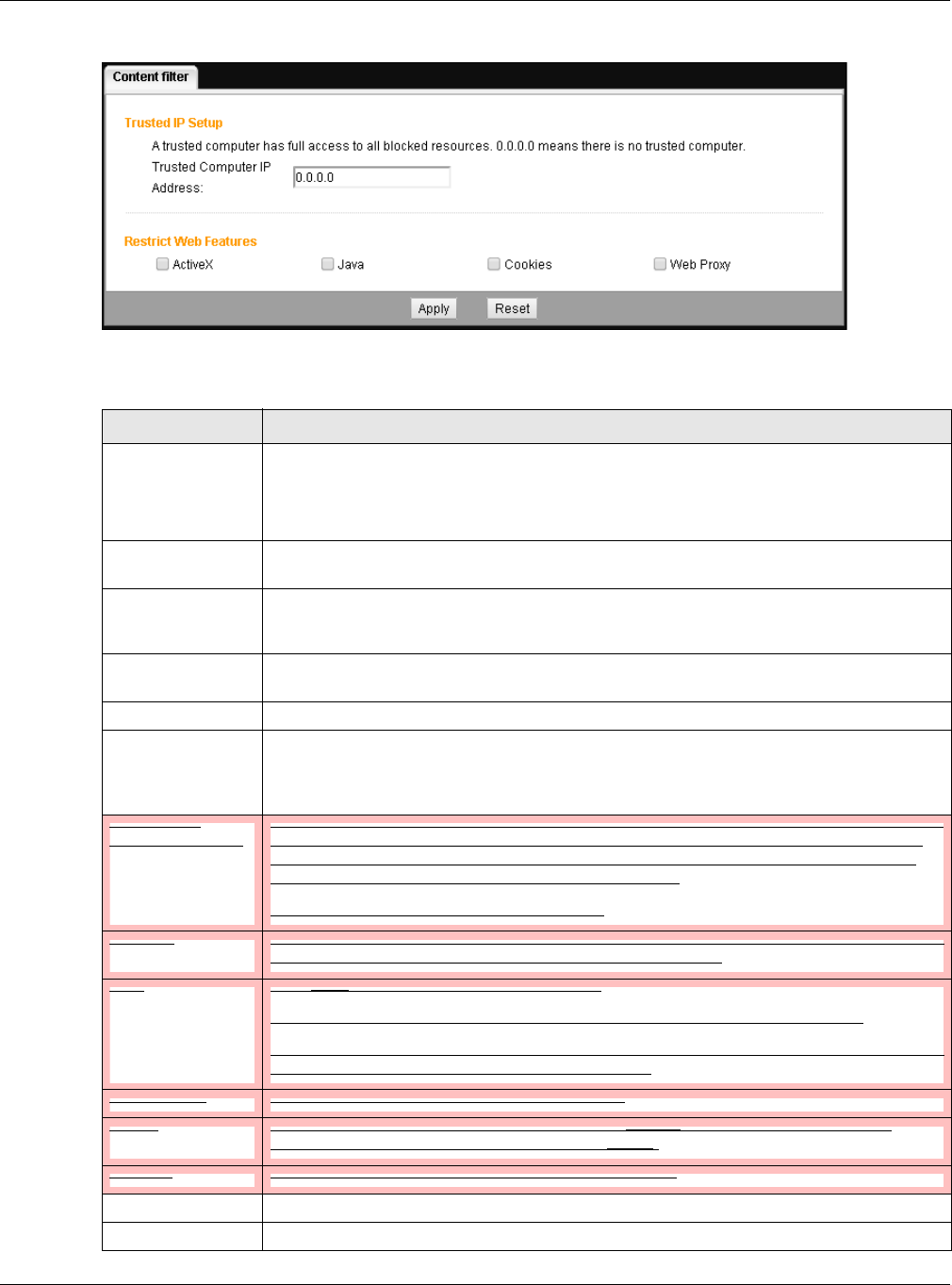
Chapter 18 Content Filtering
EMG2926-Q10A User’s Guide
140
Figure 94 Security > Content Filter
The following table describes the labels in this screen.
Table 60 Security > Content Filter
LABEL DESCRIPTION
Trusted IP Setup To enable this feature, type an IP address of any one of the computers in your network
that you want to have as a trusted computer. This allows the trusted computer to have
full access to all features that are configured to be blocked by content filtering.
Leave this field blank to have no trusted computers.
Restrict Web
Features
Select the box(es) to restrict a feature. When you download a page containing a
restricted feature, that part of the web page will appear blank or grayed out.
ActiveX A tool for building dynamic and active Web pages and distributed object applications.
When you visit an ActiveX Web site, ActiveX controls are downloaded to your browser,
where they remain in case you visit the site again.
Java A programming language and development environment for building downloadable Web
components or Internet and intranet business applications of all kinds.
Cookies Used by Web servers to track usage and provide service based on ID.
Web Proxy A server that acts as an intermediary between a user and the Internet to provide
security, administrative control, and caching service. When a proxy server is located on
the WAN it is possible for LAN users to circumvent content filtering by pointing to this
proxy server.
Enable URL
Keyword Blocking
The EMG2926-Q10A can block Web sites with URLs that contain certain keywords in the
domain name or IP address. For example, if the keyword "bad" was enabled, all sites
containing this keyword in the domain name or IP address will be blocked, e.g., URL
http://www.website.com/bad.html would be blocked.
Select this check box to enable this feature.
Keyword Type a keyword in this field. You may use any character (up to 64 characters). Wildcards
are not allowed. You can also enter a numerical IP address.
Add Click Add after you have typed a keyword.
Repeat this procedure to add other keywords. Up to 64 keywords are allowed.
When you try to access a web page containing a keyword, you will get a message telling
you that the content filter is blocking this request.
Keyword List This list displays the keywords already added.
Delete Highlight a keyword in the lower box and click Delete to remove it. The keyword
disappears from the text box after you click Apply.
Clear All Click this button to remove all of the listed keywords.
Apply Click Apply to save your changes.
Cancel Click Cancel to begin configuring this screen afresh

Chapter 18 Content Filtering
EMG2926-Q10A User’s Guide
141
18.3 Technical Reference
The following section contains additional technical information about the EMG2926-Q10A features
described in this chapter.
18.3.1 Customizing Keyword Blocking URL Checking
You can use commands to set how much of a website’s URL the content filter is to check for
keyword blocking. See the appendices for information on how to access and use the command
interpreter.
Domain Name or IP Address URL Checking
By default, the EMG2926-Q10A checks the URL’s domain name or IP address when performing
keyword blocking.
This means that the EMG2926-Q10A checks the characters that come before the first slash in the
URL.
For example, with the URL www.zyxel.com.tw/news/pressroom.php, content filtering only searches
for keywords within www.zyxel.com.tw.
Full Path URL Checking
Full path URL checking has the EMG2926-Q10A check the characters that come before the last
slash in the URL.
For example, with the URL www.zyxel.com.tw/news/pressroom.php, full path URL checking
searches for keywords within www.zyxel.com.tw/news/.
Use the ip urlfilter customize actionFlags 6 [disable | enable] command to extend (or
not extend) the keyword blocking search to include the URL's full path.
File Name URL Checking
Filename URL checking has the EMG2926-Q10A check all of the characters in the URL.
For example, filename URL checking searches for keywords within the URL www.zyxel.com.tw/
news/pressroom.php.
Use the ip urlfilter customize actionFlags 8 [disable | enable] command to extend (or
not extend) the keyword blocking search to include the URL's complete filename.
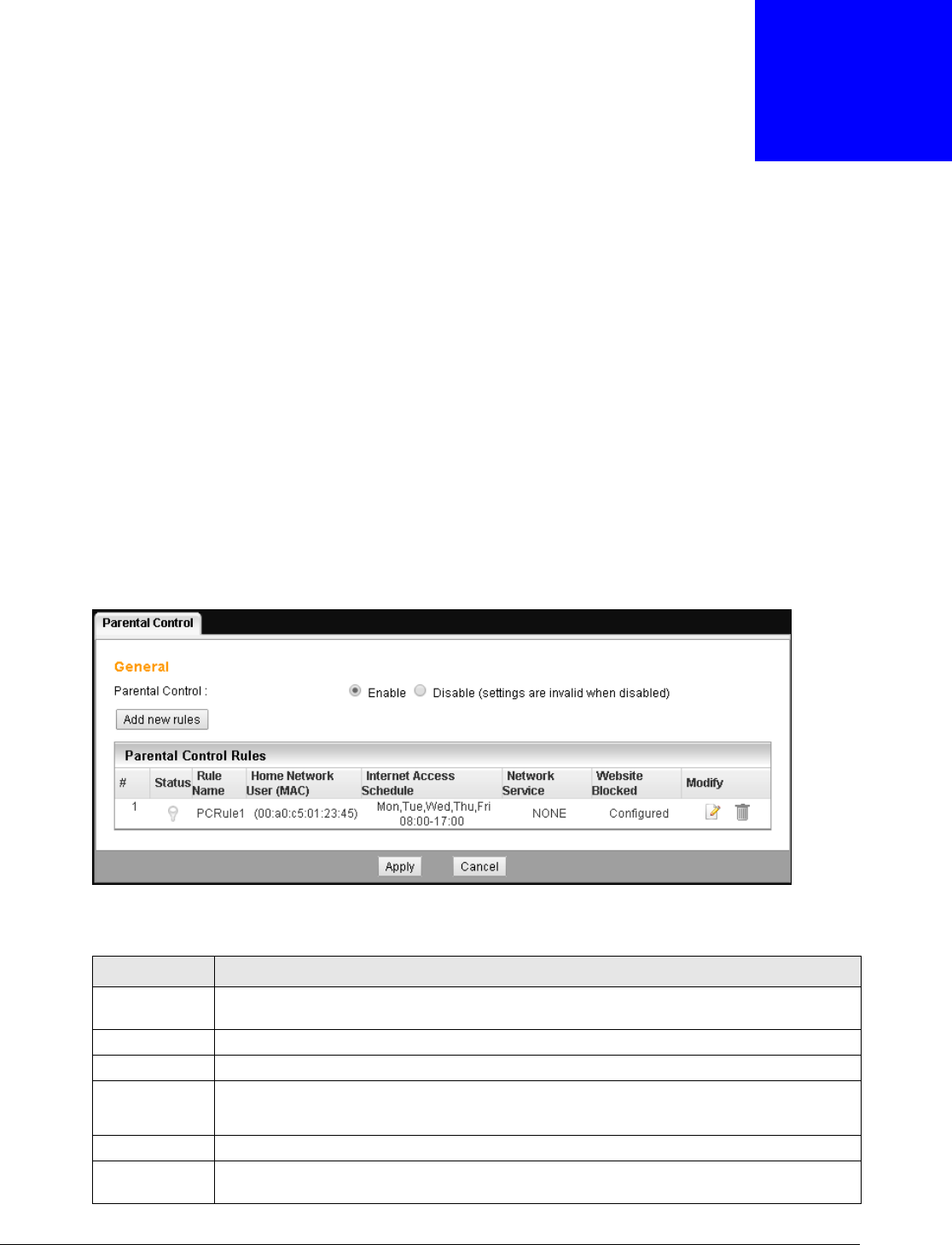
EMG2926-Q10A User’s Guide
142
CHAPTER 19
Parental Control
19.1 Overview
Parental control allows you to block web sites with the specific URL. You can also define time
periods and days during which the EMG2926-Q10A performs parental control on a specific user.
19.2 The Parental Control Screen
Use this screen to enable parental control, view the parental control rules and schedules.
Click Configuration > Security > Parental Control to open the following screen.
Figure 95 Security > Parental Control
The following table describes the fields in this screen.
Table 61 Security > Parental Control
LABEL DESCRIPTION
Parental
Control
Select Enable to activate parental control.
Add new rules Click this if you want to configure a new parental control rule.
#This shows the index number of the rule.
Status This indicates whether the rule is active or not.
A yellow bulb signifies that this rule is active. A gray bulb signifies that this rule is not active.
Rule Name This shows the name of the rule.
Home Network
User (MAC)
This shows the MAC address of the LAN user’s computer to which this rule applies.

Chapter 19 Parental Control
EMG2926-Q10A User’s Guide
143
19.2.1 Add/Edit a Parental Control Rule
Click Add new rules in the Parental Control screen to add a new rule or click the Edit icon next
to an existing rule to edit it. Use this screen to configure a restricted access schedule and/or URL
filtering settings to block the users on your network from accessing certain web sites.
Internet Access
Schedule
This shows the day(s) and time on which parental control is enabled.
Network
Service
This shows whether the network service is configured. If not, None will be shown.
Website Block This shows whether the website block is configured. If not, None will be shown.
Modify Click the Edit icon to go to the screen where you can edit the rule.
Click the Delete icon to delete an existing rule.
Apply Click Apply to save your changes.
Cancel Click Cancel to restore your previously saved settings.
Table 61 Security > Parental Control (continued)
LABEL DESCRIPTION
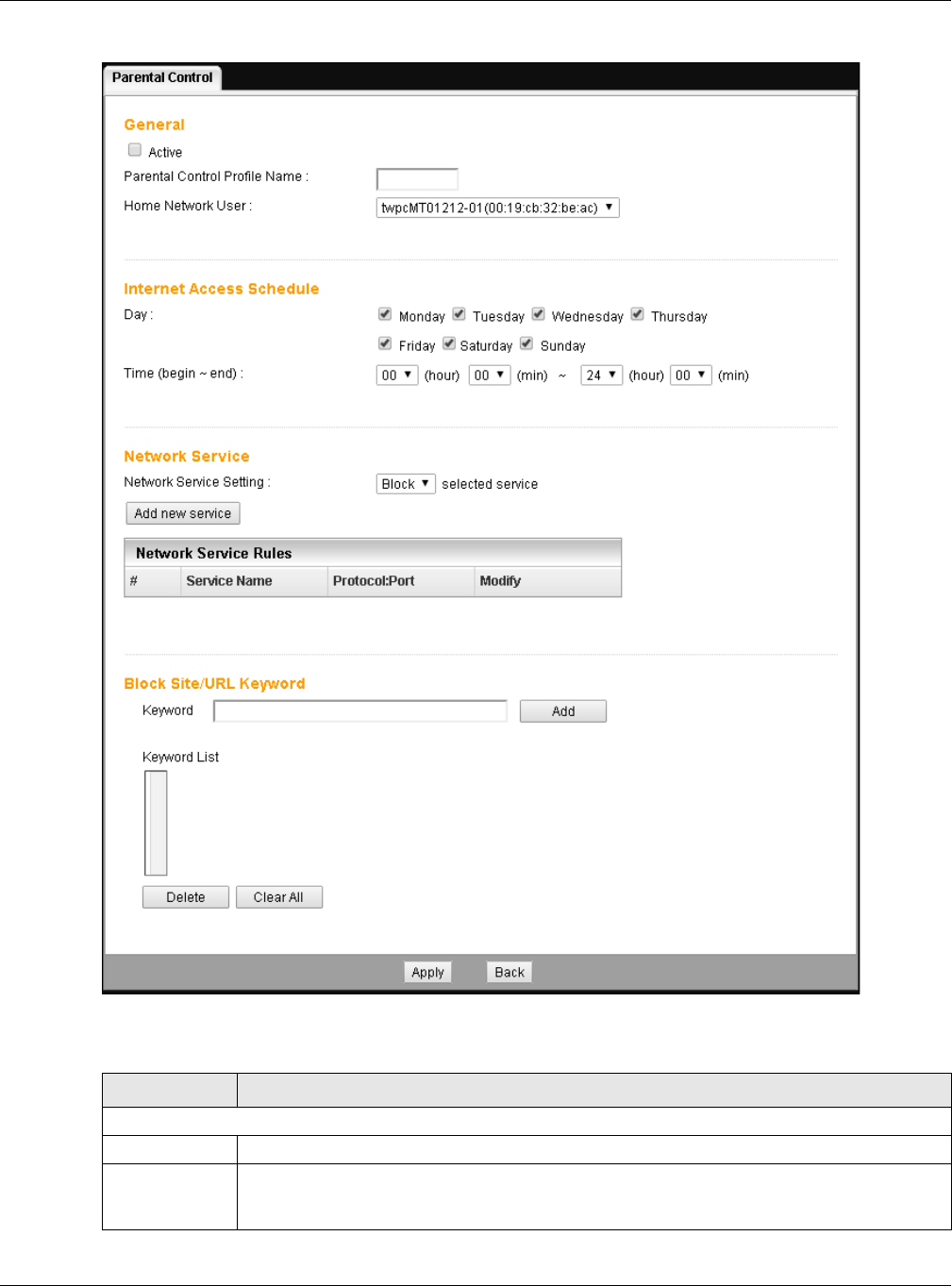
Chapter 19 Parental Control
EMG2926-Q10A User’s Guide
144
Figure 96 Security > Parental Control: Add/Edit
The following table describes the fields in this screen.
Table 62 Security > Parental Control: Add/Edit
LABEL DESCRIPTION
General
Active Select the checkbox to activate this parental control rule.
Parental
Control Profile
Name
Enter a descriptive name for the rule.

Chapter 19 Parental Control
EMG2926-Q10A User’s Guide
145
Home Network
User
Select the LAN user that you want to apply this rule to from the drop-down list box. If you
select Custom, enter the LAN user’s MAC address. If you select All, the rule applies to all
LAN users.
Internet Access Schedule
Day Select check boxes for the days that you want the EMG2926-Q10A to perform parental
control.
Time Drag the time bar to define the time that the LAN user is allowed access.
Network Service
Network
Service Setting
If you select Block, the EMG2926-Q10A prohibits the users from viewing the Web sites with
the URLs using the services listed below.
If you select Allow, the EMG2926-Q10A blocks access to all URLs all services except ones
listed below.
Add new
service
Click this to show a screen in which you can add a new service rule. You can configure the
Service Name, Protocol, and Port of the new rule.
#This shows the index number of the rule. Select the checkbox next to the rule to activate it.
Service Name This shows the name of the service.
Protocol:Port This shows the protocol and the port of the service.
Modify Click the Edit icon to go to the screen where you can edit the rule.
Click the Delete icon to delete an existing rule.
Blocked Site/
URL Keyword
Click Add to show a screen to enter the URL of web site or URL keyword to which the
EMG2926-Q10A blocks access. Click Delete to remove it.
Apply Click Apply to save your settings back to the EMG2926-Q10A.
Cancel Click Cancel to restore your previously saved settings.
Table 62 Security > Parental Control: Add/Edit (continued)
LABEL DESCRIPTION
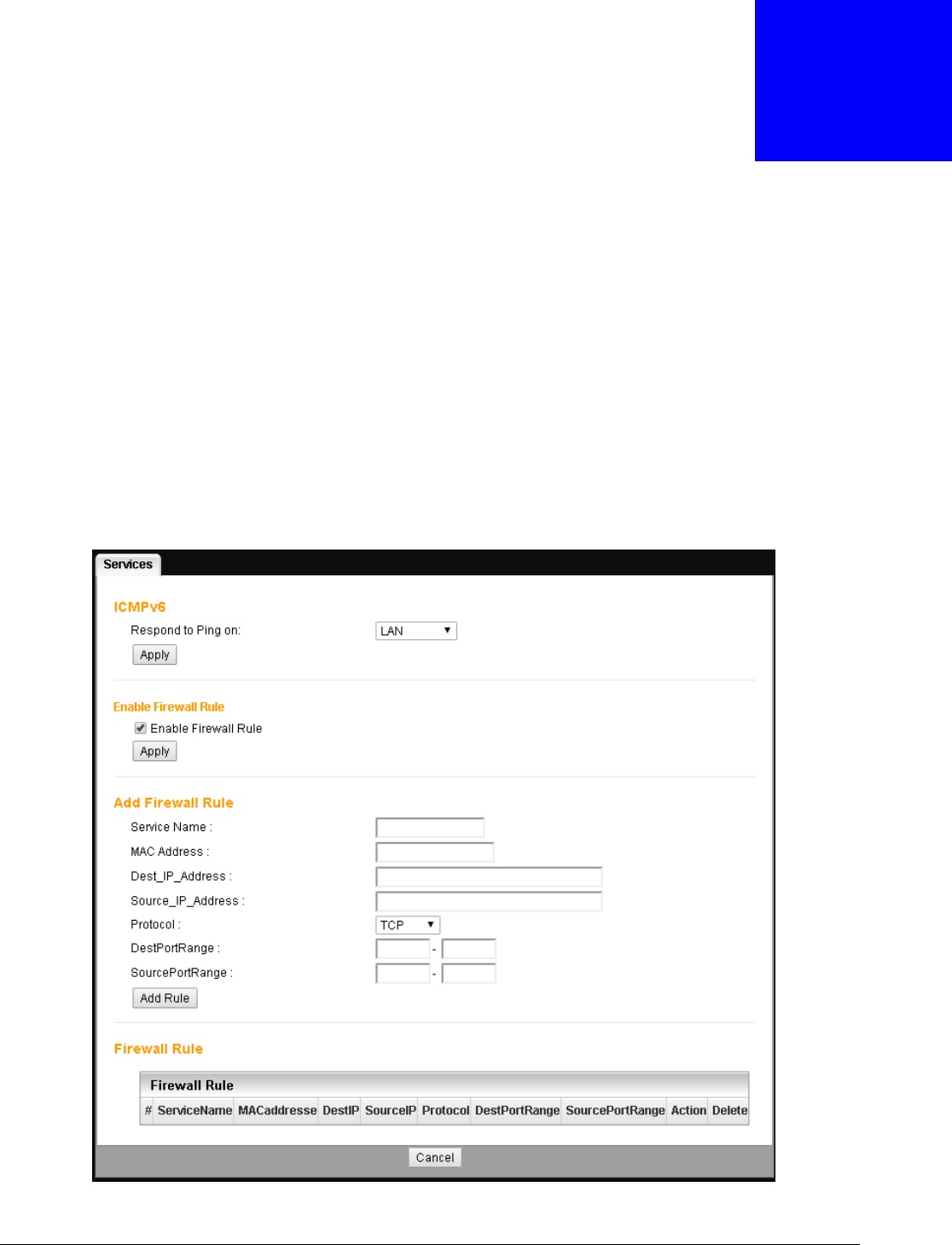
EMG2926-Q10A User’s Guide
146
CHAPTER 20
IPv6 Firewall
20.1 Overview
This chapter shows you how to enable and create IPv6 firewall rules to block unwanted IPv6 traffic.
20.2 The IPv6 Firewall Screen
Click Configuration > Security > IPv6 Firewall. The Service screen appears as shown.
Figure 97 Configuration > Security > IPv6 Firewall

Chapter 20 IPv6 Firewall
EMG2926-Q10A User’s Guide
147
The following table describes the labels in this screen.
Table 63 Configuration > Security > IPv6 Firewall
LABEL DESCRIPTION
ICMPv6 Internet Control Message Protocol for IPv6 (ICMPv6 or ICMP for IPv6) is defined in RFC
4443. ICMPv6 has a preceding Next Header value of 58, which is different from the
value used to identify ICMP for IPv4. ICMPv6 is an integral part of IPv6. IPv6 nodes use
ICMPv6 to report errors encountered in packet processing and perform other diagnostic
functions, such as "ping".
Respond to Ping on The EMG2926-Q10A will not respond to any incoming Ping requests when Disable is
selected. Select LAN to reply to incoming LAN Ping requests. Select WAN to reply to
incoming WAN Ping requests. Otherwise select LAN&WAN to reply to all incoming LAN
and WAN Ping requests.
Apply Click Apply to save the settings.
Enable Firewall Rule
Enable Firewall Rule Select this check box to activate the firewall rules that you define (see Add Firewall
Rule below).
Apply Click Apply to save the settings.
Add Firewall Rule
Service Name Enter a name that identifies or describes the firewall rule.
MAC Address Enter the MAC address of the computer for which the firewall rule applies.
Dest_IP_Address Enter the IPv6 address of the computer to which traffic for the application or service is
entering.
The EMG2926-Q10A applies the firewall rule to traffic initiations from this computer.
Source_IP_Address Enter the IPv6 address of the computer that initializes traffic for the application or
service.
The EMG2926-Q10A applies the firewall rule to traffic initiating from this computer.
Protocol Select the protocol (TCP, UDP or ICMP) used to transport the packets for which you
want to apply the firewall rule.
Dest Port Range Enter the port number/range of the destination that define the traffic type, for example
TCP port 80 defines web traffic.
Source Port Range Enter the port number/range of the source that define the traffic type, for example TCP
port 80 defines web traffic.
Add Rule Click Add to save the firewall rule.
Firewall Rule
#This is your firewall rule number. The ordering of your rules is important as rules are
applied in turn.
ServiceName This is a name that identifies or describes the firewall rule.
MACaddress This is the MAC address of the computer for which the firewall rule applies.
DestIP This is the IP address of the computer to which traffic for the application or service is
entering.
SourceIP This is the IP address of the computer to which traffic for the application or service is
initialized.
Protocol This is the protocol (TCP, UDP or ICMP) used to transport the packets for which you
want to apply the firewall rule.
DestPortRange This is the port number/range of the destination that define the traffic type, for
example TCP port 80 defines web traffic.
SourcePortRange This is the port number/range of the source that define the traffic type, for example
TCP port 80 defines web traffic.
Action DROP - Traffic matching the conditions of the firewall rule are stopped.

Chapter 20 IPv6 Firewall
EMG2926-Q10A User’s Guide
148
Delete Click Delete to remove the firewall rule.
Cancel Click Cancel to restore your previously saved settings.
Table 63 Configuration > Security > IPv6 Firewall (continued)
LABEL DESCRIPTION
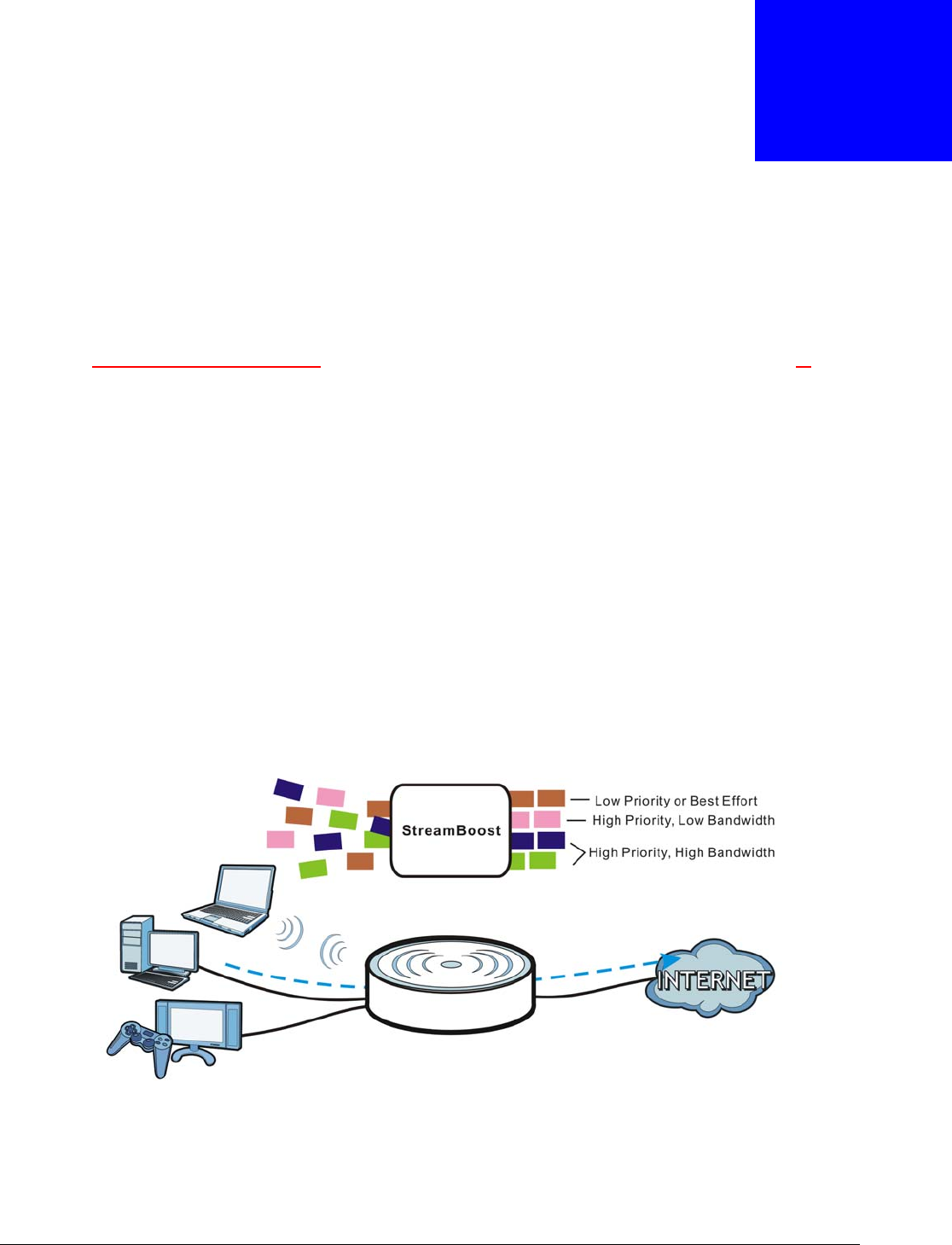
EMG2926-Q10A User’s Guide
149
CHAPTER 21
StreamBoost Management
21.1 Overview
The EMG2926-Q10A supports the new StreamBoost technology, introduced by Qualcomm, to
redistributes traffic over the EMG2926-Q10A for the best possible performance in a home network.
At the time of writing, the StreamBoost feature is disabled on the EMG2926-Q10A.
Streamboost is smart Quality of Service (QoS). Streamboost detects traffic flows and applies traffic
shaping polcies automatically. It gives each device and each application the priority and provides
the exact amount of bandwidth they need at a given time. This helps free up bandwidth for other
applications or connected deivces. If there is not enough bandwidth for optimal performance,
Streamboost makes sure the application or device has the minimum acceptable bandwidth which is
determined according to the StreamBoost’s cloud-based database.
Real-time application traffic (such as on-line games or communications) and video/audio streaming
are given the highest priority. Downloads or torrent files are classified as best effort and placed
lower than general network traffic (general browsing).
In the figure below, the StreamBoost-enabled EMG2926-Q10A differentiates incoming traffic flows
going from the LAN device (A) or wireless device (B) to the Internet. It shapes traffic and gives
priority and allocate bandwidth according to traffic types.
Figure 98 StreamBoost Management Example
A
B
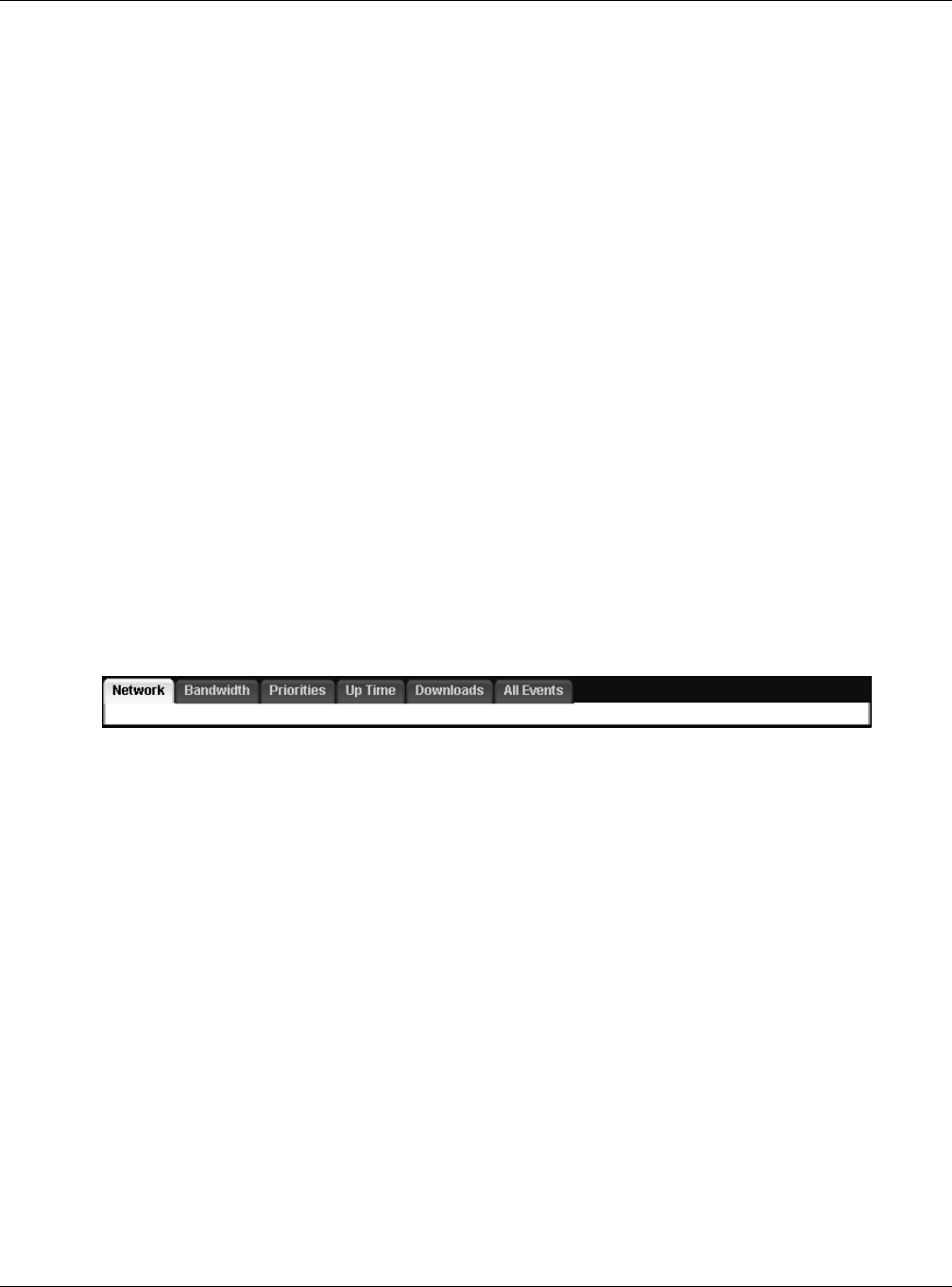
Chapter 21 StreamBoost Management
EMG2926-Q10A User’s Guide
150
21.2 What You Can Do
•Use the Network screen to view transmission data rates between the EMG2926-Q10A and the
Internet or conencted devices (Section 21.3 on page 150).
•Use the Bandwidth screen to configure the maximum allowable bandwidth and enable
automatic update(Section 21.4 on page 150).
•Use the Priorities screen to prioritize the connected devices (Section 21.5 on page 152).
•Use the Up Time screen to view the top five traffic flows transmitting from/to the selected LAN
device(s) (Section 21.6 on page 152).
•Use the Downloads screen to view the type and percentage of most download traffic (Section
21.7 on page 152).
•Use the All Events screen to view the time at which a traffic flow is given bandwidth for optimal,
good or best-effort performance (Section 21.8 on page 153).
21.3 Network Screen
When the StreamBoost feature is enabled, use this screen to view the current upstream and
downstream transmission speeds between the EMG2926-Q10A and the Internet and/or between
the EMG2926-Q10A and the connected device(s) (represented by icons indicating the kind of
network device), including those connecting wirelessly.
Click Management > StreamBoost MGMT > Network to open the Network screen.
Figure 99 Management > StreamBoost Management > Network
21.4 Banwidth Screen
Use this screen to configure the maximum allowable bandwidth on the EMG2926-Q10A and allow
the EMG2926-Q10A to get StreamBoost database updates automatically.
Click Management > StreamBoost MGMT > Bandwidth to open the Bandwidth screen.
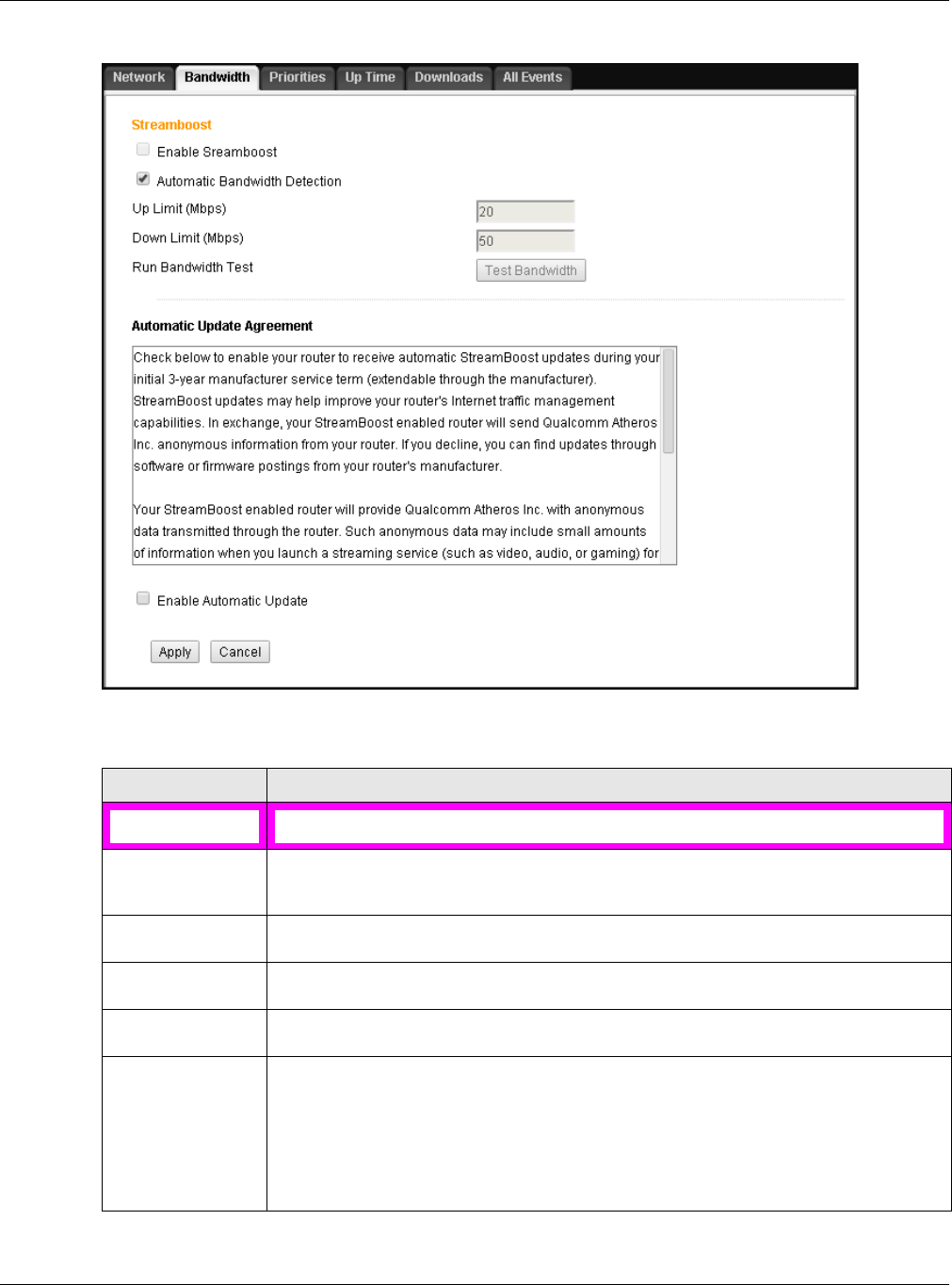
Chapter 21 StreamBoost Management
EMG2926-Q10A User’s Guide
151
Figure 100 Management > StreamBoost Management > Bandwidth
The following table describes the labels in this screen.
Table 64 Management > StreamBoost Management > Bandwidth
LABEL DESCRIPTION
Enable
Streamboost
Select this option to turn on the StreamBoost feature. This field is not configurable at
the time of writing.
Automatic
Bandwidth
Detection
Select this option to control the maximum or minimum amounts of bandwidth that can
be used by traffic.
Up Limit Set the total amount of bandwidth that you want to dedicate to uplink (or outgoing)
traffic. This is traffic from LAN/WLAN to WAN.
Down Limit Set the total amount of bandwidth that you want to dedicate to downlink (or incoming)
traffic. This is traffic from WAN to LAN/WLAN.
Run Bandwidth Test Click Test Bandwidth to determine the maximum bandwidth of your internet
connection.
Enable Automatic
Update
StreamBoost provides a cloud-based service to learn any new type of traffic which is not
in its database and update the table in the EMG2926-Q10A for traffic detection and
policies.
Select this option to have theEMG2926-Q10A automatically receives the StreamBoost
table updates. When there is a new type of traffic which is not in the EMG2926-Q10A’s
table, the EMG2926-Q10A will capture some packets and send them to the StreamBoost
cloud for analysis and database update.
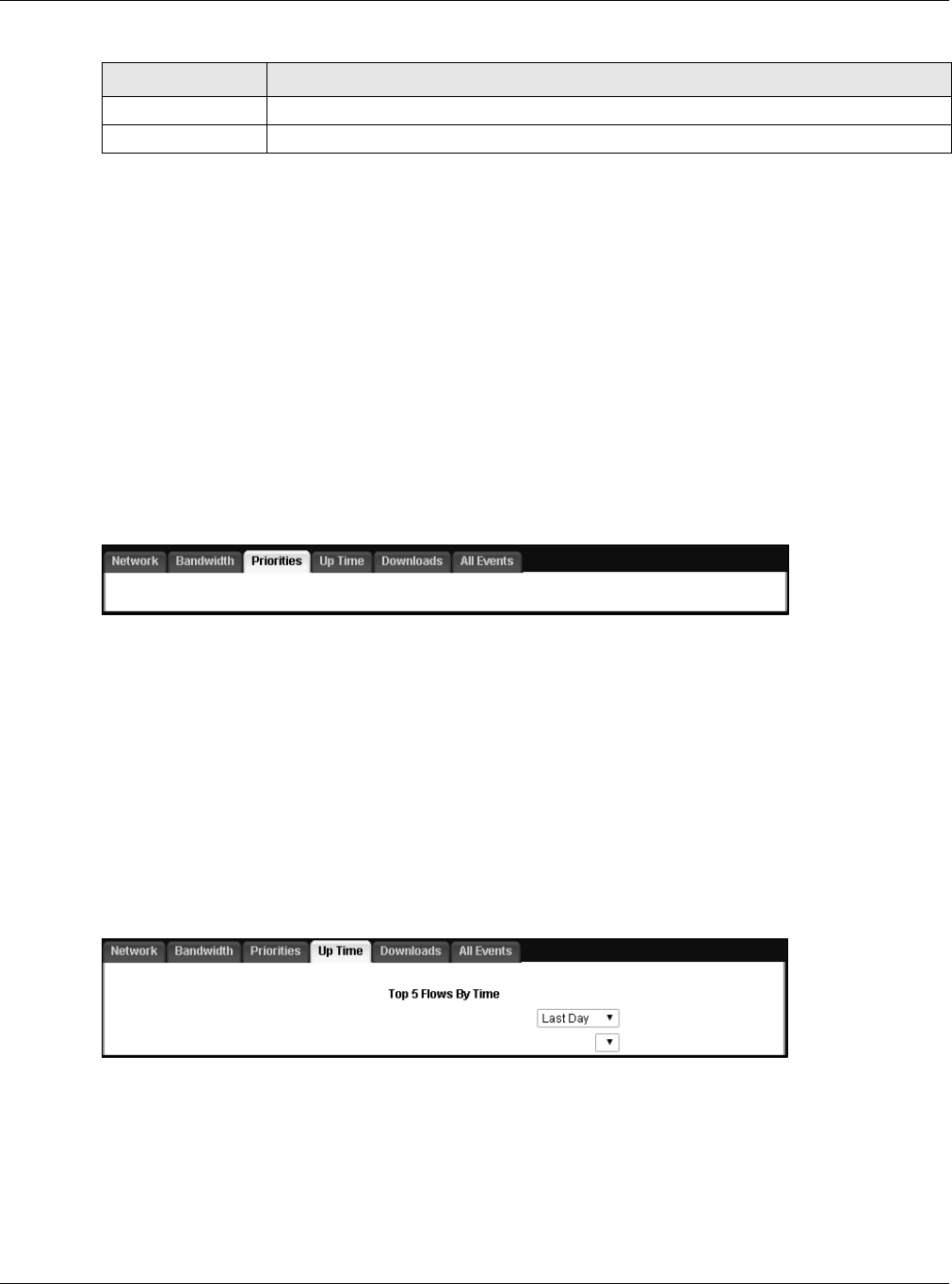
Chapter 21 StreamBoost Management
EMG2926-Q10A User’s Guide
152
21.5 Priorities Screen
The StreamBoost engine on the EMG2926-Q10A can identify the types of connected devices (such
as PC, smart phone, tablet, TV or game console) in your network. When there is not enough
bandwidth to support traffic of the same priority, the EMG2926-Q10A refers to the connected device
priority. Traffic from the device with the lowest priority is classified as best-effort traffic.
When the StreamBoost feature is enabled, use this screen to prioritize the connected devices by
clicking a device’s arrow button to change its position in the list. Click Save to apply your settings.
Otherwise, click Cancel to return the screen to its last-saved settings.
Click Management > StreamBoost MGMT > Priorities to open the Priorities screen.
Figure 101 Management > StreamBoost Management > Priorities
21.6 Up Time Screen
When the StreamBoost feature is enabled, use this screen to view the top five traffic flows
transmitting from/to the selected LAN device(s) in the past one day, one week or one month.
Click Management > StreamBoost MGMT > Up Time to open the Up Time screen.
The y-axis shows the time period over which the traffic flow occurred. The x-axis shows the type of
the traffic flow.
Figure 102 Management > StreamBoost Management > Up Time
21.7 Downloads Screen
When the StreamBoost feature is enabled, use this screen to view the type and percentage of most
download traffic on the EMG2926-Q10A.
Apply Click Apply to save your customized settings.
Cancel Click Cancel to begin configuring this screen afresh.
Table 64 Management > StreamBoost Management > Bandwidth (continued)
LABEL DESCRIPTION
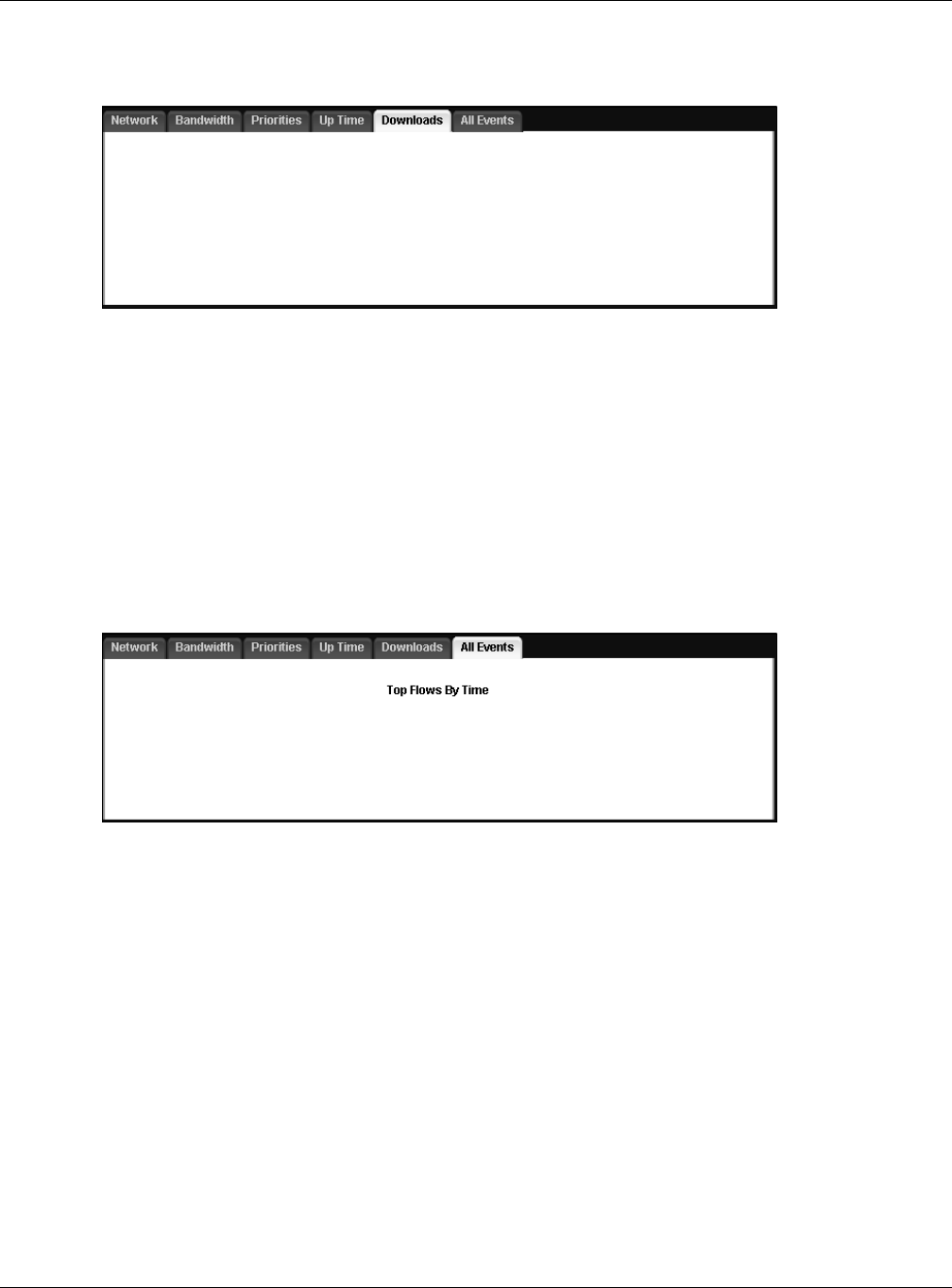
Chapter 21 StreamBoost Management
EMG2926-Q10A User’s Guide
153
Click Management > StreamBoost MGMT > Downloads to open the Downloads screen.
Figure 103 Management > StreamBoost Management > Downloads
21.8 All Events Screen
When the StreamBoost feature is enabled, use this screen to view the time at which a traffic flow is
given enough bandwidth for optimal, good or best-effort performance.
Click Management > StreamBoost MGMT > All Events to open the All Events screen.
The y-axis shows the type of the traffic flow. The x-axis shows the time period over which the traffic
flow got the required bandwidth.
Figure 104 Management > StreamBoost Management > All Events

EMG2926-Q10A User’s Guide
154
CHAPTER 22
Remote Management
22.1 Overview
This chapter provides information on the Remote Management screens.
Remote Management allows you to manage your EMG2926-Q10A from a remote location through
the following interfaces:
•LAN and WAN
•LAN only
•WAN only
Note: The EMG2926-Q10A is managed using the Web Configurator.
22.2 What You Can Do in this Chapter
•Use the WWW screen to define the interface/s from which the EMG2926-Q10A can be managed
remotely using the web and specify a secure client that can manage the EMG2926-Q10A (Section
22.4 on page 155).
•Use the Telnet screen to define the interface/s from which the EMG2926-Q10A can be managed
remotely using Telnet service and specify a secure client that can manage the EMG2926-Q10A
(Section 22.5 on page 156).
•Use the Wake On LAN screen to enable Wake on LAN and remotely turn on a device on the local
network (Section 22.7 on page 159).
22.3 What You Need to Know
Remote management over LAN or WAN will not work when:
1The IP address in the Secured Client IP Address field (Section 22.4 on page 155) does not match
the client IP address. If it does not match, the EMG2926-Q10A will disconnect the session
immediately.
2There is already another remote management session. You may only have one remote
management session running at one time.
3There is a firewall rule that blocks it.
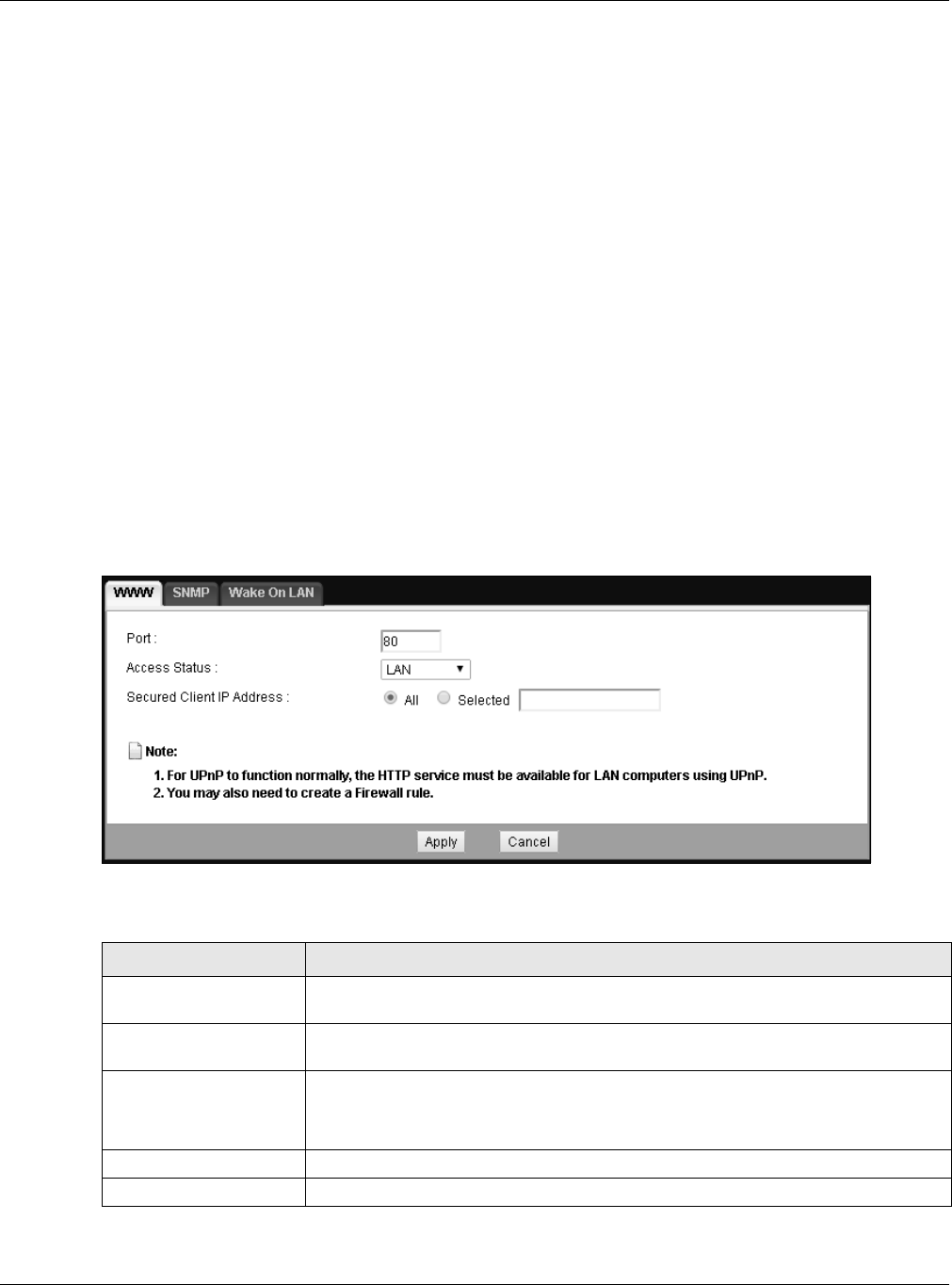
Chapter 22 Remote Management
EMG2926-Q10A User’s Guide
155
22.3.1 Remote Management and NAT
When NAT is enabled:
• Use the EMG2926-Q10A’s WAN IP address when configuring from the WAN.
• Use the EMG2926-Q10A’s LAN IP address when configuring from the LAN.
22.3.2 System Timeout
There is a default system management idle timeout of five minutes (three hundred seconds). The
EMG2926-Q10A automatically logs you out if the management session remains idle for longer than
this timeout period. The management session does not time out when a statistics screen is polling.
You can change the timeout period in the Maintenance > General screen
22.4 WWW Screen
To change your EMG2926-Q10A’s remote management settings, click Management > Remote
MGMT > WWW.
Figure 105 Management > Remote Management > WWW
The following table describes the labels in this screen.
Table 65 Management > Remote Management > WWW
LABEL DESCRIPTION
Port You may change the server port number for a service if needed, however you must
use the same port number in order to use that service for remote management.
Access Status Select the interface(s) through which a computer may access the EMG2926-Q10A
using this service.
Secured Client IP
Address
Select All to allow all computes to access the EMG2926-Q10A.
Otherwise, check Selected and specify the IP address of the computer that can
access the EMG2926-Q10A.
Apply Click Apply to save your customized settings.
Cancel Click Cancel to begin configuring this screen afresh.
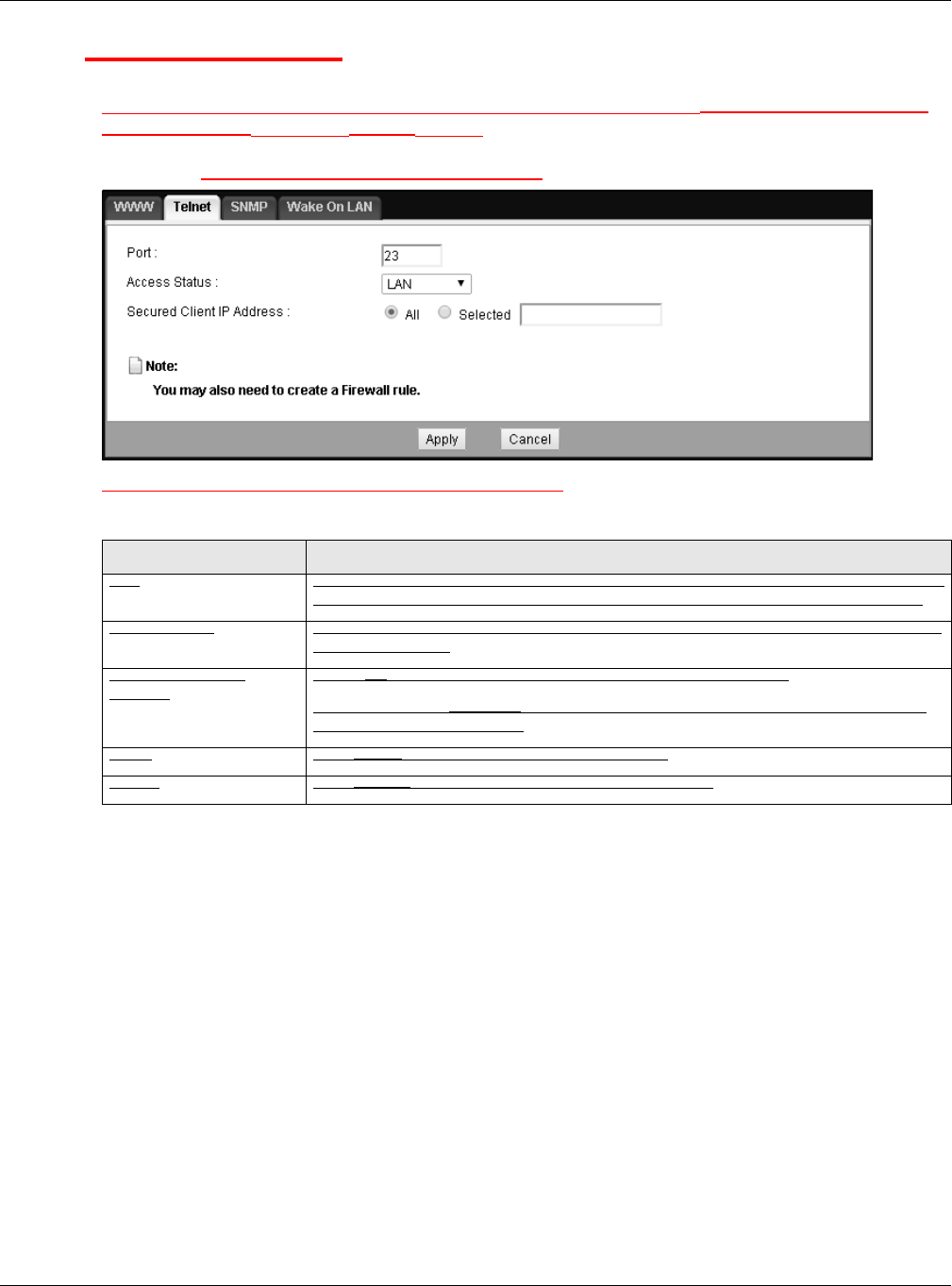
Chapter 22 Remote Management
EMG2926-Q10A User’s Guide
156
22.5 Telnet Screen
To change your EMG2926-Q10A’s remote management settings, click Management > Remote
MGMT > Telnet to open the Telnet screen.
Figure 106 Management > Remote MGMT > Telnet
The following table describes the labels in this screen.
22.6 SNMP
Simple Network Management Protocol is a protocol used for exchanging management information
between network devices. Your EMG2926-Q10A supports SNMP agent functionality, which allows a
manager station to manage and monitor the EMG2926-Q10A through the network. The EMG2926-
Q10A supports SNMP version one (SNMPv1) and version two (SNMPv2c). The next figure illustrates
an SNMP management operation.
Table 66 Management > Remote MGMT > Telnet
LABEL DESCRIPTION
Port You may change the server port number for a service if needed, however you must
use the same port number in order to use that service for remote management.
Access Status Select the interface(s) through which a computer may access the EMG2926-Q10A
using this service.
Secured Client IP
Address
Select All to allow all computes to access the EMG2926-Q10A.
Otherwise, check Selected and specify the IP address of the computer that can
access the EMG2926-Q10A.
Apply Click Apply to save your customized settings.
Cancel Click Cancel to begin configuring this screen afresh.
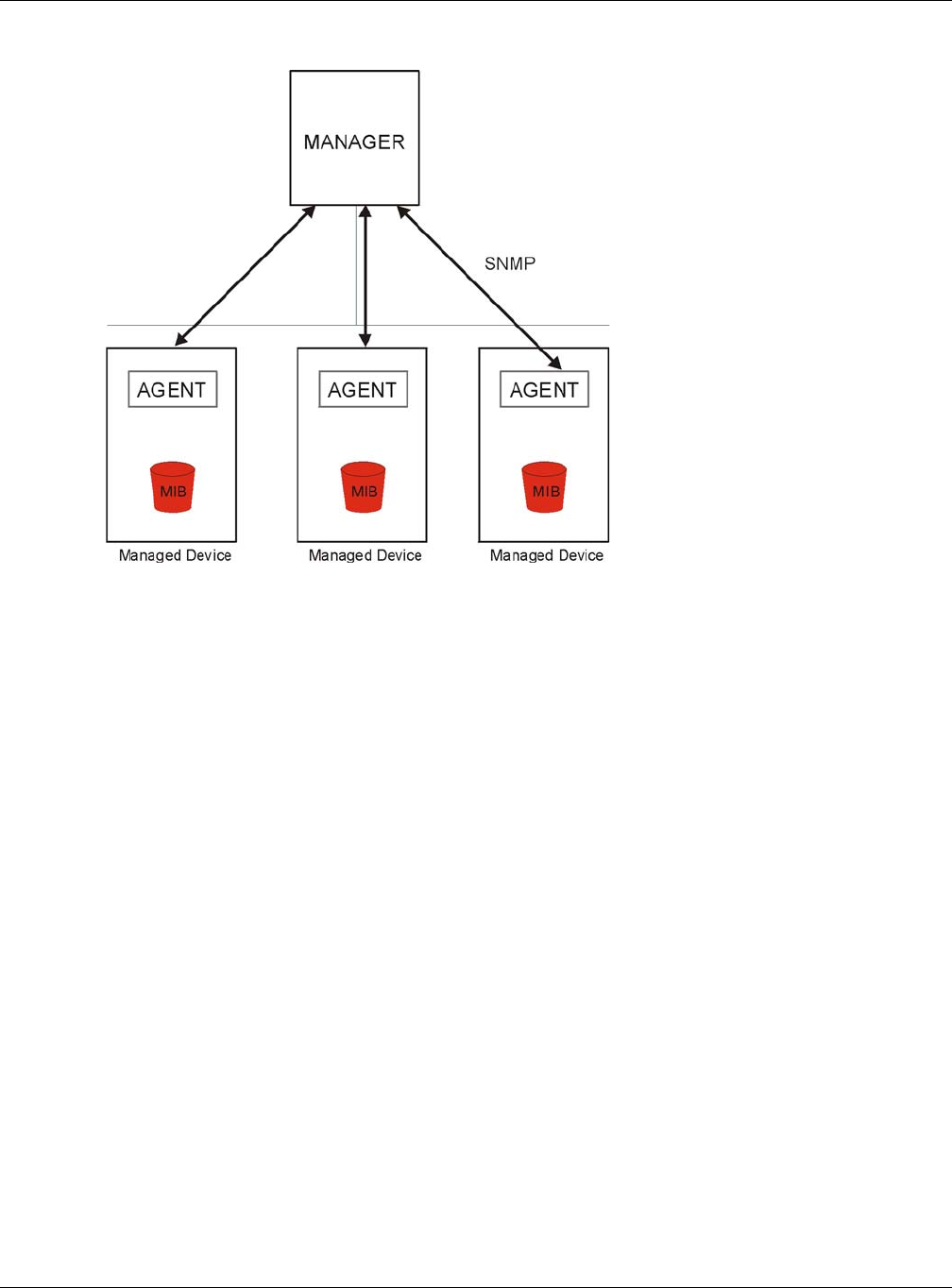
Chapter 22 Remote Management
EMG2926-Q10A User’s Guide
157
Figure 107 SNMP Management Model
An SNMP managed network consists of two main types of component: agents and a manager.
An agent is a management software module that resides in a managed device (the EMG2926-
Q10A). An agent translates the local management information from the managed device into a
form compatible with SNMP. The manager is the console through which network administrators
perform network management functions. It executes applications that control and monitor
managed devices.
The managed devices contain object variables/managed objects that define each piece of
information to be collected about a device. Examples of variables include such as number of
packets received, node port status etc. A Management Information Base (MIB) is a collection of
managed objects. SNMP allows a manager and agents to communicate for the purpose of accessing
these objects.
SNMP itself is a simple request/response protocol based on the manager/agent model. The
manager issues a request and the agent returns responses using the following protocol operations:
• Get - Allows the manager to retrieve an object variable from the agent.
• GetNext - Allows the manager to retrieve the next object variable from a table or list within an
agent. In SNMPv1, when a manager wants to retrieve all elements of a table from an agent, it
initiates a Get operation, followed by a series of GetNext operations.
• Set - Allows the manager to set values for object variables within an agent.
• Trap - Used by the agent to inform the manager of some events.
To change your EMG2926-Q10A’s SNMP settings, click Management > Remote MGMT > SNMP.
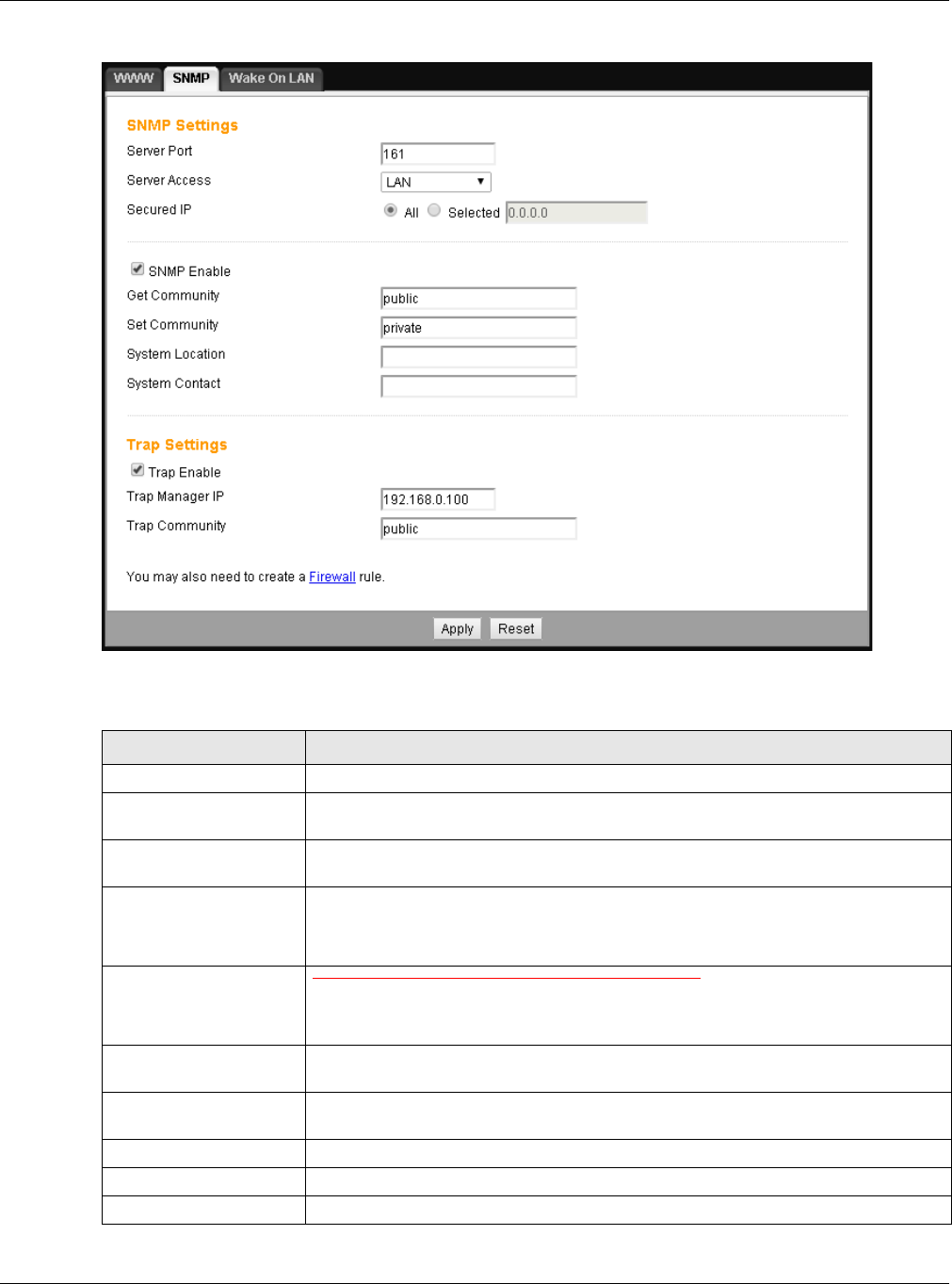
Chapter 22 Remote Management
EMG2926-Q10A User’s Guide
158
Figure 108 Management > Remote Management > SNMP
The following table describes the labels in this screen.
Table 67 Management > Remote Management > SNMP
LABEL DESCRIPTION
SNMP Settings
Server Port You may change the server port number for a service if needed, however you must
use the same port number in order to use that service for remote management.
Server Access Select the interface(s) through which a computer may access the EMG2926-Q10A
using this service.
Secured IP Select All to allow all computes to access the EMG2926-Q10A.
Otherwise, check Selected and specify the IP address of the computer that can
access the EMG2926-Q10A.
SNMP Enable Select this to enable SNMP on the EMG2926-Q10A.
Select this to allow a manager station to manage and monitor the EMG2926-Q10A
through the network via SNMP.
Get Community Enter the password for the incoming Get and GetNext requests from the
management station. The default is public and allows all requests.
Set Community Enter the password for incoming Set requests from the management station. The
default is public and allows all requests.
System Location Specify the geographic location of the EMG2926-Q10A.
System Contact Enter the name of the person in charge of the EMG2926-Q10A.
Trap Settings
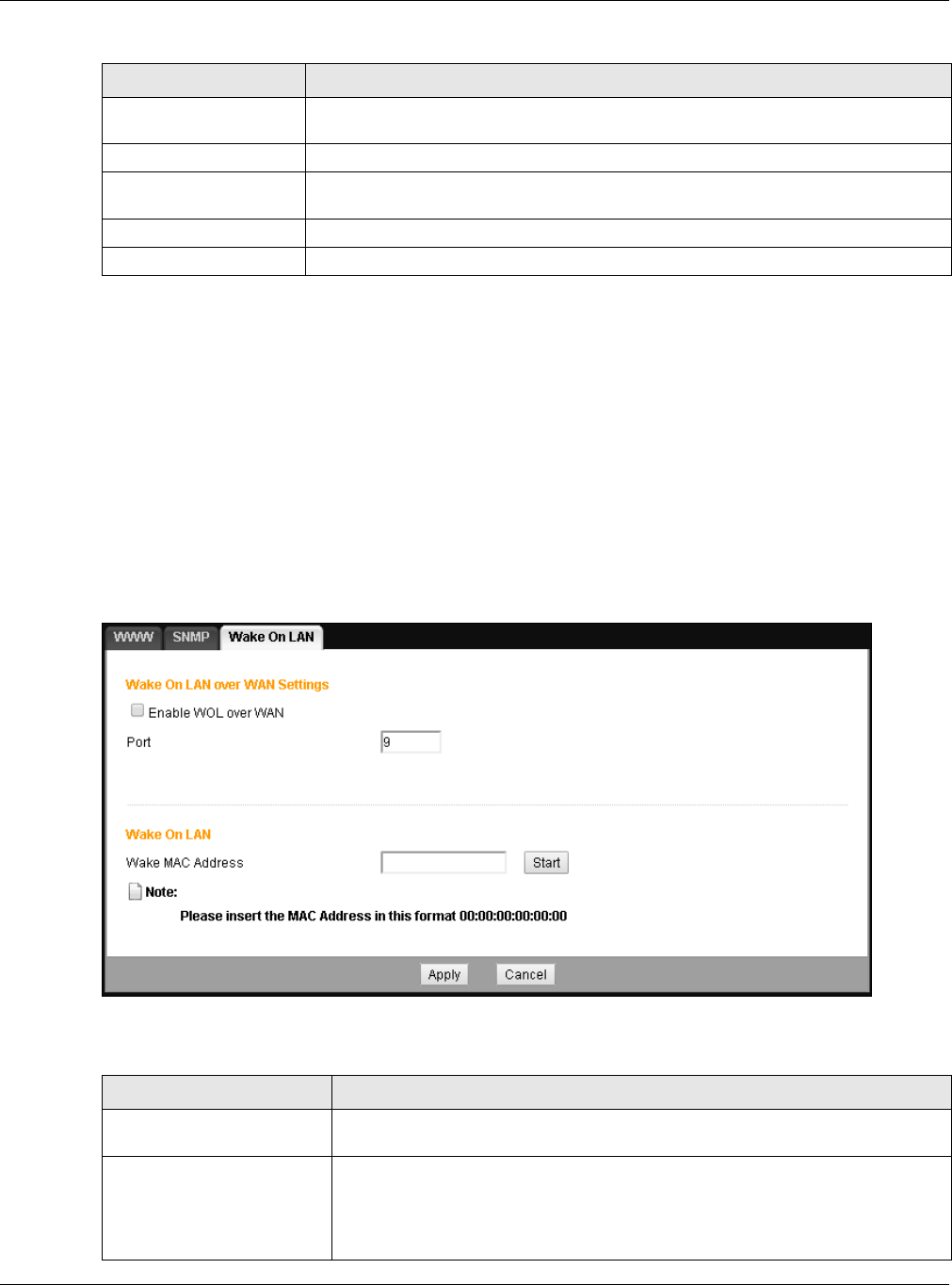
Chapter 22 Remote Management
EMG2926-Q10A User’s Guide
159
22.7 Wake On LAN Screen
Wake On LAN (WoL) allows you to remotely turn on a device on the network, such as a computer,
storage device or media server. To use this feature the remote hardware (for example the network
adapter on a computer) must support Wake On LAN using the “Magic Packet” method.
You need to know the MAC address of the remote device. It may be on a label on the device.
Use this screen to remotely turn on a device on the network. Click the Management > Remote
MGMT > Wake On LAN to open the following screen.
Figure 109 Management > Remote MGMT > Wake On LAN
The following table describes the labels in this screen.
Trap Enable Select this to have the EMG2926-Q10A send an SNMP trap to the specified IP
address when it receives the event. Clear this to disable it.
Trap Manager IP Type the IP address of the SNMP manager to which your SNMP traps are sent.
Trap Community Type the password sent with each trap to the SNMP manager. The default is public
and allows all requests.
Apply Click Apply to save your customized settings.
Cancel Click Cancel to begin configuring this screen afresh.
Table 67 Management > Remote Management > SNMP (continued)
LABEL DESCRIPTION
Table 68 Management > Remote MGMT > Wake On LAN
LABEL DESCRIPTION
Wake On LAN over WAN
Settings
Enable WOL over WAN Select this option to have the EMG2926-Q10A forward a WoL “Magic Packet” to
all devices on the LAN if the packet comes from the WAN or remote network
and uses the port number specified in the Port field. A LAN device whose
hardware supports Wake on LAN then will be powered on if it is turned off
previously.

Chapter 22 Remote Management
EMG2926-Q10A User’s Guide
160
Port Type a port number from which a WoL packet is forwarded to the LAN.
Wake On LAN
Wake MAC Address Enter the MAC Address of the device on the network that will be turned on.
A MAC address consists of six hexadecimal character pairs.
Start Click this to have the EMG2926-Q10A generate a WoL packet and forward it to
turn the specified device on.
A screen pops up displaying MAC address error if you input the MAC address
incorrectly.
Apply Click Apply to save the setting to the EMG2926-Q10A.
Cancel Click Cancel to begin configuring this screen afresh.
Table 68 Management > Remote MGMT > Wake On LAN (continued)
LABEL DESCRIPTION

EMG2926-Q10A User’s Guide
161
CHAPTER 23
Universal Plug-and-Play (UPnP)
23.1 Overview
This chapter introduces the UPnP feature in the web configurator.
Universal Plug and Play (UPnP) is a distributed, open networking standard that uses TCP/IP for
simple peer-to-peer network connectivity between devices. A UPnP device can dynamically join a
network, obtain an IP address, convey its capabilities and learn about other devices on the network.
In turn, a device can leave a network smoothly and automatically when it is no longer in use.
23.2 What You Need to Know
UPnP hardware is identified as an icon in the Network Connections folder (Windows XP). Each UPnP
compatible device installed on your network will appear as a separate icon. Selecting the icon of a
UPnP device will allow you to access the information and properties of that device.
23.2.1 NAT Traversal
UPnP NAT traversal automates the process of allowing an application to operate through NAT. UPnP
network devices can automatically configure network addressing, announce their presence in the
network to other UPnP devices and enable exchange of simple product and service descriptions.
NAT traversal allows the following:
• Dynamic port mapping
• Learning public IP addresses
• Assigning lease times to mappings
Windows Messenger is an example of an application that supports NAT traversal and UPnP.
See the NAT chapter for more information on NAT.
23.2.2 Cautions with UPnP
The automated nature of NAT traversal applications in establishing their own services and opening
firewall ports may present network security issues. Network information and configuration may also
be obtained and modified by users in some network environments.
When a UPnP device joins a network, it announces its presence with a multicast message. For
security reasons, the EMG2926-Q10A allows multicast messages on the LAN only.
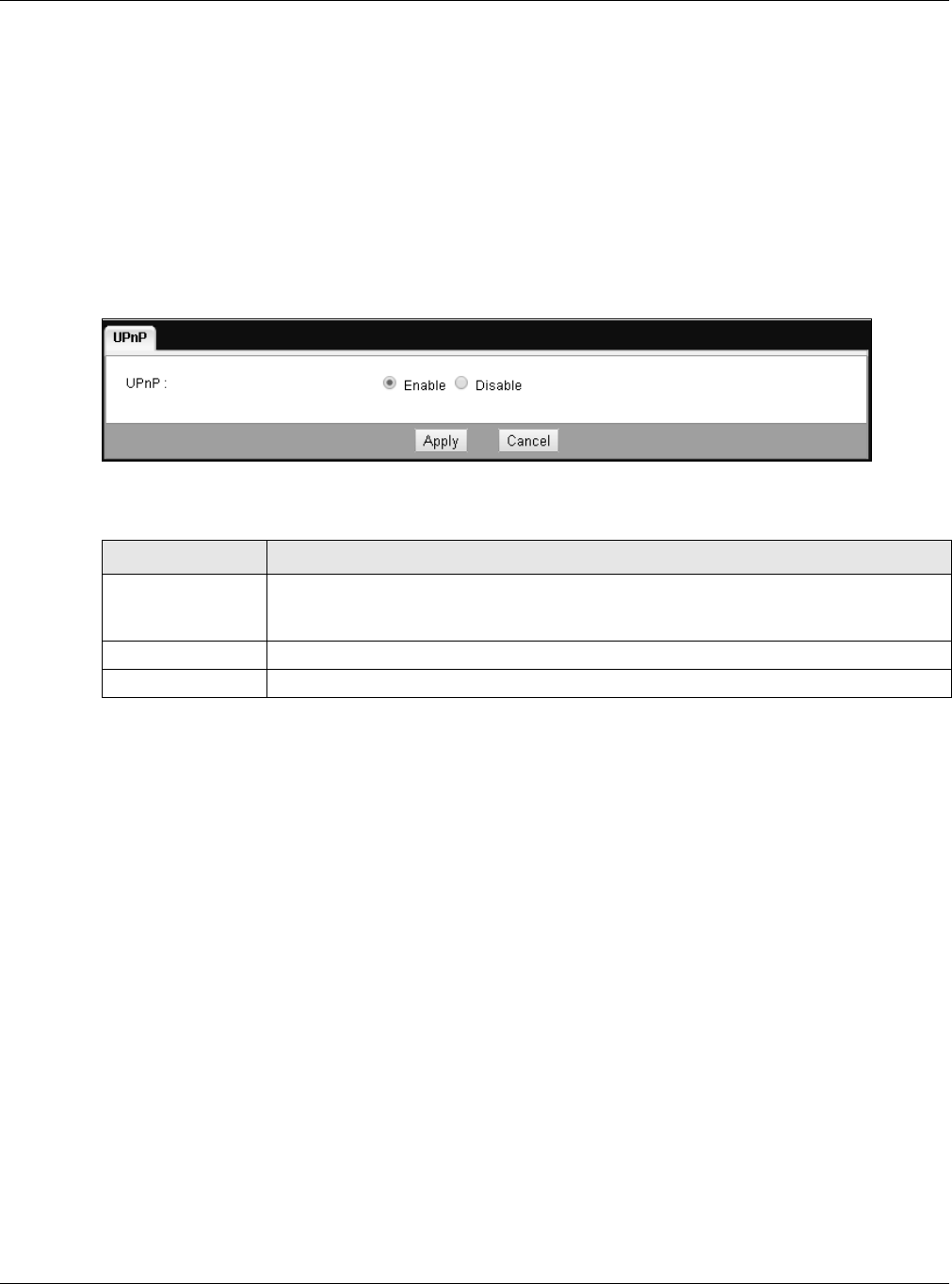
Chapter 23 Universal Plug-and-Play (UPnP)
EMG2926-Q10A User’s Guide
162
All UPnP-enabled devices may communicate freely with each other without additional configuration.
Disable UPnP if this is not your intention.
23.3 UPnP Screen
Use this screen to enable UPnP on your EMG2926-Q10A.
Click Management > UPnP to display the screen shown next.
Figure 110 Management > UPnP
The following table describes the fields in this screen.
23.4 Technical Reference
The sections show examples of using UPnP.
23.4.1 Using UPnP in Windows XP Example
This section shows you how to use the UPnP feature in Windows XP. You must already have UPnP
installed in Windows XP and UPnP activated on the EMG2926-Q10A.
Make sure the computer is connected to a LAN port of the EMG2926-Q10A. Turn on your computer
and the EMG2926-Q10A.
23.4.1.1 Auto-discover Your UPnP-enabled Network Device
1Click start and Control Panel. Double-click Network Connections. An icon displays under
Internet Gateway.
2Right-click the icon and select Properties.
Table 69 Management > UPnP
LABEL DESCRIPTION
UPnP Select Enable to activate UPnP. Be aware that anyone could use a UPnP application to
open the web configurator's login screen without entering the EMG2926-Q10A's IP
address (although you must still enter the password to access the web configurator).
Apply Click Apply to save the setting to the EMG2926-Q10A.
Cancel Click Cancel to return to the previously saved settings.
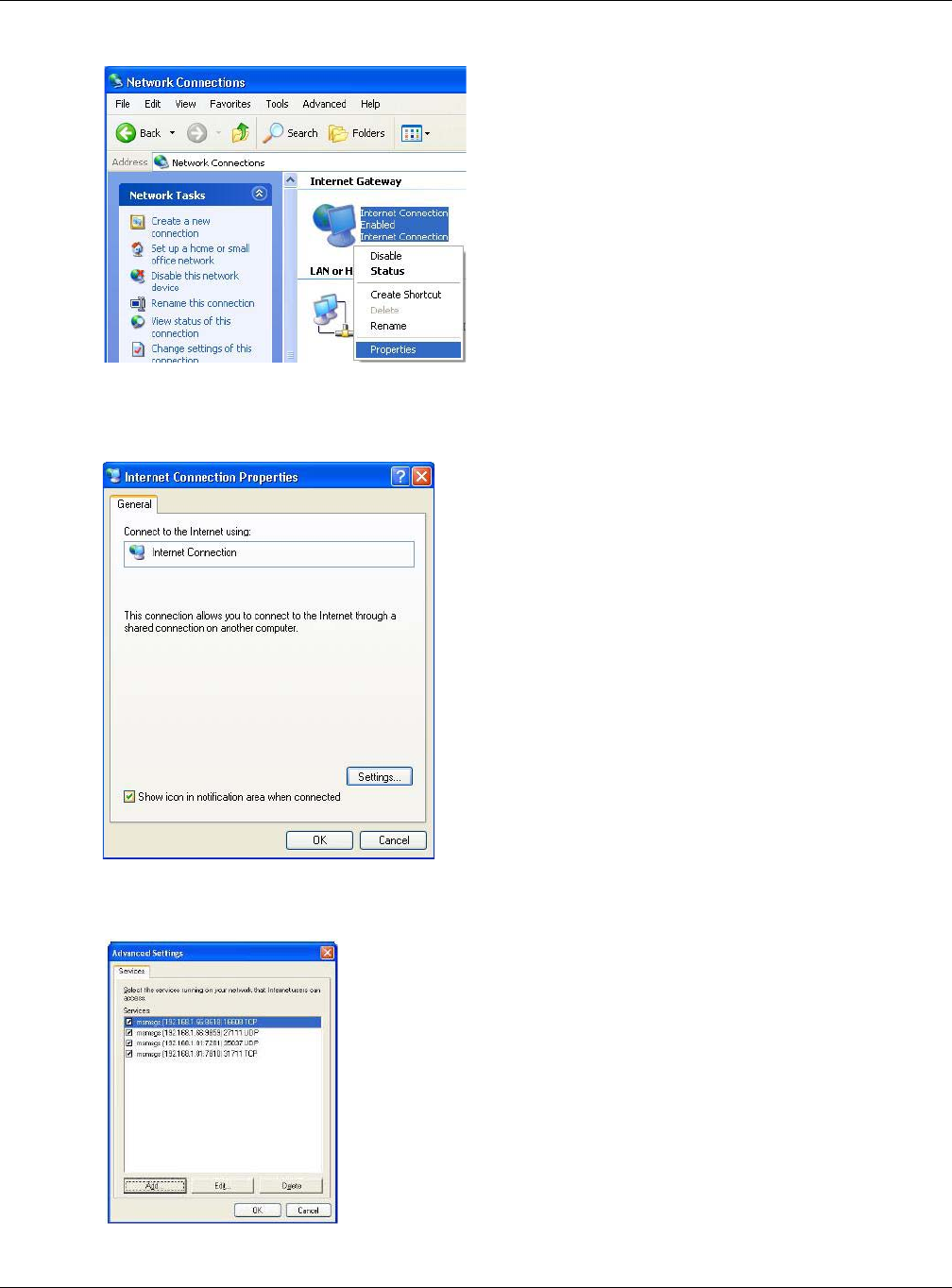
Chapter 23 Universal Plug-and-Play (UPnP)
EMG2926-Q10A User’s Guide
163
Figure 111 Network Connections
3In the Internet Connection Properties window, click Settings to see the port mappings there
were automatically created.
Figure 112 Internet Connection Properties
4You may edit or delete the port mappings or click Add to manually add port mappings.
Figure 113 Internet Connection Properties: Advanced Settings
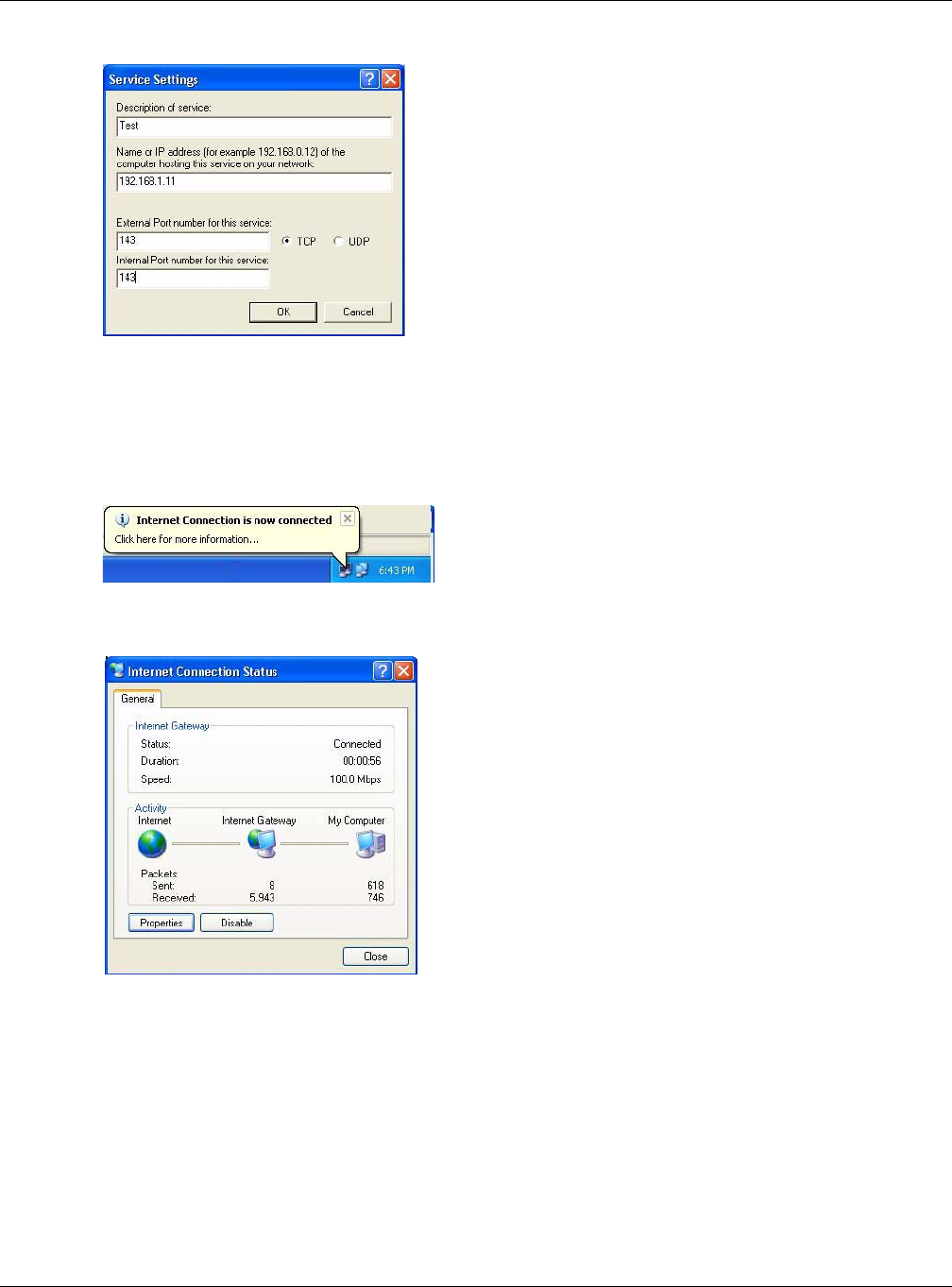
Chapter 23 Universal Plug-and-Play (UPnP)
EMG2926-Q10A User’s Guide
164
Figure 114 Internet Connection Properties: Advanced Settings: Add
Note: When the UPnP-enabled device is disconnected from your computer, all port
mappings will be deleted automatically.
5Select Show icon in notification area when connected option and click OK. An icon displays in
the system tray.
Figure 115 System Tray Icon
6Double-click on the icon to display your current Internet connection status.
Figure 116 Internet Connection Status
23.4.2 Web Configurator Easy Access
With UPnP, you can access the web-based configurator on the EMG2926-Q10A without finding out
the IP address of the EMG2926-Q10A first. This comes helpful if you do not know the IP address of
the EMG2926-Q10A.
Follow the steps below to access the web configurator.
1Click Start and then Control Panel.
2Double-click Network Connections.
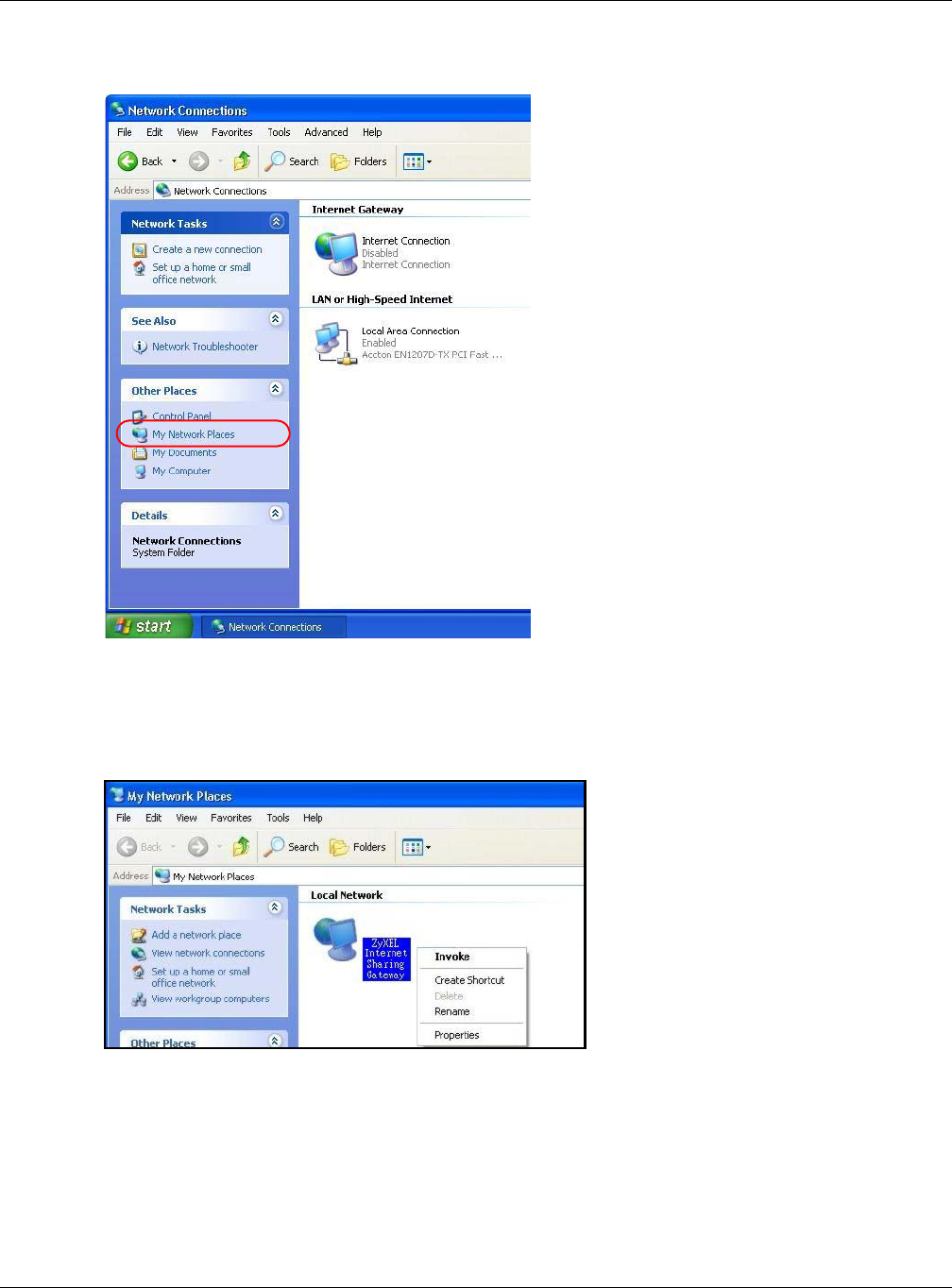
Chapter 23 Universal Plug-and-Play (UPnP)
EMG2926-Q10A User’s Guide
165
3Select My Network Places under Other Places.
Figure 117 Network Connections
4An icon with the description for each UPnP-enabled device displays under Local Network.
5Right-click on the icon for your EMG2926-Q10A and select Invoke. The web configurator login
screen displays.
Figure 118 Network Connections: My Network Places
6Right-click on the icon for your EMG2926-Q10A and select Properties. A properties window
displays with basic information about the EMG2926-Q10A.
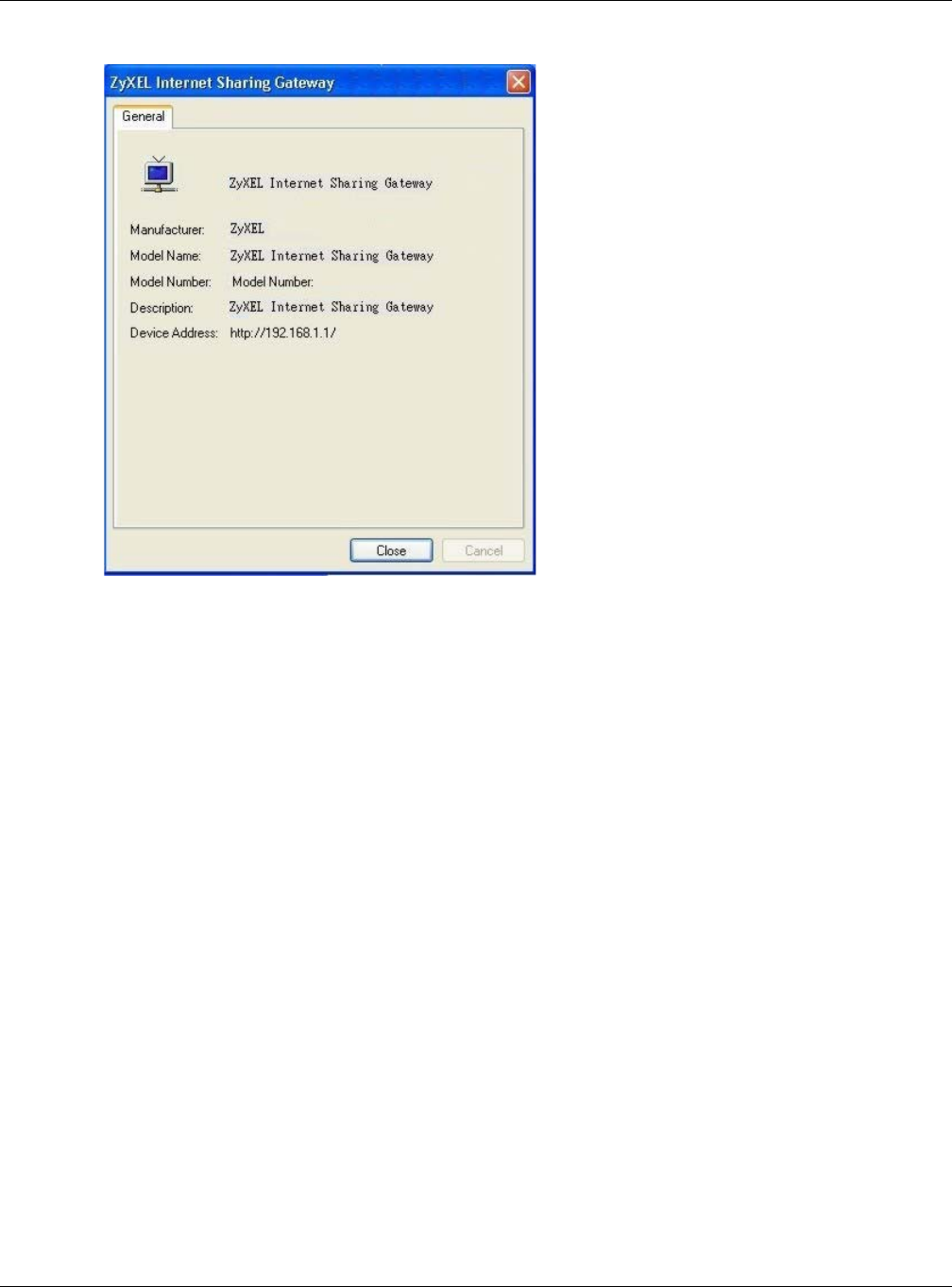
Chapter 23 Universal Plug-and-Play (UPnP)
EMG2926-Q10A User’s Guide
166
Figure 119 Network Connections: My Network Places: Properties: Example
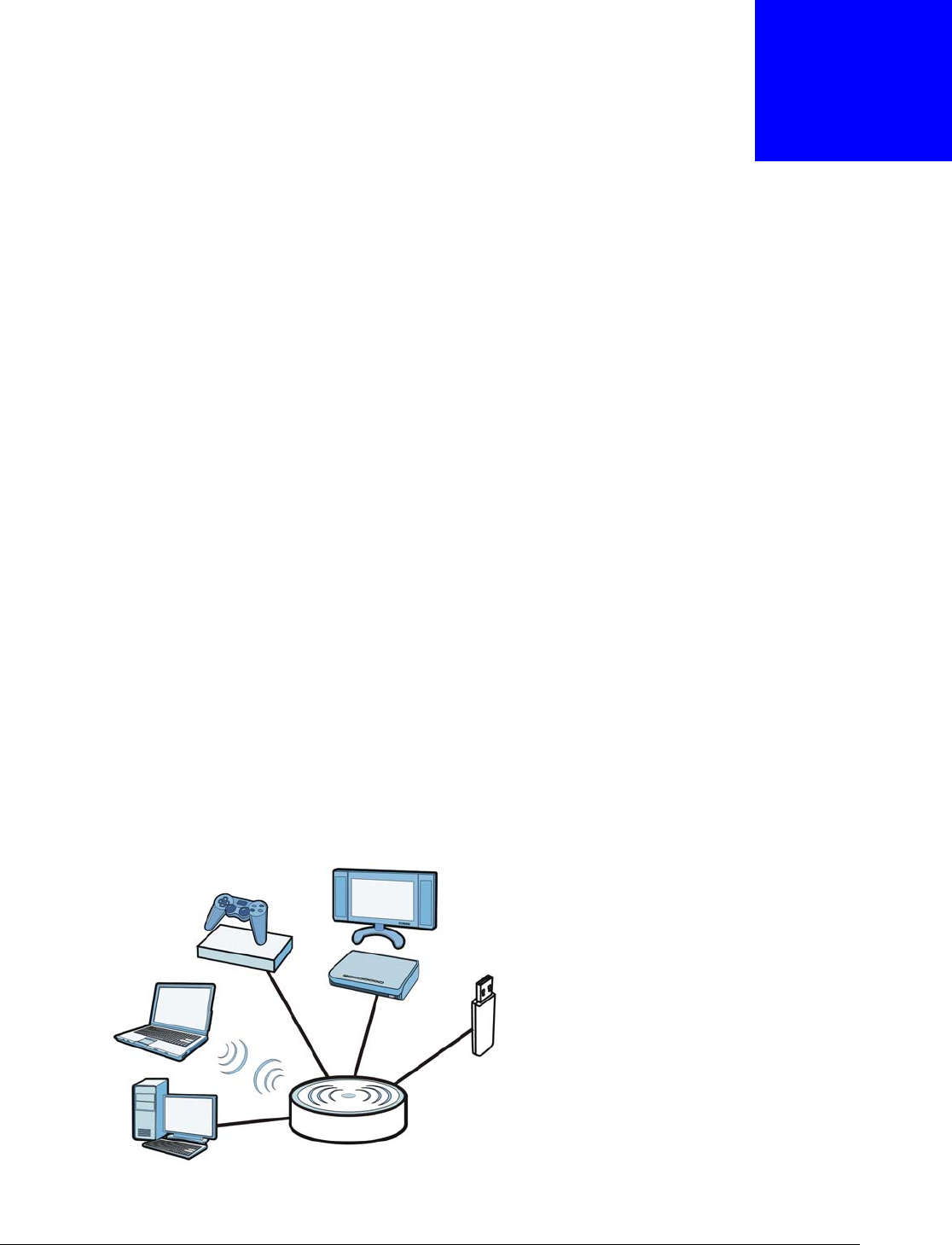
EMG2926-Q10A User’s Guide
167
CHAPTER 24
USB Media Sharing
24.1 Overview
This chapter describes how to configure the media sharing settings on the EMG2926-Q10A.
Note: The read and write performance may be affected by amount of file-sharing traffic
on your network, type of connected USB device and your USB version (1.1 or 2.0).
Media Server
You can set up your EMG2926-Q10A to act as a media server to provide media (like video) to DLNA-
compliant players, such as Windows Media Player, ZyXEL DMAs (Digital Media Adapters), Xboxes or
PS3s. The media server and clients must have IP addresses in the same subnet.
The EMG2926-Q10A media server enables you to:
• Publish all folders for everyone to play media files in the USB storage device connected to the
EMG2926-Q10A.
• Use hardware-based media clients like the DMA-2500 to play the files.
Note: Anyone on your network can play the media files in the published folders. No user
name and password nor other form of security is required.
The following figure is an overview of the EMG2926-Q10A’s media server feature. DLNA devices A
and B can access and play files on a USB device (C) which is connected to the EMG2926-Q10A (D).
Figure 120 Media Server Overview
AB
C
D
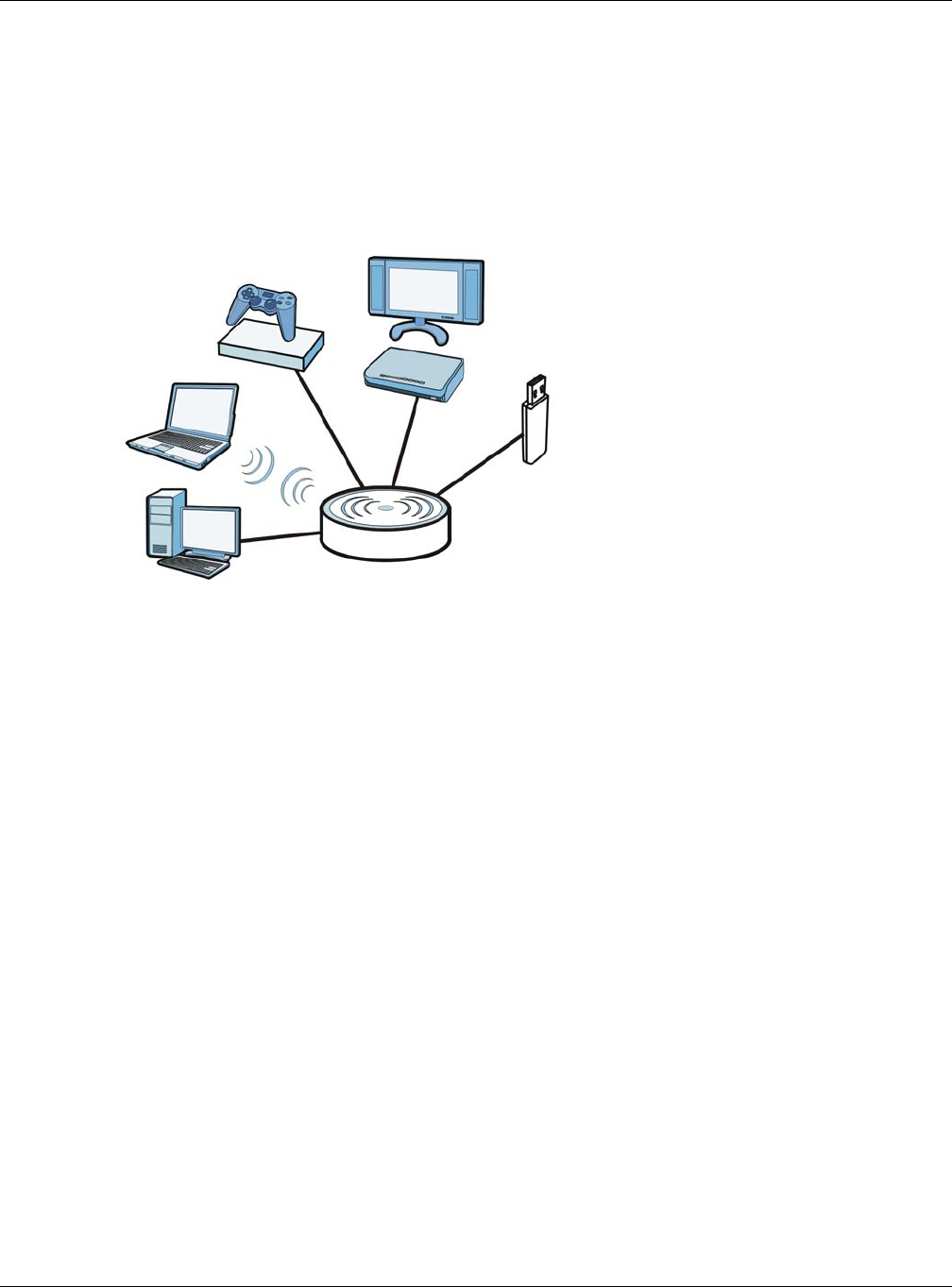
Chapter 24 USB Media Sharing
EMG2926-Q10A User’s Guide
168
File-Sharing Server
You can also share files on a USB memory stick or hard drive connected to your EMG2926-Q10A
with users on your network.
The following figure is an overview of the EMG2926-Q10A’s file-sharing server feature. Computers
A and B can access files on a USB device (C) which is connected to the EMG2926-Q10A (D).
Figure 121 File Sharing Overview
24.2 What You Can Do
•Use the DLNA screen to use the EMG2926-Q10A as a media server and allow DLNA-compliant
devices to play media files stored in the attached USB device (Section 24.5 on page 170).
•Use the SAMBA screen to enable file-sharing via the EMG2926-Q10A using Windows Explorer or
the workgroup name. This screen also allow you to configure the workgroup name and create
user accounts (Section 24.6 on page 171).
•Use the FTP screen to allow file sharing via the EMG2926-Q10A using FTP and create user
accounts (Section 24.7 on page 172).
24.3 What You Need To Know
DLNA
The Digital Living Network Alliance (DLNA) is a group of personal computer and electronics
companies that works to make products compatible in a home network. DLNA clients play files
stored on DLNA servers. The EMG2926-Q10A can function as a DLNA-compliant media server and
stream files to DLNA-compliant media clients without any configuration.
A
BC
D

Chapter 24 USB Media Sharing
EMG2926-Q10A User’s Guide
169
Workgroup name
This is the name given to a set of computers that are connected on a network and share resources
such as a printer or files. Windows automatically assigns the workgroup name when you set up a
network.
File Systems
A file system is a way of storing and organizing files on your hard drive and storage device. Often
different operating systems such as Windows or Linux have different file systems. The file-sharing
feature on your EMG2926-Q10A supports New Technology File System (NTFS), File Allocation Table
(FAT) and FAT32 file systems.
Windows/CIFS
Common Internet File System (CIFS) is a standard protocol supported by most operating systems
in order to share files across the network.
CIFS runs over TCP/IP but uses the SMB (Server Message Block) protocol found in Microsoft
Windows for file and printer access; therefore, CIFS will allow all applications, not just Web
browsers, to open and share files across the Internet.
The EMG2926-Q10A uses Common Internet File System (CIFS) protocol for its file sharing
functions. CIFS compatible computers can access the USB file storage devices connected to the
EMG2926-Q10A. CIFS protocol is supported on Microsoft Windows, Linux Samba and other
operating systems (refer to your systems specifications for CIFS compatibility).
Samba
SMB is a client-server protocol used by Microsoft Windows systems for sharing files, printers, and
so on.
Samba is a free SMB server that runs on most Unix and Unix-like systems. It provides an
implementation of an SMB client and server for use with non-Microsoft operating systems.
File Transfer Protocol
This is a method of transferring data from one computer to another over a network such as the
Internet.
24.4 Before You Begin
Make sure the EMG2926-Q10A is connected to your network and turned on.
1Connect the USB device to one of the EMG2926-Q10A’s USB ports.
2The EMG2926-Q10A detects the USB device and makes its contents available for browsing. If you
are connecting a USB hard drive that comes with an external power supply, make sure it is
connected to an appropriate power source that is on.
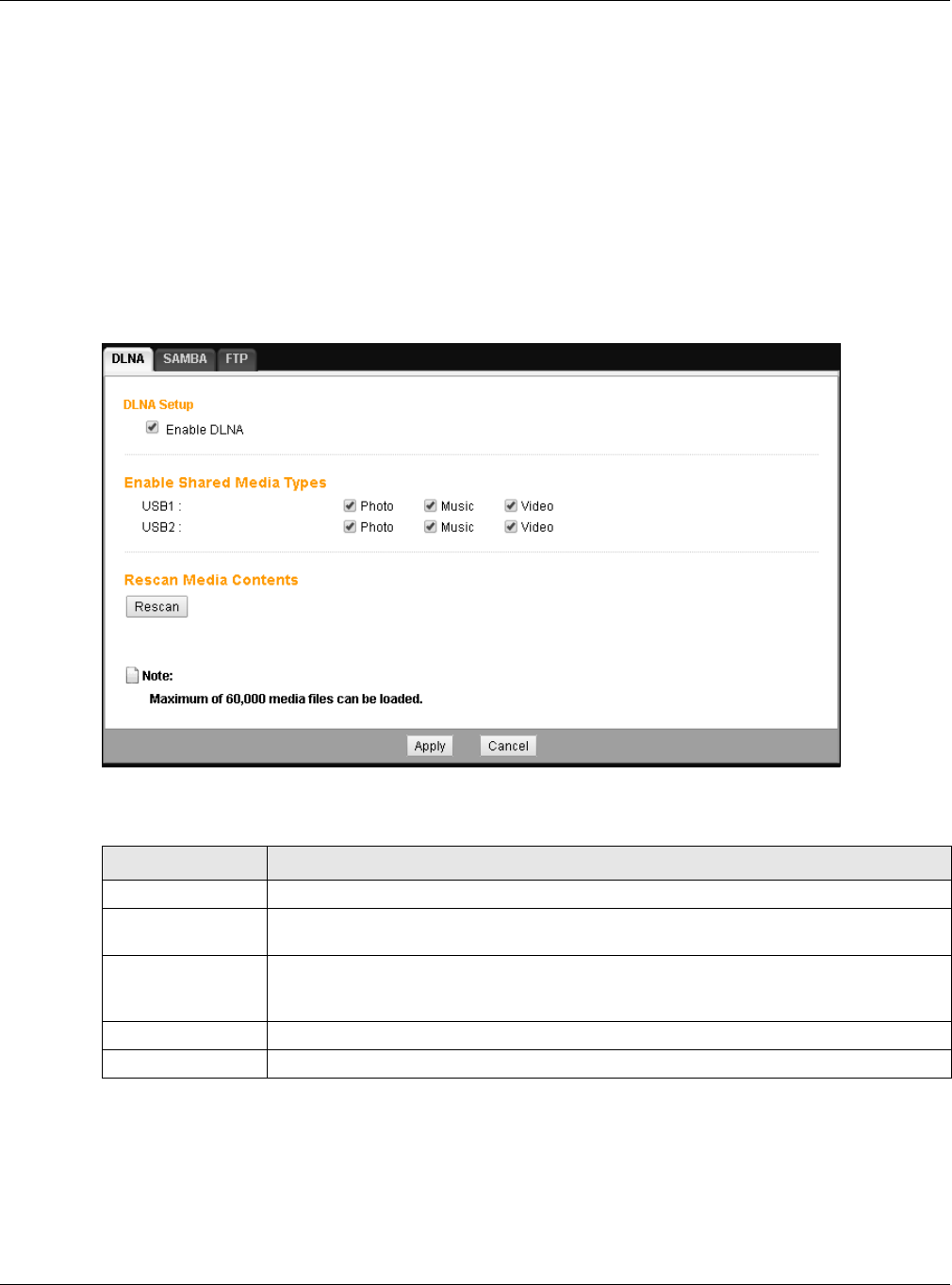
Chapter 24 USB Media Sharing
EMG2926-Q10A User’s Guide
170
Note: If your USB device cannot be detected by the EMG2926-Q10A, see the
troubleshooting for suggestions.
24.5 DLNA Screen
Use this screen to have the EMG2926-Q10A act as a DLNA-compliant media server that lets DLNA-
compliant media clients on your network play video, music, and photos from the EMG2926-Q10A
(without having to copy them to another computer). Click Management > USB Media Sharing >
DLNA.
Figure 122 Management > USB Media Sharing > DLNA
The following table describes the labels in this screen.
Table 70 Management > USB Media Sharing > DLNA
LABEL DESCRIPTION
Enable DLNA Select this to have the EMG2926-Q10A function as a DLNA-compliant media server.
USB1/2 Select the media type that you want to share on the USB device connected to the
EMG2926-Q10A’s USB port.
Rescan Click this button to have the EMG2926-Q10A scan the media files on the connected USB
device and do indexing of the file list again so that DLNA clients can find the new files if
any.
Apply Click Apply to save your changes back to the EMG2926-Q10A.
Cancel Click Cancel to begin configuring this screen afresh.
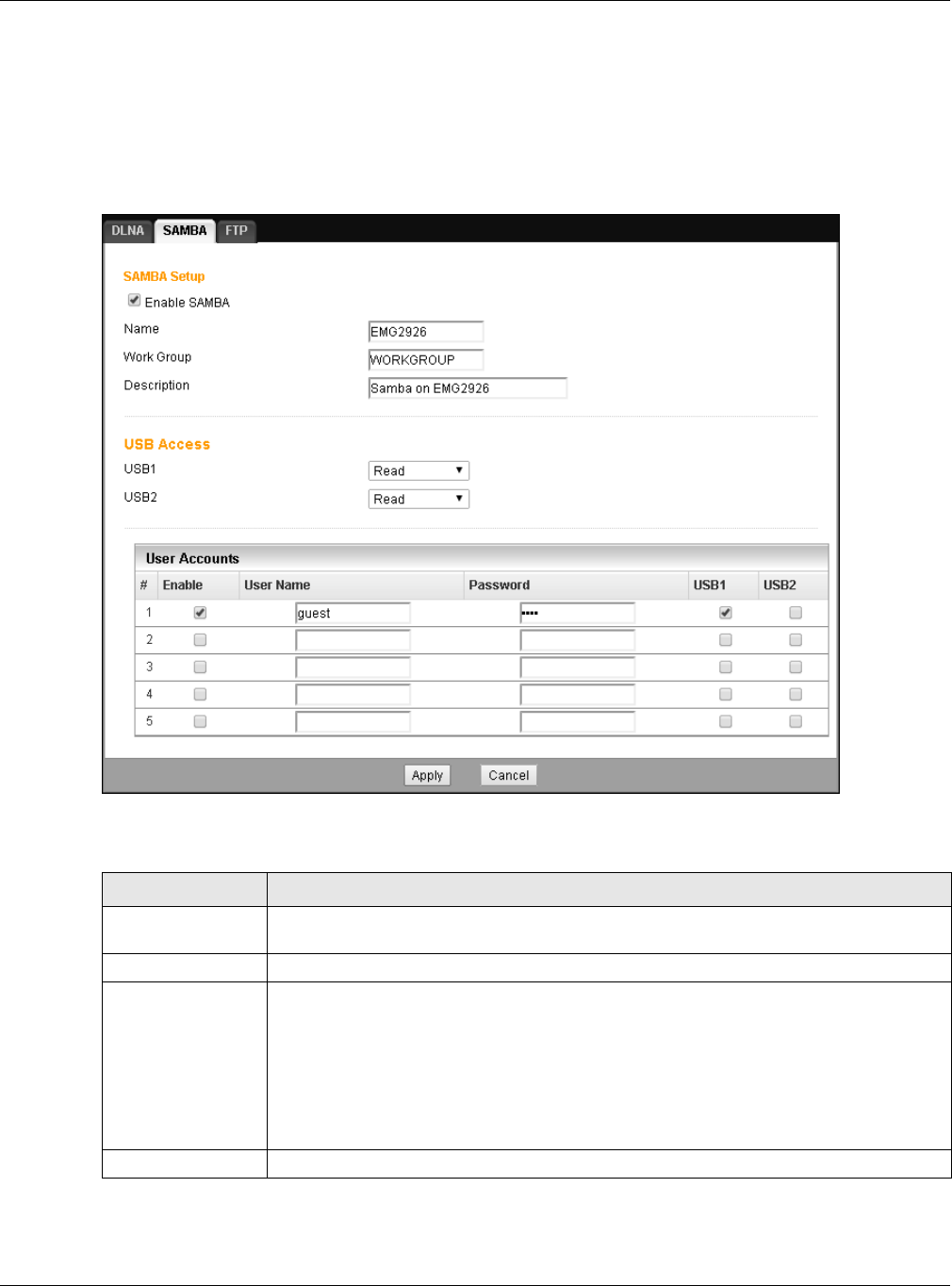
Chapter 24 USB Media Sharing
EMG2926-Q10A User’s Guide
171
24.6 SAMBA Screen
Use this screen to set up file-sharing via the EMG2926-Q10A using Windows Explorer or the
workgroup name. You can also configure the workgroup name and create file-sharing user
accounts. Click Management > USB Media Sharing > SAMBA.
Figure 123 Management > USB Media Sharing > SAMBA
The following table describes the labels in this screen.
Table 71 Management > USB Media Sharing > SAMBA
LABEL DESCRIPTION
Enable SAMBA Select this to enable file sharing through the EMG2926-Q10A using Windows Explorer or
by browsing to your work group.
Name Specify the name to identify the EMG2926-Q10A in a work group.
Work Group You can add the EMG2926-Q10A to an existing or a new workgroup on your network.
Enter the name of the workgroup which your EMG2926-Q10A automatically joins. You
can set the EMG2926-Q10A’s workgroup name to be exactly the same as the workgroup
name to which your computer belongs to.
Note: The EMG2926-Q10A will not be able to join the workgroup if your local area
network has restrictions set up that do not allow devices to join a workgroup. In this
case, contact your network administrator.
Decription Enter the description of the EMG2926-Q10A in a work group.
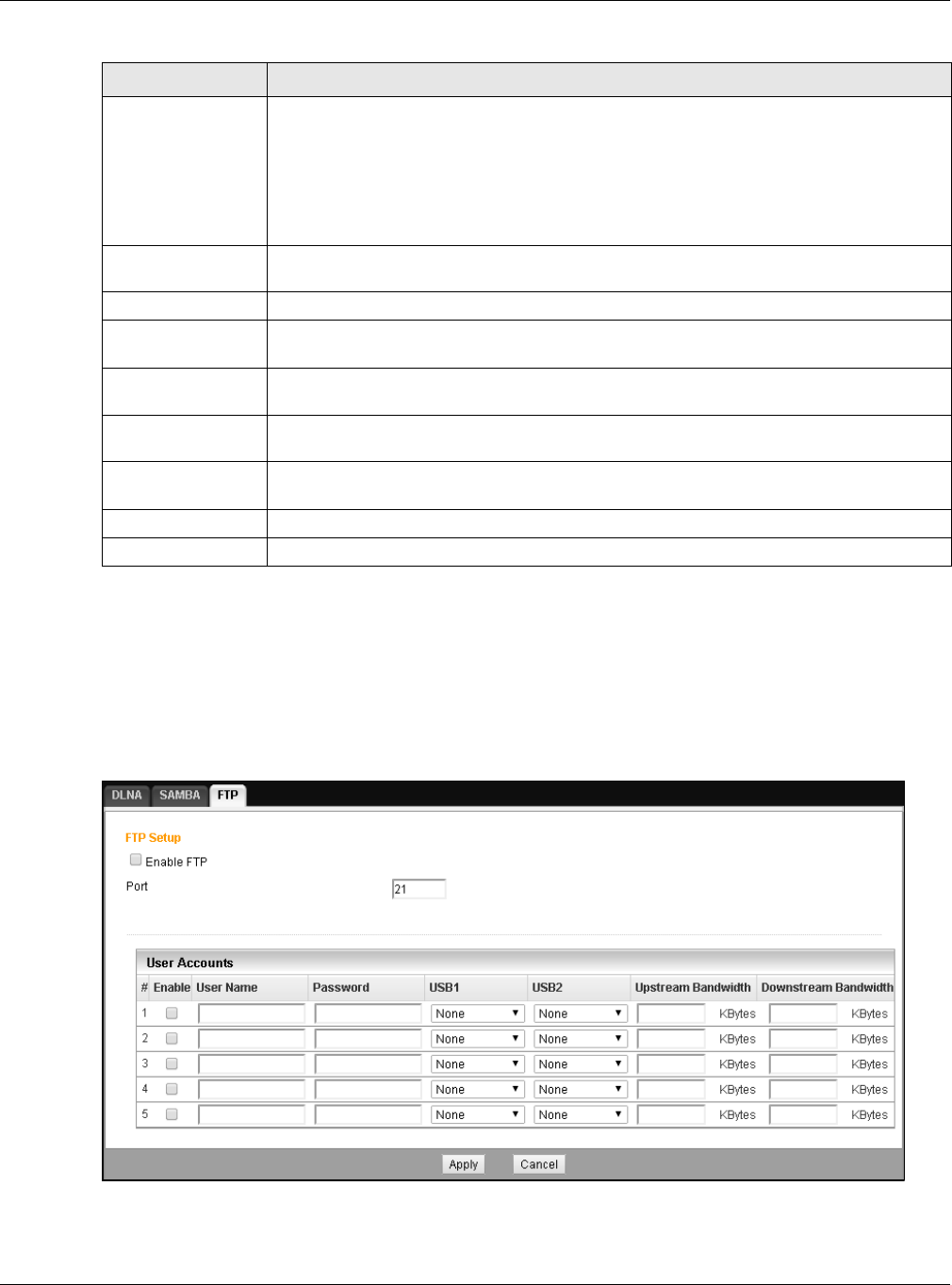
Chapter 24 USB Media Sharing
EMG2926-Q10A User’s Guide
172
24.7 FTP Screen
Use this screen to set up file sharing via the EMG2926-Q10A using FTP and create user accounts.
Click Management > USB Media Sharing > FTP.
Figure 124 Management > USB Media Sharing > FTP
USB1/2 Specify the user’s access rights to the USB storage device which is connected to the
EMG2926-Q10A’s USB port.
Read & Write - The user has read and write rights, meaning that the user can create
and edit the files on the connected USB device.
Read - The user has read rights only and can not create or edit the files on the
connected USB device.
User Accounts Before you can share files you need a user account. Configure the following fields to set
up a file-sharing account.
#This is the index number of the user account.
Enable This field displays whether a user account is activated or not. Select the check box to
enable the account. Clear the check box to disable the account.
User Name Enter a user name that will be allowed to access the shared files. You can enter up to 20
characters. Only letters and numbers allowed.
Password Enter the password used to access the shared files. You can enter up to 20 characters.
Only letters and numbers are allowed. The password is case sensitive.
USB1/2 Select the USB port(s) of the EMG2926-Q10A. The configured user can access the files
on the USB device(s) connected to the selected USB port(s) only.
Apply Click Apply to save your changes back to the EMG2926-Q10A.
Cancel Click Cancel to begin configuring this screen afresh.
Table 71 Management > USB Media Sharing > SAMBA (continued)
LABEL DESCRIPTION

Chapter 24 USB Media Sharing
EMG2926-Q10A User’s Guide
173
The following table describes the labels in this screen.
24.8 Example of Accessing Your Shared Files From a
Computer
You can use Windows Explorer or FTP to access the USB storage devices connected to the
EMG2926-Q10A.
This example shows you how to use Microsoft’s Windows XP to browse your shared files. Refer to
your operating system’s documentation for how to browse your file structure.
24.8.1 Use Windows Explorer to Share Files
You should have enabled file sharing and create a user account (Bob/1234 for example) with read
and write access to USB 1 in the USB Media Sharing > SAMBA screen.
Open Windows Explorer to access the connected USB device using either Windows Explorer browser
or by browsing to your workgroup.
Table 72 Management > USB Media Sharing > FTP
LABEL DESCRIPTION
Enable FTP Select this to enable the FTP server on the EMG2926-Q10A for file sharing using FTP.
Port You may change the server port number for FTP if needed, however you must use the
same port number in order to use that service for file sharing.
User Accounts Before you can share files you need a user account. Configure the following fields to set
up a file-sharing account.
#This is the index number of the user account.
Enable This field displays whether a user account is activated or not. Select the check box to
enable the account. Clear the check box to disable the account.
User Name Enter a user name that will be allowed to access the shared files. You can enter up to 20
characters. Only letters and numbers allowed.
Password Enter the password used to access the shared files. You can enter up to 20 characters.
Only letters and numbers are allowed. The password is case sensitive.
USB1/2 Specify the user’s access rights to the USB storage device which is connected to the
EMG2926-Q10A’s USB port.
Read & Write - The user has read and write rights, meaning that the user can create
and edit the files on the connected USB device.
Read - The user has read rights only and can not create or edit the files on the
connected USB device.
None - The user cannot access the files on the USB device(s) connected to the USB
port.
Upstream
Bandwidth
Enter the maximum bandwidth (in Kbps) allowed for incoming FTP traffic.
Downstream
Bandwidth
Enter the maximum bandwidth (in Kbps) allowed for outgoing FTP traffic.
Apply Click Apply to save your changes back to the EMG2926-Q10A.
Cancel Click Cancel to begin configuring this screen afresh.
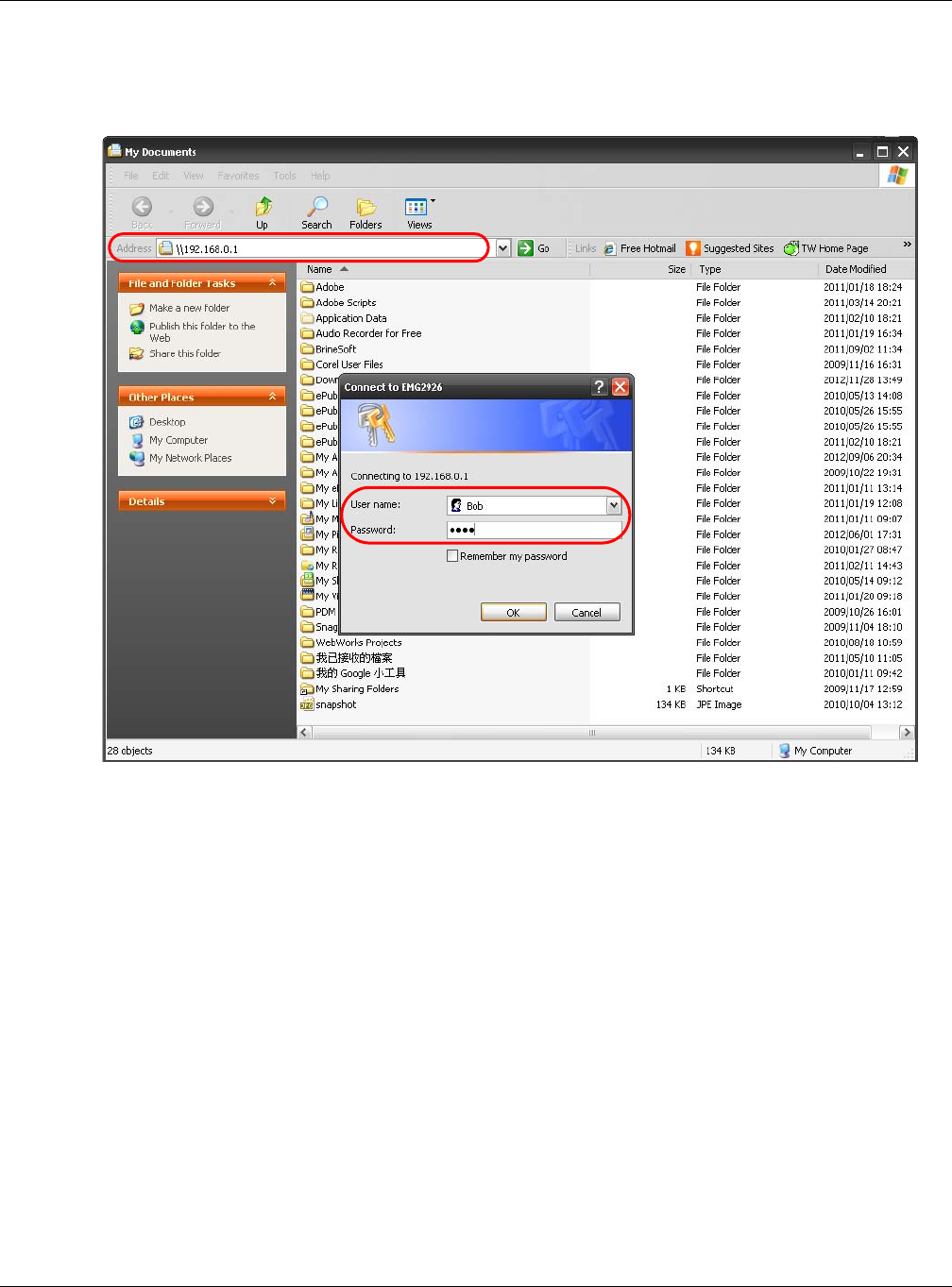
Chapter 24 USB Media Sharing
EMG2926-Q10A User’s Guide
174
1In Windows Explorer’s Address bar type a double backslash “\\” followed by the IP address of the
EMG2926-Q10A (the default IP address of the EMG2926-Q10A in router mode is 192.168.0.1) and
press [ENTER]. A screen asking for password authentication appears. Type the user name and
password (Bob and 1234 in this example) and click OK.
Note: Once you log into the shared folder via your EMG2926-Q10A, you do not have to
relogin unless you restart your computer.
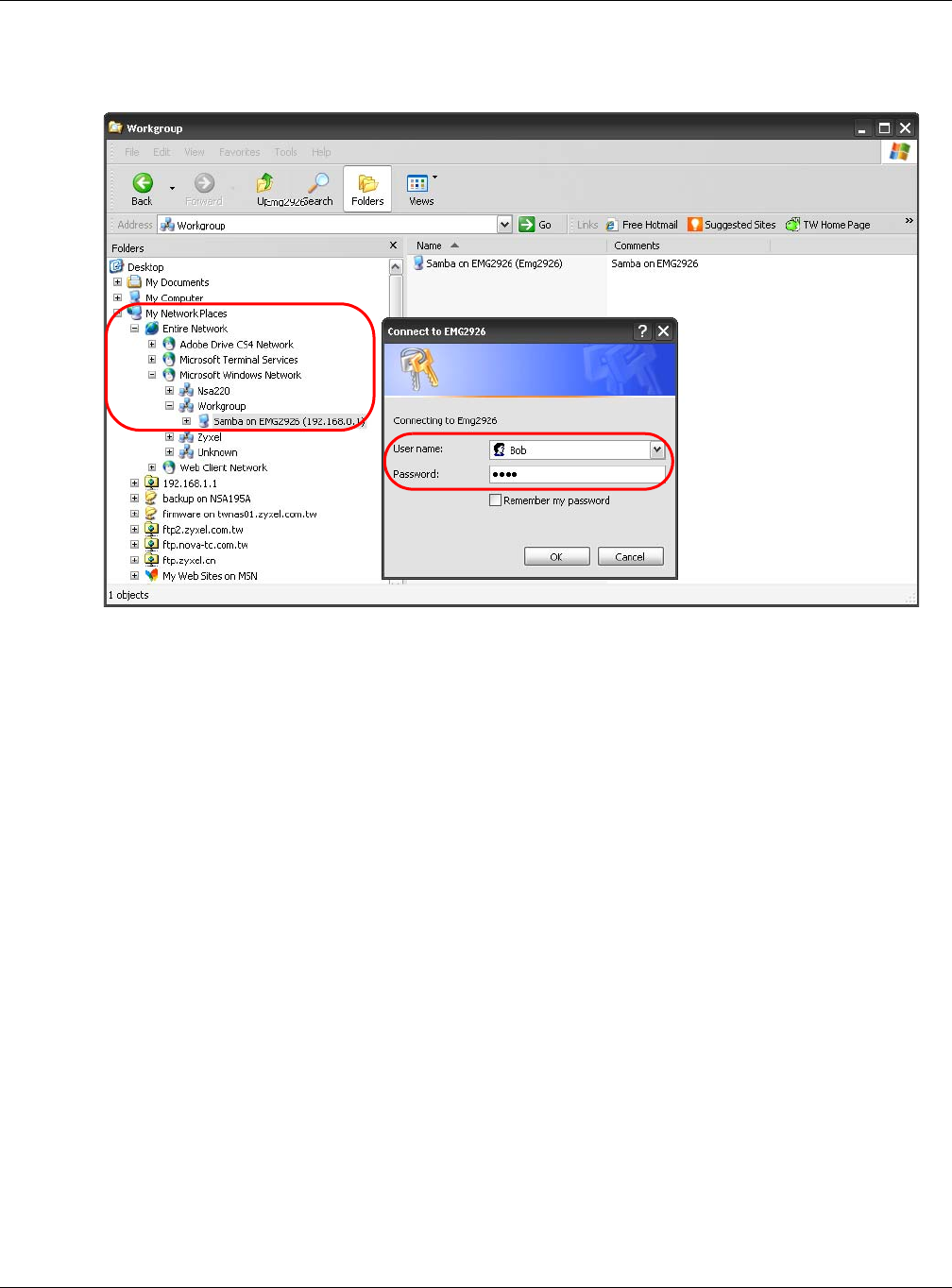
Chapter 24 USB Media Sharing
EMG2926-Q10A User’s Guide
175
2You can also use the workgroup name to access files by browsing to the workgroup folder using the
folder tree on the left side of the screen. It is located under My Network Places. In this example
the workgroup name is the default “Workgroup”.
24.8.2 Use FTP to Share Files
You can use FTP to access the USB storage devices connected to the EMG2926-Q10A. In this
example, we use the web browser to share files via FTP from the LAN. The way or screen you log
into the FTP server (on the EMG2926-Q10A) varies depending on your FTP client. See your FTP
client documentation for more information.
You should have enabled file sharing and create a user account (Bob/1234 for example) with read
and write access to USB 1 in the USB Media Sharing > FTP screen.
1In your web browser’s address or URL bar type “ftp://” followed by the IP address of the EMG2926-
Q10A (the default LAN IP address of the EMG2926-Q10A in router mode is 192.168.0.1) and click
Go or press [ENTER].
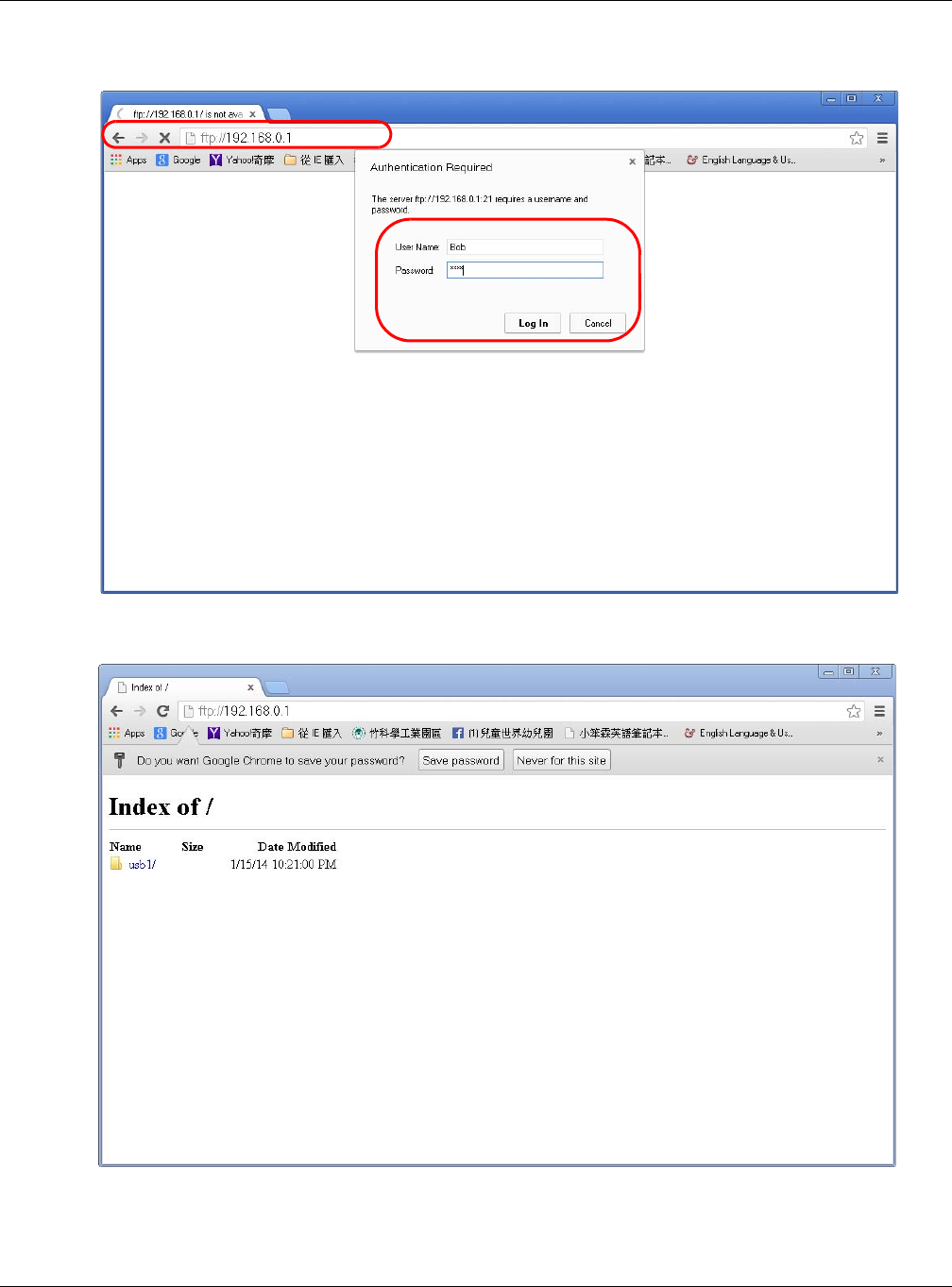
Chapter 24 USB Media Sharing
EMG2926-Q10A User’s Guide
176
2A screen asking for password authentication appears. Enter the user name and password (you
configured in the USB Media Sharing > FTP screen) and click Log In.
3The screen changes and shows you the folder for the USB storage device connected to your
EMG2926-Q10A. Double-click the folder to display the contents in it.
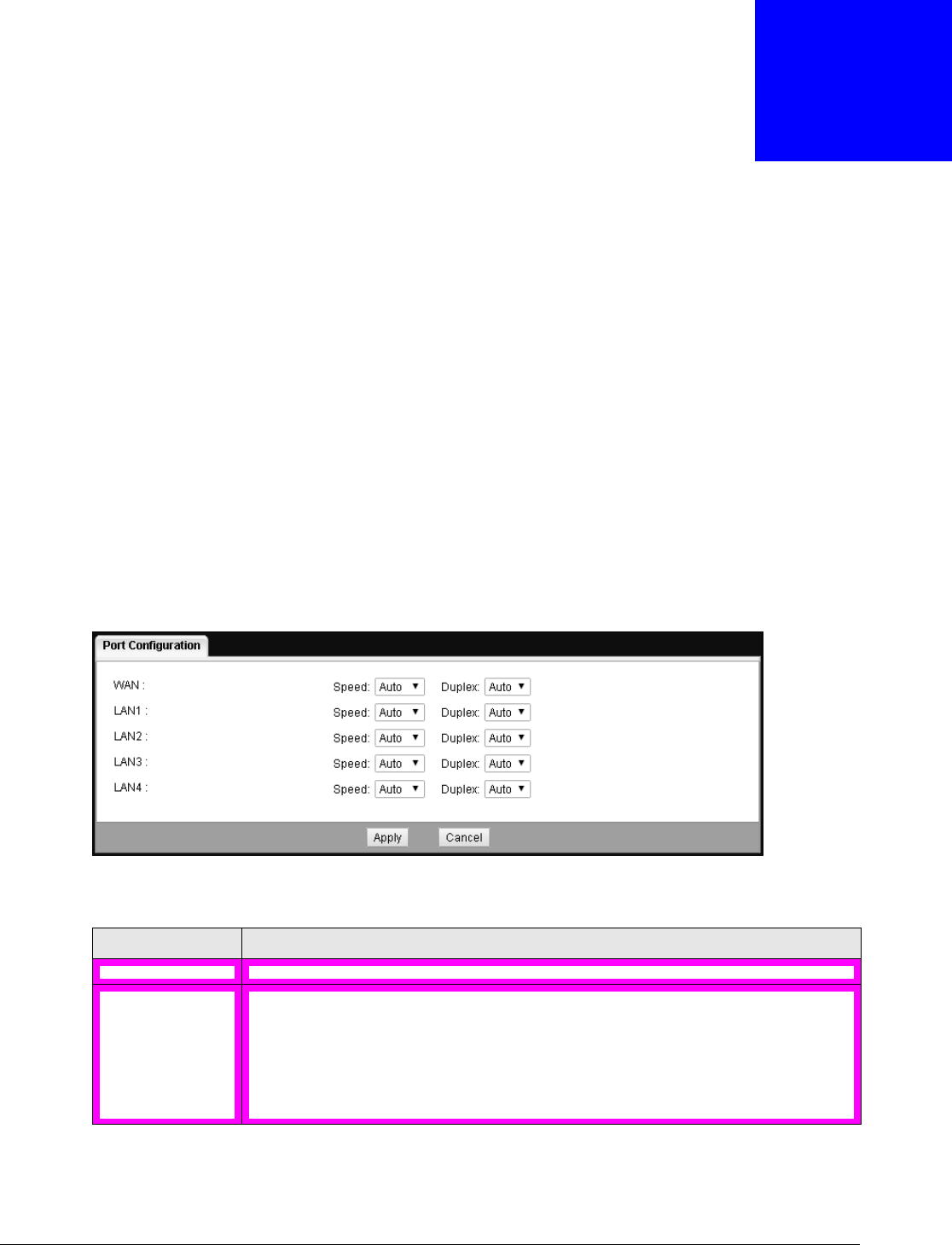
EMG2926-Q10A User’s Guide
177
CHAPTER 25
Port Configuration
25.1 Overview
The EMG2926-Q10A has 1000Base-T auto-negotiating Ethernet ports. In 10/100/1000 Mbps
Gigabit Ethernet, the speed can be 10 Mbps, 100 Mbps or 1000 Mbps. The duplex mode can be both
half or full duplex. An auto-negotiating port can detect and adjust to the optimum Ethernet speed
(10/100/1000 Mbps) and duplex mode (full duplex or half duplex) of the connected device.
25.2 Port Configuration Screen
Use this screen to configure the EMG2926-Q10A port speed and duplex settings. Click
Configuration > Management > Port Configuration.
Figure 125 Management > Port Configuration
The following table describes the labels in this screen.
Table 73 Management > Port Configuration
LABEL DESCRIPTION
WAN/LAN1~4 This field displays the Ethernet port of the EMG2926-Q10A.
Speed Select the speed of the Ethernet connection on this port. The choices are Auto, 1000,
100 and 10.
Selecting Auto (auto-negotiation) allows one port to negotiate with a peer port
automatically to obtain the connection speed that both ends support. If the peer port
does not support auto-negotiation or turns off this feature, the EMG2926-Q10A
determines the connection speed by detecting the signal on the cable and using half
duplex mode.
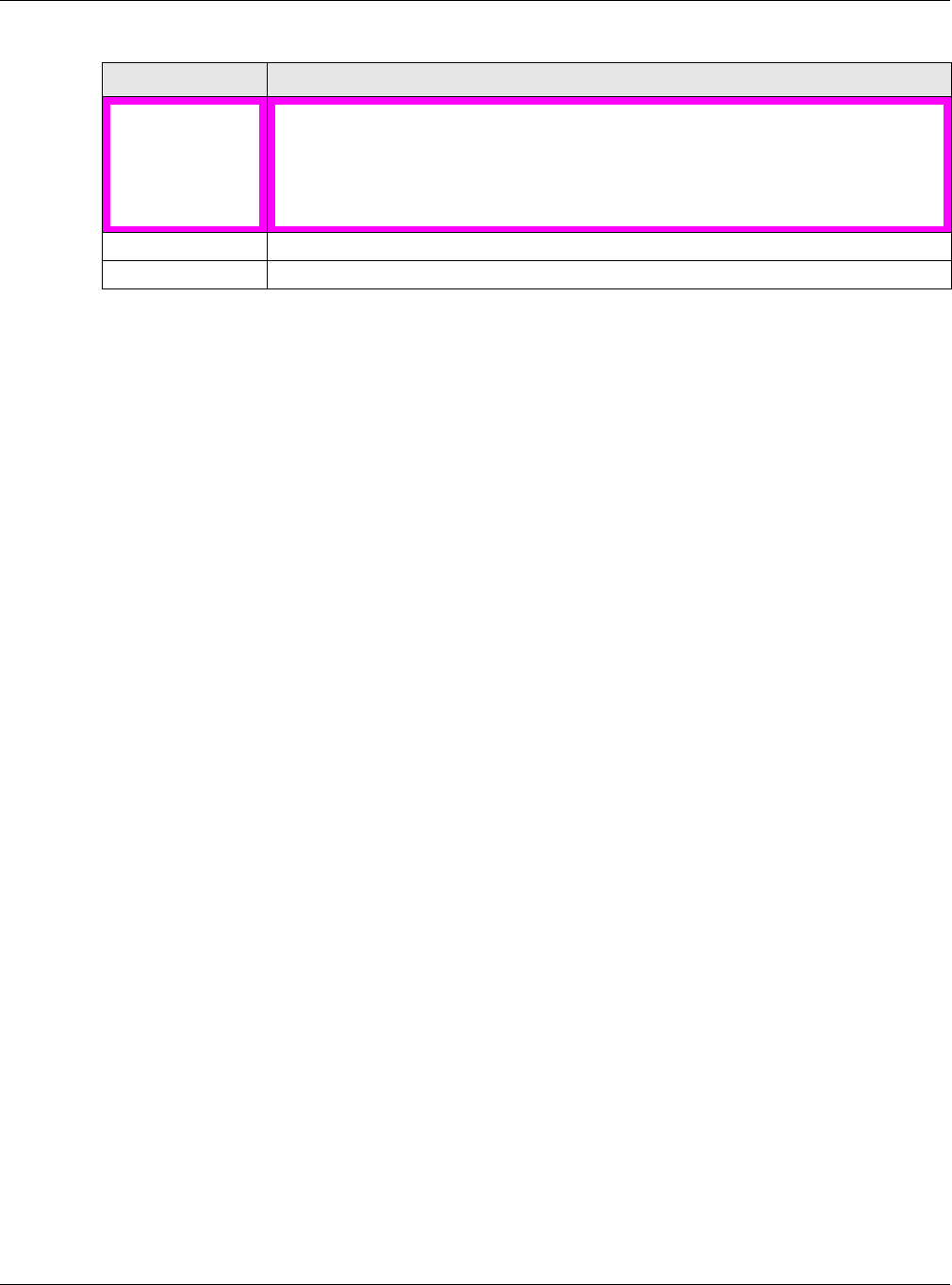
Chapter 25 Port Configuration
EMG2926-Q10A User’s Guide
178
Duplex Select the duplex mode of the Ethernet connection on this port. The choices are Auto,
Full and Half.
Selecting Auto (auto-negotiation) allows one port to negotiate with a peer port
automatically to obtain the duplex mode that both ends support. If the peer port does
not support auto-negotiation or turns off this feature, the EMG2926-Q10A determines
the connection speed by detecting the signal on the cable and using half duplex mode.
Apply Click Apply to save your changes back to the EMG2926-Q10A.
Cancel Click Cancel to begin configuring this screen afresh.
Table 73 Management > Port Configuration (continued)
LABEL DESCRIPTION

EMG2926-Q10A User’s Guide
179
CHAPTER 26
Maintenance
26.1 Overview
This chapter provides information on the Maintenance screens.
26.2 What You Can Do
•Use the General screen to set the timeout period of the management session (Section 26.3 on
page 179).
•Use the Account screen to change your EMG2926-Q10A’s system password (Section 26.4 on
page 180).
•Use the Time screen to change your EMG2926-Q10A’s time and date (Section 26.5 on page
181).
•Use the Firmware Upgrade screen to upload firmware to your EMG2926-Q10A (Section 26.6 on
page 183).
•Use the Backup/Restore screen to view information related to factory defaults, backup
configuration, and restoring configuration (Section 26.8 on page 186).
•Use the Restart screen to reboot the EMG2926-Q10A without turning the power off (Section
26.8 on page 186).
•Use the Language screen to change the language for the Web Configurator (Section 26.9 on
page 186) .
•Use the Sys OP Mode screen to select how you want to use your EMG2926-Q10A (Section 26.11
on page 188).
26.3 General Screen
Use this screen to set the management session timeout period. Click Maintenance > General.
The following screen displays.
Figure 126 Maintenance > General
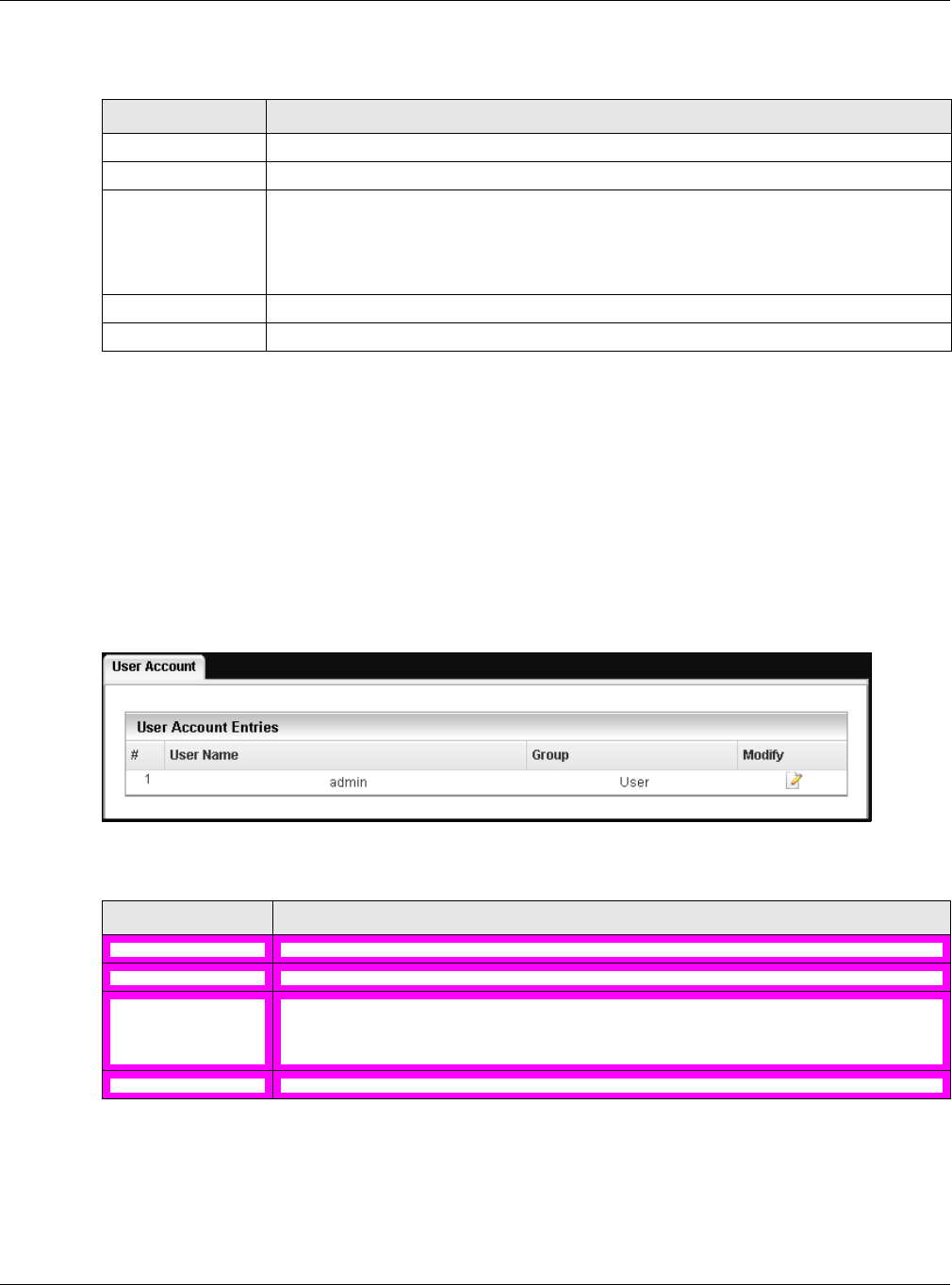
Chapter 26 Maintenance
EMG2926-Q10A User’s Guide
180
The following table describes the labels in this screen.
26.4 Account Screen
It is strongly recommended that you change the password of the user account.
If you forget your login account password (or IP address), you will need to reset the device. See
Section 26.8 on page 186 for details.
Click Maintenance > Account. The screen appears as shown.
Figure 127 Maintenance > Account
The following table describes the labels in this screen.
26.4.1 Edit a Users Account
Use this screen to edit a users account. Click the Edit icon next to the user account you want to
edit. The Account Setup screen displays as shown.
Table 74 Maintenance > General
LABEL DESCRIPTION
System Name System Name is a unique name to identify the EMG2926-Q10A in an Ethernet network.
Domain Name Enter the domain name you want to give to the EMG2926-Q10A.
Administrator
Inactivity Timer
Type how many minutes a management session can be left idle before the session times
out. The default is 5 minutes. After it times out you have to log in with your password
again. Very long idle timeouts may have security risks. A value of "0" means a
management session never times out, no matter how long it has been left idle (not
recommended).
Apply Click Apply to save your changes back to the EMG2926-Q10A.
Cancel Click Cancel to begin configuring this screen afresh.
Table 75 Maintenance > Account
LABEL DESCRIPTION
#This the index number of the entry.
User Name This field displays the name of the user.
Group This field displays the login account type of the user.
Different login account types have different privilege levels. The web configurator
screens and privileges vary depending on which account type you use to log in.
Modify Click the Edit icon to go to the screen where you can edit the account.
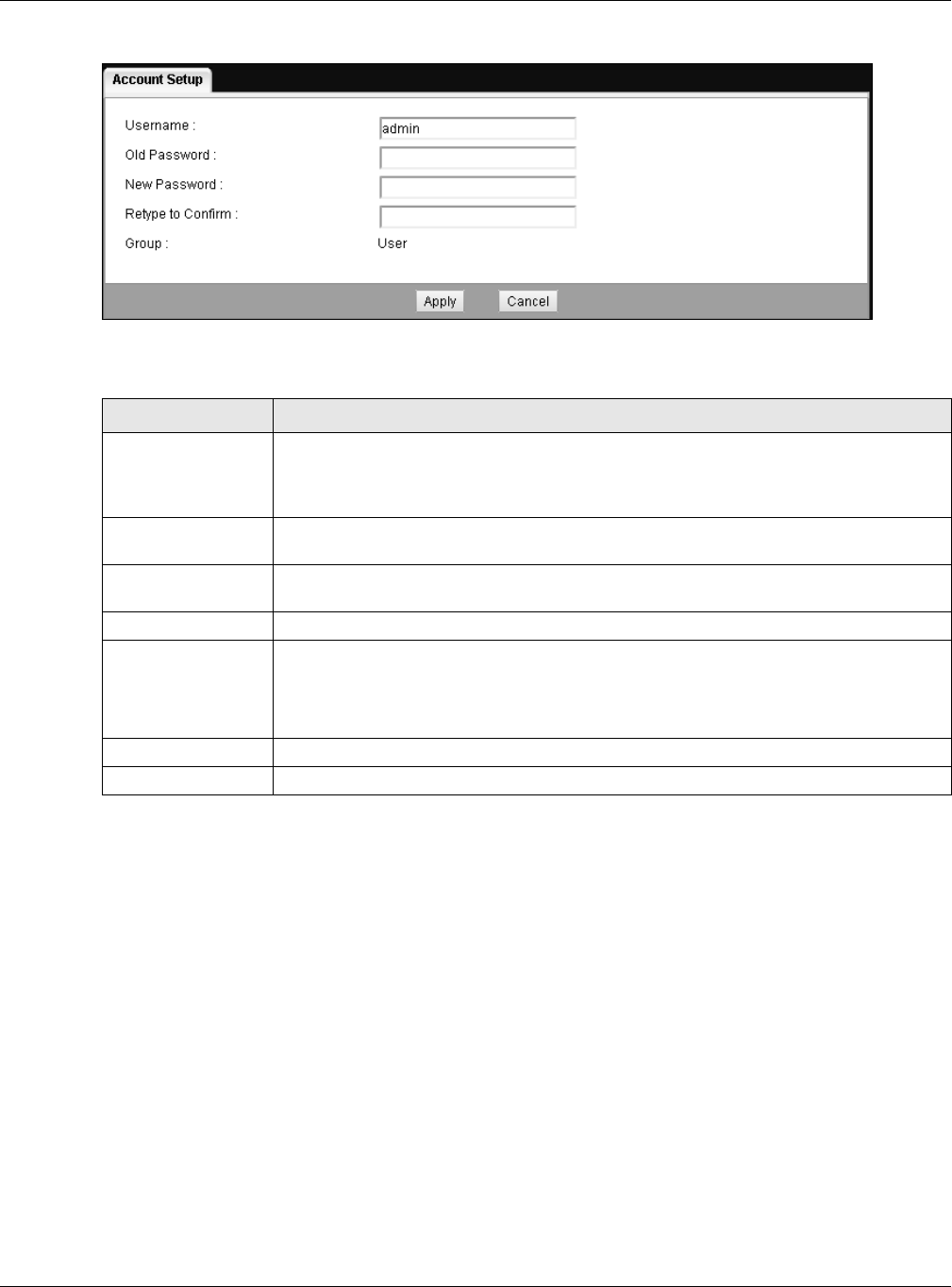
Chapter 26 Maintenance
EMG2926-Q10A User’s Guide
181
Figure 128 Maintenance > Account > Edit
The following table describes the labels in this screen.
26.5 Time Setting Screen
Use this screen to configure the EMG2926-Q10A’s time based on your local time zone. To change
your EMG2926-Q10A’s time and date, click Maintenance > Time. The screen appears as shown.
Table 76 Maintenance > Account > Edit
LABEL DESCRIPTION
Username Enter a descriptive name for the user account. The user name can be up to 15
alphanumeric characters (0-9, A-Z, a-z, -, _ with no spaces). With advanced account
security enabled, the user names must be a minimum length of six characters and
include both letters and numbers.
Old Password Type the default password or the existing password you use to access the system in
this field.
New Password Type your new system password (up to 30 characters). Note that as you type a
password, the screen displays an asterisk (*) for each character you type.
Retype to Confirm Type the new password again in this field.
Group This is the account type of the user.
The web configurator screens and privileges vary depending on which account type you
use to log in. Administrator accounts can configure the EMG2926-Q10A and upgrade
firmware while User accounts cannot do firmware upgrading.
Apply Click Apply to save your changes back to the EMG2926-Q10A.
Cancel Click Cancel to begin configuring this screen afresh.
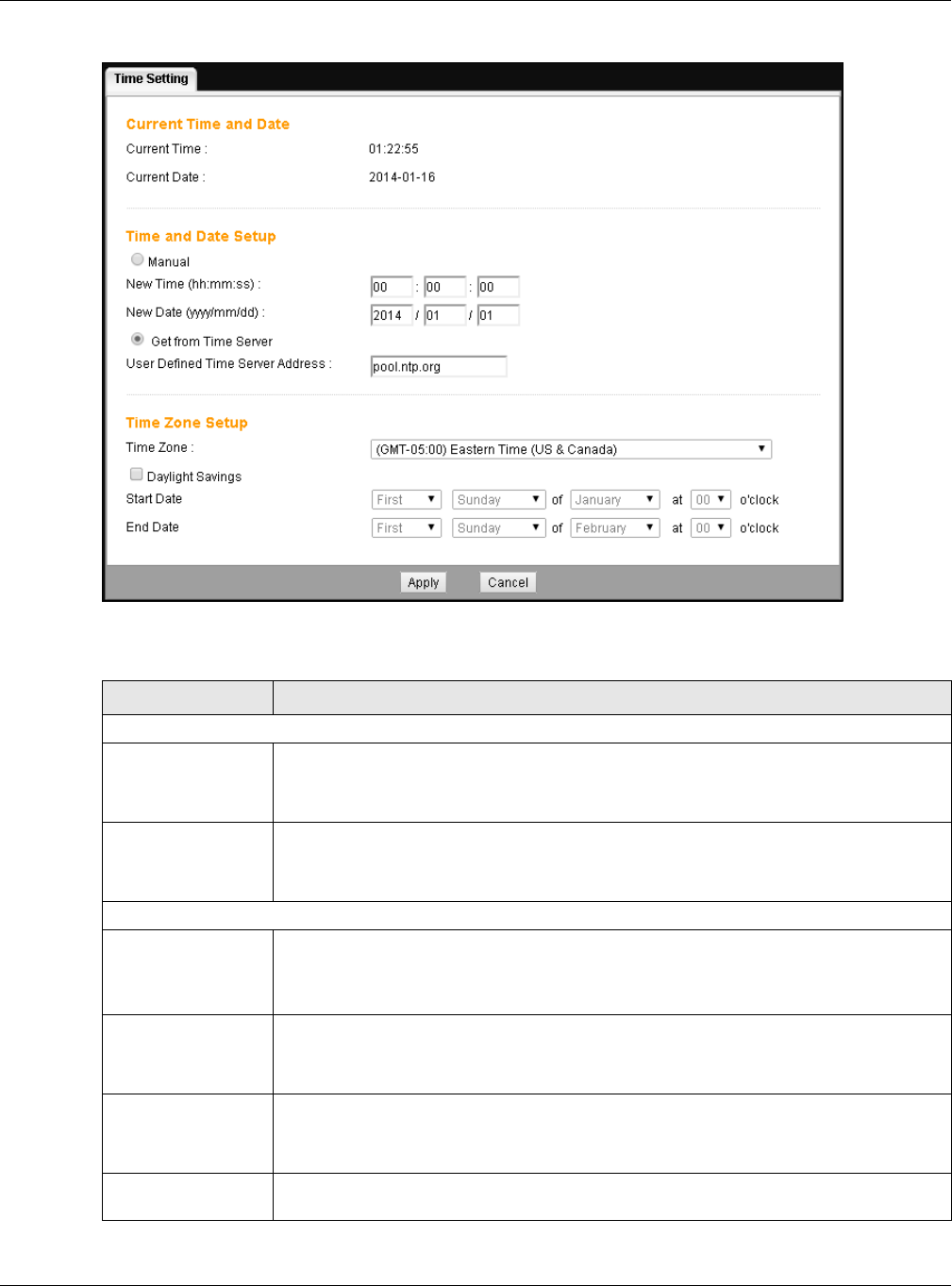
Chapter 26 Maintenance
EMG2926-Q10A User’s Guide
182
Figure 129 Maintenance > Time
The following table describes the labels in this screen.
Table 77 Maintenance > Time
LABEL DESCRIPTION
Current Time and Date
Current Time This field displays the time of your EMG2926-Q10A.
Each time you reload this page, the EMG2926-Q10A synchronizes the time with the
time server.
Current Date This field displays the date of your EMG2926-Q10A.
Each time you reload this page, the EMG2926-Q10A synchronizes the date with the
time server.
Current Time and Date
Manual Select this radio button to enter the time and date manually. If you configure a new
time and date, Time Zone and Daylight Saving at the same time, the new time and date
you entered has priority and the Time Zone and Daylight Saving settings do not affect
it.
New Time
(hh:mm:ss)
This field displays the last updated time from the time server or the last time
configured manually.
When you select Manual, enter the new time in this field and then click Apply.
New Date
(yyyy/mm/dd)
This field displays the last updated date from the time server or the last date configured
manually.
When you select Manual, enter the new date in this field and then click Apply.
Get from Time
Server
Select this radio button to have the EMG2926-Q10A get the time and date from the
time server you specified below.

Chapter 26 Maintenance
EMG2926-Q10A User’s Guide
183
26.6 Firmware Upgrade Screen
Find firmware at www.zyxel.com in a file that uses the version number and project code with a
“*.bin” extension, e.g., “V1.00(AAKG.0).bin”. The upload process uses HTTP (Hypertext Transfer
Protocol) and may take up to two minutes. After a successful upload, the system will reboot.
Click Maintenance > Firmware Upgrade. Follow the instructions in this screen to upload
firmware to your EMG2926-Q10A.
User Defined Time
Server Address
Select User Defined Time Server Address and enter the IP address or URL (up to 20
extended ASCII characters in length) of your time server. Check with your ISP/network
administrator if you are unsure of this information.
Time Zone Setup
Time Zone Choose the time zone of your location. This will set the time difference between your
time zone and Greenwich Mean Time (GMT).
Daylight Savings Daylight saving is a period from late spring to early fall when many countries set their
clocks ahead of normal local time by one hour to give more daytime light in the
evening.
Select this option if you use Daylight Saving Time.
Start Date Configure the day and time when Daylight Saving Time starts if you selected Daylight
Savings. The at field uses the 24 hour format. Here are a couple of examples:
Daylight Saving Time starts in most parts of the United States on the second Sunday of
March. Each time zone in the United States starts using Daylight Saving Time at 2 A.M.
local time. So in the United States you would select Second, Sunday, March and
select 2 in the at field.
Daylight Saving Time starts in the European Union on the last Sunday of March. All of
the time zones in the European Union start using Daylight Saving Time at the same
moment (1 A.M. GMT or UTC). So in the European Union you would select Last,
Sunday, March. The time you select in the at field depends on your time zone. In
Germany for instance, you would select 2 because Germany's time zone is one hour
ahead of GMT or UTC (GMT+1).
End Date Configure the day and time when Daylight Saving Time ends if you selected Daylight
Savings. The at field uses the 24 hour format. Here are a couple of examples:
Daylight Saving Time ends in the United States on the first Sunday of November. Each
time zone in the United States stops using Daylight Saving Time at 2 A.M. local time.
So in the United States you would select First, Sunday, November and select 2 in the
at field.
Daylight Saving Time ends in the European Union on the last Sunday of October. All of
the time zones in the European Union stop using Daylight Saving Time at the same
moment (1 A.M. GMT or UTC). So in the European Union you would select Last,
Sunday, October. The time you select in the at field depends on your time zone. In
Germany for instance, you would select 2 because Germany's time zone is one hour
ahead of GMT or UTC (GMT+1).
Apply Click Apply to save your changes back to the EMG2926-Q10A.
Cancel Click Cancel to begin configuring this screen afresh.
Table 77 Maintenance > Time (continued)
LABEL DESCRIPTION
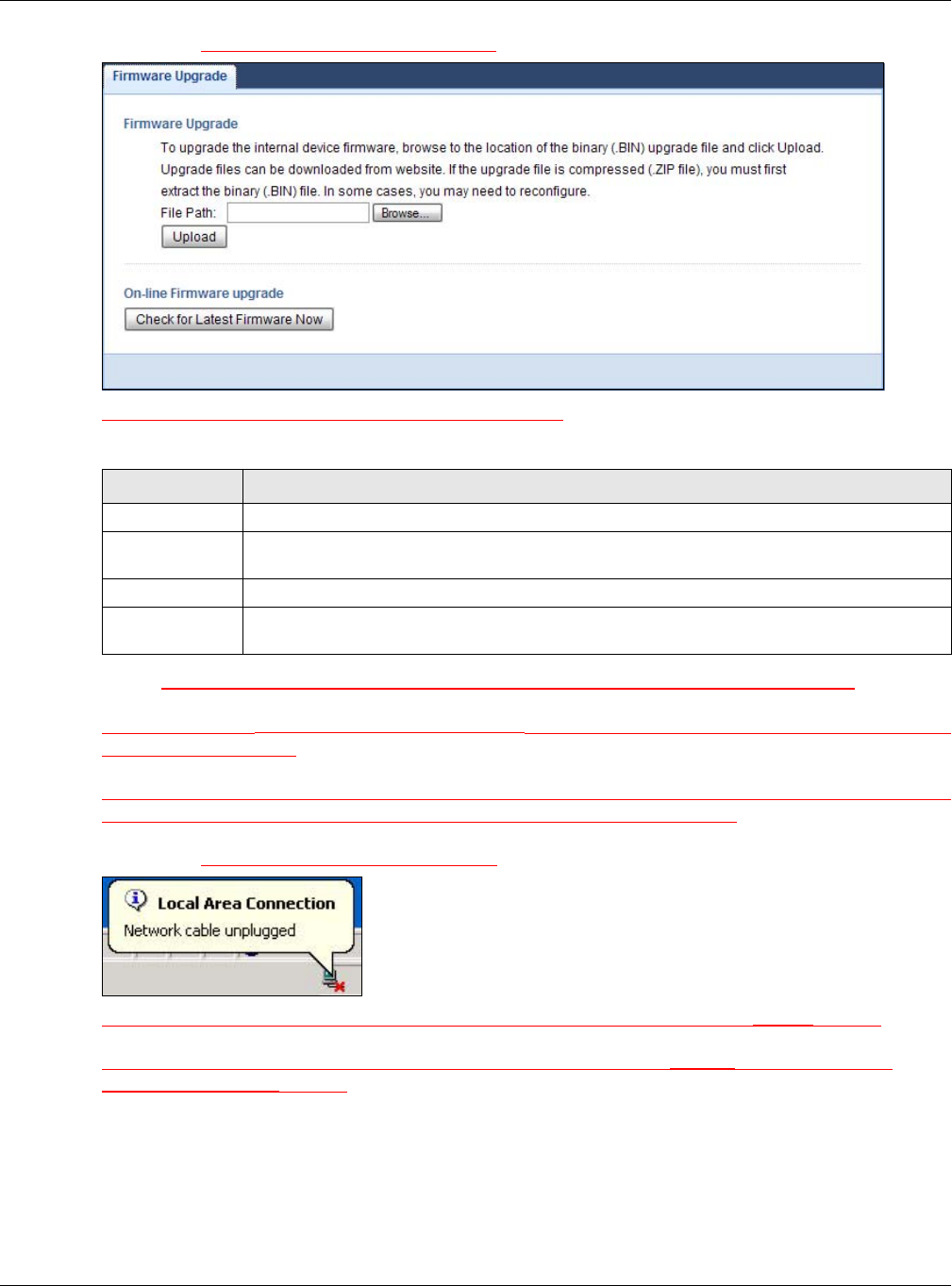
Chapter 26 Maintenance
EMG2926-Q10A User’s Guide
184
Figure 130 Maintenance > Firmware Upgrade
The following table describes the labels in this screen.
Note: Do not turn off the EMG2926-Q10A while firmware upload is in progress!
After you see the Firmware Upload In Process screen, wait two minutes before logging into the
EMG2926-Q10A again.
The EMG2926-Q10A automatically restarts in this time causing a temporary network disconnect. In
some operating systems, you may see the following icon on your desktop.
Figure 131 Network Temporarily Disconnected
After two minutes, log in again and check your new firmware version in the Status screen.
If the upload was not successful, an error message appears. Click Return to go back to the
Firmware Upgrade screen.
Table 78 Maintenance > Firmware Upgrade
LABEL DESCRIPTION
File Path Type in the location of the file you want to upload in this field or click Browse... to find it.
Browse... Click Browse... to find the .bin file you want to upload. Remember that you must
decompress compressed (.zip) files before you can upload them.
Upload Click Upload to begin the upload process. This process may take up to two minutes.
Check for Latest
Firmware Now
Click this to check for the latest updated firmware.
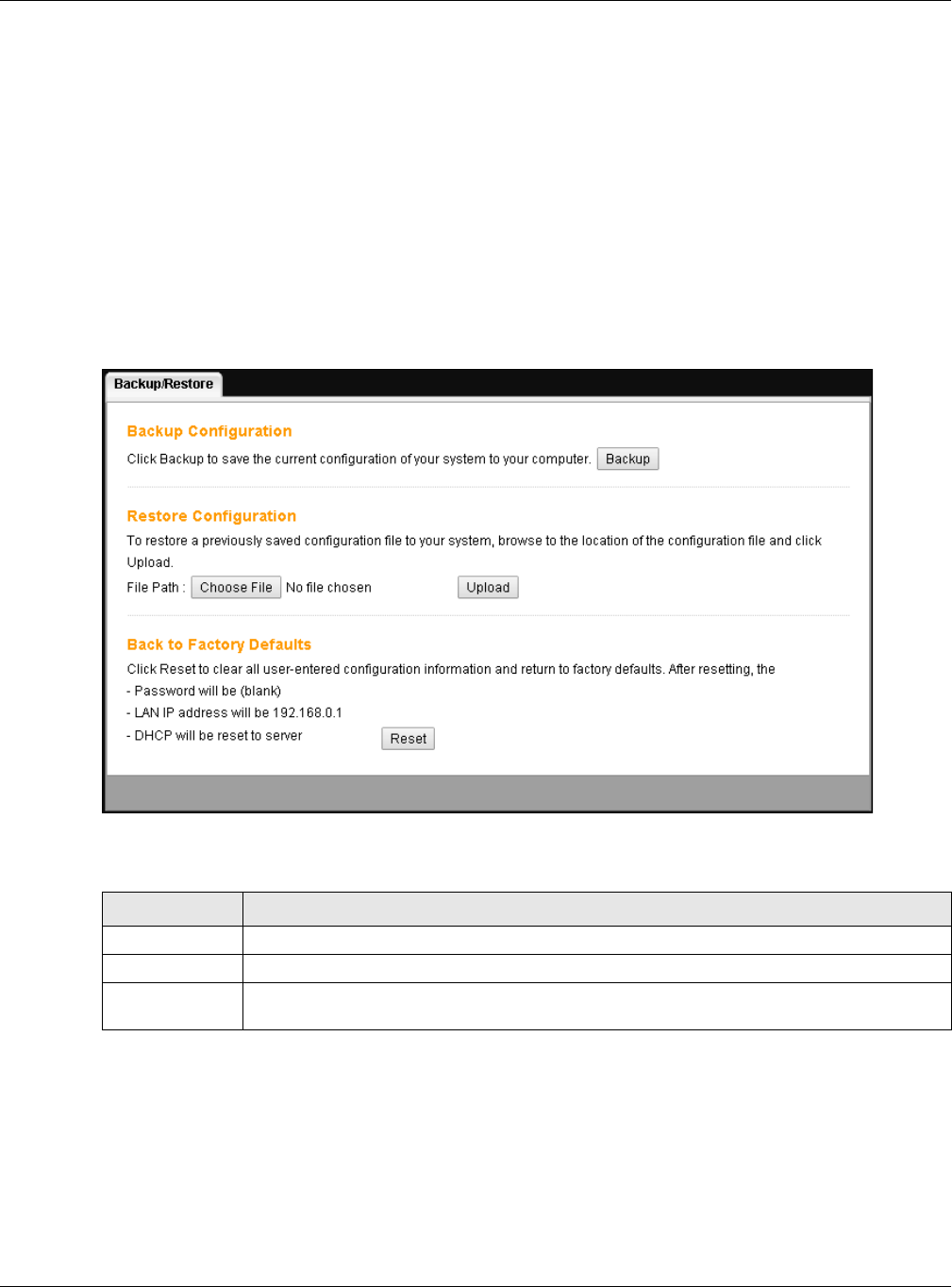
Chapter 26 Maintenance
EMG2926-Q10A User’s Guide
185
26.7 Configuration Backup/Restore Screen
Backup configuration allows you to back up (save) the EMG2926-Q10A’s current configuration to a
file on your computer. Once your EMG2926-Q10A is configured and functioning properly, it is highly
recommended that you back up your configuration file before making configuration changes. The
backup configuration file will be useful in case you need to return to your previous settings.
Restore configuration allows you to upload a new or previously saved configuration file from your
computer to your EMG2926-Q10A.
Click Maintenance > Backup/Restore. Information related to factory defaults, backup
configuration, and restoring configuration appears as shown next.
Figure 132 Maintenance > Backup/Restore
The following table describes the labels in this screen.
Table 79 Maintenance > Backup/Restore
LABEL DESCRIPTION
Backup Click Backup to save the EMG2926-Q10A’s current configuration to your computer.
File Path Type in the location of the file you want to upload in this field or click Browse... to find it.
Choose File Click Choose File to find the file you want to upload. Remember that you must
decompress compressed (.ZIP) files before you can upload them.
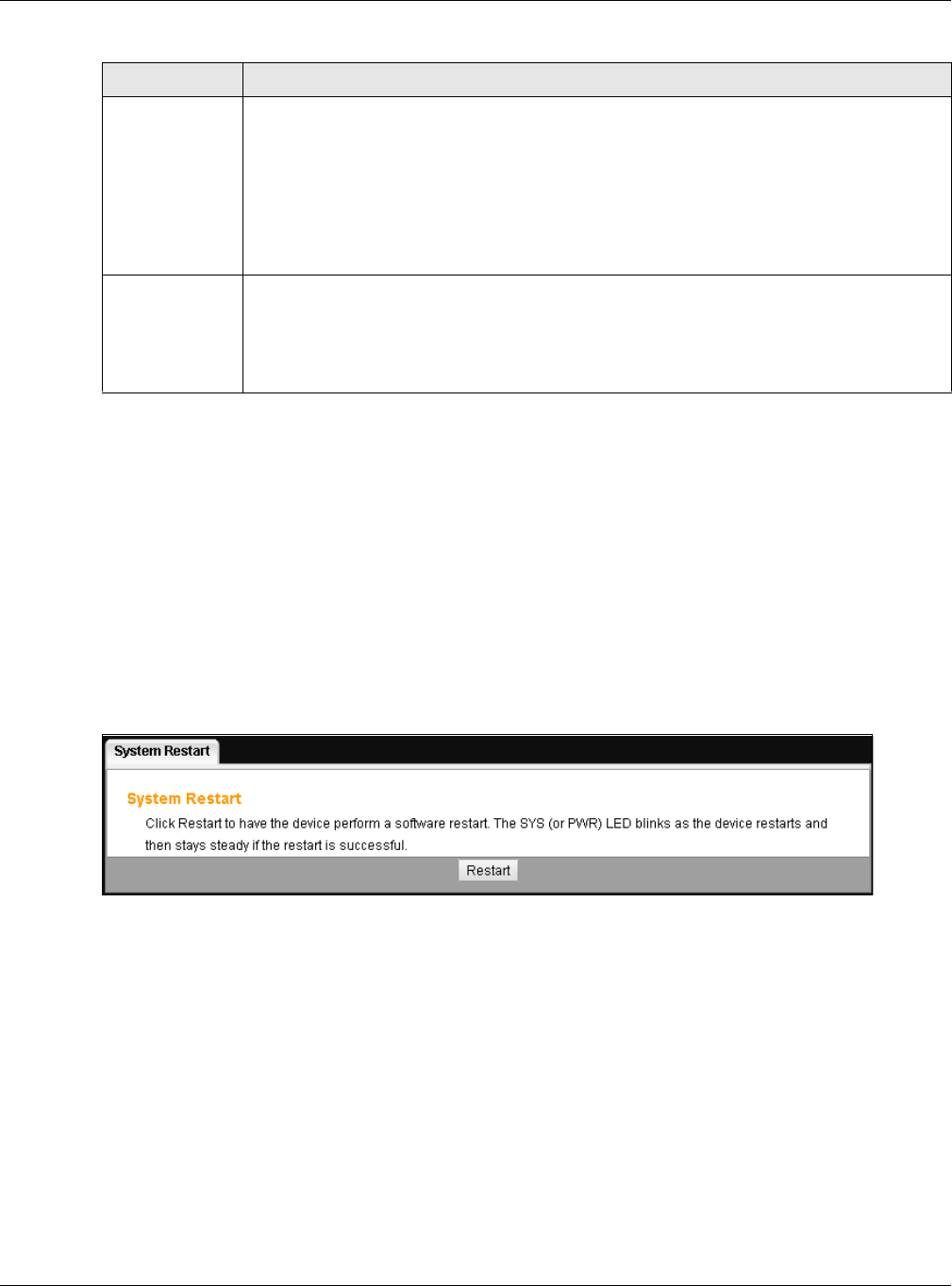
Chapter 26 Maintenance
EMG2926-Q10A User’s Guide
186
Note: If you uploaded the default configuration file you may need to change the IP
address of your computer to be in the same subnet as that of the default
EMG2926-Q10A IP address (192.168.0.1). See Appendix B on page 193 for details
on how to set up your computer’s IP address.
26.8 Restart Screen
System restart allows you to reboot the EMG2926-Q10A without turning the power off.
Click Maintenance > Restart to open the following screen.
Figure 133 Maintenance > Restart
Click Restart to have the EMG2926-Q10A reboot. This does not affect the EMG2926-Q10A's
configuration.
26.9 Language Screen
Use this screen to change the language for the Web Configurator.
Select the language you prefer and click Apply. The Web Configurator language changes after a
while without restarting the EMG2926-Q10A.
Upload Click Upload to begin the upload process.
Note: Do not turn off the EMG2926-Q10A while configuration file upload is in progress.
After you see a “configuration upload successful” screen, you must then wait one minute
before logging into the EMG2926-Q10A again. The EMG2926-Q10A automatically restarts
in this time causing a temporary network disconnect.
If you see an error screen, click Back to return to the Backup/Restore screen.
Reset Pressing the Reset button in this section clears all user-entered configuration information
and returns the EMG2926-Q10A to its factory defaults.
You can also press the RESET button on the rear panel to reset the factory defaults of your
EMG2926-Q10A. Refer to the chapter about introducing the Web Configurator for more
information on the RESET button.
Table 79 Maintenance > Backup/Restore (continued)
LABEL DESCRIPTION
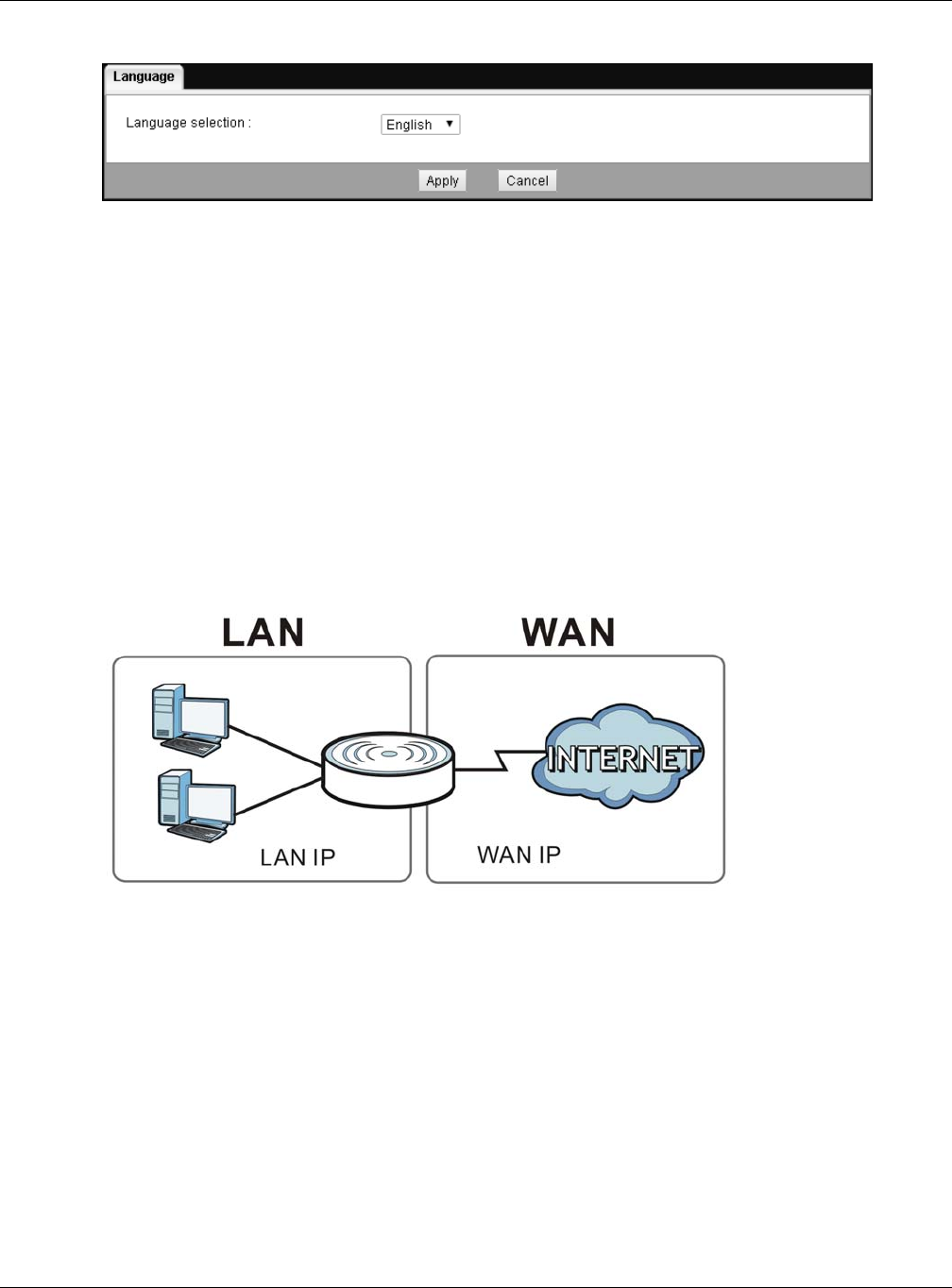
Chapter 26 Maintenance
EMG2926-Q10A User’s Guide
187
Figure 134 Maintenance > Language
26.10 System Operation Mode Overview
The Sys OP Mode (System Operation Mode) function lets you configure your EMG2926-Q10A as a
router or access point. You can choose between Router Mode, and Access Point Mode depending
on your network topology and the features you require from your device.
The following describes the device modes available in your EMG2926-Q10A.
Router
A router connects your local network with another network, such as the Internet. The router has
two IP addresses, the LAN IP address and the WAN IP address.
Figure 135 LAN and WAN IP Addresses in Router Mode
Access Point
An access point enabled all ethernet ports to be bridged together and be in the same subnet. To
connect to the Internet, another device, such as a router, is required.
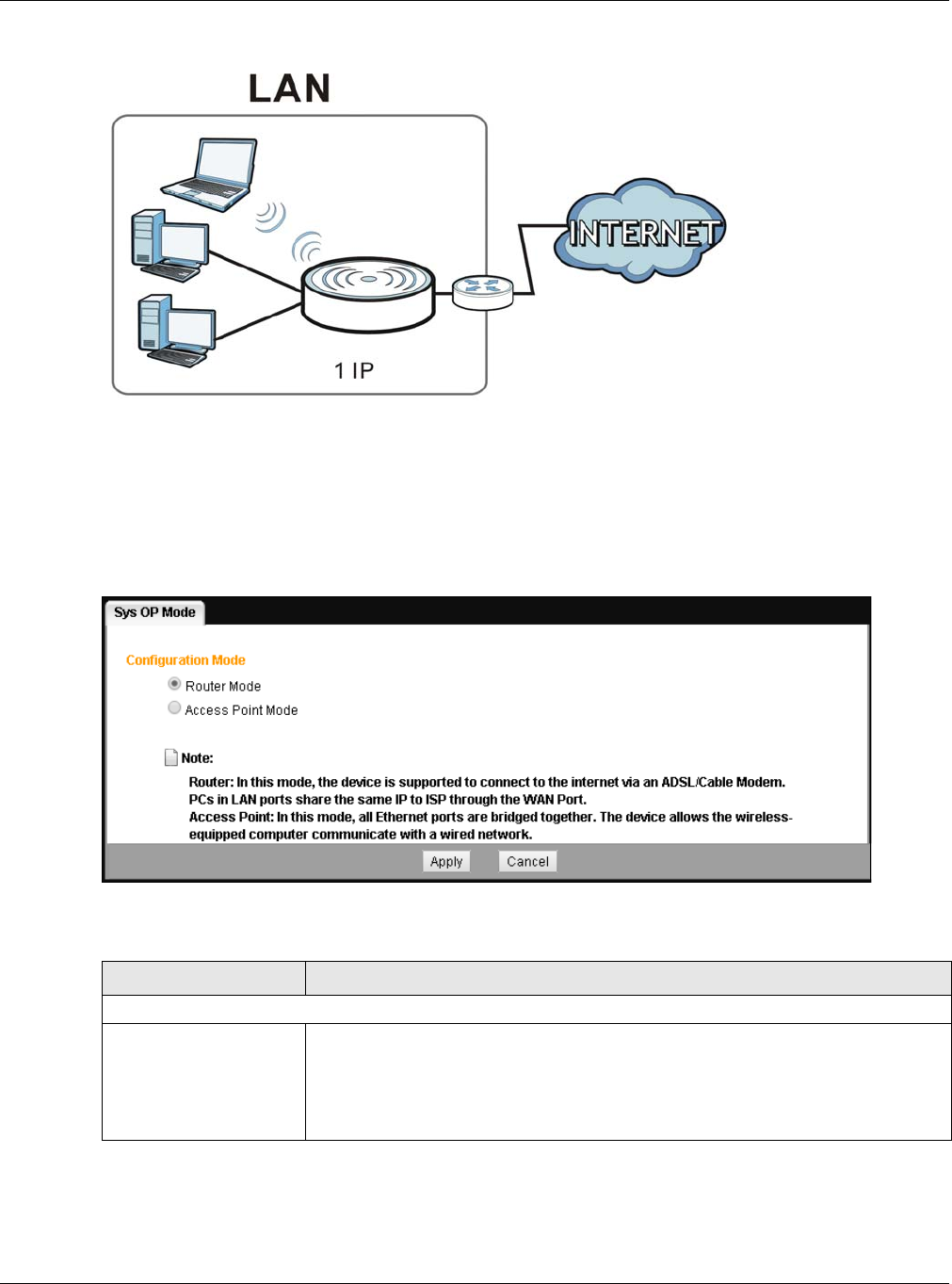
Chapter 26 Maintenance
EMG2926-Q10A User’s Guide
188
Figure 136 Access Point Mode
26.11 Sys OP Mode Screen
Use this screen to select how you want to use your EMG2926-Q10A.
Figure 137 Maintenance > Sys OP Mode
The following table describes the labels in the General screen.
Table 80 Maintenance > Sys OP Mode
LABEL DESCRIPTION
Configuration Mode
Router Mode Select Router Mode if your device routes traffic between a local network and
another network such as the Internet. This mode offers services such as a firewall
or bandwidth management.
You can configure the IP address settings on your WAN port. Contact your ISP or
system administrator for more information on appropriate settings.

Chapter 26 Maintenance
EMG2926-Q10A User’s Guide
189
Note: If you select the incorrect system operation Mode you may not be able to connect
to the Internet.
Access Point Mode Select Access Point Mode if your device bridges traffic between clients on the
same network.
•In Access Point Mode, all Ethernet ports have the same IP address.
• All ports on the rear panel of the device are LAN ports, including the port
labeled WAN. There is no WAN port.
• The DHCP server on your device is disabled.
• Router functions (such as NAT, bandwidth management, remote management,
firewall and so on) are not available when the EMG2926-Q10A is in Access
Point Mode.
•The IP address of the device on the local network is set to 192.168.0.2.
Apply Click Apply to save your settings.
Cancel Click Cancel to return your settings to the default (Router).
Table 80 Maintenance > Sys OP Mode (continued)
LABEL DESCRIPTION

EMG2926-Q10A User’s Guide
190
CHAPTER 27
Troubleshooting
27.1 Overview
This chapter offers some suggestions to solve problems you might encounter. The potential
problems are divided into the following categories.
•Power, Hardware Connections, and LEDs
•EMG2926-Q10A Access and Login
•Internet Access
•Resetting the EMG2926-Q10A to Its Factory Defaults
•Wireless Connections
•USB Device Problems
•ZyXEL Share Center Utility Problems
27.2 Power, Hardware Connections, and LEDs
The EMG2926-Q10A does not turn on. None of the LEDs turn on.
1Make sure you are using the power adaptor or cord included with the EMG2926-Q10A.
2Make sure the power adaptor or cord is connected to the EMG2926-Q10A and plugged in to an
appropriate power source. Make sure the power source is turned on.
3Disconnect and re-connect the power adaptor or cord to the EMG2926-Q10A.
4If the problem continues, contact the vendor.
One of the LEDs does not behave as expected.
1Make sure you understand the normal behavior of the LED. See Section 1.7 on page 15.
2Check the hardware connections. See the Quick Start Guide.
3Inspect your cables for damage. Contact the vendor to replace any damaged cables.

Chapter 27 Troubleshooting
EMG2926-Q10A User’s Guide
191
4Disconnect and re-connect the power adaptor to the EMG2926-Q10A.
5If the problem continues, contact the vendor.
27.3 EMG2926-Q10A Access and Login
I don’t know the IP address of my EMG2926-Q10A.
1The default IP address of the EMG2926-Q10A in Router Mode is 192.168.0.1. The default IP
address of the EMG2926-Q10A in Access Point Mode is 192.168.0.2.
2If you changed the IP address and have forgotten it, you might get the IP address of the EMG2926-
Q10A in Router Mode by looking up the IP address of the default gateway for your computer. To do
this in most Windows computers, click Start > Run, enter cmd, and then enter ipconfig. The IP
address of the Default Gateway might be the IP address of the EMG2926-Q10A (it depends on the
network), so enter this IP address in your Internet browser.
3If your EMG2926-Q10A in Access Point Mode is a DHCP client, you can find your IP address from
the DHCP server. This information is only available from the DHCP server which allocates IP
addresses on your network. Find this information directly from the DHCP server or contact your
system administrator for more information.
4Reset your EMG2926-Q10A to change all settings back to their default. This means your current
settings are lost. See Section 27.5 on page 194 in the Troubleshooting for information on
resetting your EMG2926-Q10A.
I forgot the password.
1The default password is 1234.
2If this does not work, you have to reset the device to its factory defaults. See Section 27.5 on page
194.
I cannot see or access the Login screen in the Web Configurator.
1Make sure you are using the correct IP address.
•The default IP address of the EMG2926-Q10A in Router Mode is 192.168.0.1. The default IP
address of the EMG2926-Q10A in Access Point Mode is 192.168.0.2.
• If you changed the IP address (Section 12.4 on page 110), use the new IP address.
• If you changed the IP address and have forgotten it, see the troubleshooting suggestions for I
don’t know the IP address of my EMG2926-Q10A.

Chapter 27 Troubleshooting
EMG2926-Q10A User’s Guide
192
2Check the hardware connections, and make sure the LEDs are behaving as expected. See the Quick
Start Guide.
3Make sure your Internet browser does not block pop-up windows and has JavaScript and Java
enabled. See Appendix A on page 184.
4Make sure your computer is in the same subnet as the EMG2926-Q10A. (If you know that there are
routers between your computer and the EMG2926-Q10A, skip this step.)
• If there is a DHCP server on your network, make sure your computer is using a dynamic IP
address. See Section 12.4 on page 110.
• If there is no DHCP server on your network, make sure your computer’s IP address is in the
same subnet as the EMG2926-Q10A. See Section 12.4 on page 110.
5Reset the device to its factory defaults, and try to access the EMG2926-Q10A with the default IP
address. See Section 1.5 on page 14.
6If the problem continues, contact the network administrator or vendor, or try one of the advanced
suggestions.
Advanced Suggestions
• Try to access the EMG2926-Q10A using another service, such as Telnet. If you can access the
EMG2926-Q10A, check the remote management settings and firewall rules to find out why the
EMG2926-Q10A does not respond to HTTP.
• If your computer is connected to the WAN port or is connected wirelessly, use a computer that is
connected to a LAN/ETHERNET port.
I can see the Login screen, but I cannot log in to the EMG2926-Q10A.
1Make sure you have entered the password correctly. The default password is 1234. This field is
case-sensitive, so make sure [Caps Lock] is not on.
2This can happen when you fail to log out properly from your last session. Try logging in again after
5 minutes.
3Disconnect and re-connect the power adaptor or cord to the EMG2926-Q10A.
4If this does not work, you have to reset the device to its factory defaults. See Section 27.5 on page
194.
27.4 Internet Access
I cannot access the Internet.

Chapter 27 Troubleshooting
EMG2926-Q10A User’s Guide
193
1Check the hardware connections, and make sure the LEDs are behaving as expected. See the Quick
Start Guide.
2Go to Maintenance > Sys OP Mode. Check your System Operation Mode setting.
• If the EMG2926-Q10A is in Router Mode, make sure the WAN port is connected to a
broadband modem or router with Internet access. Your computer and the EMG2926-Q10A
should be in the same subnet.
• If the EMG2926-Q10A is in Access Point Mode, make sure the WAN port is connected to a
broadband modem or router with Internet access and your computer is set to obtain an
dynamic IP address.
3If the EMG2926-Q10A is in Router Mode, make sure you entered your ISP account information
correctly in the wizard or the WAN screen. These fields are case-sensitive, so make sure [Caps
Lock] is not on.
4If you are trying to access the Internet wirelessly, make sure the wireless settings in the wireless
client are the same as the settings in the AP.
5Disconnect all the cables from your device, and follow the directions in the Quick Start Guide again.
6If the problem continues, contact your ISP.
I cannot access the Internet anymore. I had access to the Internet (with the EMG2926-
Q10A), but my Internet connection is not available anymore.
1Check the hardware connections, and make sure the LEDs are behaving as expected. See the Quick
Start Guide and Section 1.7 on page 15.
2Reboot the EMG2926-Q10A.
3If the problem continues, contact your ISP.
The Internet connection is slow or intermittent.
1There might be a lot of traffic on the network. Look at the LEDs, and check Section 1.7 on page 15.
If the EMG2926-Q10A is sending or receiving a lot of information, try closing some programs that
use the Internet, especially peer-to-peer applications.
2Check the signal strength. If the signal strength is low, try moving the EMG2926-Q10A closer to the
AP if possible, and look around to see if there are any devices that might be interfering with the
wireless network (for example, microwaves, other wireless networks, and so on).
3Reboot the EMG2926-Q10A.
4If the problem continues, contact the network administrator or vendor, or try one of the advanced
suggestions.
Advanced Suggestion

Chapter 27 Troubleshooting
EMG2926-Q10A User’s Guide
194
• Check the settings for QoS. If it is disabled, you might consider activating it.
27.5 Resetting the EMG2926-Q10A to Its Factory Defaults
If you reset the EMG2926-Q10A, you lose all of the changes you have made. The EMG2926-Q10A
re-loads its default settings, and the password resets to 1234. You have to make all of your
changes again.
You will lose all of your changes when you push the RESET button.
To reset the EMG2926-Q10A:
1Make sure the power LED is on.
2Press the RESET button for one to four seconds to restart/reboot the EMG2926-Q10A.
3Press the RESET button for longer than five seconds to set the EMG2926-Q10A back to its factory-
default configurations.
If the EMG2926-Q10A restarts automatically, wait for the EMG2926-Q10A to finish restarting, and
log in to the Web Configurator. The password is “1234”.
If the EMG2926-Q10A does not restart automatically, disconnect and reconnect the EMG2926-
Q10A’s power. Then, follow the directions above again.
27.6 Wireless Connections
I cannot access the EMG2926-Q10A or ping any computer from the WLAN.
1Make sure the wireless LAN is enabled on the EMG2926-Q10A.
2Make sure the wireless adapter on your computer is working properly.
3Make sure the wireless adapter installed on your computer is IEEE 802.11 compatible and supports
the same wireless standard as the EMG2926-Q10A.
4Make sure your computer (with a wireless adapter installed) is within the transmission range of the
EMG2926-Q10A.
5Check that both the EMG2926-Q10A and the wireless adapter on your computer are using the same
wireless and wireless security settings.

Chapter 27 Troubleshooting
EMG2926-Q10A User’s Guide
195
6Make sure traffic between the WLAN and the LAN is not blocked by the firewall on the EMG2926-
Q10A.
7Make sure you allow the EMG2926-Q10A to be remotely accessed through the WLAN interface.
Check your remote management settings.
• See the chapter on Wireless LAN in the User’s Guide for more information.
I set up URL keyword blocking, but I can still access a website that should be blocked.
Make sure that you select the Enable URL Keyword Blocking check box in the Content Filtering
screen. Make sure that the keywords that you type are listed in the Keyword List.
If a keyword that is listed in the Keyword List is not blocked when it is found in a URL, customize
the keyword blocking using commands. See the Customizing Keyword Blocking URL Checking
section in the Content Filtering chapter.
I cannot access the Web Configurator after I switched to AP mode.
When you change from router mode to AP mode, your computer must have an IP address in the
range between “192.168.0.3” and “192.168.0.254”.
Refer to Appendix B on page 193 for instructions on how to change your computer’s IP address.
What factors may cause intermittent or unstabled wireless connection? How can I solve this
problem?
The following factors may cause interference:
• Obstacles: walls, ceilings, furniture, and so on.
• Building Materials: metal doors, aluminum studs.
• Electrical devices: microwaves, monitors, electric motors, cordless phones, and other wireless
devices.
To optimize the speed and quality of your wireless connection, you can:
• Move your wireless device closer to the AP if the signal strength is low.
• Reduce wireless interference that may be caused by other wireless networks or surrounding
wireless electronics such as cordless phones.
• Place the AP where there are minimum obstacles (such as walls and ceilings) between the AP and
the wireless client.
• Reduce the number of wireless clients connecting to the same AP simultaneously, or add
additional APs if necessary.

Chapter 27 Troubleshooting
EMG2926-Q10A User’s Guide
196
• Try closing some programs that use the Internet, especially peer-to-peer applications. If the
wireless client is sending or receiving a lot of information, it may have too many programs open
that use the Internet.
• Position the antennas for best reception. If the AP is placed on a table or floor, point the antennas
upwards. If the AP is placed at a high position, point the antennas downwards. Try pointing the
antennas in different directions and check which provides the strongest signal to the wireless
clients.
27.7 USB Device Problems
I cannot access or see a USB device that is connected to the EMG2926-Q10A.
1Disconnect the problematic USB device, then reconnect it to the EMG2926-Q10A.
2Ensure that the USB device has power.
3Check your cable connections.
4Restart the EMG2926-Q10A by disconnecting the power and then reconnecting it.
5If the USB device requires a special driver, install the driver from the installation disc that came
with the device. After driver installation, reconnect the USB device to the EMG2926-Q10A and try to
connect to it again with your computer.
6If the problem persists, contact your vendor.
What kind of USB devices do the EMG2926-Q10A support?
1It is strongly recommended to use version 2.0 or lower USB storage devices (such as memory
sticks, USB hard drives) and/or USB devices (such as USB printers). Other USB products are not
guaranteed to function properly with the EMG2926-Q10A.
27.8 ZyXEL Share Center Utility Problems
I cannot access or see a USB device that is connected to the EMG2926-Q10A.
1Disconnect the problematic USB device, then reconnect it to the EMG2926-Q10A.
2Ensure that the USB device in question has power.

Chapter 27 Troubleshooting
EMG2926-Q10A User’s Guide
197
3Check your cable connections.
4Restart the EMG2926-Q10A by disconnecting the power and then reconnecting it.
5If the USB device requires a special driver, install the driver from the installation disc that came
with the device. After driver installation, reconnect the USB device to the EMG2926-Q10A and try to
connect to it again with your computer.
6If the problem persists, contact your vendor.
I cannot install the ZyXEL Share Center Utility.
1Make sure that the set up program is one required for your operating system.
2Install the latest patches and updates for your operating system.
3Check the zyxel.com download site for a newer version of the utility.

EMG2926-Q10A User’s Guide
198
APPENDIX A
Legal Information
Copyright
Copyright © 2014 by ZyXEL Communications Corporation.
The contents of this publication may not be reproduced in any part or as a whole, transcribed, stored in a retrieval system, translated into
any language, or transmitted in any form or by any means, electronic, mechanical, magnetic, optical, chemical, photocopying, manual, or
otherwise, without the prior written permission of ZyXEL Communications Corporation.
Published by ZyXEL Communications Corporation. All rights reserved.
Disclaimer
ZyXEL does not assume any liability arising out of the application or use of any products, or software described herein. Neither does it
convey any license under its patent rights nor the patent rights of others. ZyXEL further reserves the right to make changes in any
products described herein without notice. This publication is subject to change without notice.
Trademarks
Trademarks mentioned in this publication are used for identification purposes only and may be properties of their respective owners.
Certifications
Federal Communications Commission (FCC) Interference Statement
The device complies with Part 15 of FCC rules. Operation is subject to the following two conditions:
• This device may not cause harmful interference.
• This device must accept any interference received, including interference that may cause undesired operations.
This device has been tested and found to comply with the limits for a Class B digital device pursuant to Part 15 of the FCC Rules. These
limits are designed to provide reasonable protection against harmful interference in a residential installation. This device generates, uses,
and can radiate radio frequency energy, and if not installed and used in accordance with the instructions, may cause harmful interference
to radio communications. However, there is no guarantee that interference will not occur in a particular installation.
If this device does cause harmful interference to radio/television reception, which can be determined by turning the device off and on, the
user is encouraged to try to correct the interference by one or more of the following measures:
1Reorient or relocate the receiving antenna.
2Increase the separation between the equipment and the receiver.
3Connect the equipment into an outlet on a circuit different from that to which the receiver is connected.
4Consult the dealer or an experienced radio/TV technician for help.
FCC Caution: Any changes or modifications not expressly approved by the party responsible for compliance could void the user's authority
to operate this equipment.
FCC Radiation Exposure Statement
• This transmitter must not be co-located or operating in conjunction with any other antenna or transmitter.
• IEEE 802.11b, 802.11g or 802.11n (20MHz) operation of this product in the U.S.A. is firmware-limited to channels 1 through 11. IEEE
802.11n (40MHz) operation of this product in the U.S.A. is firmware-limited to channels 3 through 9.
• To comply with FCC RF exposure compliance requirements, a separation distance of at least 20 cm must be maintained between the
antenna of this device and all persons.
• Per FCC regulation, all WiFi product marketed in US must fixed to US operation channels only.
• Operations in the 5.15-5.25GHz band are restricted to indoor usage only.
Industry Canada Statement
This device complies with Industry Canada license-exempt RSS standard(s). Operation is subject to the following two conditions:
(1) this device may not cause interference, and
(2) this device must accept any interference, including interference that may cause undesired operation of the device.
Le présent appareil est conforme aux CNR d'Industrie Canada applicables aux appareils radio exempts de licence. L'exploitation est
autorisée aux deux conditions suivantes : (1) l'appareil ne doit pas produire de brouillage, et (2) l'utilisateur de l'appareil doit accepter
tout brouillage radioélectrique subi, même si le brouillage est susceptible d'en compromettre le fonctionnement.
For product available in the USA/Canada market, only channel 1~11 can be operated. Selection of other channels is not possible.
Pour les produits disponibles aux États-Unis / Canada du marché, seul le canal 1 à 11 peuvent être exploités. Sélection d'autres canaux
n'est pas possible.

Appendix A Legal Information
EMG2926-Q10A User’s Guide
199
This device and it's antennas(s) must not be co-located or operating in conjunction with any other antenna or transmitter except in
accordance with IC multi-transmitter product procedures.
Cet appareil et son antenne (s) ne doit pas être co-localisés ou fonctionnement en association avec une autre antenne ou transmetteur.
Caution :
(i) the device for operation in the band 5150-5250 MHz is only for indoor use to reduce the potential for harmful interference to co-
channel mobile satellite systems;
(ii) high-power radars are allocated as primary users (i.e. priority users) of the bands 5250-5350 MHz and 5650-5850 MHz and that these
radars could cause interference and/or damage to LE-LAN devices.
Avertissement:
(i) les dispositifs fonctionnant dans la bande 5150-5250 MHz sont réservés uniquement pour une utilisation à l'intérieur afin de réduire les
risques de brouillage préjudiciable aux systèmes de satellites mobiles utilisant les mêmes canaux;
(ii) De plus, les utilisateurs devraient aussi être avisés que les utilisateurs de radars de haute puissance sont désignés utilisateurs
principaux (c.-à-d., qu'ils ont la priorité) pour les bandes 5250-5350 MHz et 5650-5850 MHz et que ces radars pourraient causer du
brouillage et/ou des dommages aux dispositifs LAN-EL.
IC Radiation Exposure Statement
This equipment complies with IC RSS-102 radiation exposure limits set forth for an uncontrolled environment. This equipment should be
installed and operated with minimum distance 23cm between the radiator & your body.
Cet équipement est conforme aux limites d'exposition aux rayonnements IC établies pour un environnement non contrôlé. Cet
équipement doit être installé et utilisé avec un minimum de 23 cm de distance entre la source de rayonnement et votre corps.
注意 ! 依據 低功率電波輻射性電機管理辦法
第十二條 經型式認證合格之低功率射頻電機,非經許可,公司、商號或使用
者均不得擅自變更頻率、加大功率或變更原設計之特性及功能。
第十四條 低功率射頻電機之使用不得影響飛航安全及干擾合法通信;經發現
有干擾現象時,應立即停用,並改善至無干擾時方得繼續使用。
前項合法通信,指依電信規定作業之無線電信。低功率射頻電機須忍
受合法通信或工業、科學及醫療用電波輻射性電機設備之干擾。
在 5.25 - 5.35 GHz 頻帶內操作之無線資訊傳輸設備,限於室內使用。
Notices
Changes or modifications not expressly approved by the party responsible for compliance could void the user's authority to operate the
equipment.
This Class B digital apparatus complies with Canadian ICES-003.
Cet appareil numérique de la classe B est conforme à la norme NMB-003 du Canada.
Viewing Certifications
Go to http://www.zyxel.com to view this product’s documentation and certifications.
ZyXEL Limited Warranty
ZyXEL warrants to the original end user (purchaser) that this product is free from any defects in material or workmanship for a specific
period (the Warranty Period) from the date of purchase. The Warranty Period varies by region. Check with your vendor and/or the
authorized ZyXEL local distributor for details about the Warranty Period of this product. During the warranty period, and upon proof of
purchase, should the product have indications of failure due to faulty workmanship and/or materials, ZyXEL will, at its discretion, repair or
replace the defective products or components without charge for either parts or labor, and to whatever extent it shall deem necessary to
restore the product or components to proper operating condition. Any replacement will consist of a new or re-manufactured functionally
equivalent product of equal or higher value, and will be solely at the discretion of ZyXEL. This warranty shall not apply if the product has
been modified, misused, tampered with, damaged by an act of God, or subjected to abnormal working conditions.
Note
Repair or replacement, as provided under this warranty, is the exclusive remedy of the purchaser. This warranty is in lieu of all other
warranties, express or implied, including any implied warranty of merchantability or fitness for a particular use or purpose. ZyXEL shall in
no event be held liable for indirect or consequential damages of any kind to the purchaser.
To obtain the services of this warranty, contact your vendor. You may also refer to the warranty policy for the region in which you bought
the device at http://www.zyxel.com/web/support_warranty_info.php.
Registration
Register your product online to receive e-mail notices of firmware upgrades and information at www.zyxel.com for global products, or at
www.us.zyxel.com for North American products.
Open Source Licenses
This product contains in part some free software distributed under GPL license terms and/or GPL like licenses. Open source licenses are
provided with the firmware package. You can download the latest firmware at www.zyxel.com. To obtain the source code covered under
those Licenses, please contact support@zyxel.com.tw to get it.

Appendix A Legal Information
EMG2926-Q10A User’s Guide
200
Regulatory Information
European Union
The following information applies if you use the product within the European Union.
Declaration of Conformity with Regard to EU Directive 1999/5/EC (R&TTE Directive)
Compliance Information for 2.4GHz and 5GHz Wireless Products Relevant to the EU and Other Countries Following the EU Directive 1999/5/EC
(R&TTE Directive)
[Czech] ZyXEL tímto prohlašuje, že tento zařízení je ve shodě se základními požadavky a dalšími příslušnými ustanoveními
směrnice 1999/5/EC.
[Danish] Undertegnede ZyXEL erklærer herved, at følgende udstyr udstyr overholder de væsentlige krav og øvrige relevante
krav i direktiv 1999/5/EF.
[German] Hiermit erklärt ZyXEL, dass sich das Gerät Ausstattung in Übereinstimmung mit den grundlegenden Anforderungen
und den übrigen einschlägigen Bestimmungen der Richtlinie 1999/5/EU befindet.
[Estonian] Käesolevaga kinnitab ZyXEL seadme seadmed vastavust direktiivi 1999/5/EÜ põhinõuetele ja nimetatud direktiivist
tulenevatele teistele asjakohastele sätetele.
English Hereby, ZyXEL declares that this equipment is in compliance with the essential requirements and other relevant
provisions of Directive 1999/5/EC.
[Spanish] Por medio de la presente ZyXEL declara que el equipo cumple con los requisitos esenciales y cualesquiera otras
disposiciones aplicables o exigibles de la Directiva 1999/5/CE.
[Greek] ΜΕ ΤΗΝ ΠΑΡΟΥΣΑ ZyXEL ΔΗΛΩΝΕΙ ΟΤΙ εξοπλισμός ΣΥΜΜΟΡΦΩΝΕΤΑΙ ΠΡΟΣ ΤΙΣ ΟΥΣΙΩΔΕΙΣ ΑΠΑΙΤΗΣΕΙΣ ΚΑΙ ΤΙΣ
ΛΟΙΠΕΣ ΣΧΕΤΙΚΕΣ ΔΙΑΤΑΞΕΙΣ ΤΗΣ ΟΔΗΓΙΑΣ 1999/5/ΕC.
[French] Par la présente ZyXEL déclare que l'appareil équipements est conforme aux exigences essentielles et aux autres
dispositions pertinentes de la directive 1999/5/EC.
[Italian] Con la presente ZyXEL dichiara che questo attrezzatura è conforme ai requisiti essenziali ed alle altre disposizioni
pertinenti stabilite dalla direttiva 1999/5/CE.
[Latvian] Ar šo ZyXEL deklarē, ka iekārtas atbilst Direktīvas 1999/5/EK būtiskajām prasībām un citiem ar to saistītajiem
noteikumiem.
[Lithuanian] Šiuo ZyXEL deklaruoja, kad šis įranga atitinka esminius reikalavimus ir kitas 1999/5/EB Direktyvos nuostatas.
[Dutch] Hierbij verklaart ZyXEL dat het toestel uitrusting in overeenstemming is met de essentiële eisen en de andere
relevante bepalingen van richtlijn 1999/5/EC.
[Maltese] Hawnhekk, ZyXEL, jiddikjara li dan tagħmir jikkonforma mal-ħtiġijiet essenzjali u ma provvedimenti oħrajn relevanti li
hemm fid-Dirrettiva 1999/5/EC.
[Hungarian] Alulírott, ZyXEL nyilatkozom, hogy a berendezés megfelel a vonatkozó alapvetõ követelményeknek és az 1999/5/EK
irányelv egyéb elõírásainak.
[Polish] Niniejszym ZyXEL oświadcza, że sprzęt jest zgodny z zasadniczymi wymogami oraz pozostałymi stosownymi
postanowieniami Dyrektywy 1999/5/EC.
[Portuguese] ZyXEL declara que este equipamento está conforme com os requisitos essenciais e outras disposições da Directiva
1999/5/EC.
[Slovenian] ZyXEL izjavlja, da je ta oprema v skladu z bistvenimi zahtevami in ostalimi relevantnimi določili direktive 1999/5/EC.
[Slovak] ZyXEL týmto vyhlasuje, že zariadenia spĺňa základné požiadavky a všetky príslušné ustanovenia Smernice 1999/5/EC.
[Finnish] ZyXEL vakuuttaa täten että laitteet tyyppinen laite on direktiivin 1999/5/EY oleellisten vaatimusten ja sitä koskevien
direktiivin muiden ehtojen mukainen.
[Swedish] Härmed intygar ZyXEL att denna utrustning står I överensstämmelse med de väsentliga egenskapskrav och övriga
relevanta bestämmelser som framgår av direktiv 1999/5/EC.
[Bulgarian] С настоящото ZyXEL декларира, че това оборудване е в съответствие със съществените изисквания и другите
приложими разпоредбите на Директива 1999/5/ЕC.
[Icelandic] Hér með lýsir, ZyXEL því yfir að þessi búnaður er í samræmi við grunnkröfur og önnur viðeigandi ákvæði tilskipunar
1999/5/EC.
[Norwegian] Erklærer herved ZyXEL at dette utstyret er I samsvar med de grunnleggende kravene og andre relevante
bestemmelser I direktiv 1999/5/EF.
[Romanian] Prin prezenta, ZyXEL declară că acest echipament este în conformitate cu cerinţele esenţiale şi alte prevederi
relevante ale Directivei 1999/5/EC.

Appendix A Legal Information
EMG2926-Q10A User’s Guide
201
National Restrictions
This product may be used in all EU countries (and other countries following the EU directive 1999/5/EC) without any limitation except for
the countries mentioned below:
Ce produit peut être utilisé dans tous les pays de l’UE (et dans tous les pays ayant transposés la directive 1999/5/CE) sans aucune
limitation, excepté pour les pays mentionnés ci-dessous:
Questo prodotto è utilizzabile in tutte i paesi EU (ed in tutti gli altri paesi che seguono le direttive EU 1999/5/EC) senza nessuna
limitazione, eccetto per i paesii menzionati di seguito:
Das Produkt kann in allen EU Staaten ohne Einschränkungen eingesetzt werden (sowie in anderen Staaten die der EU Direktive 1995/5/CE
folgen) mit Außnahme der folgenden aufgeführten Staaten:
In the majority of the EU and other European countries, the 2, 4- and 5-GHz bands have been made available for the use of wireless local
area networks (LANs). Later in this document you will find an overview of countries inwhich additional restrictions or requirements or both
are applicable.
The requirements for any country may evolve. ZyXEL recommends that you check with the local authorities for the latest status of their
national regulations for both the 2,4- and 5-GHz wireless LANs.
The following countries have restrictions and/or requirements in addition to those given in the table labeled “Overview of Regulatory
Requirements for Wireless LANs”:.
Belgium
The Belgian Institute for Postal Services and Telecommunications (BIPT) must be notified of any outdoor wireless link having a range
exceeding 300 meters. Please check http://www.bipt.be for more details.
Draadloze verbindingen voor buitengebruik en met een reikwijdte van meer dan 300 meter dienen aangemeld te worden bij het Belgisch
Instituut voor postdiensten en telecommunicatie (BIPT). Zie http://www.bipt.be voor meer gegevens.
Les liaisons sans fil pour une utilisation en extérieur d’une distance supérieure à 300 mètres doivent être notifiées à l’Institut Belge des
services Postaux et des Télécommunications (IBPT). Visitez http://www.ibpt.be pour de plus amples détails.
Denmark
In Denmark, the band 5150 - 5350 MHz is also allowed for outdoor usage.
I Danmark må frekvensbåndet 5150 - 5350 også anvendes udendørs.
Italy
This product meets the National Radio Interface and the requirements specified in the National Frequency Allocation Table for Italy. Unless
this wireless LAN product is operating within the boundaries of the owner's property, its use requires a “general authorization.” Please
check http://www.sviluppoeconomico.gov.it/ for more details.
Questo prodotto è conforme alla specifiche di Interfaccia Radio Nazionali e rispetta il Piano Nazionale di ripartizione delle frequenze in
Italia. Se non viene installato all 'interno del proprio fondo, l'utilizzo di prodotti Wireless LAN richiede una “Autorizzazione Generale”.
Consultare http://www.sviluppoeconomico.gov.it/ per maggiori dettagli.
Latvia
The outdoor usage of the 2.4 GHz band requires an authorization from the Electronic Communications Office. Please check http://
www.esd.lv for more details.
2.4 GHz frekvenèu joslas izmantoðanai ârpus telpâm nepiecieðama atïauja no Elektronisko sakaru direkcijas. Vairâk informâcijas: http://www.esd.lv.
Notes:
1. Although Norway, Switzerland and Liechtenstein are not EU member states, the EU Directive 1999/5/EC has also been implemented in
those countries.
2. The regulatory limits for maximum output power are specified in EIRP. The EIRP level (in dBm) of a device can be calculated by adding
the gain of the antenna used(specified in dBi) to the output power available at the connector (specified in dBm).
Overview of Regulatory Requirements for Wireless LANs
Frequency Band (MHz) Max Power Level
(EIRP)1 (mW) Indoor ONLY Indoor and Outdoor
2400-2483.5 100 V
5150-5350 200 V
5470-5725 1000 V
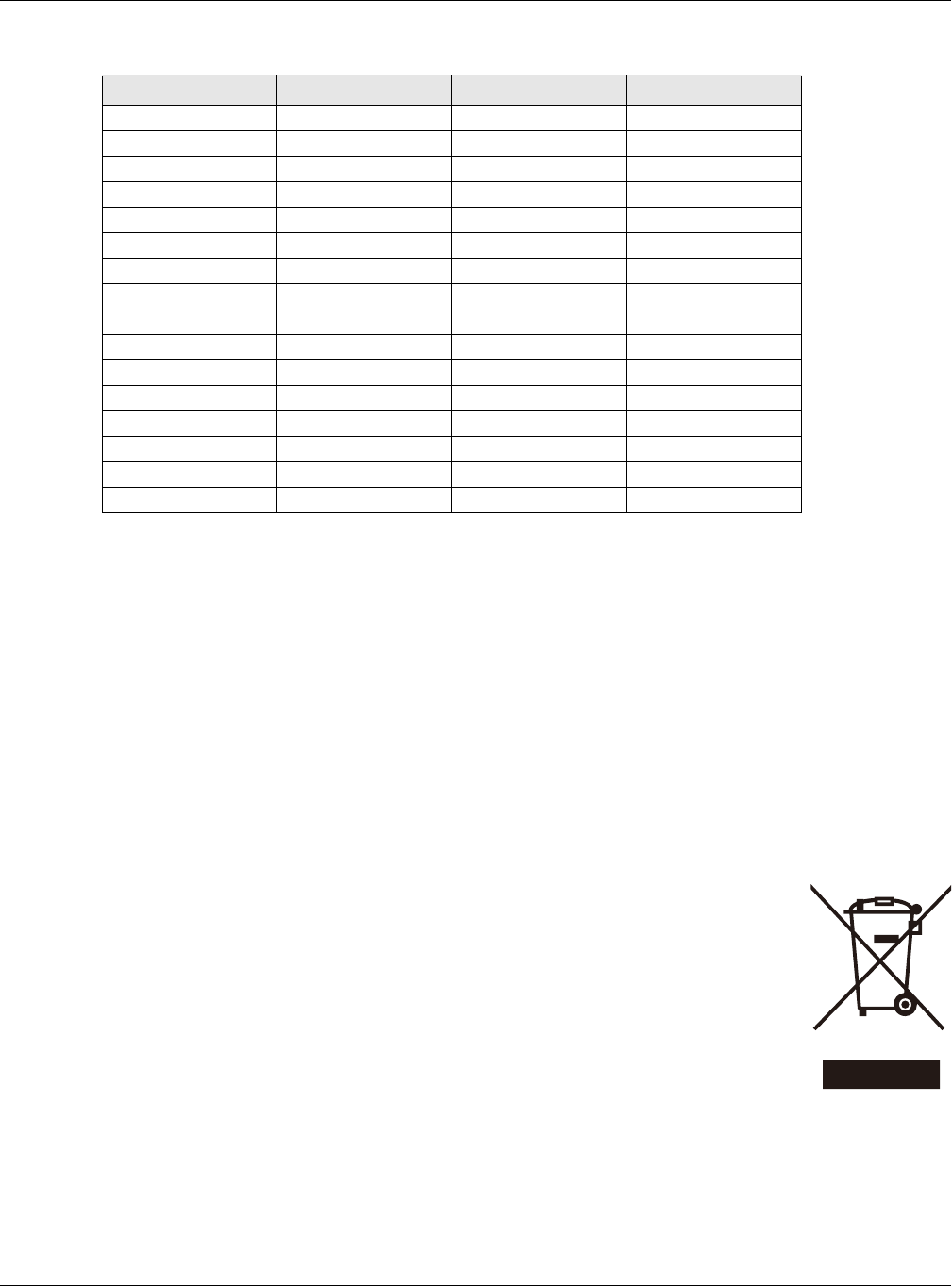
Appendix A Legal Information
EMG2926-Q10A User’s Guide
202
List of national codes
Safety Warnings
• Do NOT use this product near water, for example, in a wet basement or near a swimming pool.
• Do NOT expose your device to dampness, dust or corrosive liquids.
• Do NOT store things on the device.
• Do NOT install, use, or service this device during a thunderstorm. There is a remote risk of electric shock from lightning.
• Connect ONLY suitable accessories to the device.
• Do NOT open the device or unit. Opening or removing covers can expose you to dangerous high voltage points or other risks. ONLY
qualified service personnel should service or disassemble this device. Please contact your vendor for further information.
• Make sure to connect the cables to the correct ports.
• Place connecting cables carefully so that no one will step on them or stumble over them.
• Always disconnect all cables from this device before servicing or disassembling.
• Use ONLY an appropriate power adaptor or cord for your device.
• Connect the power adaptor or cord to the right supply voltage (for example, 110V AC in North America or 230V AC in Europe).
• Do NOT allow anything to rest on the power adaptor or cord and do NOT place the product where anyone can walk on the power
adaptor or cord.
• Do NOT use the device if the power adaptor or cord is damaged as it might cause electrocution.
• If the power adaptor or cord is damaged, remove it from the power outlet.
• Do NOT attempt to repair the power adaptor or cord. Contact your local vendor to order a new one.
• Do not use the device outside, and make sure all the connections are indoors. There is a remote risk of electric shock from lightning.
• Do NOT obstruct the device ventilation slots, as insufficient airflow may harm your device.
• Antenna Warning! This device meets ETSI and FCC certification requirements when using the included antenna(s). Only use the
included antenna(s).
• If you wall mount your device, make sure that no electrical lines, gas or water pipes will be damaged.
Your product is marked with this symbol, which is known as the WEEE mark. WEEE stands for Waste Electronics
and Electrical Equipment. It means that used electrical and electronic products should not be mixed with general
waste. Used electrical and electronic equipment should be treated separately.
COUNTRY ISO 3166 2 LETTER CODE COUNTRY ISO 3166 2 LETTER CODE
Austria AT Malta MT
Belgium BE Netherlands NL
Cyprus CY Poland PL
Czech Republic CR Portugal PT
Denmark DK Slovakia SK
Estonia EE Slovenia SI
Finland FI Spain ES
France FR Sweden SE
Germany DE United Kingdom GB
Greece GR Iceland IS
Hungary HU Liechtenstein LI
Ireland IE Norway NO
Italy IT Switzerland CH
Latvia LV Bulgaria BG
Lithuania LT Romania RO
Luxembourg LU Turkey TR

Index
EMG2926-Q10A User’s Guide
203
Index
A
ActiveX 140
Address Assignment 76
AP 12
AP Mode
menu 54
status screen 52
AP+Bridge 12
B
Bridge/Repeater 12
C
certifications 198
notices 199
viewing 199
Channel 45, 46, 53
channel 87
CIFS 169
Common Internet File System, see CIFS
Configuration
restore 185
content filtering 139
by keyword (in URL) 139
Cookies 140
copyright 198
CPU usage 46, 54
D
Daylight saving 183
DDNS 129
see also Dynamic DNS
service providers 129, 146
DHCP 71, 113
DHCP server
see also Dynamic Host Configuration Protocol
DHCP server 110, 113
Digital Living Network Alliance 168
disclaimer 198
DLNA 167, 168
indexing 170
overview 167
rescan 170
DLNA-compliant client 168
DNS 115
DNS Server 76
DNS server 115
documentation
related 2
Domain Name System 115
Domain Name System. See DNS.
duplex setting 46, 54
Dynamic DNS 129
Dynamic Host Configuration Protocol 113
DynDNS 129, 146
DynDNS see also DDNS 129, 146
E
encryption 88
and local (user) database 89
key 89
WPA compatible 89
ESSID 194
F
FCC interference statement 198
file sharing 168
access right 172, 173

Index
EMG2926-Q10A User’s Guide
204
bandwidth 173
example 173
FTP 172
overview 168
Samba 171
user account 172, 173
Windows Explorer 171
work group 171
Firewall 135
Firewall overview
guidelines 135
ICMP packets 136
network security
Stateful inspection 135
ZyXEL device firewall 135
firewall
stateful inspection 134
Firmware upload 183
file extension
using HTTP
firmware version 45, 53
G
General wireless LAN screen 91
Guest WLAN 89
Guest WLAN Bandwidth 90
Guide
Quick Start 2
I
IGMP 77
see also Internet Group Multicast Protocol
version
IGMP version 77
Internet Group Multicast Protocol 77
IP Address 110, 111, 121
IP alias 110
IP Pool 114
J
Java 140
L
LAN 109
IP pool setup 113
LAN overview 109
LAN setup 109
LAN TCP/IP 113
Language 186
Link type 46, 54
local (user) database 88
and encryption 89
Local Area Network 109
M
MAC 102
MAC address 77, 88
cloning 77
MAC address filter 88
MAC address filtering 102
MAC filter 102
Management Information Base (MIB) 157
managing the device
good habits 14
using the web configurator. See web configurator.
using the WPS. See WPS.
MBSSID 12
Media access control 102
media client 167
media file 167, 170
type 170
media server 167
overview 167
meida file play 167
Memory usage 46, 54
mode 12
Multicast 77
IGMP 77

Index
EMG2926-Q10A User’s Guide
205
N
NAT 118, 121
global 119
how it works 120
inside 119
local 119
outside 119
overview 118
port forwarding 126
see also Network Address Translation
server 119
server sets 126
NAT Traversal 161
Navigation Panel 46, 54
navigation panel 46, 54
Network Address Translation 118, 121
O
operating mode 12
other documentation 2
P
Point-to-Point Protocol over Ethernet 81
Pool Size 114
Port forwarding 121, 126
default server 121, 126
example 126
local server 121
port numbers
services
port speed 46, 54
PPPoE 81
dial-up connection
product registration 199
Q
Quality of Service (QoS) 105
Quick Start Guide 2
R
RADIUS server 88
registration
product 199
related documentation 2
Remote management
and NAT 155
limitations 154
system timeout 155
Reset button 14
Reset the device 14
Restore configuration 185
Roaming 104
Router Mode
status screen 43
RTS/CTS Threshold 87, 104
S
Samba 169
Scheduling 107
Server Message Block, see SMB
Service and port numbers 138
Service Set 40, 91, 101
Service Set IDentification 40, 91, 101
Service Set IDentity. See SSID.
Simple Network Management Protocol, see SNMP
SMB 169
SNMP 156, 157
agents 157
Get 157
GetNext 157
Manager 157
managers 157
MIB 157
network components 157
Set 157
Trap 157
versions 156
SSID 40, 45, 46, 53, 87, 91, 101
stateful inspection firewall 134
Static DHCP 114
Static Route 131

Index
EMG2926-Q10A User’s Guide
206
Status 43
StreamBoost 149
automatic update 150
bandwidth 149
bandwidth and performance 153
data rate 150
device priority 152
download traffic 152
example 149
maximum bandwidth 150
overview 149
QoS 149
top traffic flows 152
Subnet Mask 111
Summary
DHCP table 71
Packet statistics 72
Wireless station status 73
System General Setup 179
System restart 186
T
TCP/IP configuration 113
Time setting 181
trademarks 198
trigger port 127
Trigger port forwarding 127
example 127
process 127
U
Universal Plug and Play 161
Application 161
Security issues 161
UPnP 161
URL Keyword Blocking 140
USB media sharing 167
user authentication 88
local (user) database 88
RADIUS server 88
User Name 130
W
Wake On LAN 159
WAN (Wide Area Network) 75
WAN MAC address 77
warranty 199
note 199
Web Configurator
how to access 28
Overview 28
web configurator 13
Web Proxy 140
WEP Encryption 95, 97
WEP encryption 94
WEP key 94
windows media player 167
Wireless association list 73
wireless channel 194
wireless LAN 194
wireless LAN scheduling 107
Wireless network
basic guidelines 87
channel 87
encryption 88
example 86
MAC address filter 88
overview 86
security 87
SSID 87
Wireless security 87
overview 87
type 87
wireless security 194
Wireless tutorial 57
Wizard setup 18
WLAN button 14
WoL 159
work group 169
name 169
Windows 169
WPA compatible 89
WPS 13